Allison Collection Photos
July, 1944
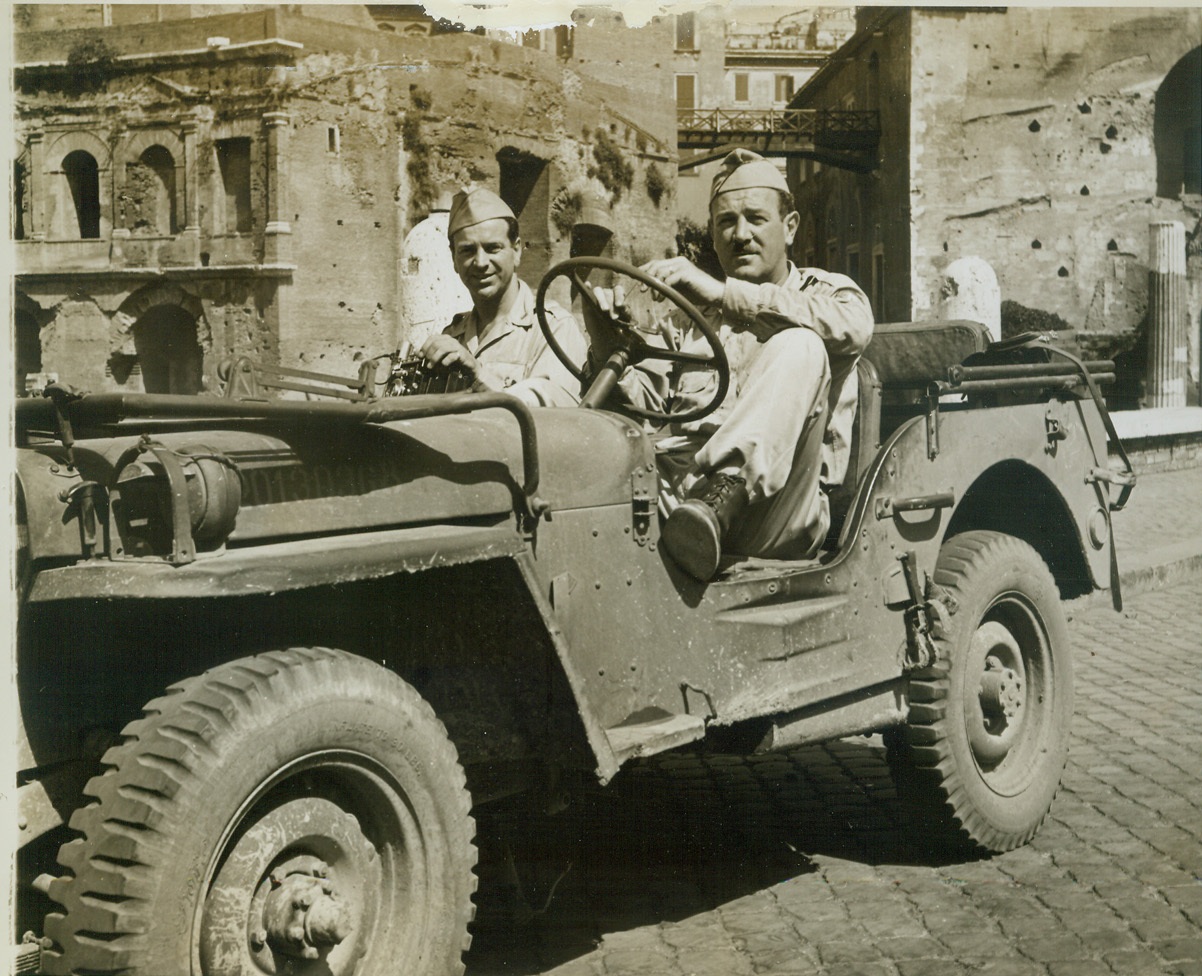
ACME Photographers in Rome, 7/5/1944. Rome, Italy – At the front lines with Allied fighting men, Charles Seawood (left) and Sherman Montrose, ACME Newspictures War Correspondents, were under fire and suffered the privations all fighting men must when engaging the enemy. Away from the scenes of battle, the two ace photographers tour the streets of Rome getting their fill of the sights. Ever the cameraman, the ACME boys, nevertheless, lug their equipment with them. Credit (ACME Photo by Sherman Montrose, War Pool Correspondent);
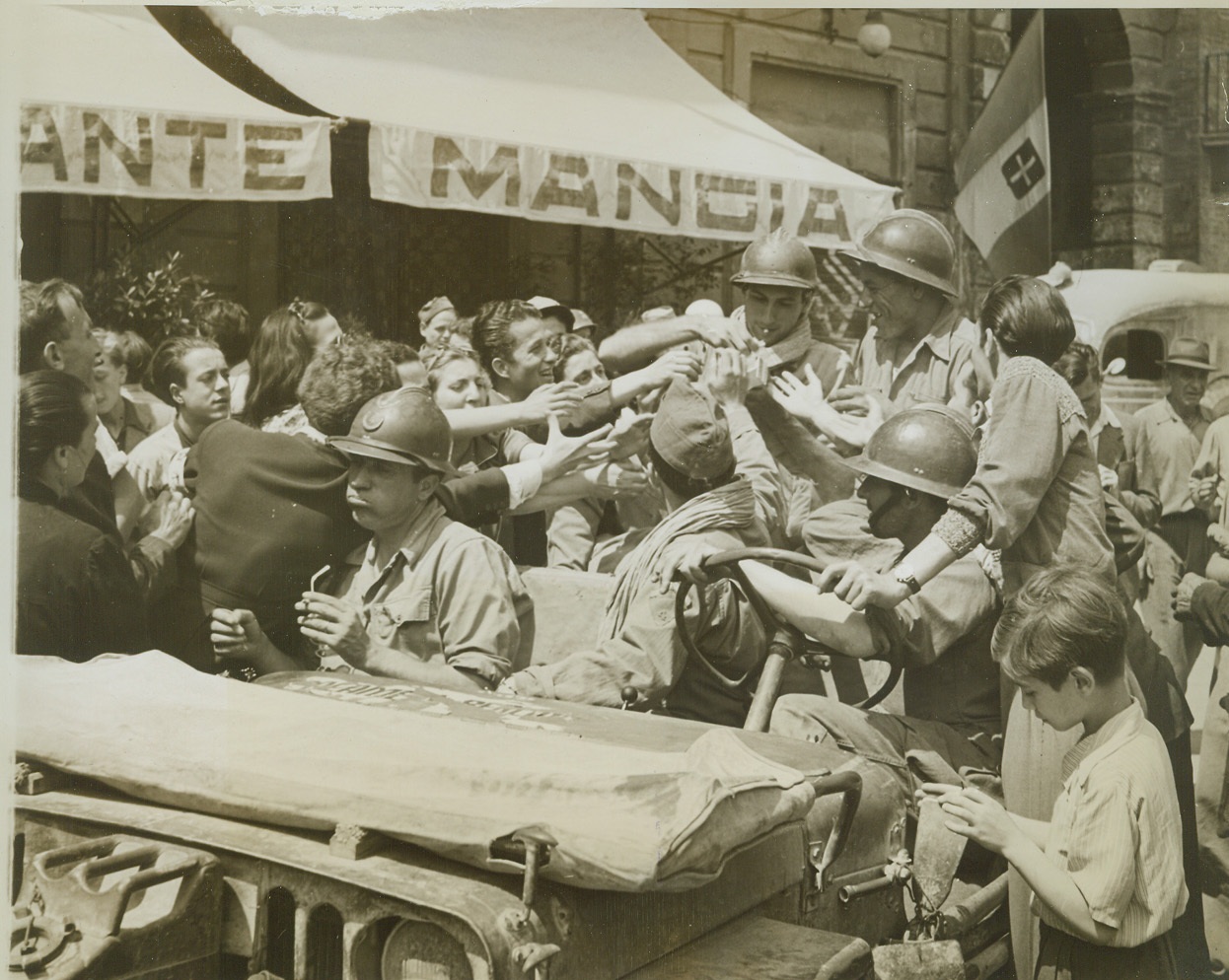
French Liberators in Siena, 7/9/1944. Italy – French troops of the Fifth Army recently captured the historic Italian town of Siena, only 25 miles from Florence. On entering the important town in the north of the Italian peninsula, friendly French soldiers hand out candy and cigarettes to the equally friendly Siena villagers come to greet their liberators. Credit – WP- (AMCE Photo by Charles Seawood, War Pool Correspondent);
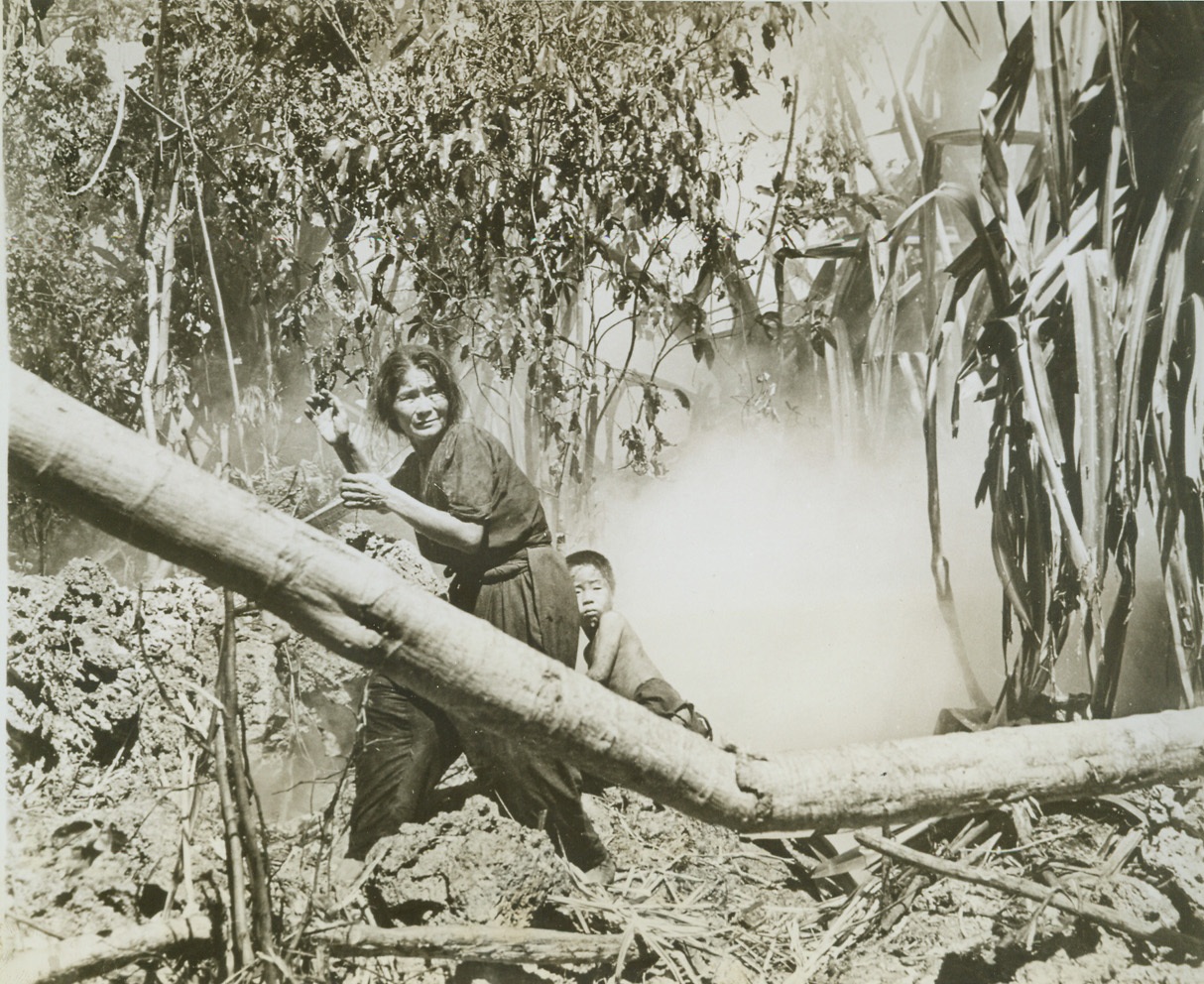
Cave Dwellers Emerge, 7/20/1944. Saipan—After mopping up all resisting Jap troops on Saipan, Yank forces returned inland to a cave containing over one hundred Jap civilians and smoked them out. Among the first of the cave dwellers to emerge from hiding were this woman and child. Both seem frightened and reports from Saipan state that the smoke affected the people so that it was a few minutes before they could speak or see clearly. Credit–WP–(ACME);
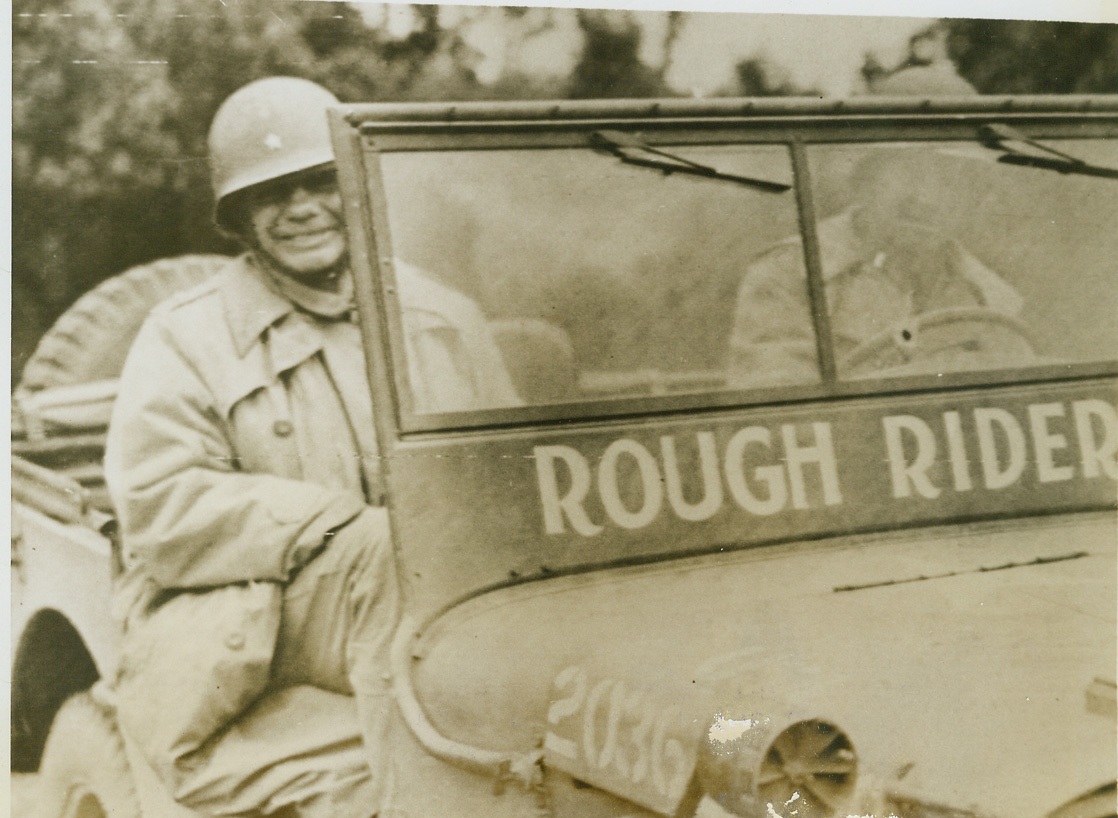
BRIG. GEN. ROOSEVELT ON HIS LAST RIDE, 7/15/1944. FRANCE – This last picture of the late Brig. Gen. Theodore Roosevelt shows the soldier-statesman on his last inspection trip riding his jeep “Rough Rider”. Photo was taken at an Infantry post in France. The infectious smile of the late General is an indication of why he was worshipped by the men he commanded. Credit: Signal Corps photo via OWI Radiophoto from ACME;
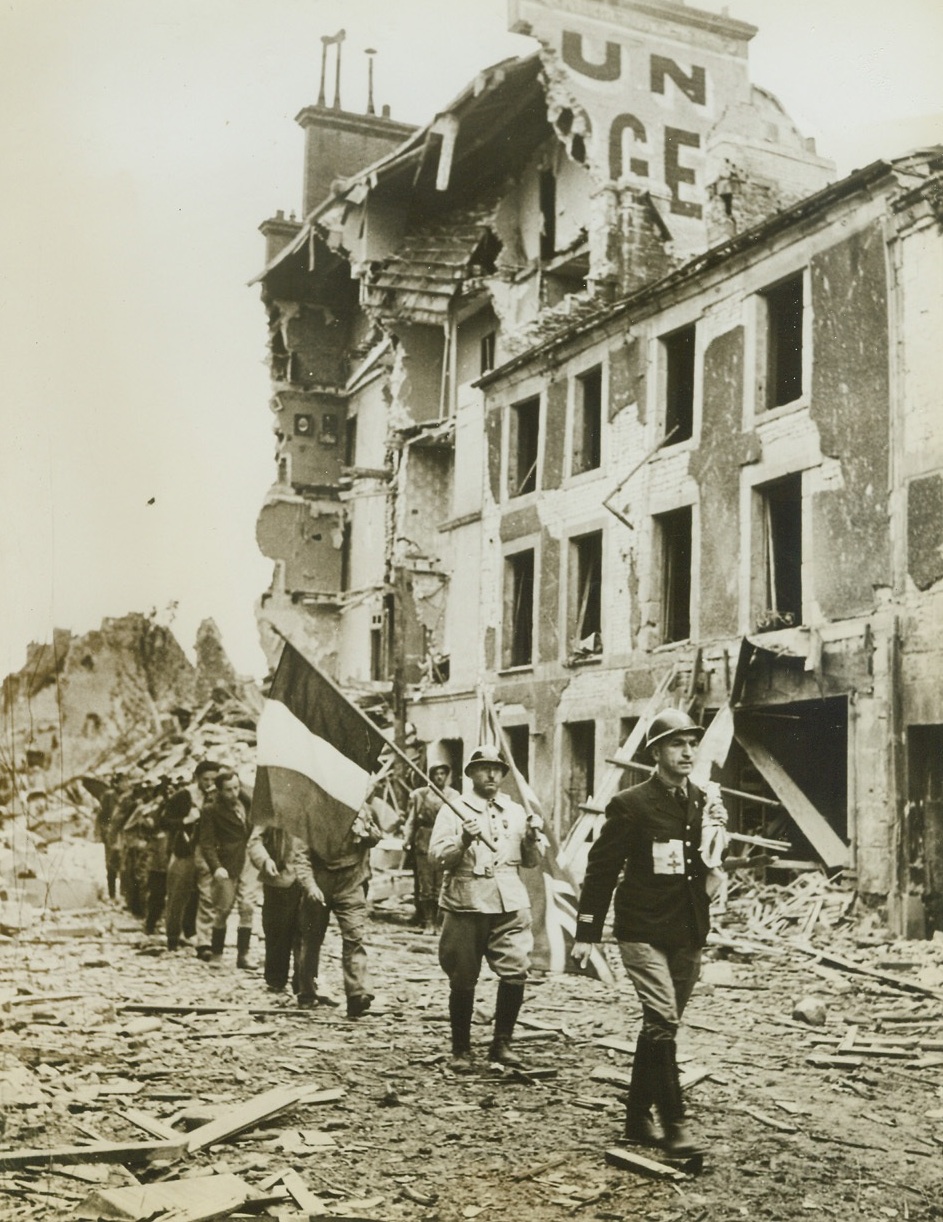
French Underground Emerges, 7/27/1944. Members of the French underground movement advance with medical supplies for villages to the south after the British had stormed the River Orne to take Caen. These patriot Frenchmen carry the tricolor of France and the British Union Jack for identification. Note the first helmeted man in the group wears the Cross of Lorraine sewed to his tunic. Credit-WP-(ACME);
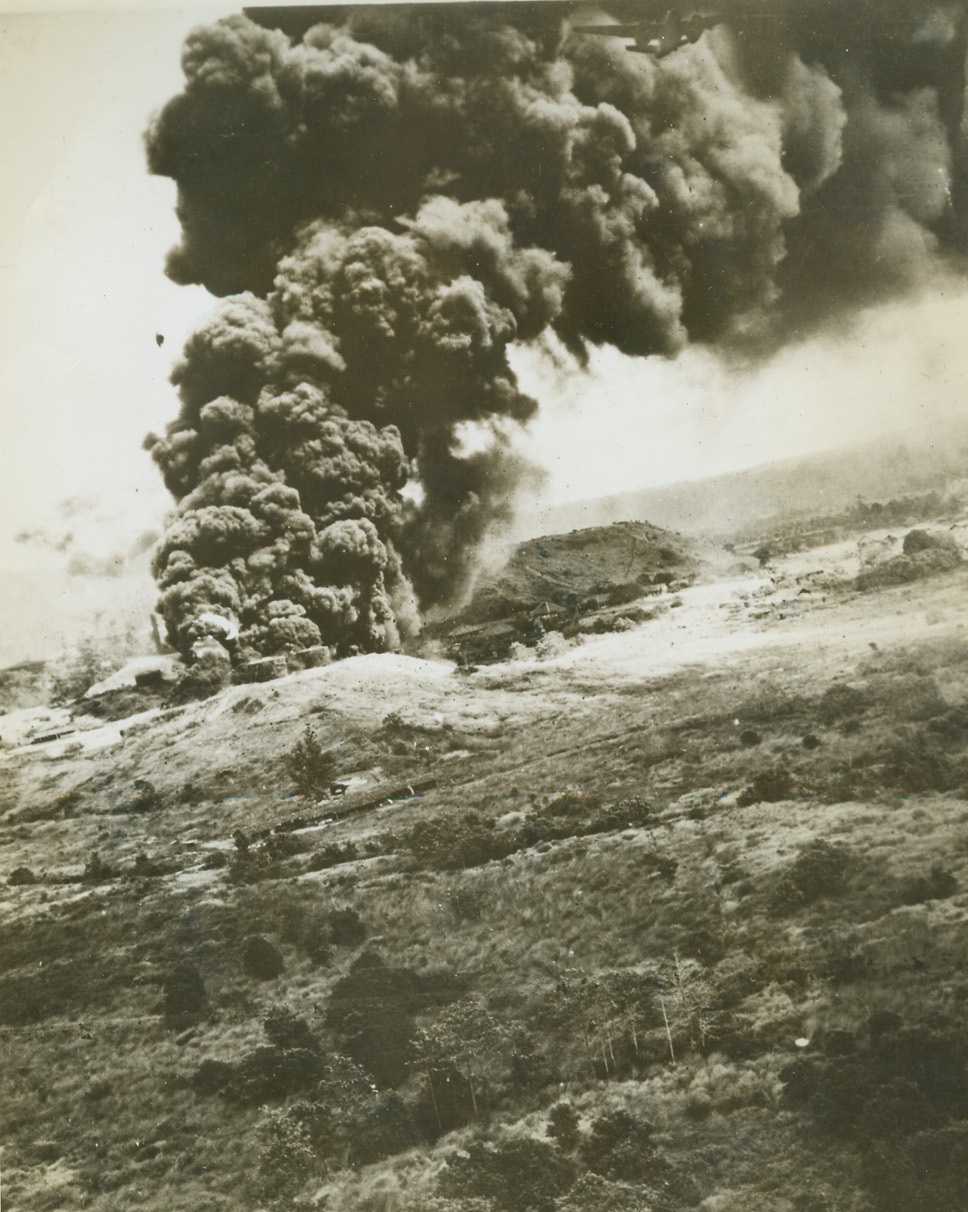
IT’S GOING TO BE COLD THIS WINTER, 7/29/1944. DUTCH EAST INDIES- Columns of black smoke rise in the air after Japanese oil supply dumps at Boela, Ceram Isal, Dutch East Indies, received direct hits from Lt. Gen. Kenny’s 5th Air Forces Bombers. One of the bombers can be seen emerging from the smoke (top center). Credit: USAAF photo via OWI Radiophoto from ACME;
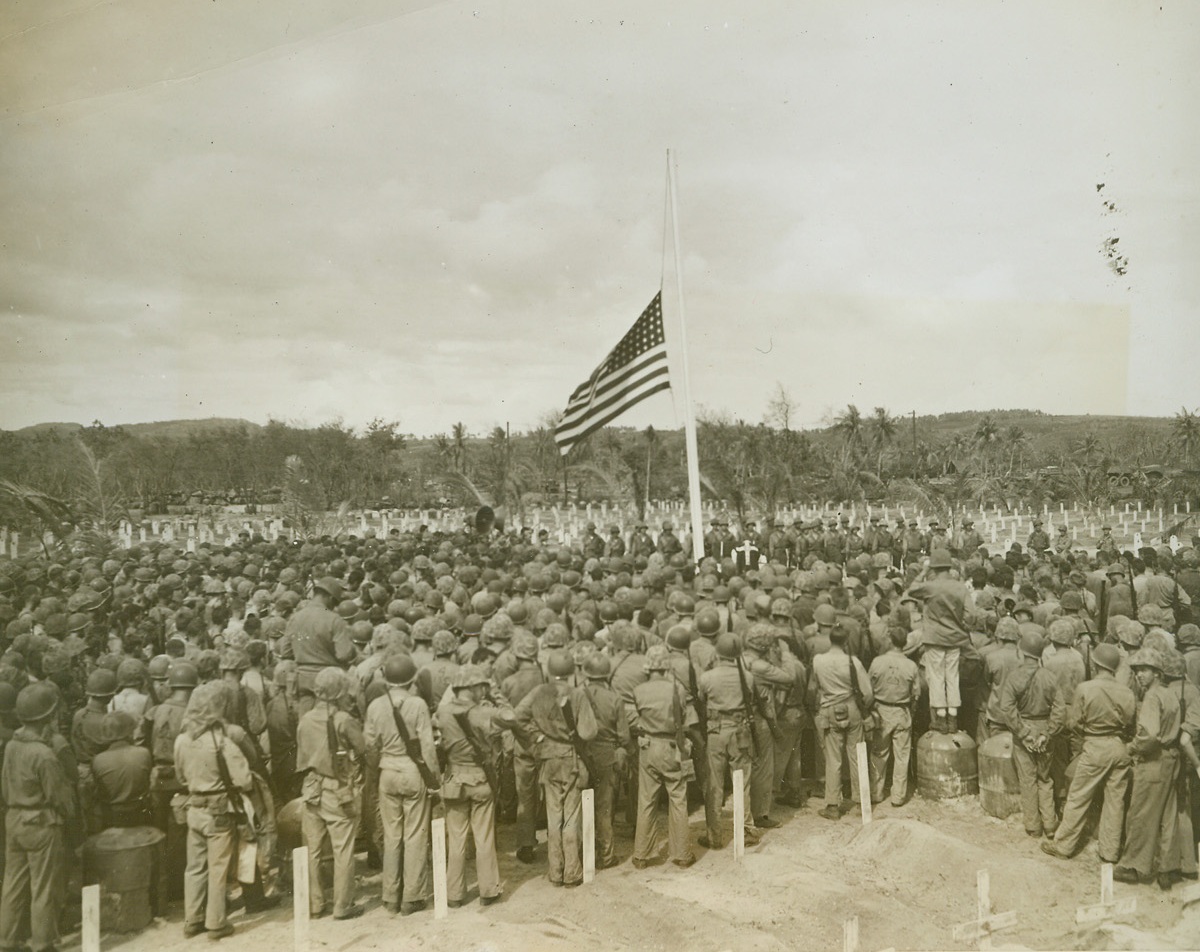
Services For Saipan Dad, 7/26/1944. SIAPAN--In respect for their dead and missing comrades members of the Fourth Marine Division stood solemnly by to hear memorial services by the Catholic, Protestant, and Jewish chaplains in the official Division cemetery on Saipan Island. The Navy today revealed that the conquest for this key base in the Marianas, in American causalities, 3043 killed, 13,049 wounded and 305 missing. Battle for the island saw the enemy put up the stiffest resistance yet seen in the PacificCredit: WP;
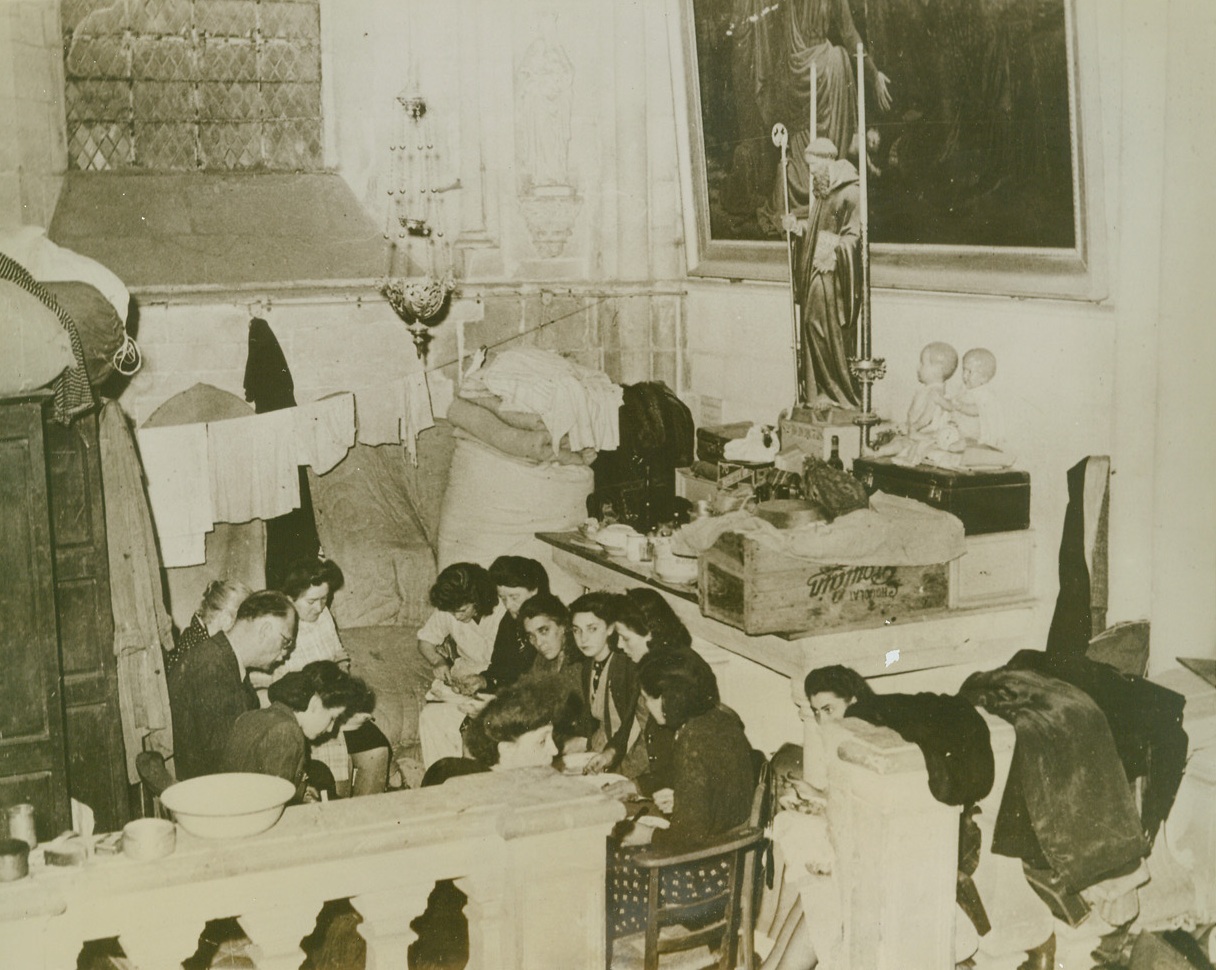
Holy Shelter For Caen Refugees, 7/18/1944. CAEN, FRANCE—Civilians take refuge in the cathedral at Caen. One of the alters is used as a supply table with a clothesline running in front of it and a refugee family has it’s meal in one of the alcoves of the church. Note the two dolls reposing on the alter.Credit (ACME);
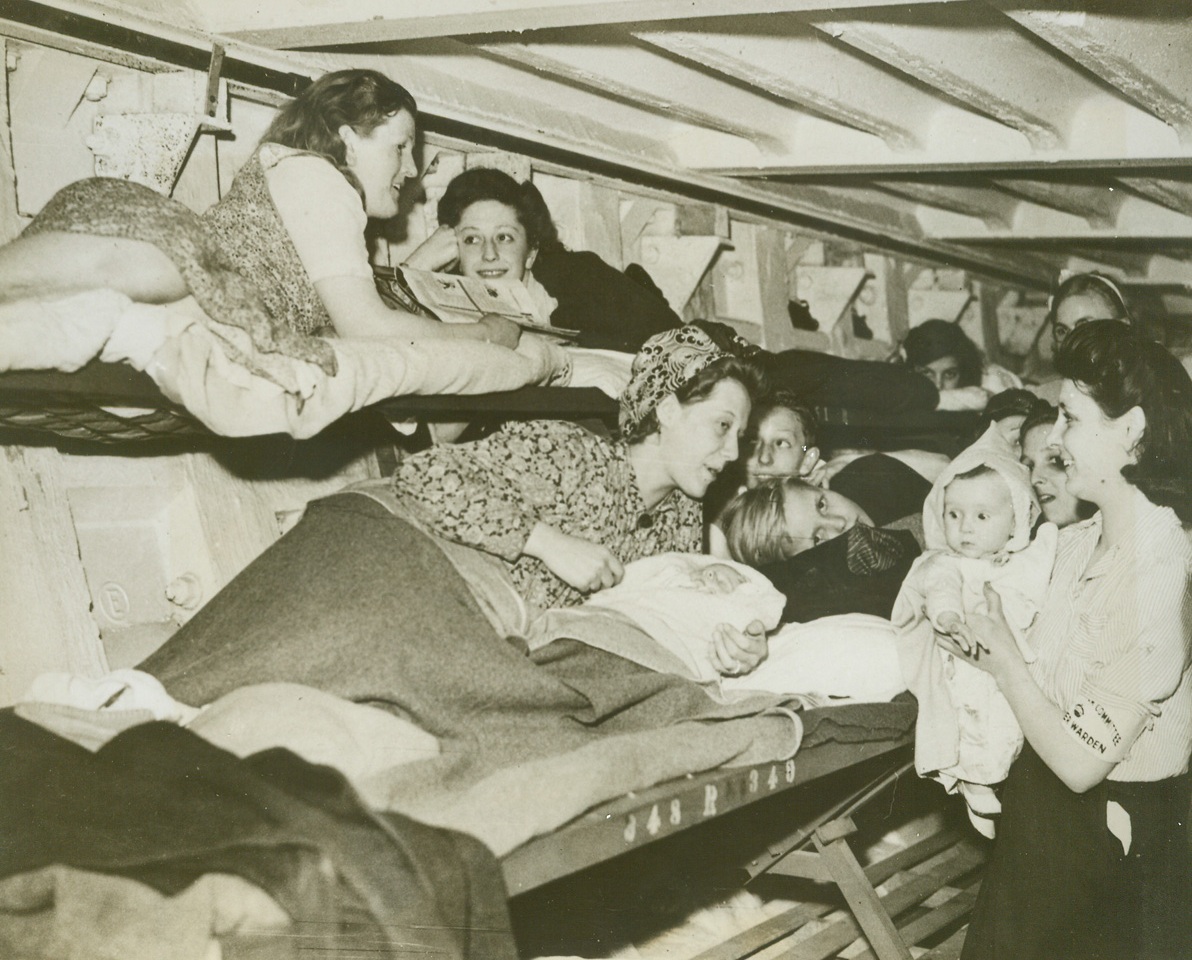
New Deep Shelter Against "Buzz Bombs", 7/27/1944. London, Eng. – TO allow Londoners protection and to give them some opportunity to sleep while the city is under bombardment by German robot “buzz-bombs”, the first of a series of deep shelters has been opened. These new shelters consist of two main twin tunnels running beneath existing tube railway (subway) lines. They are divided into 16 sections each fitted with bunks for 500 persons. Cross-passages connecting the two tubes contain first aid posts, lavatories and machinery control rooms. Bunks fold against the walls when not in use to allow free passage of traffic. Four canteens are provided at suitable points, run by volunteer organizations. The shelters are controlled and administered by commissioners for the London Civil Defense Region. Each shelter is in charge of a shelter superintendent, with a nucleus staff of full-time wardens, supplemented by volunteer wardens. In one of the sections of the new deep shelter, Londoners lie in the double row of bunks, at the right, a warden holds a child. Credit ACME;
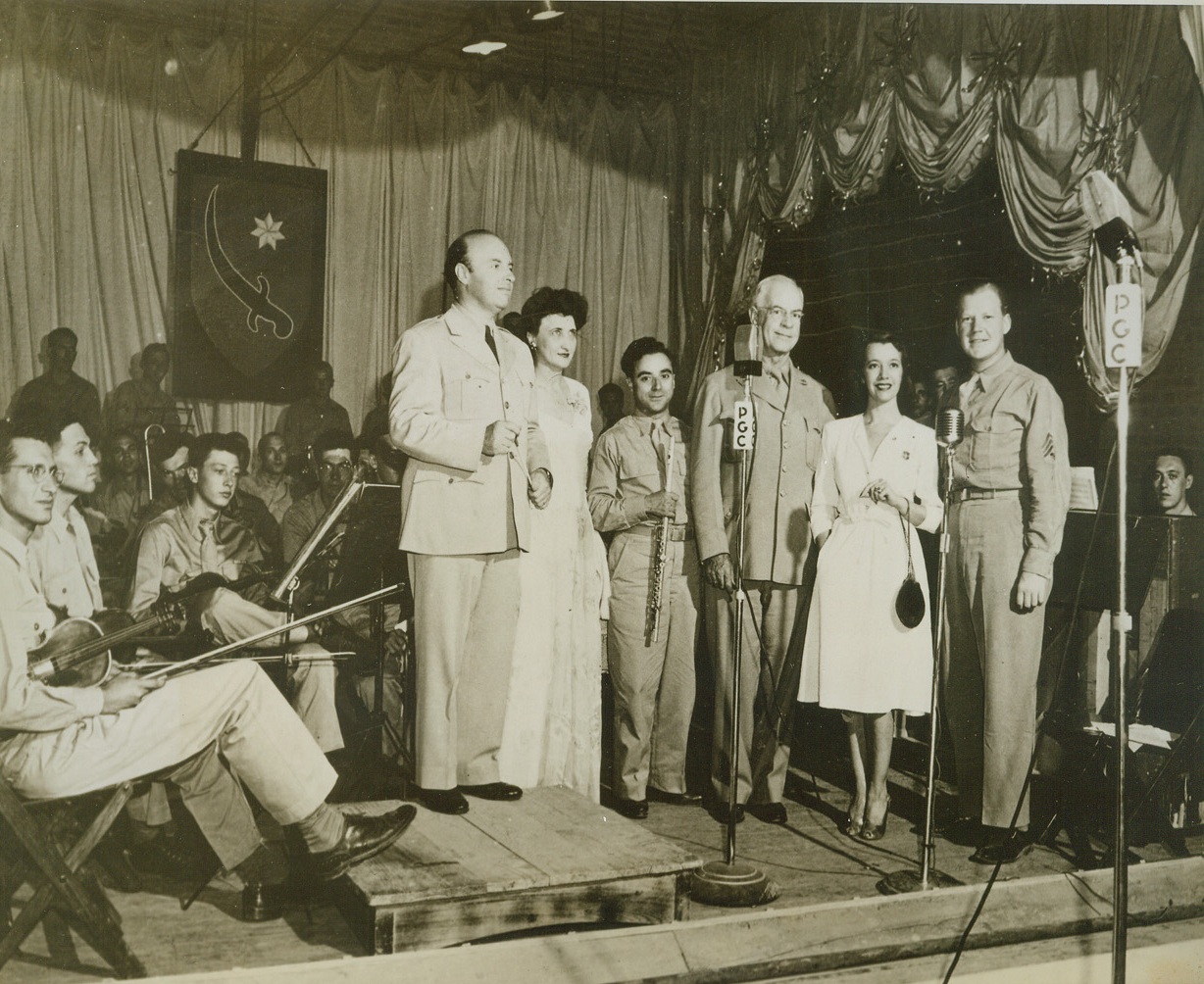
U.S. Stars Give Concert For Troops, 7/27/1944. IRAN—Following a concert given for troops ion the Persian Gulf Command, The visiting artists appear for a curtain bow. Left to right , standing are: Andre Kostelanetz, conducting the all-soldier orchestra; Miss Carolyn Gray, NBC pianist; Frank Versaci, Flutist; Maj. Gen. Donald H. Connolly, commanding General Persian Gulf Comand; Lilly Pons, Metropolitan Opera Star; and T/3 Frank P. McDonald, announcer.(Passed by censor)Credit; ACME;
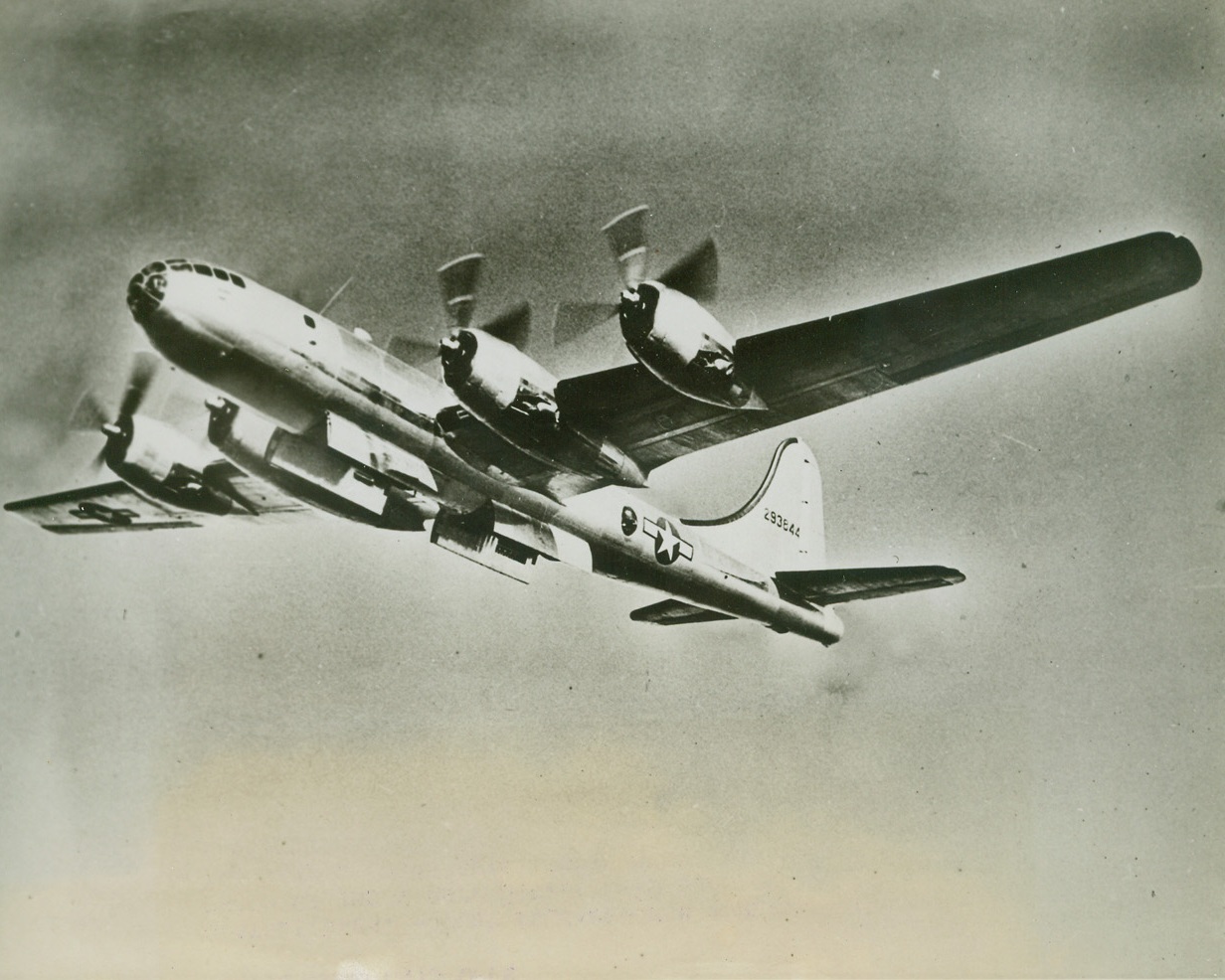
Double Bomb Bays Open, 7/26/1944. SEATTLE, WASH – just released for publication is this photo of the mighty Boeing B-29 Superfortress with it’s two sets of bomb bays’ doors open, ready to pour forth a deadly cargo. To keep the plane’s center of gravity undisturbed, bombs drop from the bays alternately.Credit: ACME;
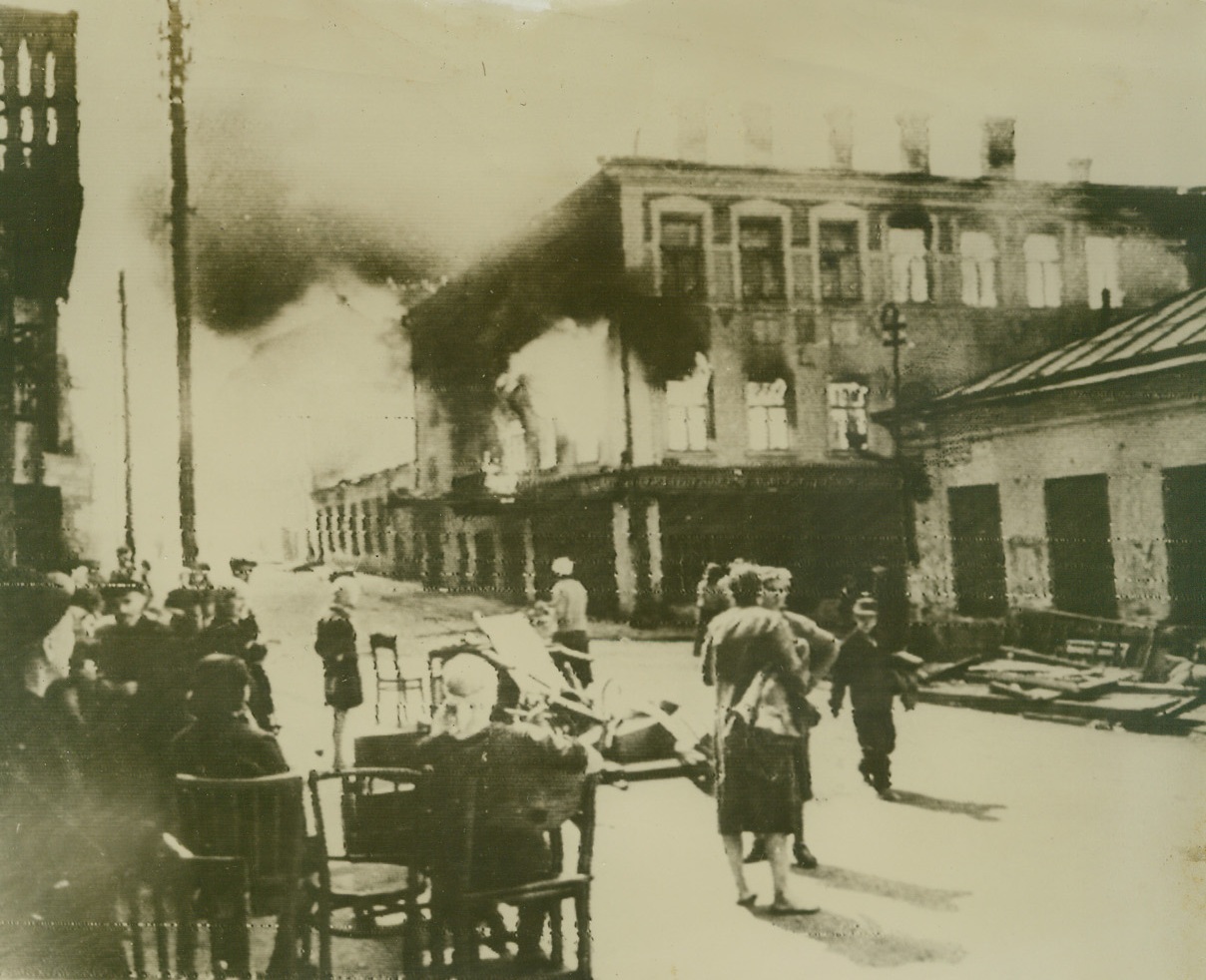
LIBERATED MINSK BURNS, 7/6/1944. MINSK—Residents of Minsk sit on salvaged furniture to watch homes, burned by the Nazis, go up in flames. Liberated by the rampaging Red Army, this former Nazi stronghold opens the gates on the road to Warsaw.Credit: Acme radiophoto;
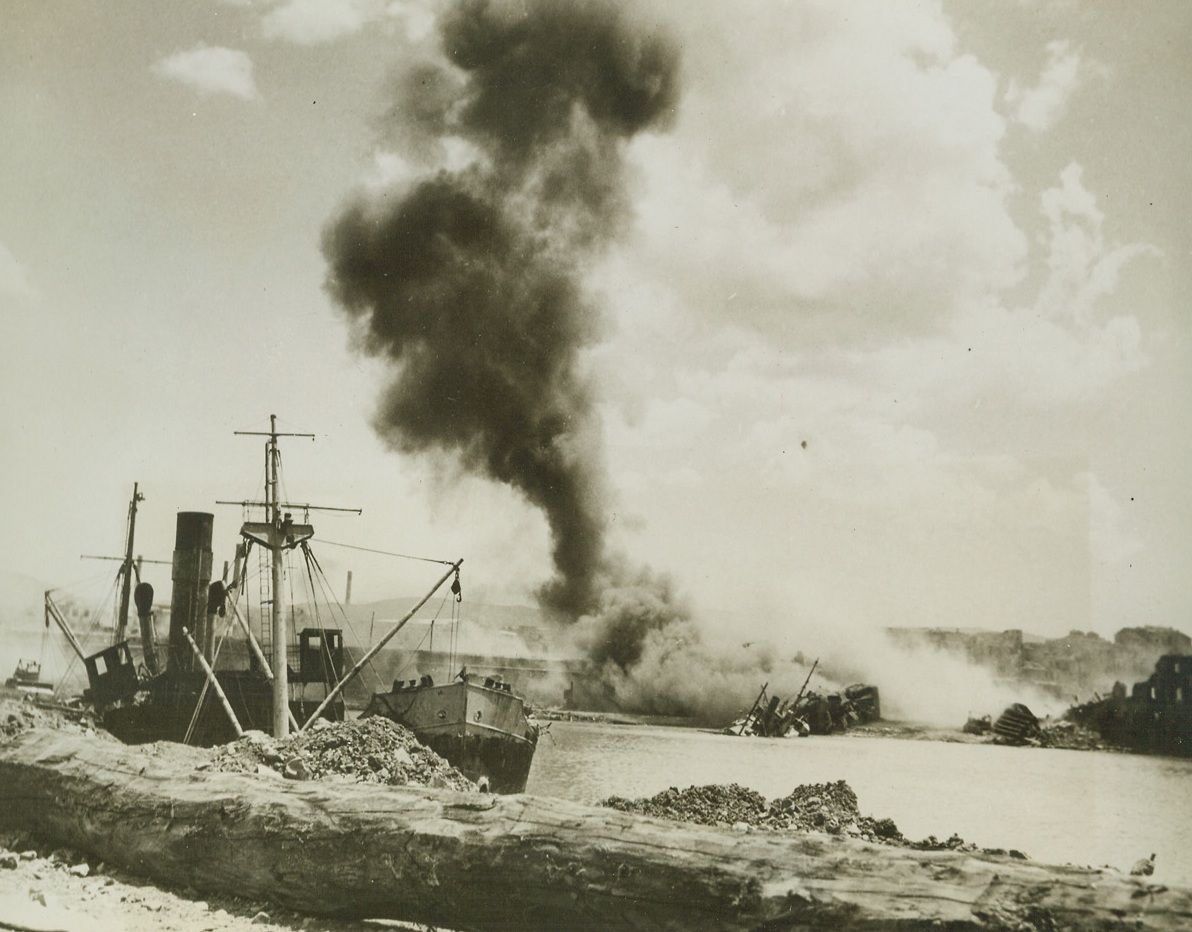
Make Way for Allied Supplies!, 7/3/1944. CIVITAVECCHIA, ITALY—Smoke rises above the harbor at Civitavecchia after American troops blew up a beached ship with a hearty dose of TNT. The ship was blocking the harbor entrance and preventing LST’s to land with supplies. Allied troops are steadily advancing toward the Pisa-Rimini Line, with French Forces with the 5th Army capturing the historic city of Siena, and Americans advancing past Cecina toward Leghorn. Credit: ACME;
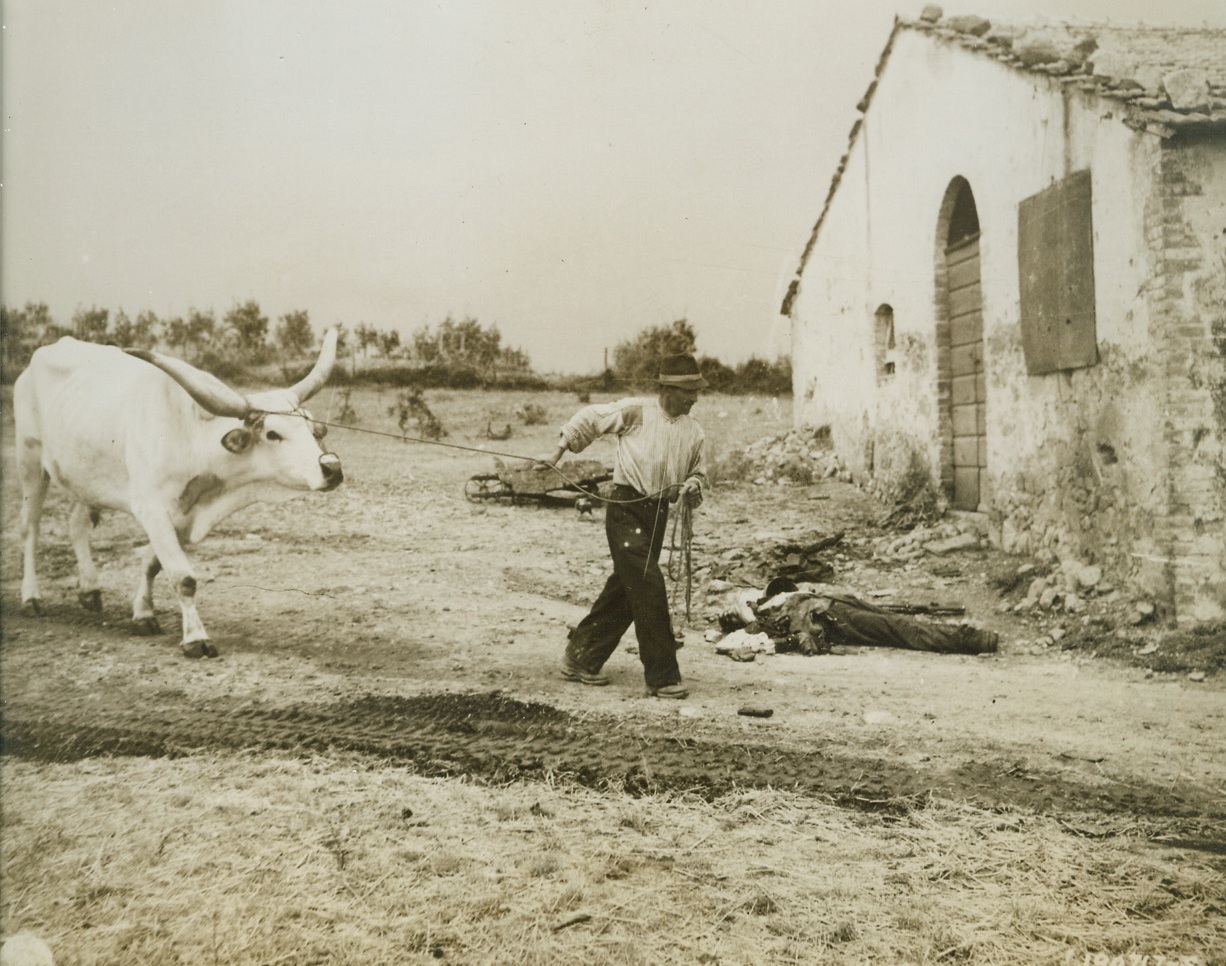
Hardened to War, 7/3/1944. GROSSETO, ITALY—War or no war, the domestic duties must go on, and this Italian Framer, calloused after living so long in the midst of battle, calmly leads his ox past a dead German lying on the ground near his farmhouse. Tank tracks in the foreground indicate that his homestead was probably a battle area not so long ago. Credit: ACME.;
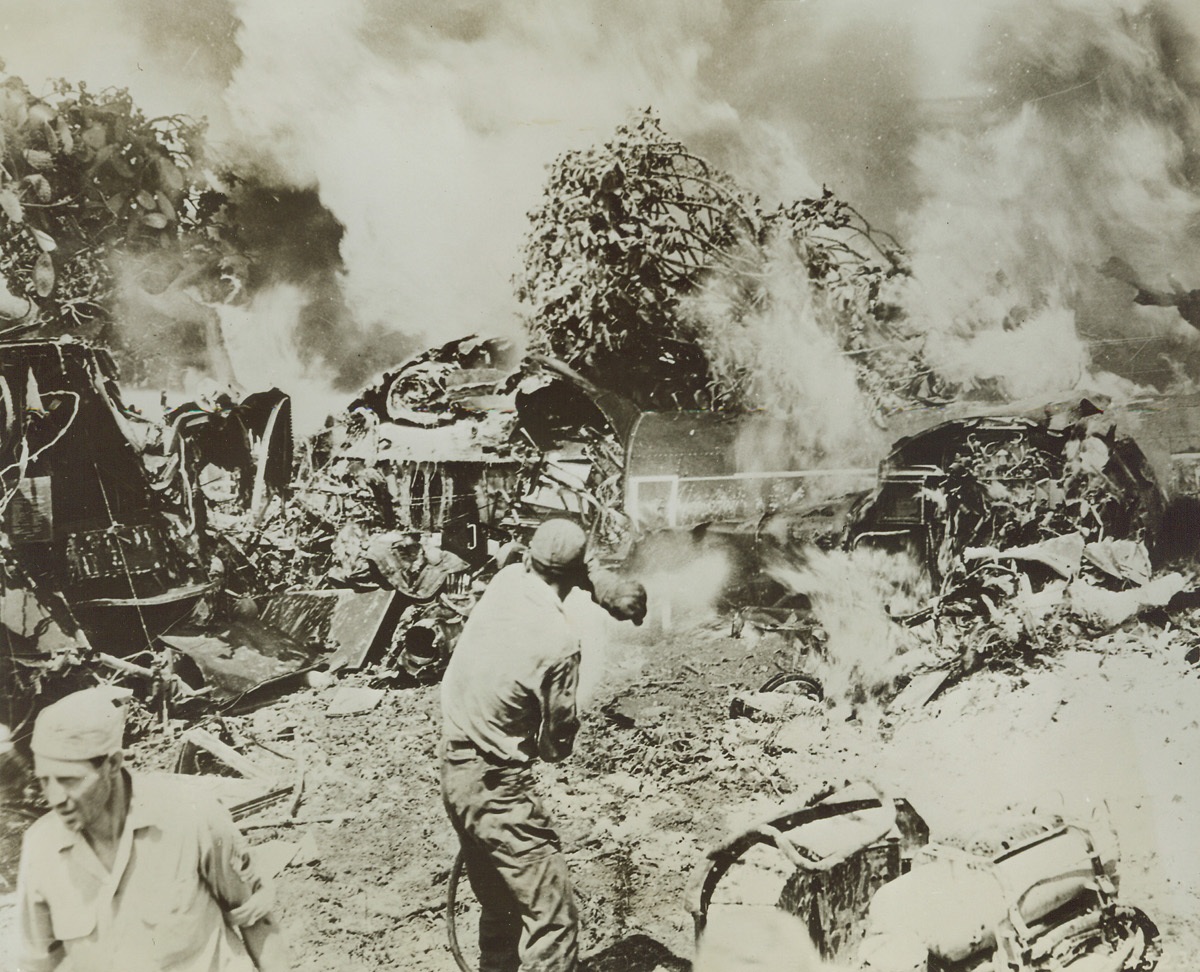
Crew Saved from Burning Liberator, 7/20/1944. ITALY—When this 15th Air Force B-24 Liberator bomber crashed at a field in Southern Italy, ground crew men rushed in and pulled the plane’s crew to safety. No one was killed as a result of the crash. A short while afterward, the aircraft’s gas tanks exploded ravaging the ship. Emergency crews could do nothing to save the Liberator and worked hard keeping the flames from spreading. Credit: USAAF Photo from ACME.;
![PINT-SIZE PARTISAN, 7/24/1944. LIVORNO, ITALY—Puffing nonchalantly on a cigarette and carrying a man-sized rifle, two hand grenades, and other arms, this youthful partisan presents an incongrous [sic] picture. Familiar with the layout of Livorno, he directed the American troops away from heavily-mined areas.Credit: Acme photo by Sherman Montrose, War Pool correspondent;](/media/15067/77091719.jpg)
PINT-SIZE PARTISAN, 7/24/1944. LIVORNO, ITALY—Puffing nonchalantly on a cigarette and carrying a man-sized rifle, two hand grenades, and other arms, this youthful partisan presents an incongrous [sic] picture. Familiar with the layout of Livorno, he directed the American troops away from heavily-mined areas.Credit: Acme photo by Sherman Montrose, War Pool correspondent;
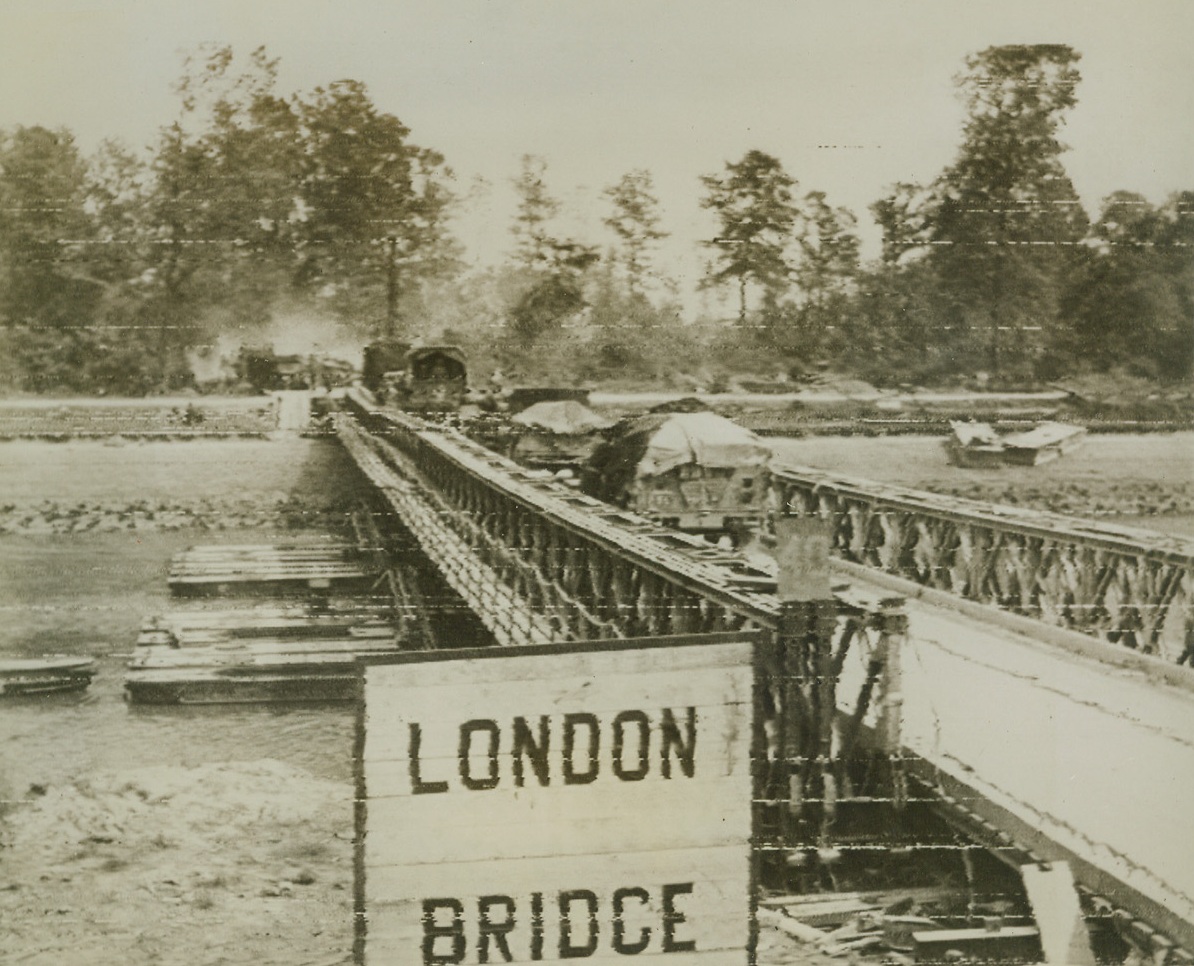
“LONDON BRIDGE” TO BERLIN, 7/20/1944. FRANCE—In the wake of the terrific tank battle that forced a break through north of Caen, British troops cross “London Bridge” set up across the Caen canal. Quickly assembled, the bridge is a Bailey Bridge and is strong enough to hold the truck loads of supplies needed by battling forces. Credit: British War Office photo via Signal Corps radiotelephoto from Acme;
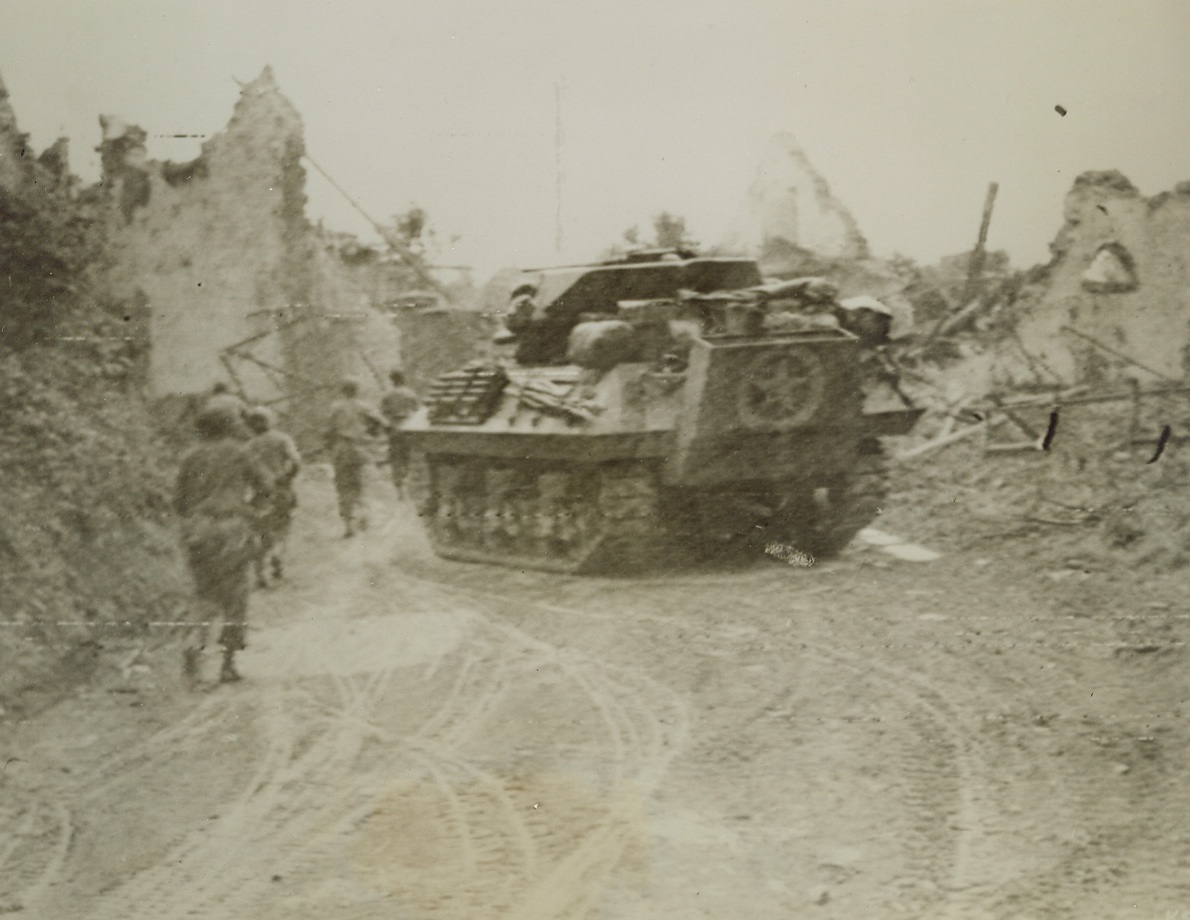
MOVING INTO ST. LO, 7/20/1944. Supported by a tank destroyer, U.S. troops advance through a wreckage-bordered street of the important Normandy town of St. Lo during the final attack that led to the capitulation of rear-guard German forces there. Credit: Acme photo by Andrew Lopez for War Picture Pool;
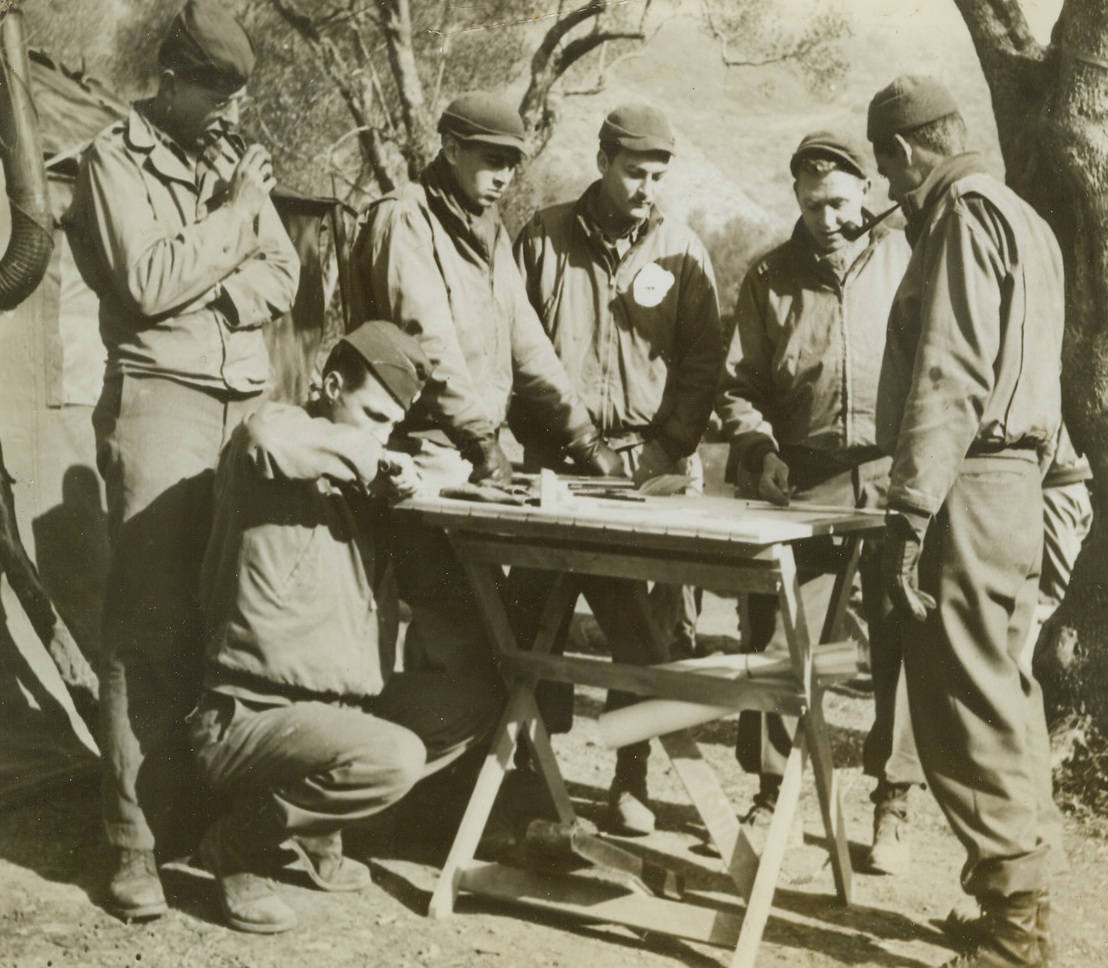
At Fifth Army Planning Table, 7/25/1944. ITALY -- At a field planning table with the Fifth Army in Italy, are (left to right): standing, Lt. Jack Epping, Quincy, Ill.; Lt. R.E. Smith, Callaway, Neb.; Lt. Eugene De Hermida, Sacramento, Calif.; Capt. James Ramsey, Marmaduke, Ark.; and Capt. Alfred H. McCutcheon, of Fort Davis, Texas. Credit Line (ACME) (WP);
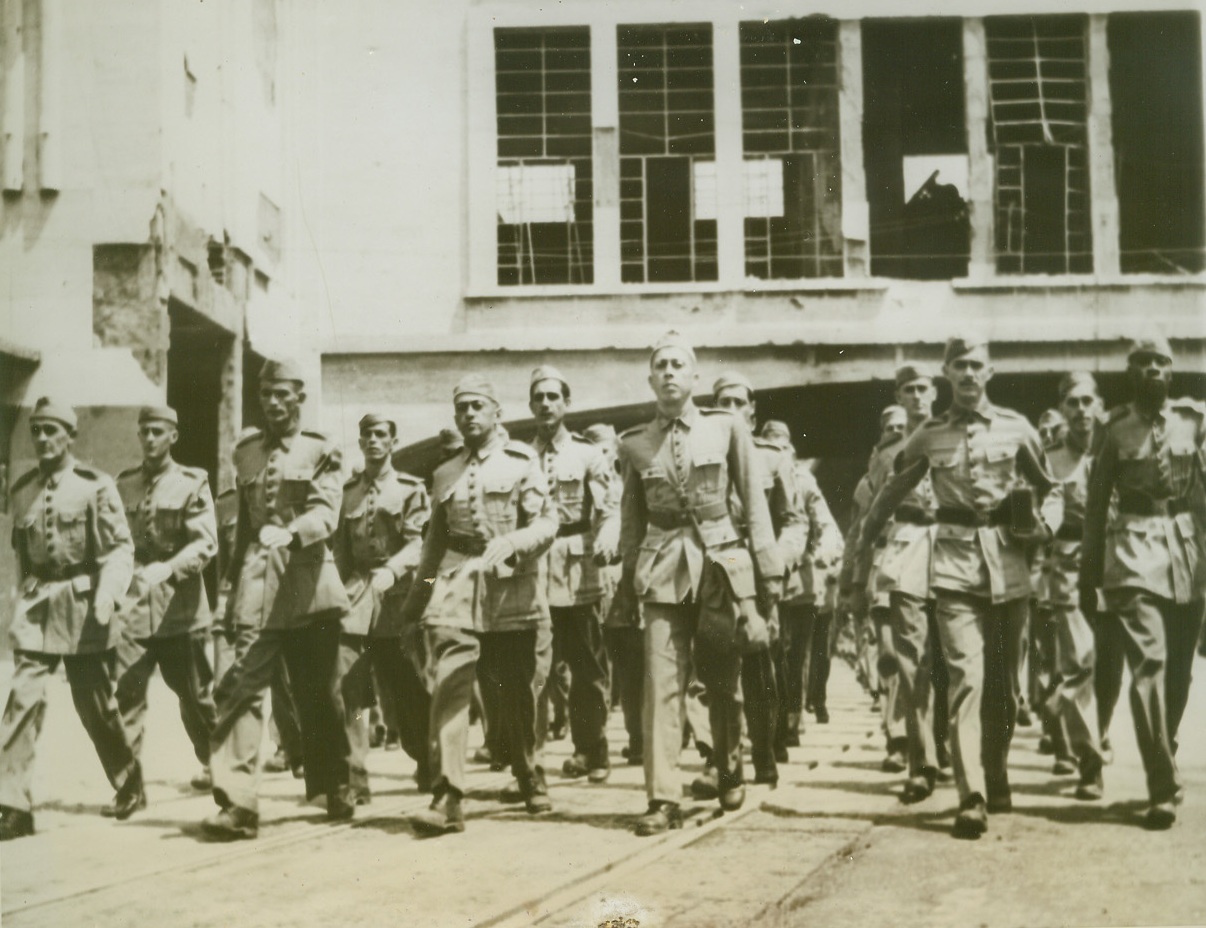
Brazilian Army in Italy, 7/26/1944. ITALY -- The first contingent of Brazilian troops march in Naples, Italy, after their arrival. They are on their way to the staging area before entering actual combat. Troops reached Naples July 16th. Credit (ACME);
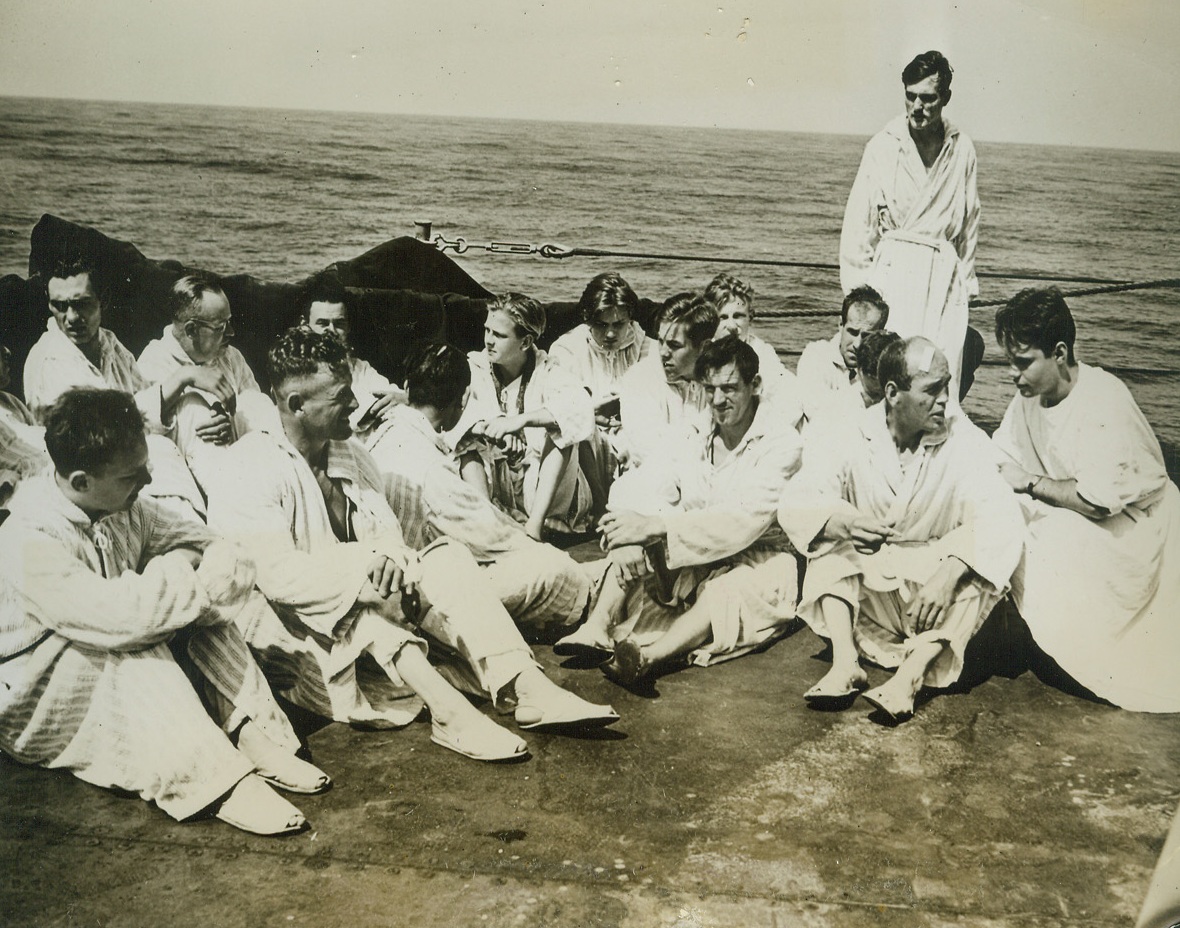
German Prisoners Head for U.S., 7/26/1944. AT SEA -- Headed for the United States, wounded and ailing German prisoners follow doctor's orders and get plenty of fresh air and sunshine as they lounge on the open deck of a Coast Guard-manned transport. They are attired in robes and slippers provided for them. A Coast Guardsman, at right, chats with an English-speaking prisoner. Credit (Coast Guard Photo from ACME);
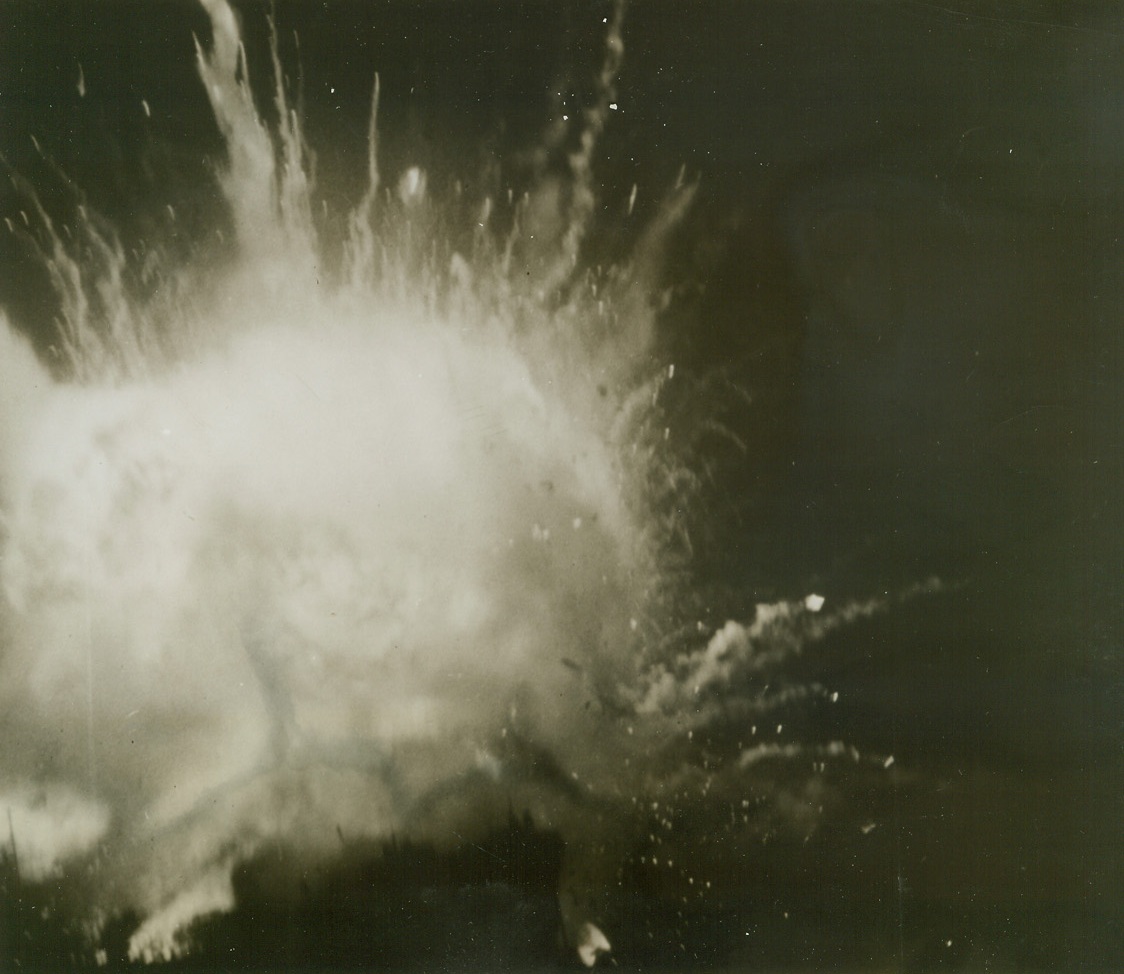
A Tanker Dies, 7/25/1944. AT SEA -- With a shattering roar, an Allied tanker explodes in a huge globe of flame, just before it went to the bottom following enemy action. Credit Line (U.S. Navy Photo from ACME);
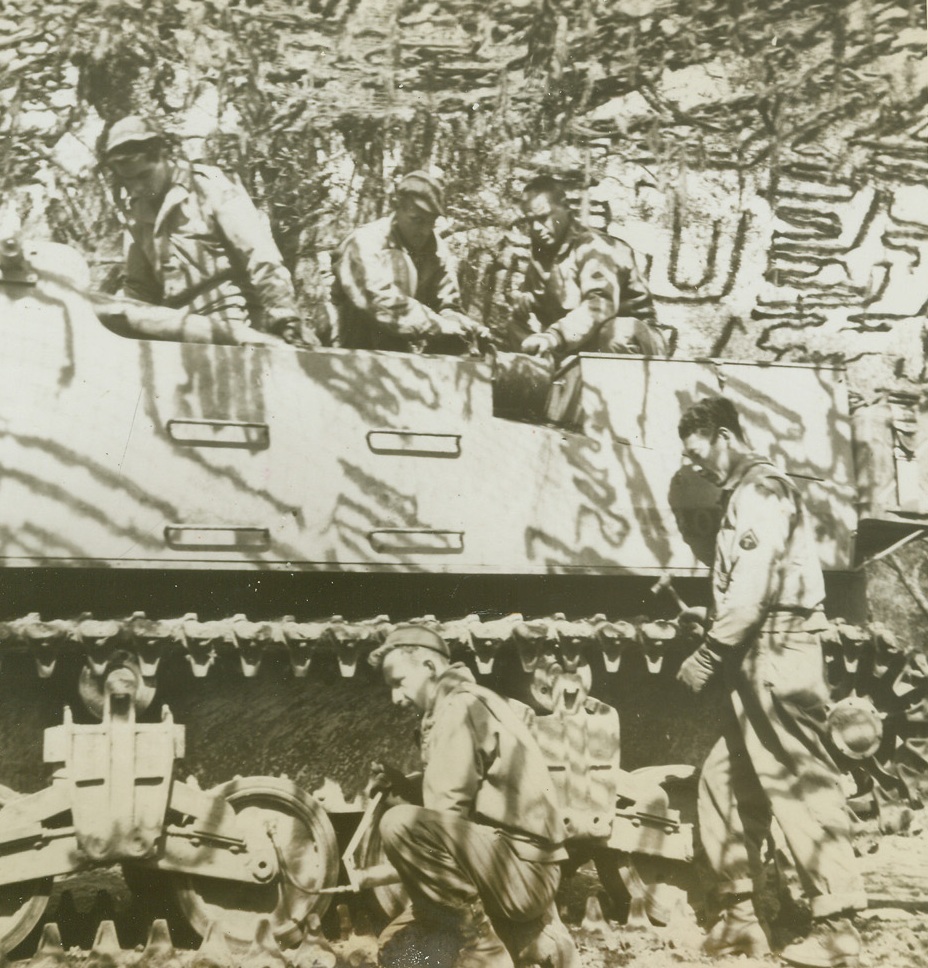
American Tank Destroyer Crew, 7/25/1944. ITALY -- Fighting with the Fifth Army, are: (left to right, atop tank destroyer), T/5 Lawrence Felker, Chicago, Ill.; Sgt. K.D. West, Van Alstyne, Tex.; and S/Sgt. Cornelius Orend, Louisville, Ky. Below are: T/5 Walter Haryliew, of Erie, Pa.; and T/5 Elias Domingues (right), of Pecos Tex. Credit Line (ACME) (WP);
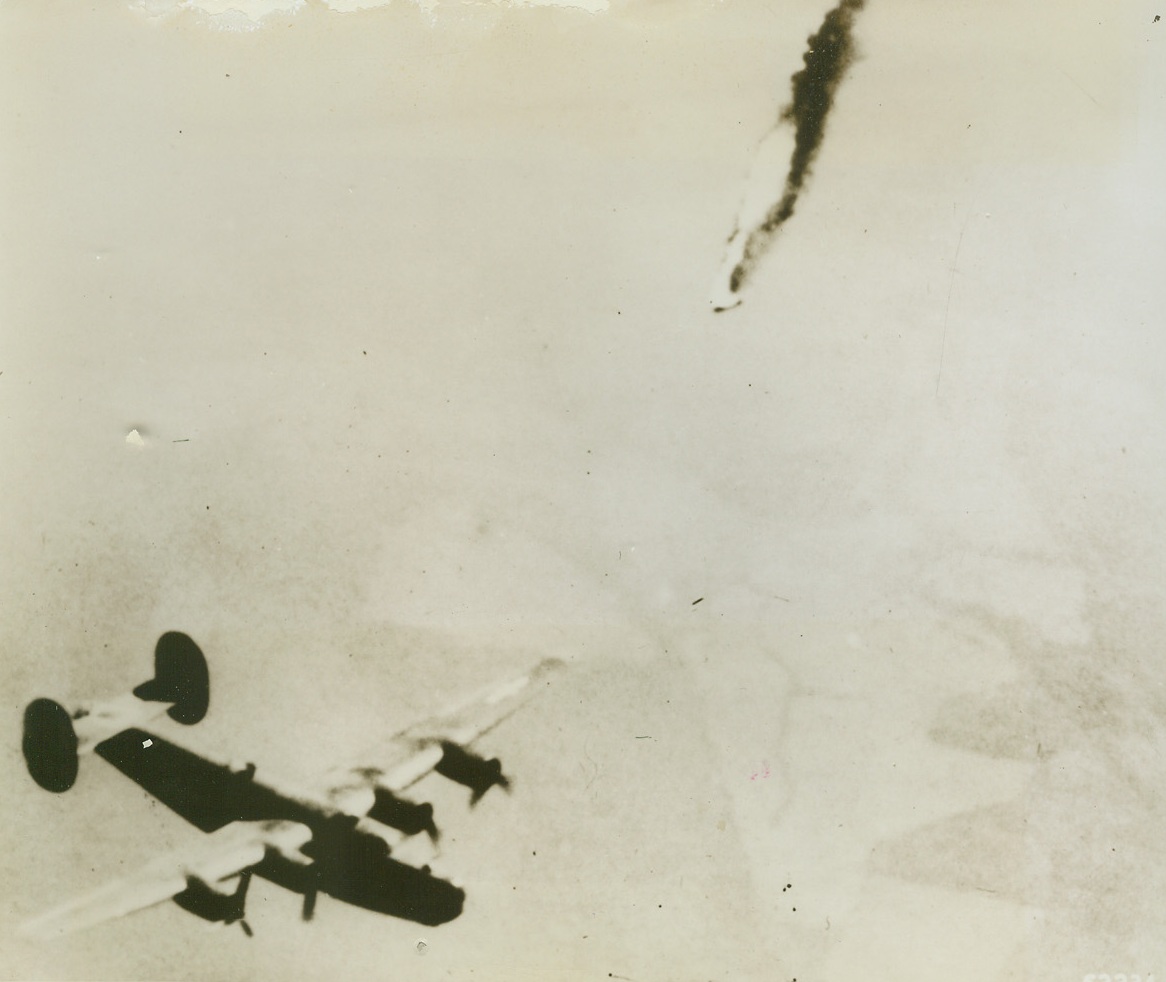
“Death Waltz” over Vienna, 7/13/1944. A Messerschmitt-109 fighter plane, trailing roaring flame and greasy, black smoke starts its spinning death dance toward the earth below. The Nazi ship tried to pounce on B-24 Liberators of the U.S. Army 15th Air Force over Vienna, Austria, but he met hot lead – and his “Waterloo.”Credit Line (USAAF Photo from ACME);
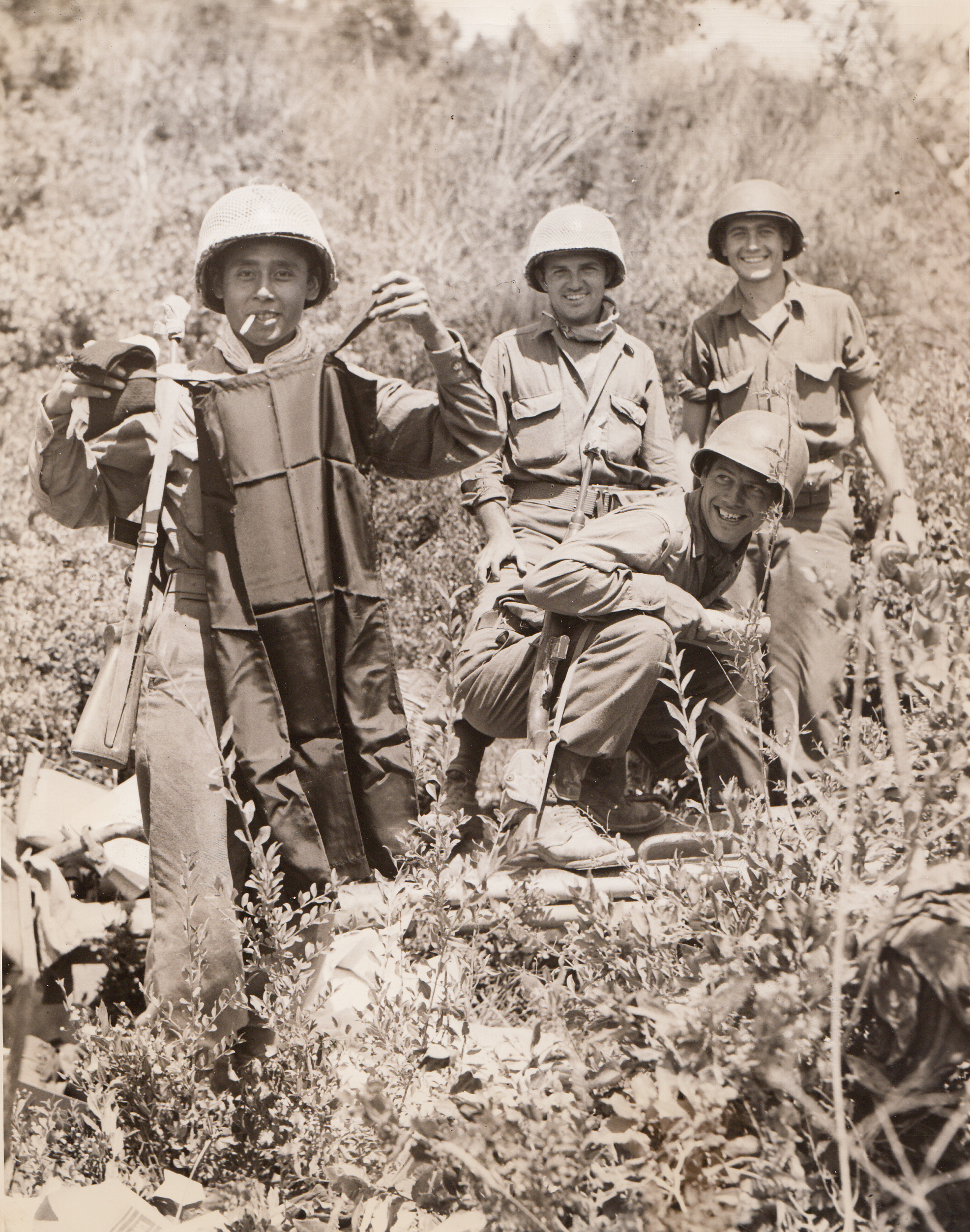
Silk Chemise Now Yank Prize, 7/24/1944. ITALY – Pfc. Ignacio Villarceal, San Antonio, Tex., proudly displays a black silk chemise, war booty which he found near a knocked-out German self-propelled gun in the kit of a dead Nazi. The Germans had looted the silk undergarment from an Italian store. Villarceal is a member of a recon unit near Leghorn.;
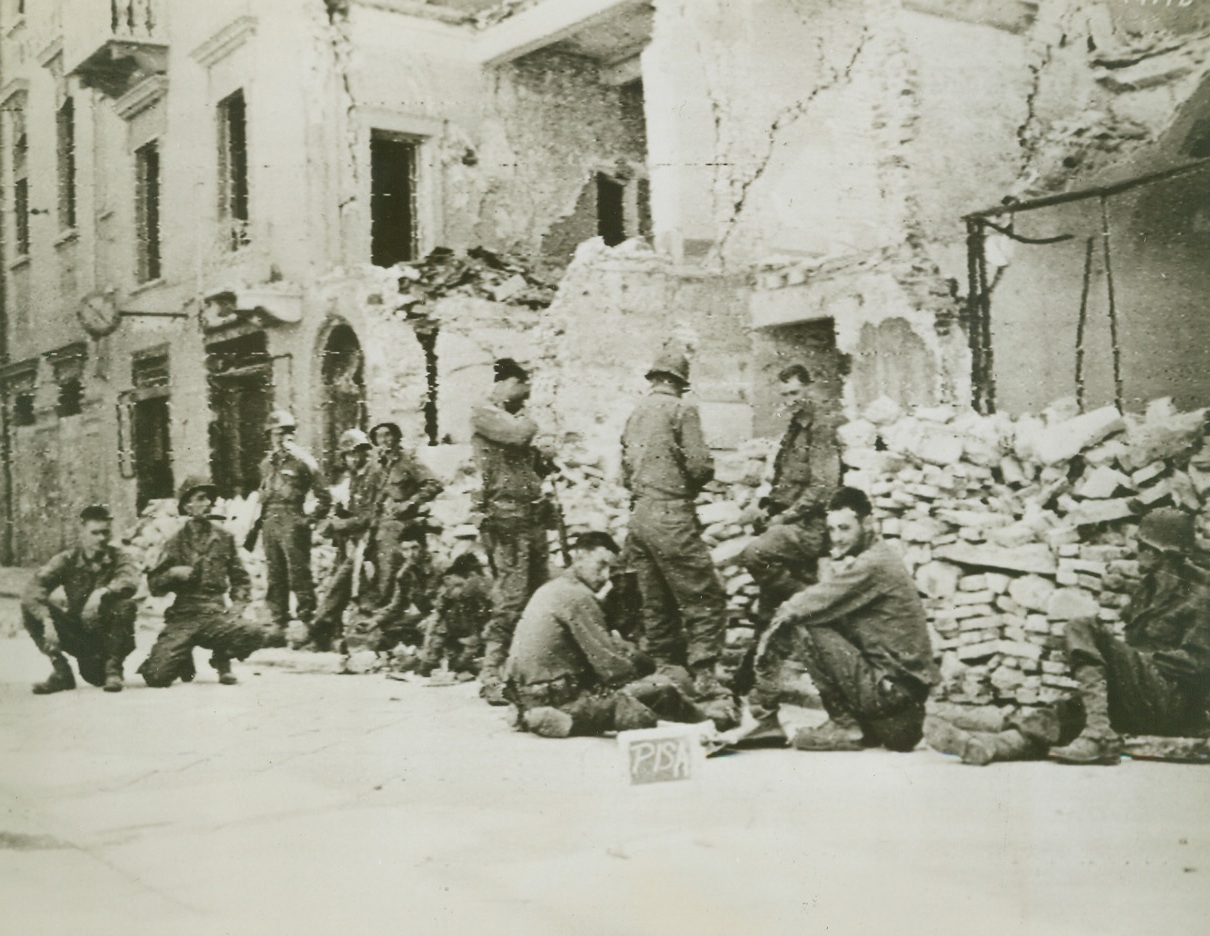
Chow Time for Yank Troops Near Pisa, 7/28/1944. ITALY – American troops find time for chow in the devastated outskirts of Pisa, being attacked by advancing forces of the Fifth Army. Opening stage in the battle for the historic Italian town has started with an artillery duel across the Arno River.Credit (Signal Corps Radiotelephoto from Acme);
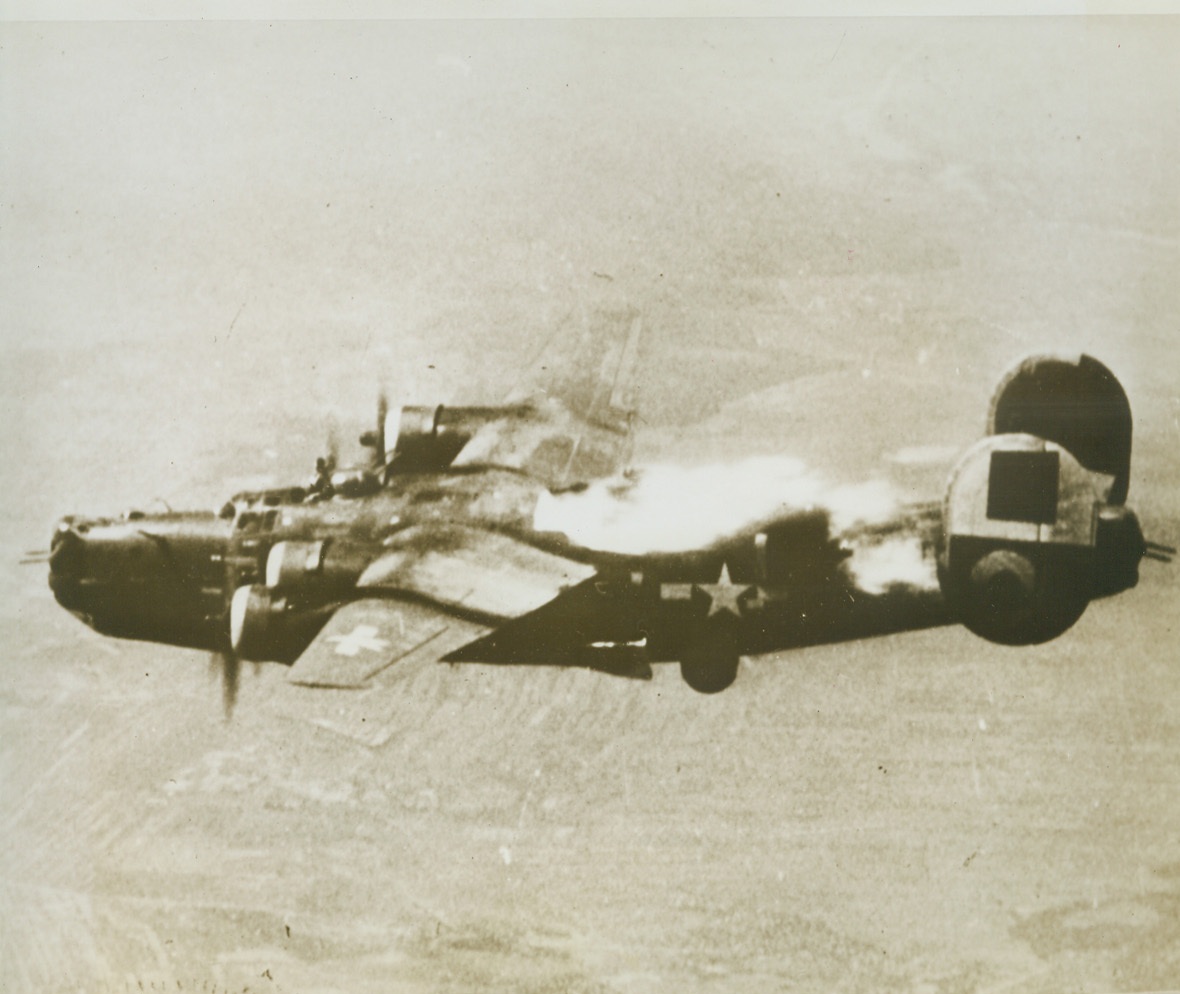
Death Waltz Over Vienna, 7/7/1944. VIENNA -- Mortally wounded in battle with a German ME-109 while on a mission over synthetic oil refineries in Vienna, a B-24 Liberator of the American 15th Air Force spouts flames from one of its motors and goes into its final death throes. Crew bailed out safely before the plane split in half for plunge to earth. Credit (USAAF Photo from ACME);
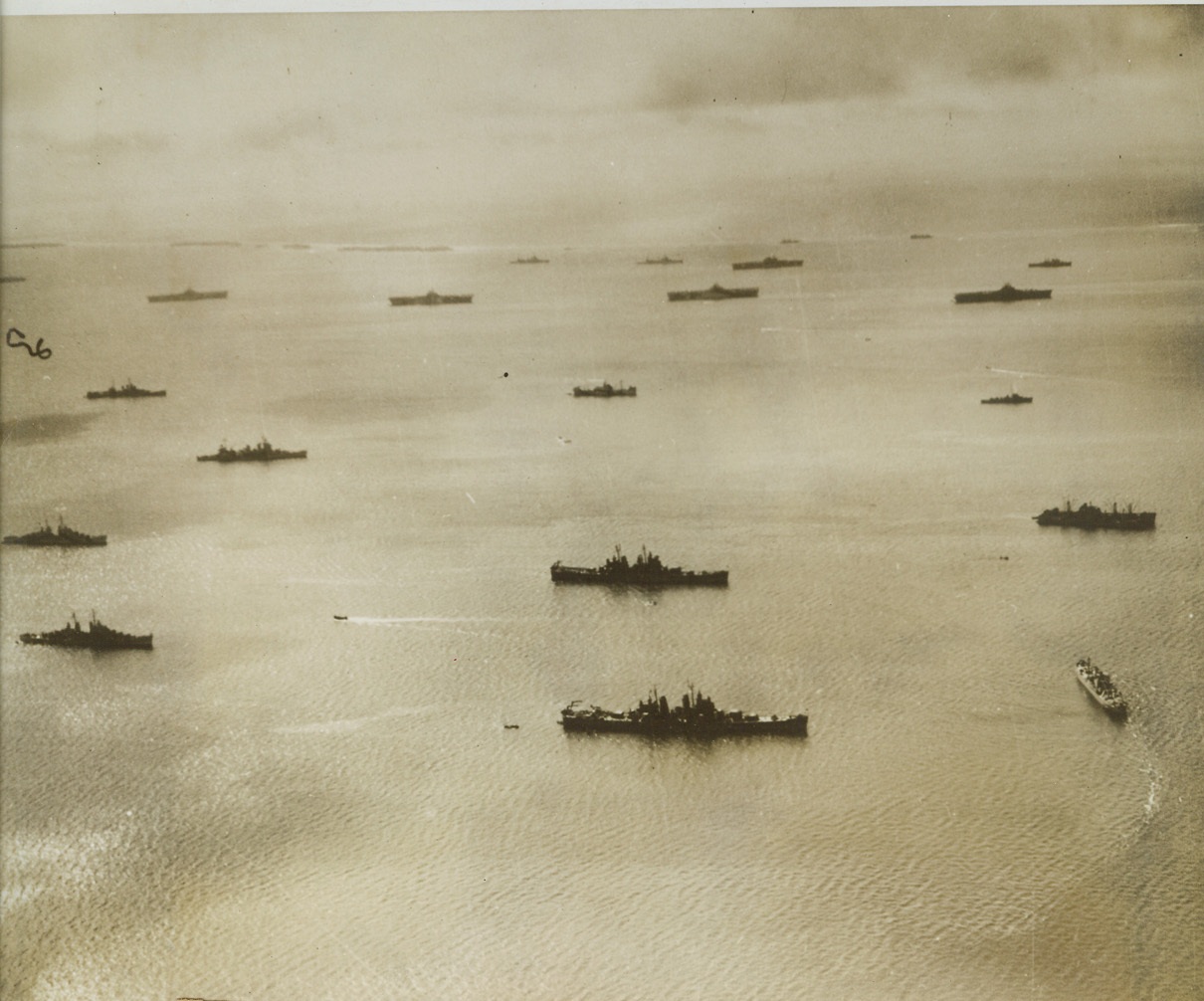
Recipe for Jap Nightmare, 7/8/1944. PACIFIC - Stretching as far as the eye can see all the ingredients that go into the making of a Japanese nightmare lie in wait for the next assignment after arriving in this Pacific harbor back from chasing the Jap fleet in the Philippine Sea. Six carriers are among this part of a might U.S. Navy Task Force anxious for another crack at the Japs. Forces like this one have struck repeatedly at enemy bases, coming within 500 miles on the Nipponese capital. Credit (US Navy Photo from ACME);
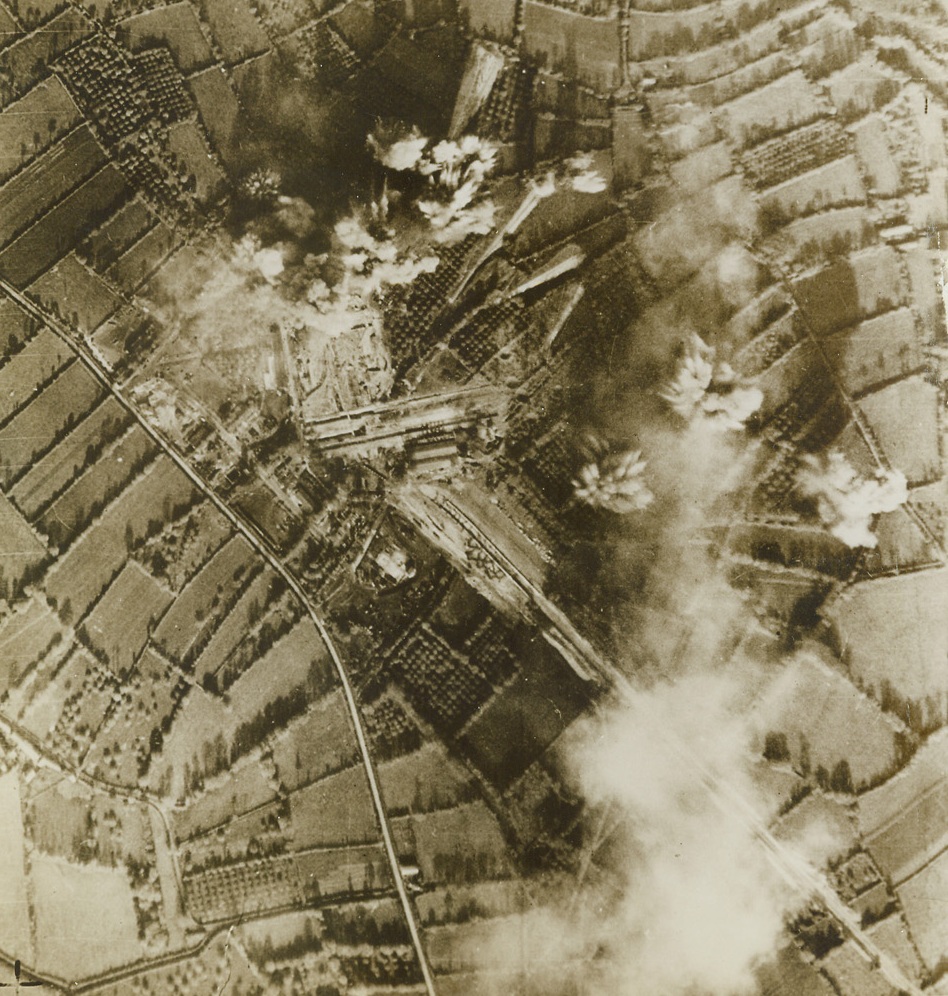
BLAST ROBOT BASES, 7/7/1944. Kept secret for security reasons, this photo reveals that the U.S. Army 9th Air Force Bomber and Fighter-bomber planes have been attacking for some time the sites and launching platforms of the Nazi pilotless planes—the alleged secret weapon of the enemy. Plainly visible bomb bursts concentrated in the target area indicate that this site was put out of commission temporarily at least. Credit: USAAF photo from Acme;
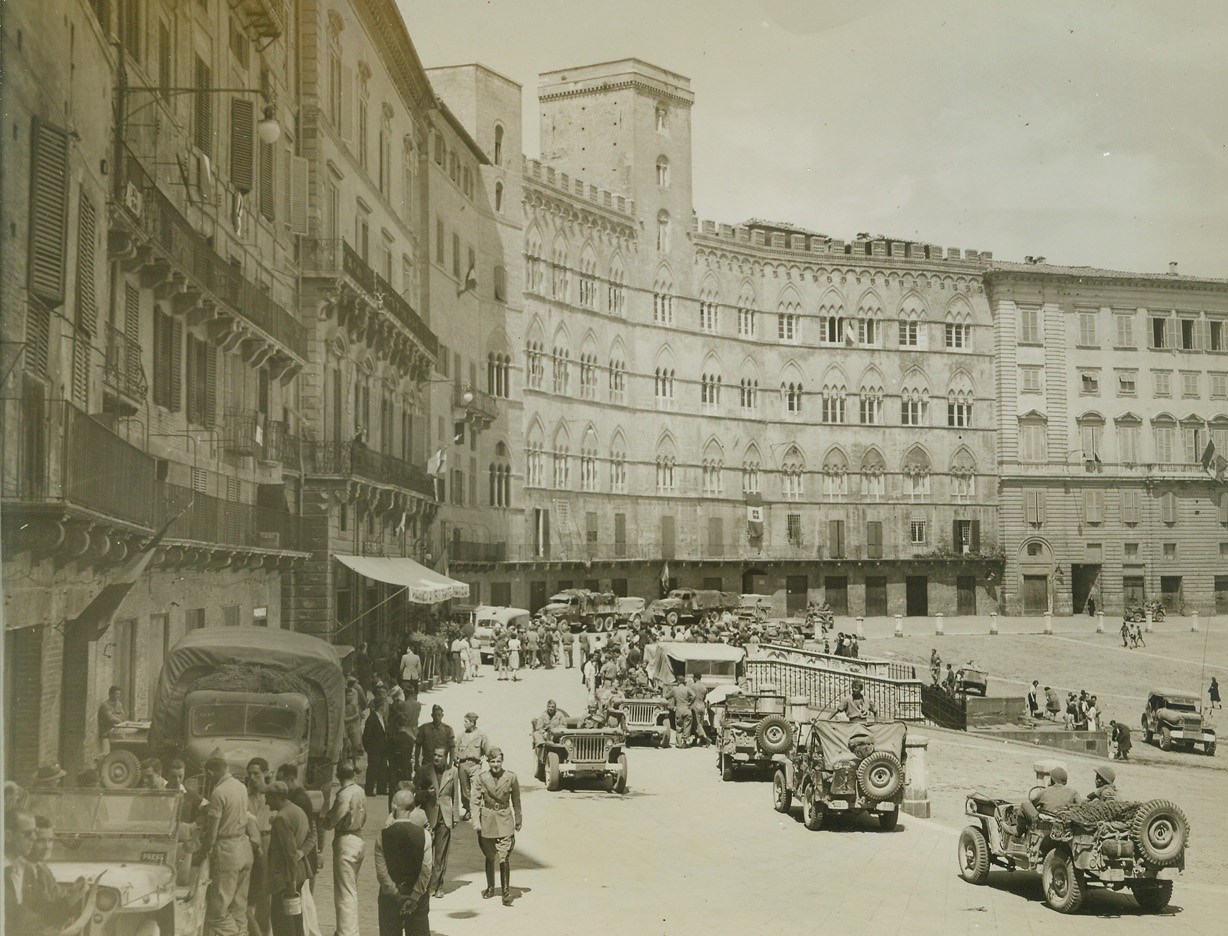
ALLIED TROOPS ENTER SIENA, 7/9/1944. ITALY—Jeeps roll through the street in the town square of historic Siena, one of the foremost art centers in Italy and the most perfectly preserved of the medieval cities on the Italian peninsula. Town was taken by French troops of the Fifth Army placing Allied forces only 25 miles from Florence. Note that the square is devoid of damage. Proof the the rapidity with which the Nazis are fleeing before the might of Allied forces in Italy. Bitter fighting is now raging in the rolling hills above Siena. Credit: Acme photo by Charles Seawood, War Pool Correspondent;
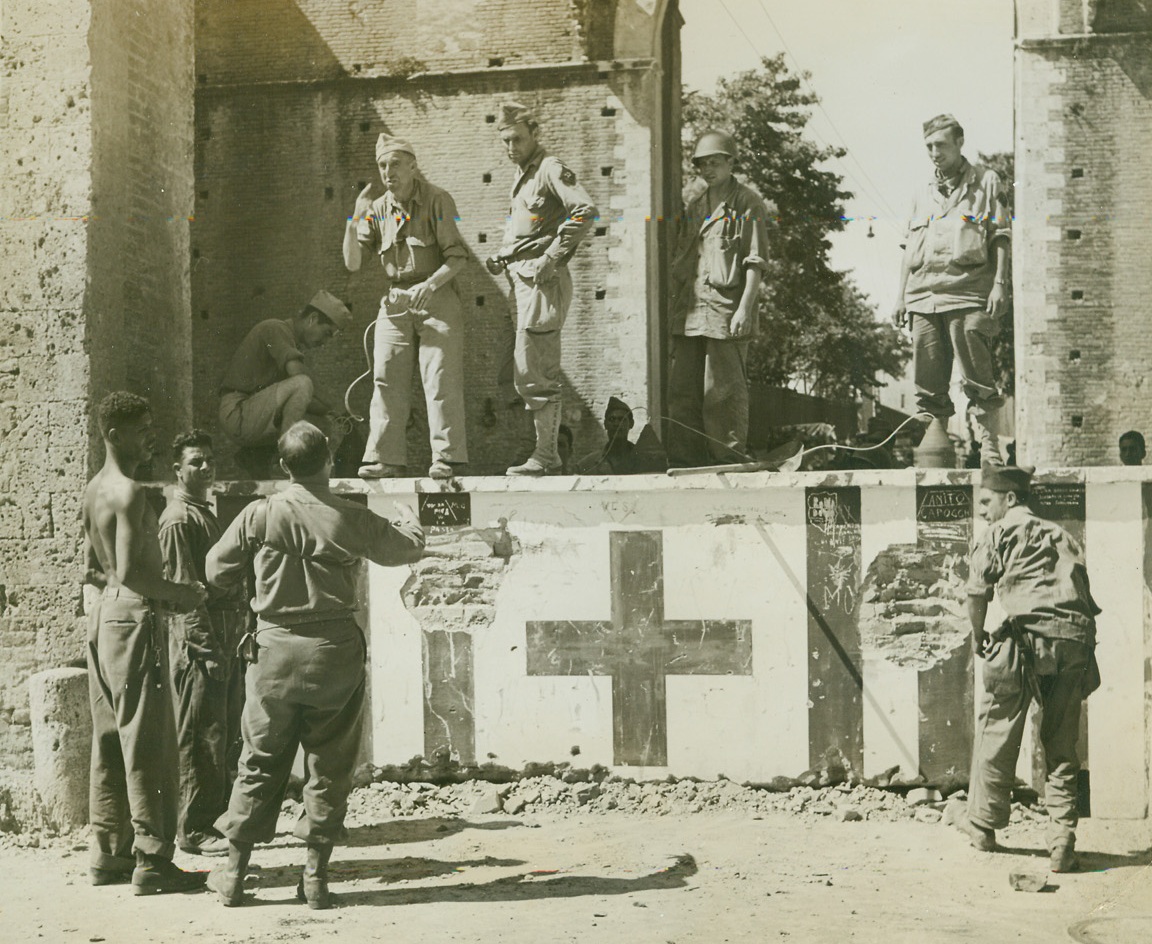
FRENCH CLEAR ROAD FOR ALLIED ADVANCE—#1, 7/9/1944. ITALY—When French troops of the Allied Fifth Army entered and captured Siena in Italy, they found this German road block in the middle of the town obstructing their rapid advance after the fleeing Nazis. Demolition squads got to work on the road block and blasted a path for the rolling, triumphant Allied forces. Here French demolition workers prepare the road block for blasting. Credit: Acme photo by Charles Seawood, War Pool Correspondent;
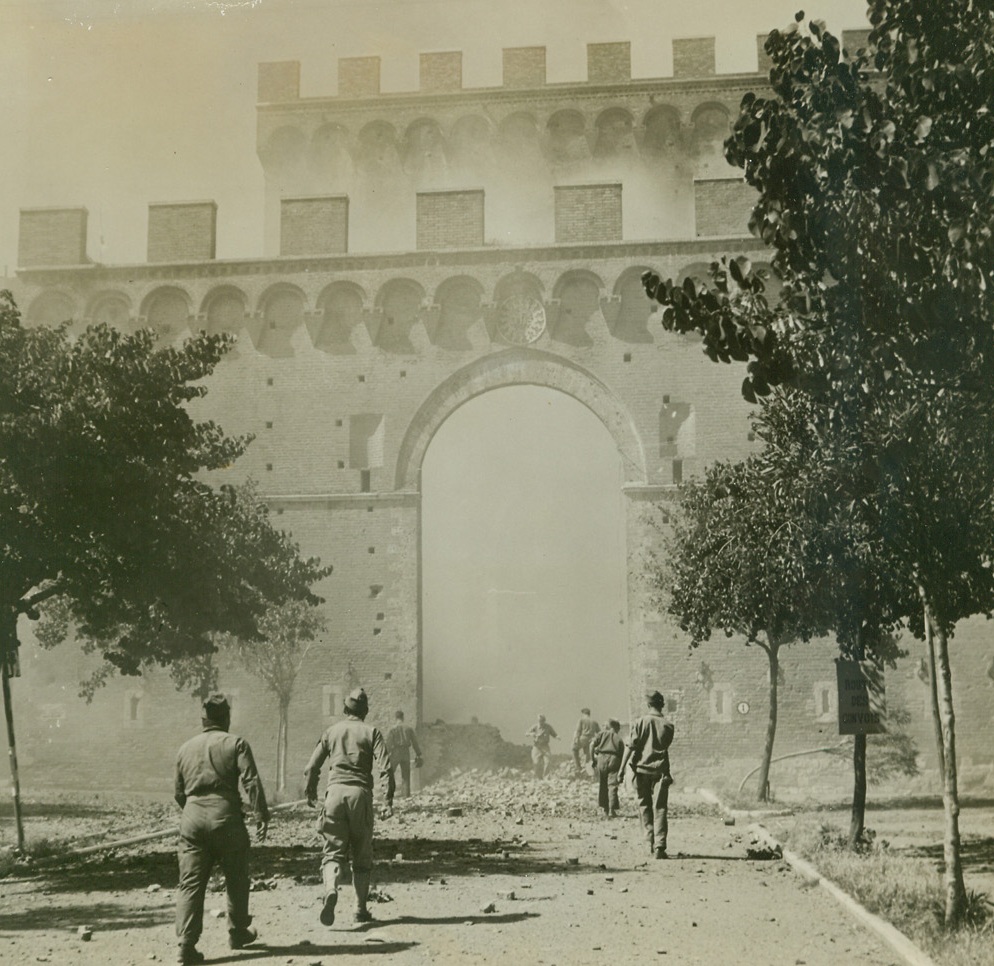
FRENCH CLEAR ROAD FOR ALLIED ADVANCE—#3, 7/9/1944. ITALY—French demolition workers race toward the blasted German road block they had just exploded in Siena, Italy. Road block halted Allied advance through the city hard on the heels of rapidly fleeing Nazis. Siena, only 25 miles from Florence, was recently captured by French troops of the Allied Fifth Army. Credit: Acme photo by Charles Seawood, War Pool Correspondent;
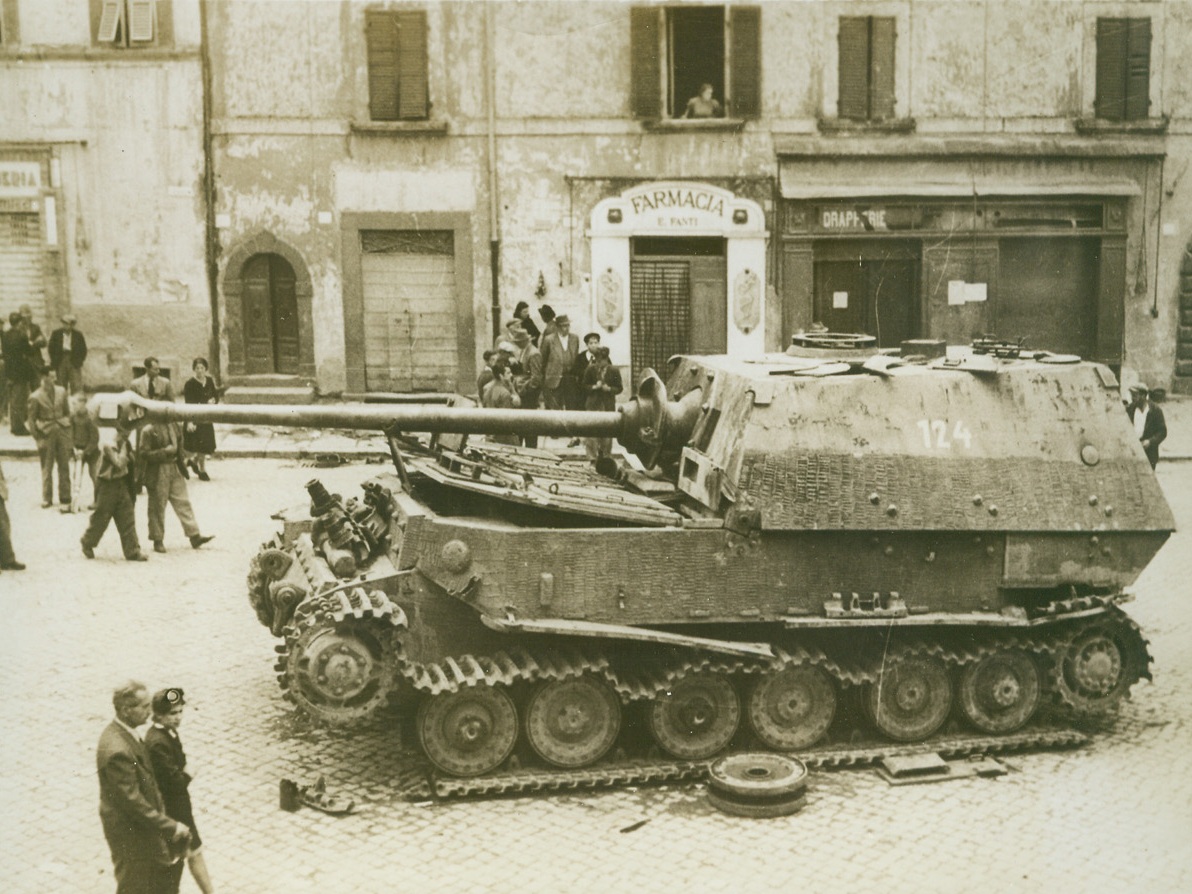
“FERDINAND” GETS LEFT, 7/4/1944. SORIANO, ITALY—Meet “Ferdinand,” the 70-ton, 88mm. self-propelled gun which the Nazis abandoned when they fled Soriano in the face of the British 8th Army attack. German forces usually blow up any vehicles or equipment which they have to leave behind, but evidently they were in too much of a hurry to take care of Ferdinand. Credit: British official photo from Acme;
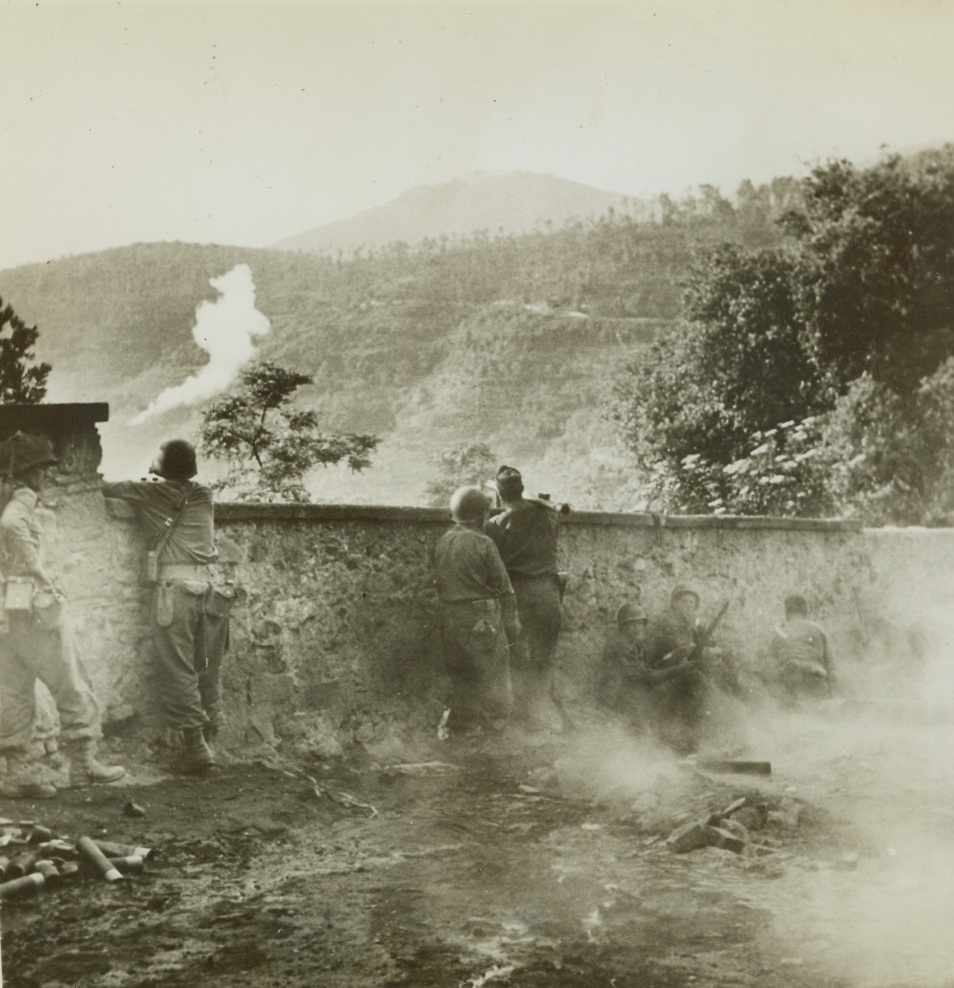
Yanks in a Spot – 4, 7/14/1944. Nemi Valley, Italy – Once the peaceful site of fragrant vineyards and the center of a flourishing wine-grape business, beautiful Nemi Valley, near Rome, was turned into a hot spot recently when a scouting patrol of Yank Infantrymen, guided by Italian partisans, found German strength much greater than they had suspected. Our boys had to fight their way out through holes in a wall of enemy machine gun fire. Now the tables are turned and the Yanks, protected by a stone wall, are dishing it out to enemy troops in the valley below. Credit: Yank Magazine photo from ACME;
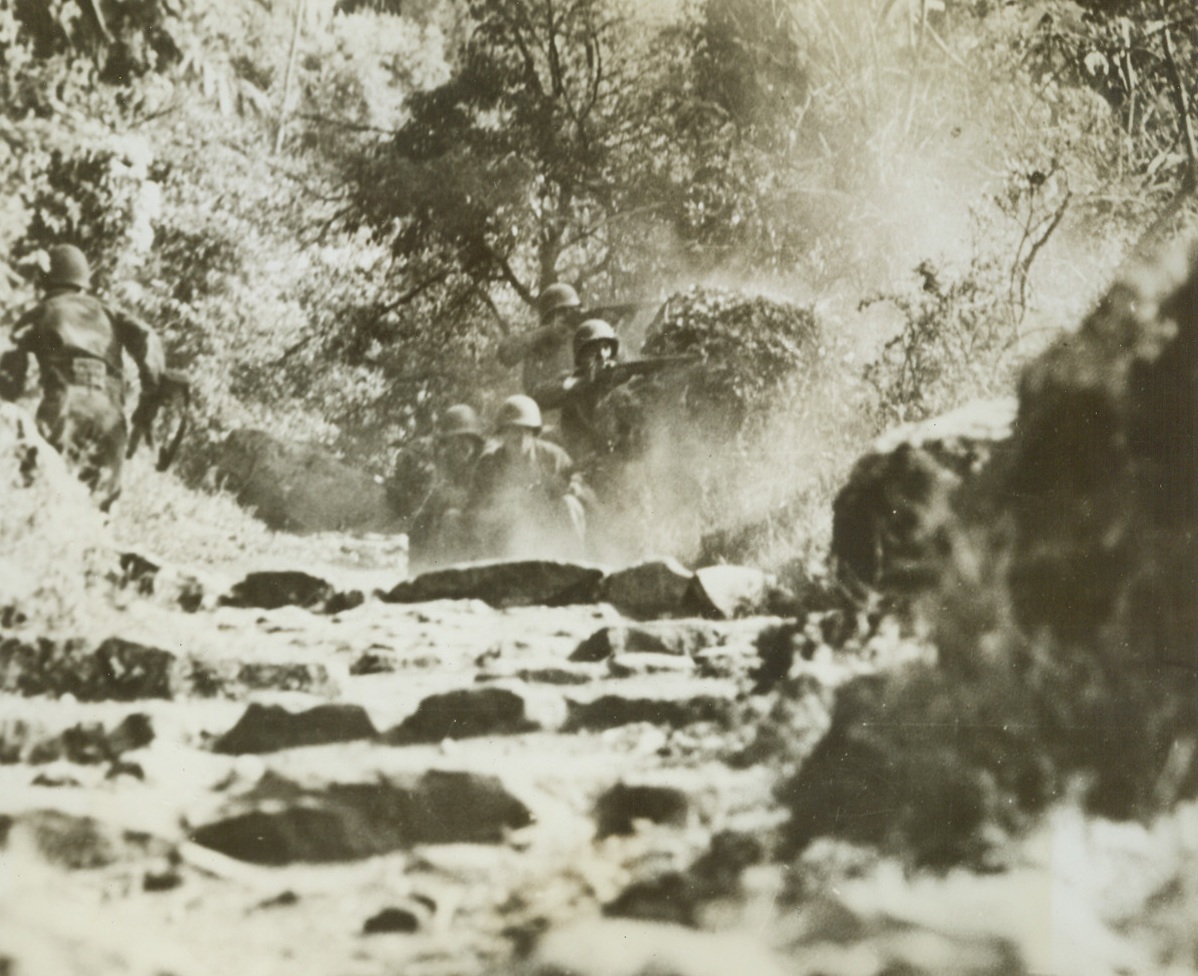
Yanks in a Spot – 3, 7/14/1944. Nemi Valley, Italy – Once the peaceful site of fragrant vineyards and the center of a flourishing wine-grape business, beautiful Nemi Valley, near Rome, was turned into a hot spot recently when a scouting patrol of Yank Infantrymen, guided by Italian partisans, found German strength much greater than they had suspected. Our boys had to fight their way out through holes in a wall of enemy machine gun fire. Here, dashing into cover provided by the bushes at upper left, the Yank shown running in ACME photo # Yan 730150 is safe. His buddies keep their guns barking as they wait for the next member of the patrol to make his break. Credit: Yank Magazine photo from ACME;
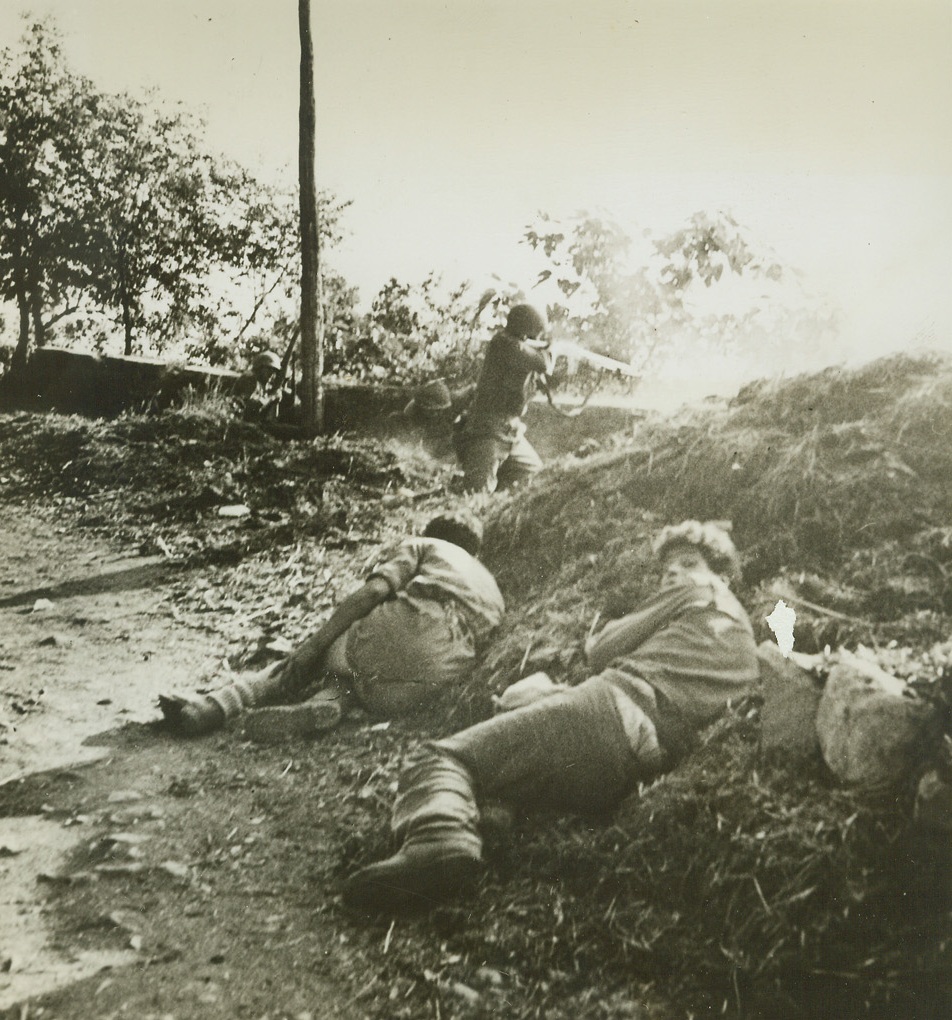
Yanks in a Spot – 5, 7/14/1944. Nemi Valley, Italy – Once the peaceful site of fragrant vineyards and the center of a flourishing wine-grape business, beautiful Nemi Valley, near Rome, was turned into a hot spot recently when a scouting patrol of Yank Infantrymen, guided by Italian partisans, found German strength much greater than they had suspected. Our boys had to fight their way out through holes in a wall of enemy machine gun fire. Here, Italians who led the fighters to concealed German positions in the valley crouch low behind a pile of debris as the Yanks send bullets screaming into enemy positions. Credit: Yank Magazine photo from ACME;
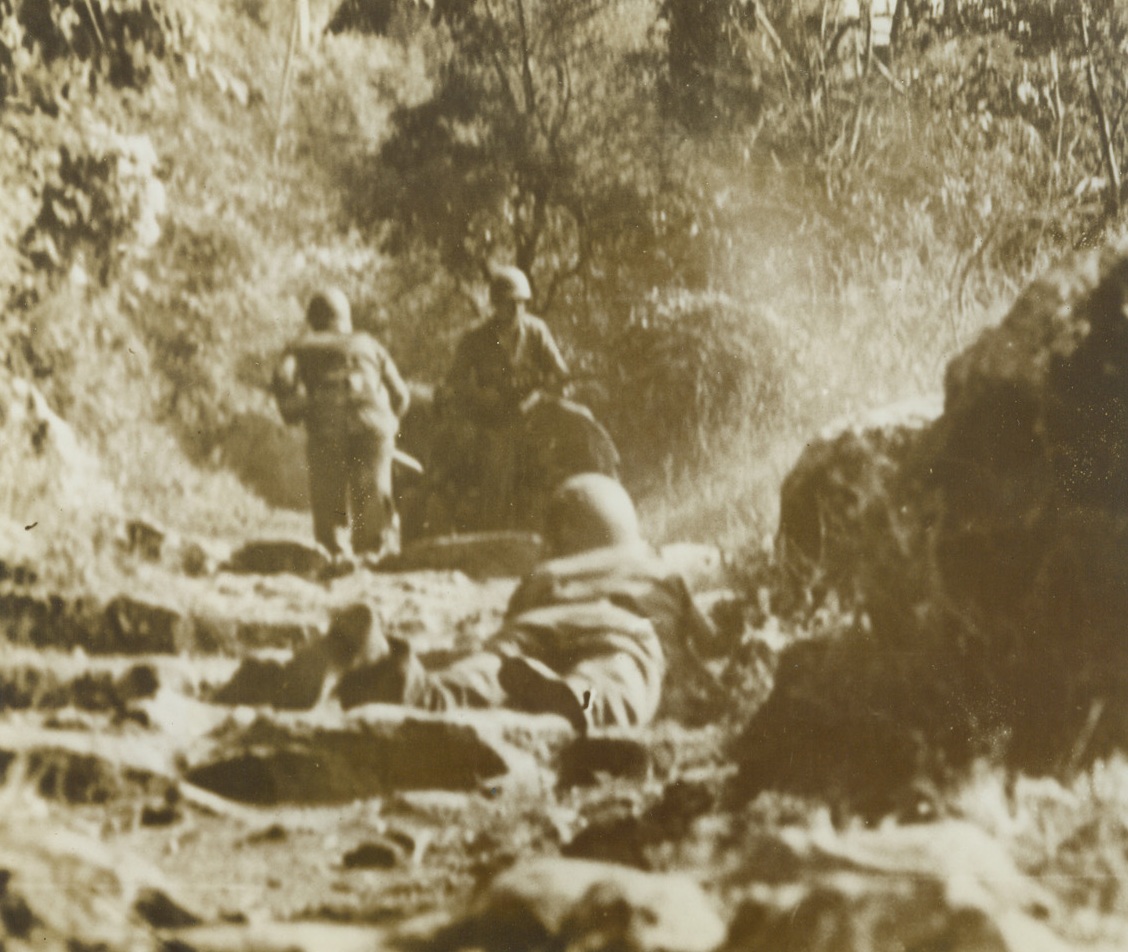
Yanks in a Spot – 1, 7/14/1944. Nemi Valley, Italy – Once the peaceful site of fragrant vineyards and the center of a flourishing wine-grape business, beautiful Nemi Valley, near Rome, was turned into a hot spot recently when a scouting patrol of Yank Infantrymen, guided by Italian Partisans found German strength much greater than they had suspected. Our boys had to fight their way out through holes in a wall of enemy machine gun fire. Here, one member of the patrol has completed his dash across the hot spot while another Yank lies on the ground, waiting his turn to run for it. Credit: Yank Magazine photo from ACME;
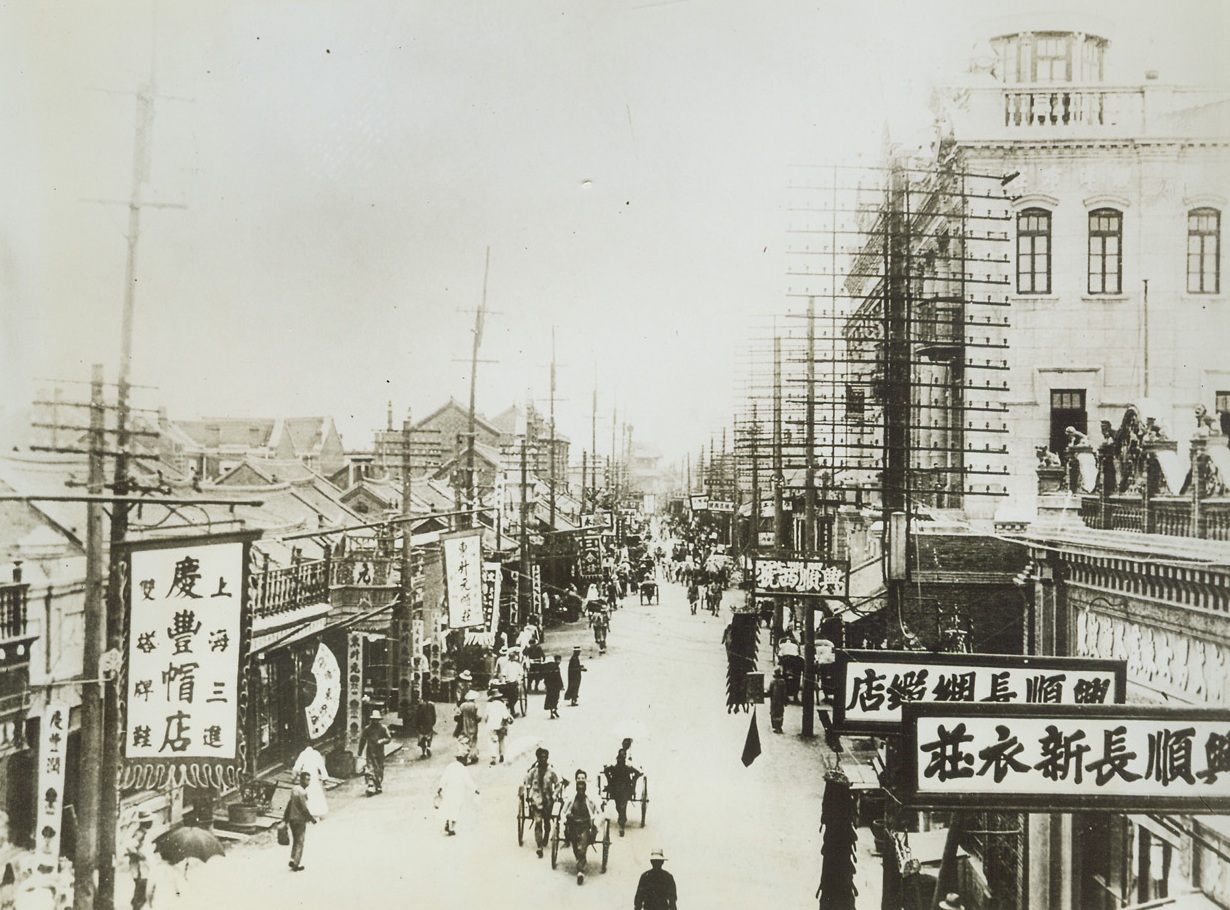
Superfortresses Blast Manchuria, 7/28/1944. In their first daylight attack, giant B-29 Superfortresses carried out their third raid on Japanese military objectives, smashing at industrial targets in the Mukden area of Manchuria. Mukden, a city of 2,880,000 is a heavy industrial center. The area is a concentration of steel, synthetic oil and ordnance works. In Mukden proper, shown above, is the Mukden arsenal, which manufactures arms and munitions and operates a power plant. Credit: ACME;
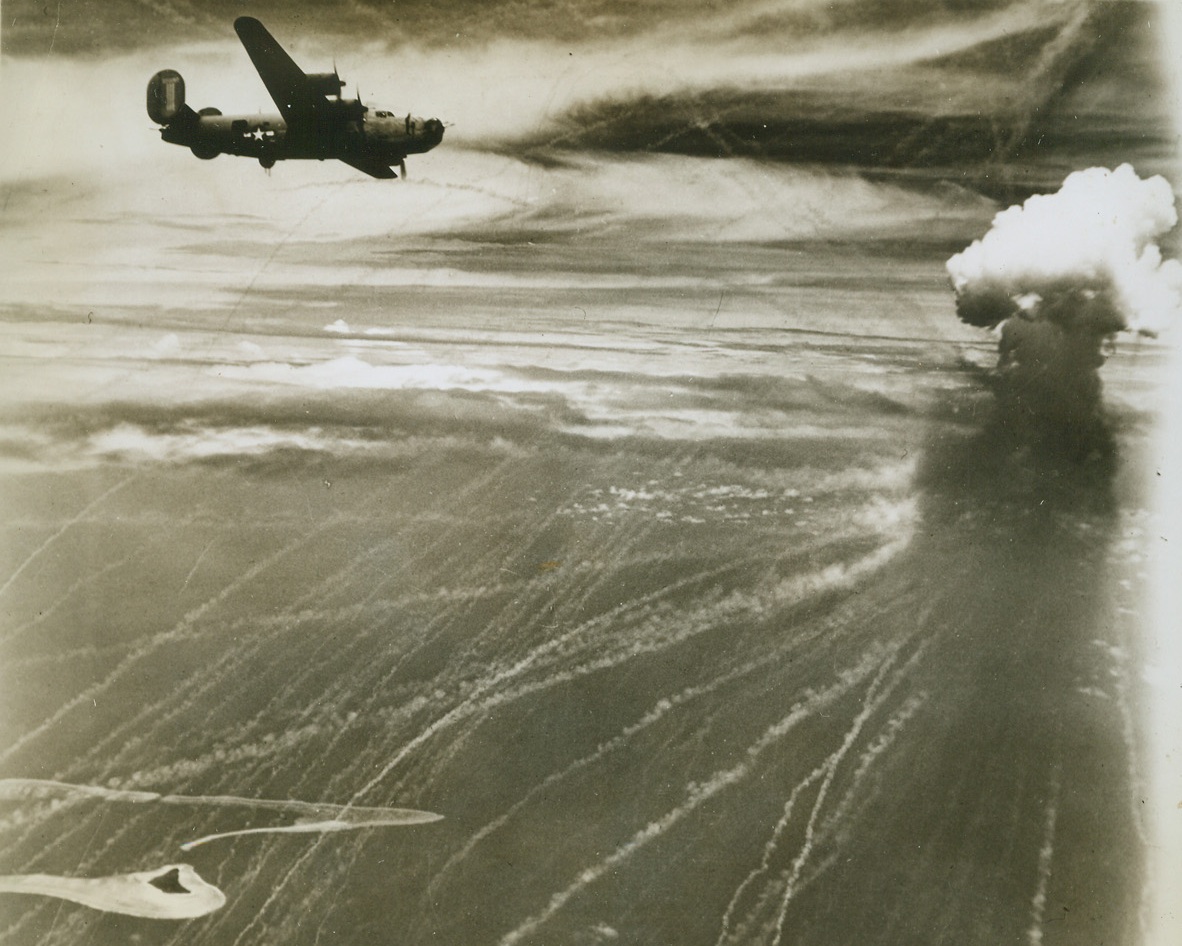
Flying Through Phosphorus, 7/21/1944. Truk – Its bomb load delivered to Truk (lower left), which is now under constant attack, a Liberator heads homeward through a phosphorus-filled sky. One of the phosphorus bombs, dropped by Jap planes at least 1000 feet above the B-24, explodes at right. Credit: U.S. 7th Air Force photo from ACME;
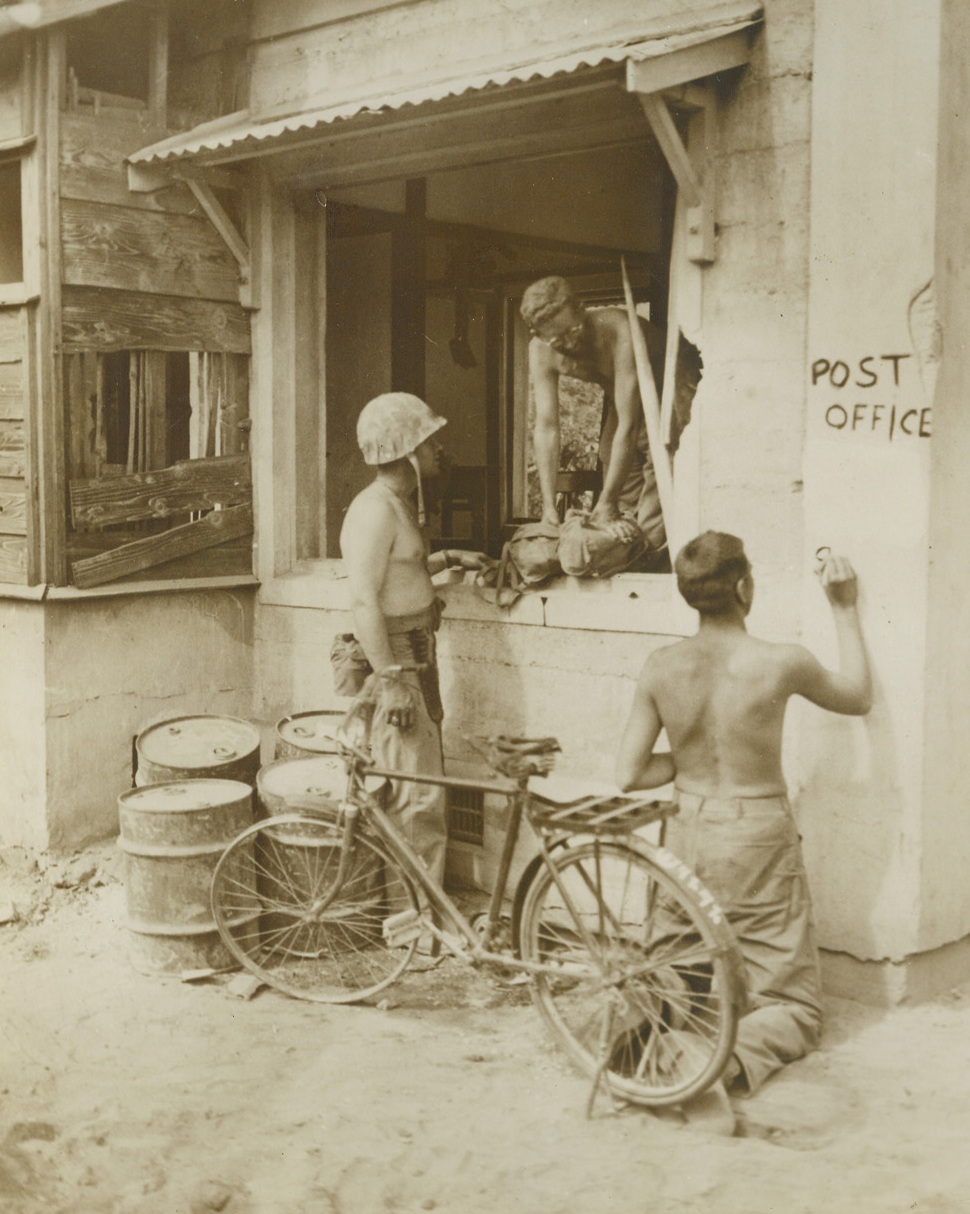
P.O. but no O.P.A., 7/3/1944. Saipan – Marine Postal Clerks set up a post office in a vacant Jap building on Saipan. Office is complete to the painted shingle. One of the Leathernecks commandeered a Jap bicycle but the rubber situation being what it is, couldn’t get a front tire for the vehicle. Credit: Marine Corps Photo from ACME;
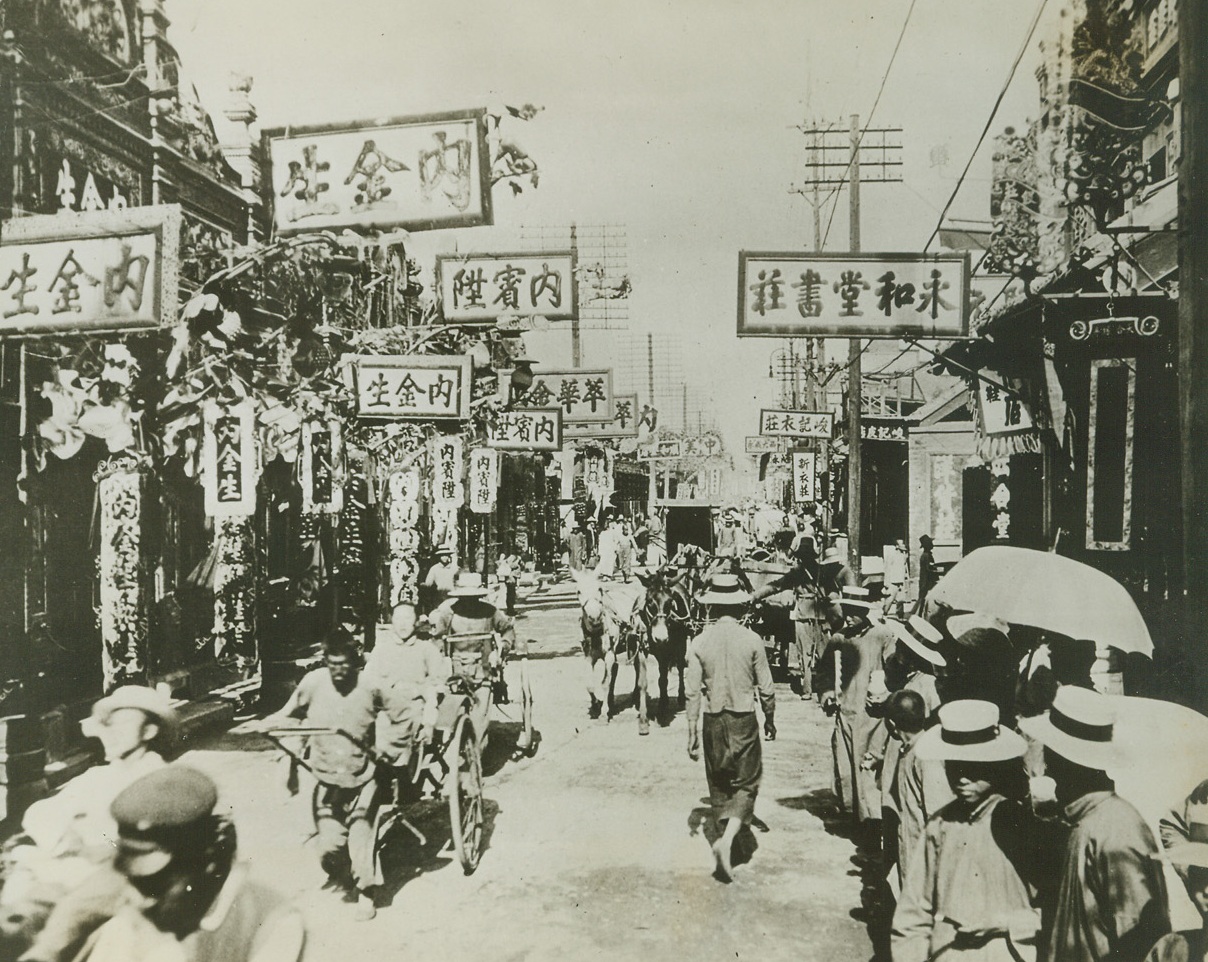
Superfortresses Blast Manchuria, 7/28/1944. Carrying out their third raid on Japanese military objectives, U.S. Army Superfortresses have smashed at industrial targets in the Mukden area of Manchuria. The area is a concentration of heavy industries including steel, synthetic oil and ordnance. Mukden, shown above, is a city of 2,880,000. Among its industries are the Mukden Arsenal, which manufactures arms and munitions and operates a power plant. Credit: ACME;
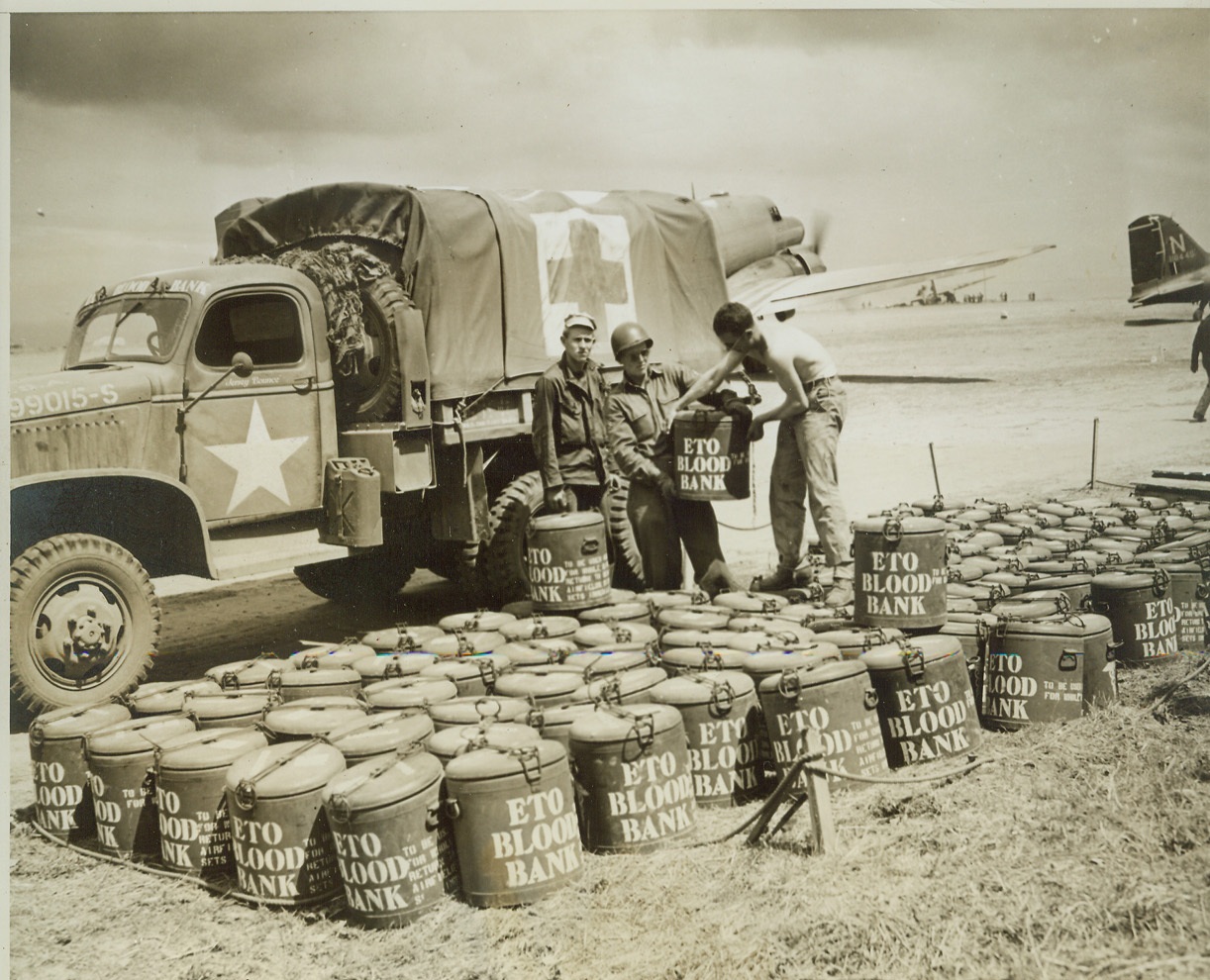
Blood for Wounded Americans, 7/22/1944.FRANCE -- Sealed containers of blood for transfusions to wounded Yanks are lined up in a field in Normandy after being delivered by transport plane. This life-restoring fluid has already saved and will save many lives. While American soldiers in France are giving their lives for the cause of freedom, civilians can also play a vital role in that cause by giving blood to the American Red Cross Blood Bank. In this simple and painless way, each civilian can feel that part of him or her has reached a fighting front and has helped to save some soldier's life. Credit-WP-(ACME Photo by Bert Brandt, War Pool Correspondent);
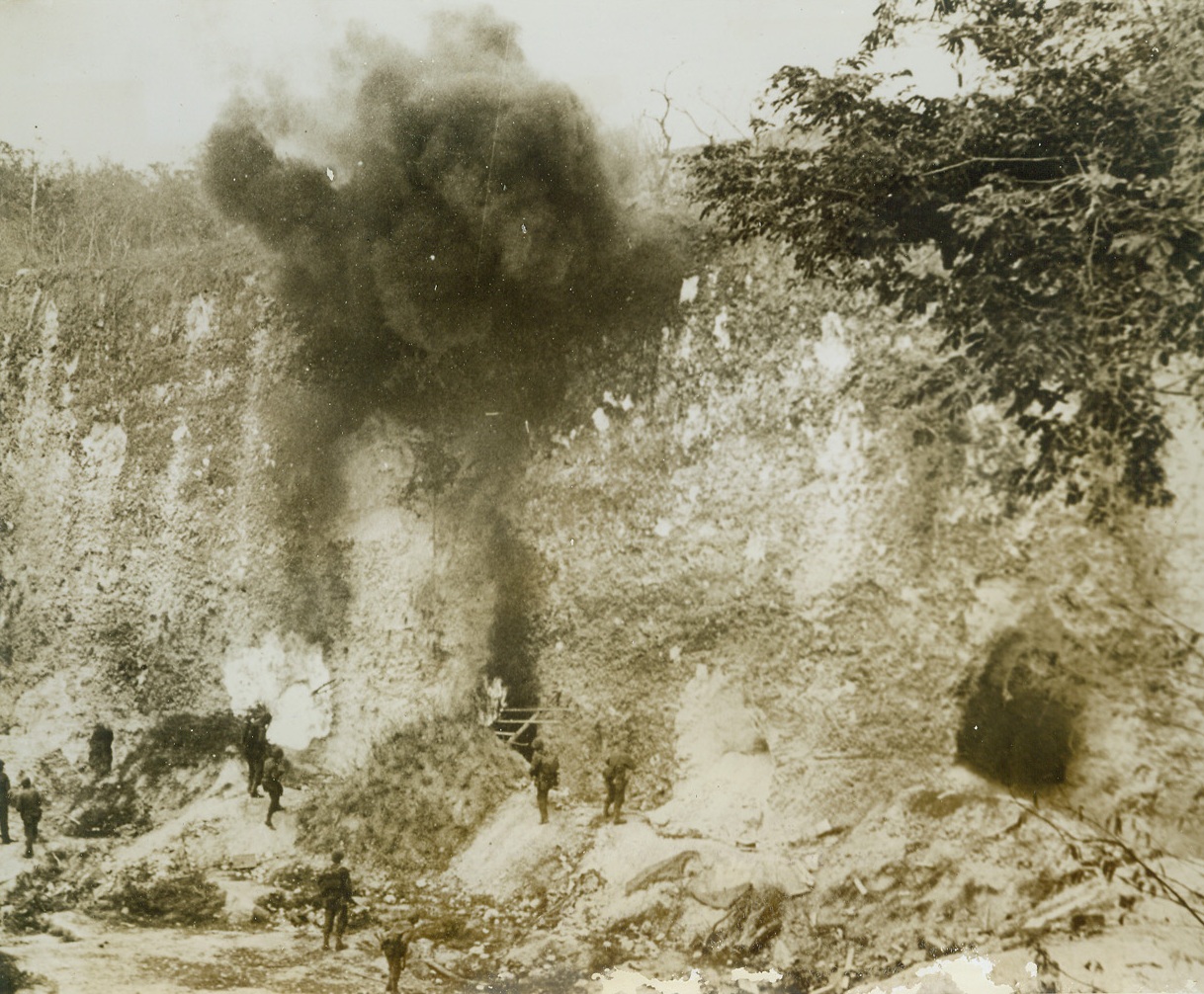
Burning Out Japs on Saipan, 7/13/1944. Marianas – American troops use flame throwers to roast the Japs out of cave hideaways in a quarry of Saipan, important base in the Marianas. U.S. forces have ended all organized Jap resistance on the island, and are using its excellent airfields for attacks on other Jap stongpoints. (Passed by Censors)Credit: ACME;
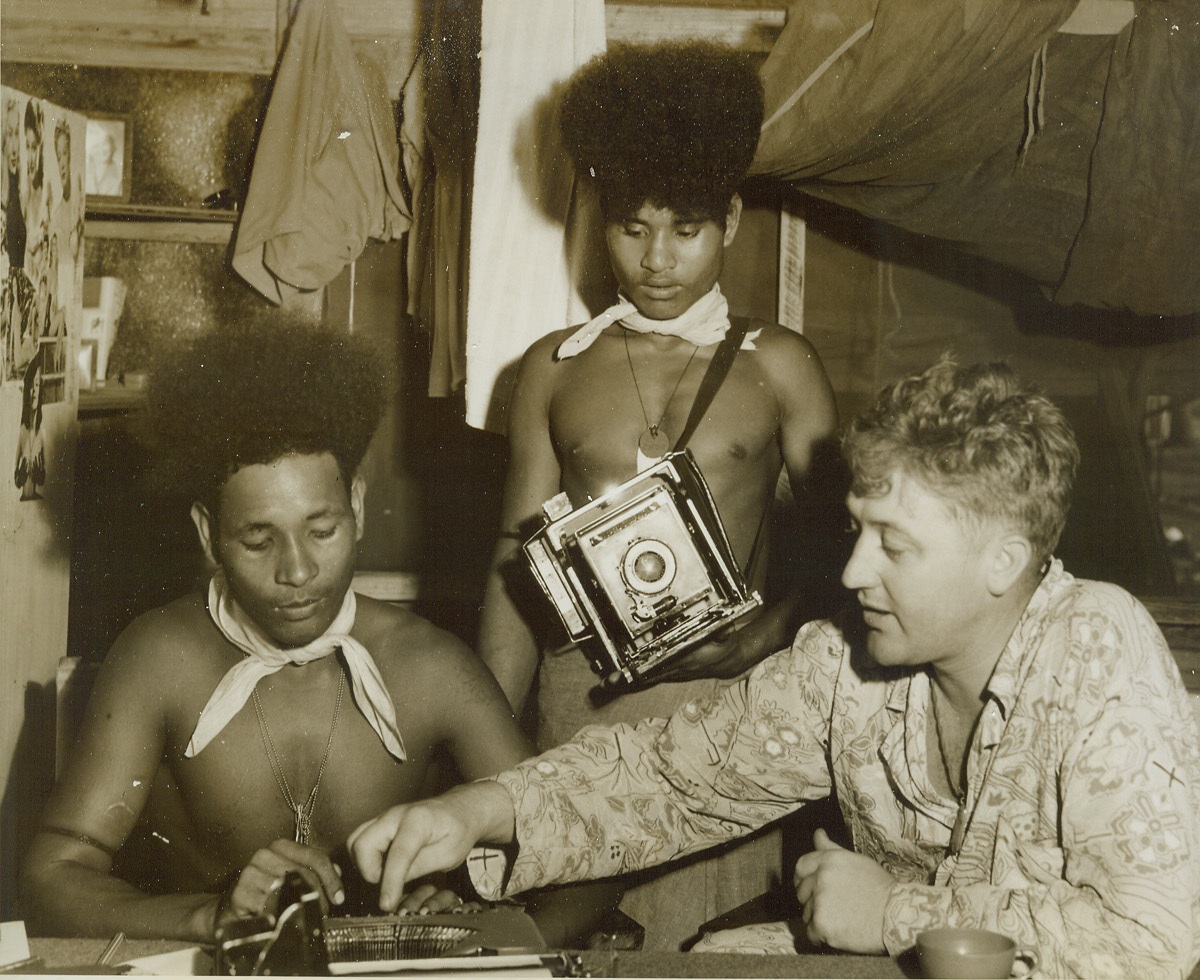
ACME Photo Turned New Guinea Prof., 7/14/1944. Port Moresby, New Guinea – ACME Newspictures War Correspondent, Frank Prist, Jr. seems to be in fairly good shape for secretaries at his office in Port Moresby, New Guinea. To make sure that his native help know the workings of American machines he is well prepared, and qualified, to turn professor of typewriterology. As he teaches one of the boys where to punch the dollar sign on the keyboard, the other turns the tables on Prist and becomes cameraman for the occasion. By the way, that’s Prist on the extreme right.Credit: ACME photo by Frank Prist, Jr., War Pool Correspondent.;
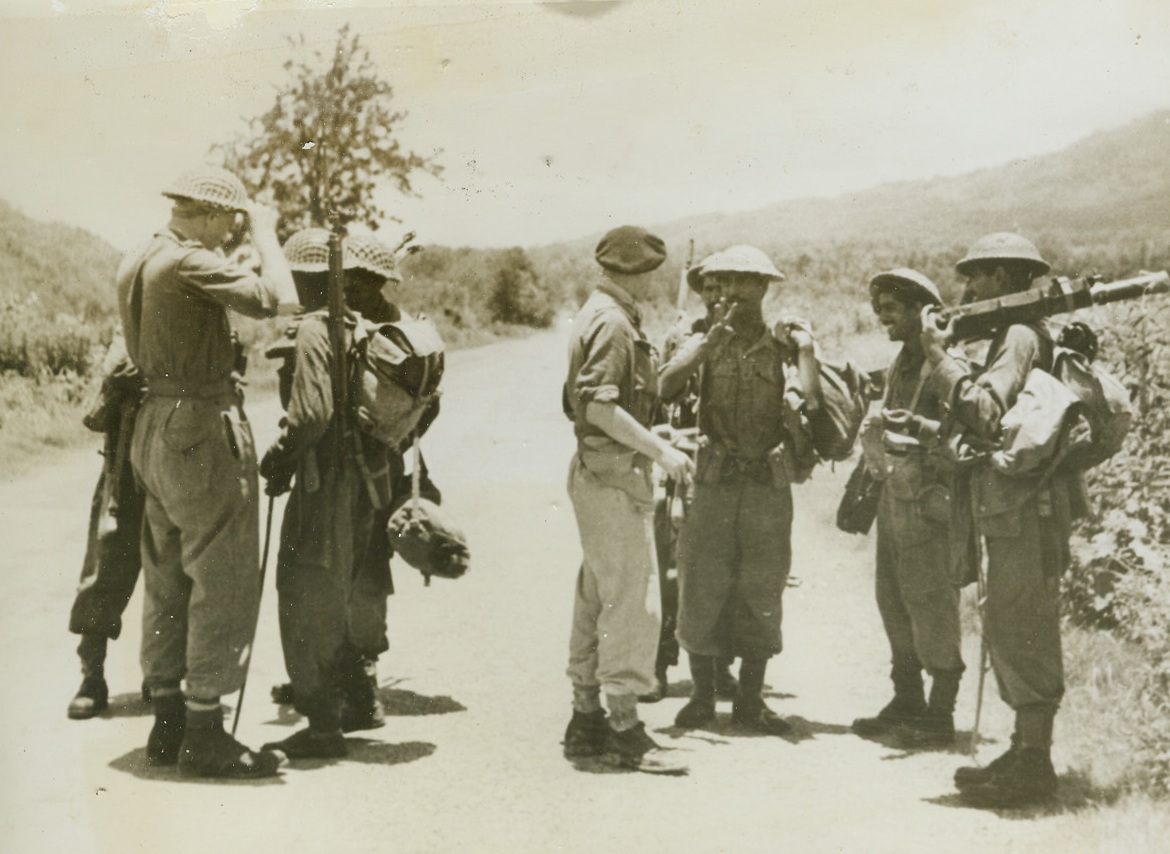
Troops Meet – Imphal-Kohima Road Opened, 7/14/1944. Burma – British Officers who had battered their way southward through Kohima greet Indian Troops from the south after the two groups of fighting men joined forces north of Imphal in a move that opened the whole of the Imphal-Kohima Road and eliminated further penetration by the Japs into India. Fighting under the worst possible monsoon conditions, and in the most bitter battles on the Burma front, remnants of Japanese Forces were cleared from the last part of the road.Credit: British Official photo from ACME;
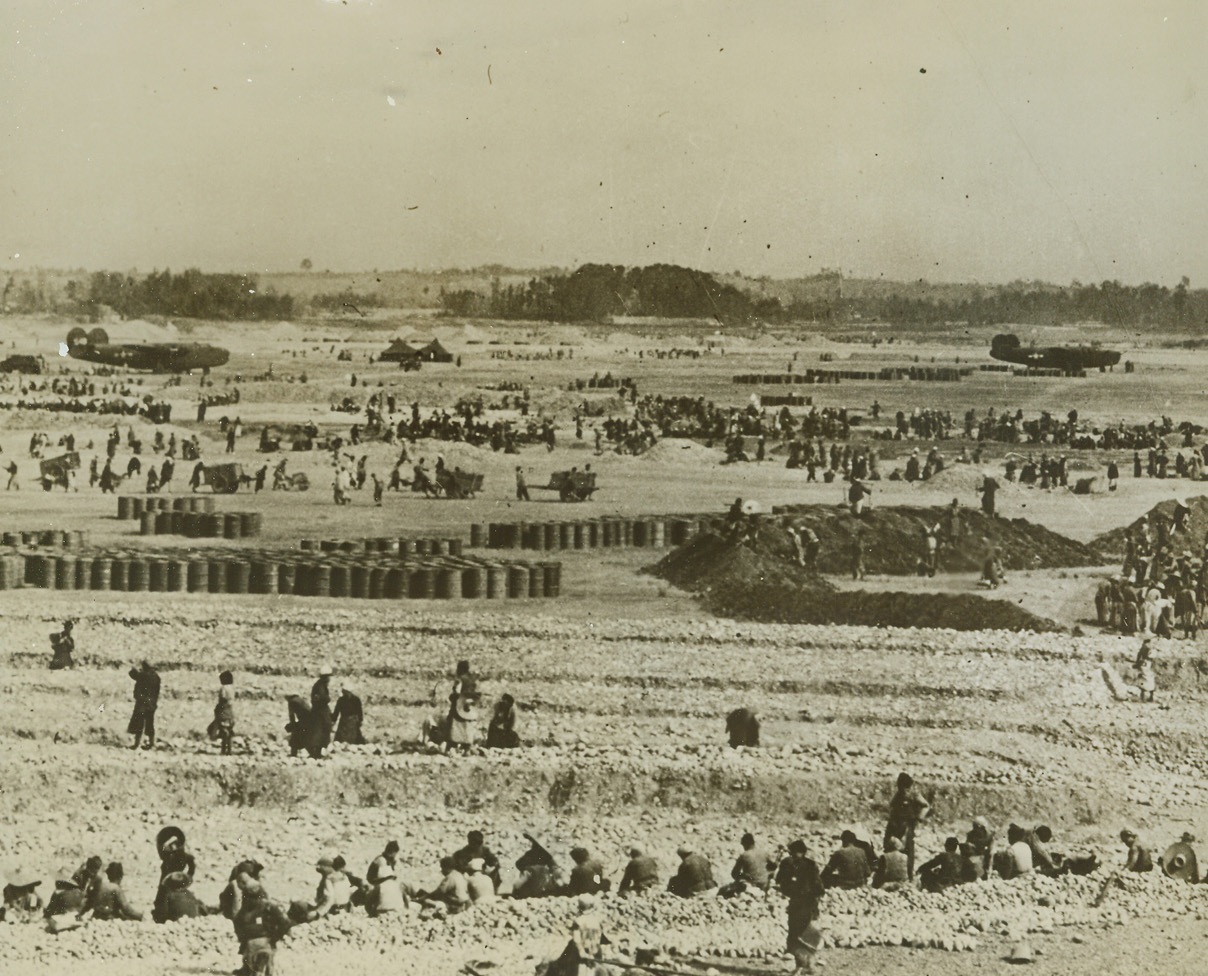
Home for Super Forts, 7/16/1944. This field in Western China is a beehive of activity as Chinese peasants cart up river-bed stone to be used in the construction of an airbase for 20th Bomber Command Superfortresses. The stone is crushed by the only machine used in the construction work. It will be used to cover the landing strips. Note the large number of oil and fuel drums in the center. C-47 transport planes in the background landed before the field was completed.Credit: ACME;
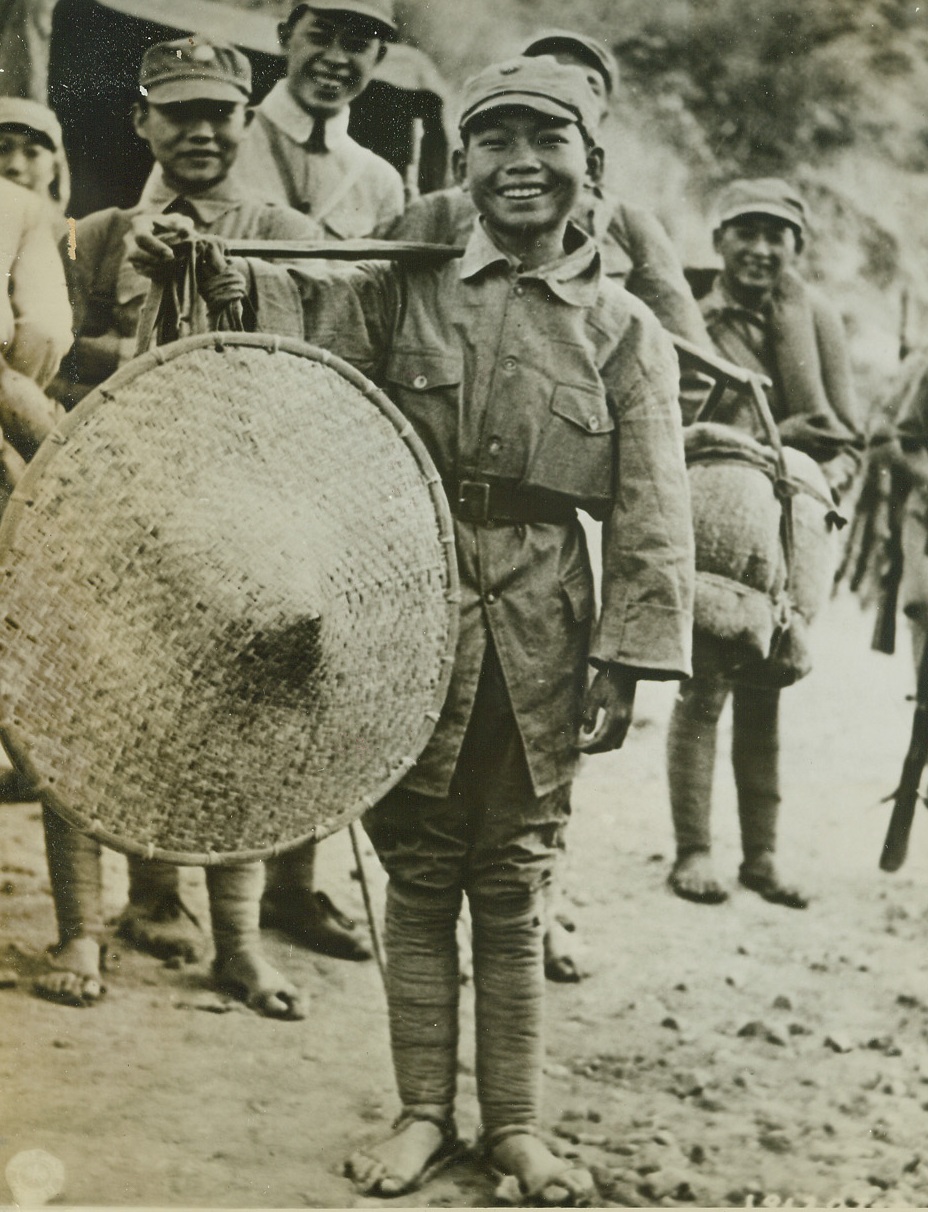
Young Chinese Soldier, 7/15/1944. China – Seven-year-old Pvt. Koo Ho King is graphic proof that youth is no barrier to service in the Chinese Army. Many of the best soldiers in the Chinese Armies are youngsters in their teens. Here Pvt. Koo and some of his fellow soldiers move up supplies in the offensive against the Japs along the Salween River Front.Credit: Signal Corps photo from ACME;
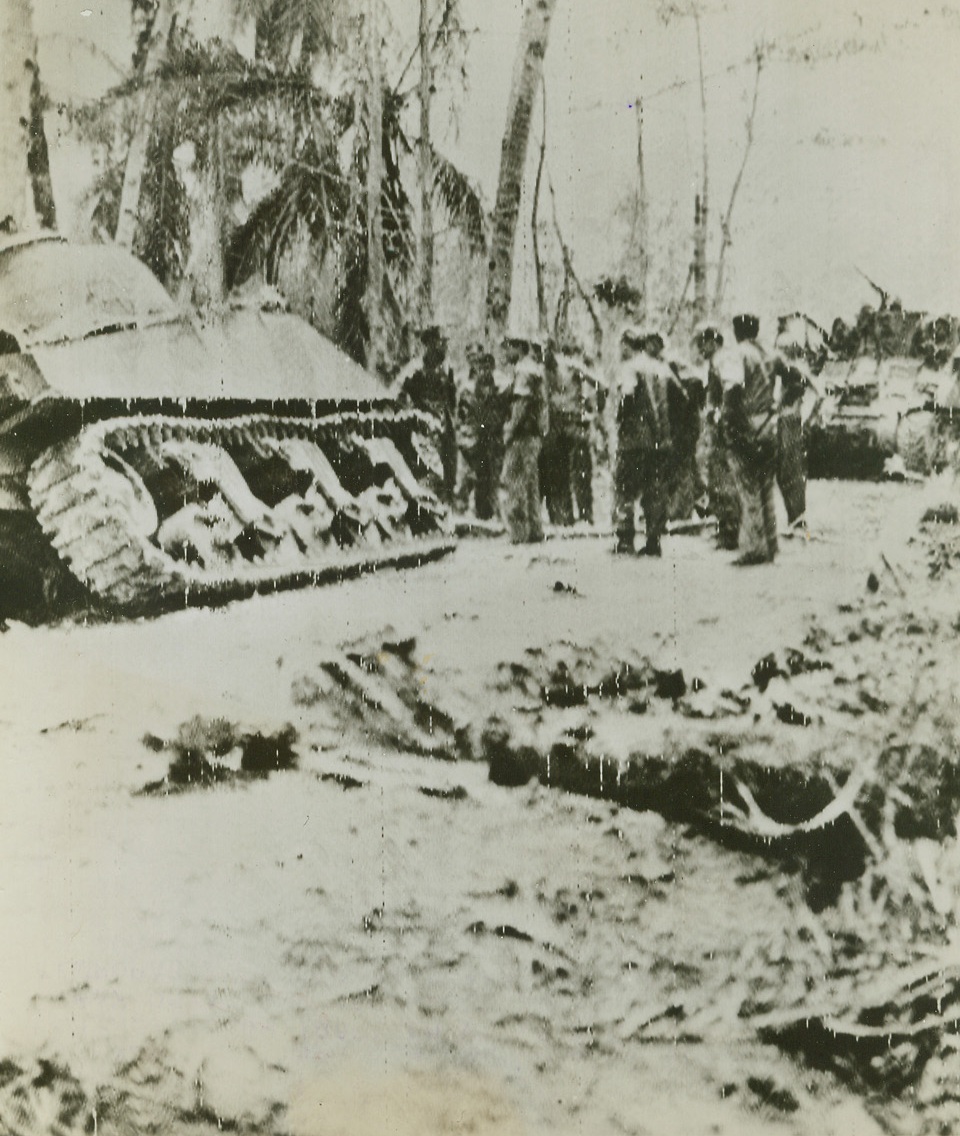
First Photo of Yank Troops in Guam, 7/29/1944. Guam – In this first photo to arrive here from the new fighting front on Guam, a group of Marines bunch together while clearing a tank trap on a road after one of their tanks was temporarily put out of action. Yanks are hot in pursuit of Japs occupying this first of American Pacific possessions to fall into enemy hands.Credit: Signal Corps Radiotelephoto from ACME;
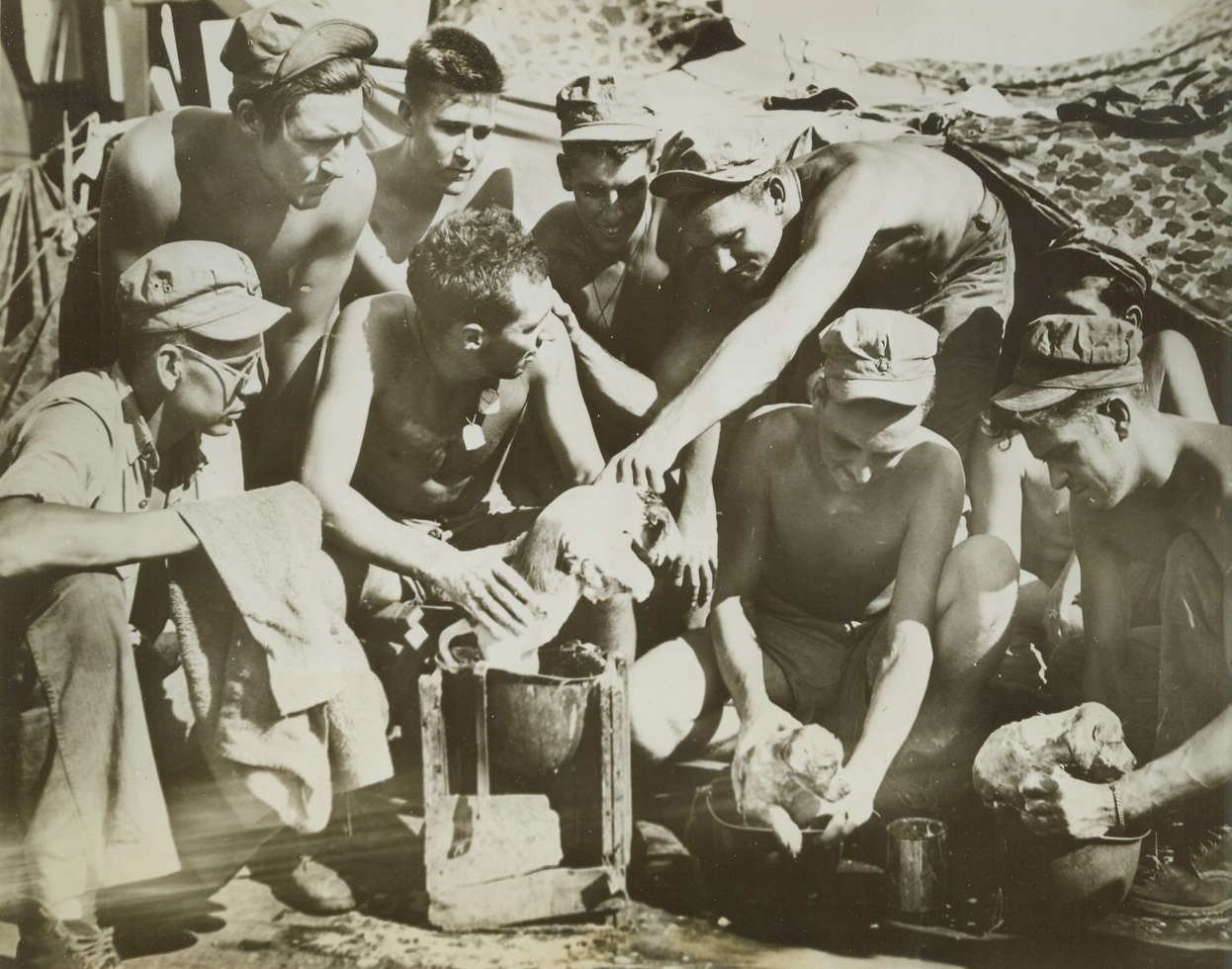
Those Versatile Helmets!, 7/27/1944. At Sea – Here is a new use for those handy GI “toppers” – a scrub tub for pups! U.S. Marines, headed for a landing on Guam, primp their pets for the occasion, receiving advice – and some help – from their buddies.Credit: U.S. Marine Corps photo from ACME;
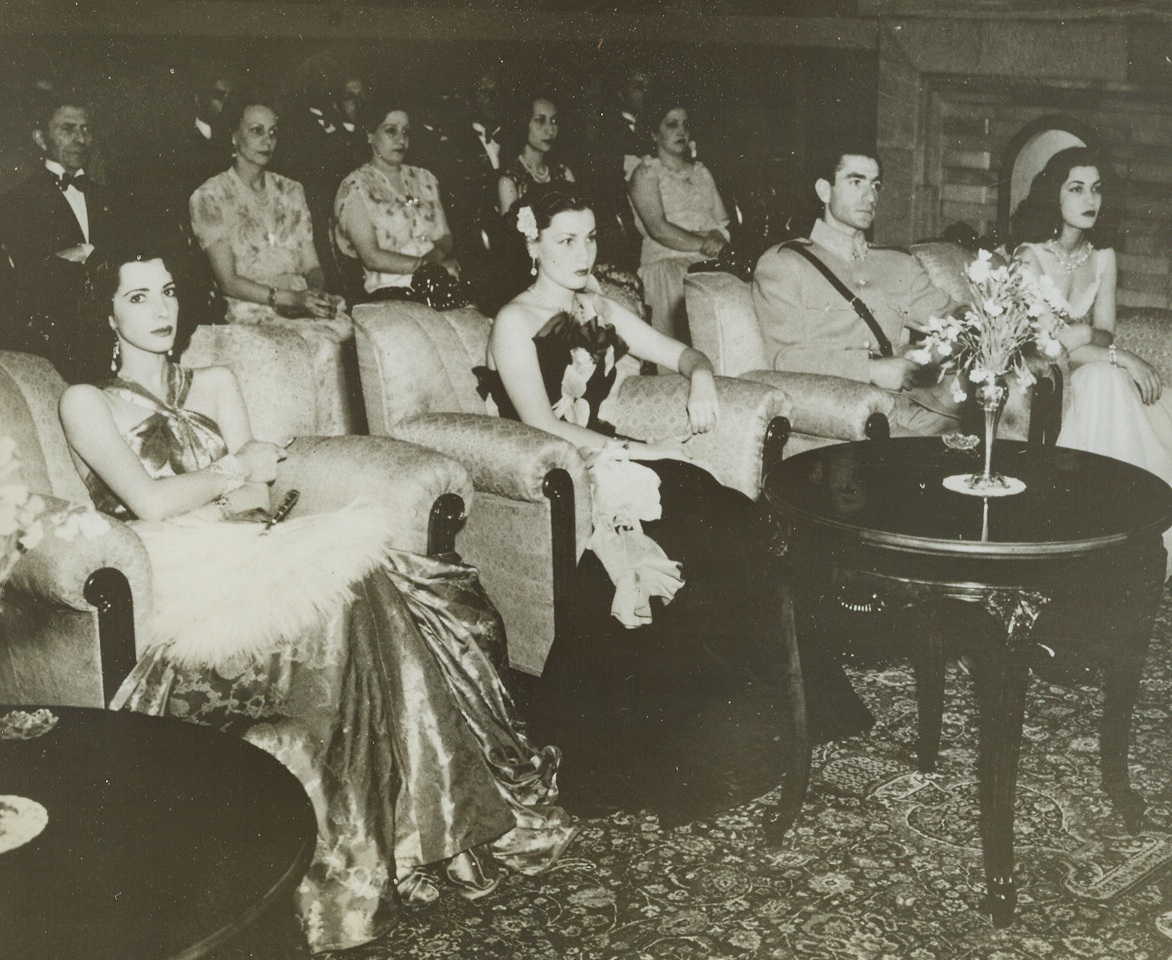
U.S. Stars Give Concert for Royalty, 7/27/1944. Iran – While in the Persian Gulf Command giving concerts for the troops, Andre Kostelanetz, Lily Pons, and other American artists also gave a performance for Iranian Royalty. Here, listening to the performance, are (in first row): Princess Ashraf Pahlevi, sister of the Shah; Her Imperial Majesty, the Empress of Iran; His Imperial Majesty, Mohamed Reza Pahlevi, Shahinshah of Iran; and Princess Shams Pahlevi, another sister of the Shah, recently married to a doctor or Egyptian Nobility. (Passed by Censors)Credit: ACME;
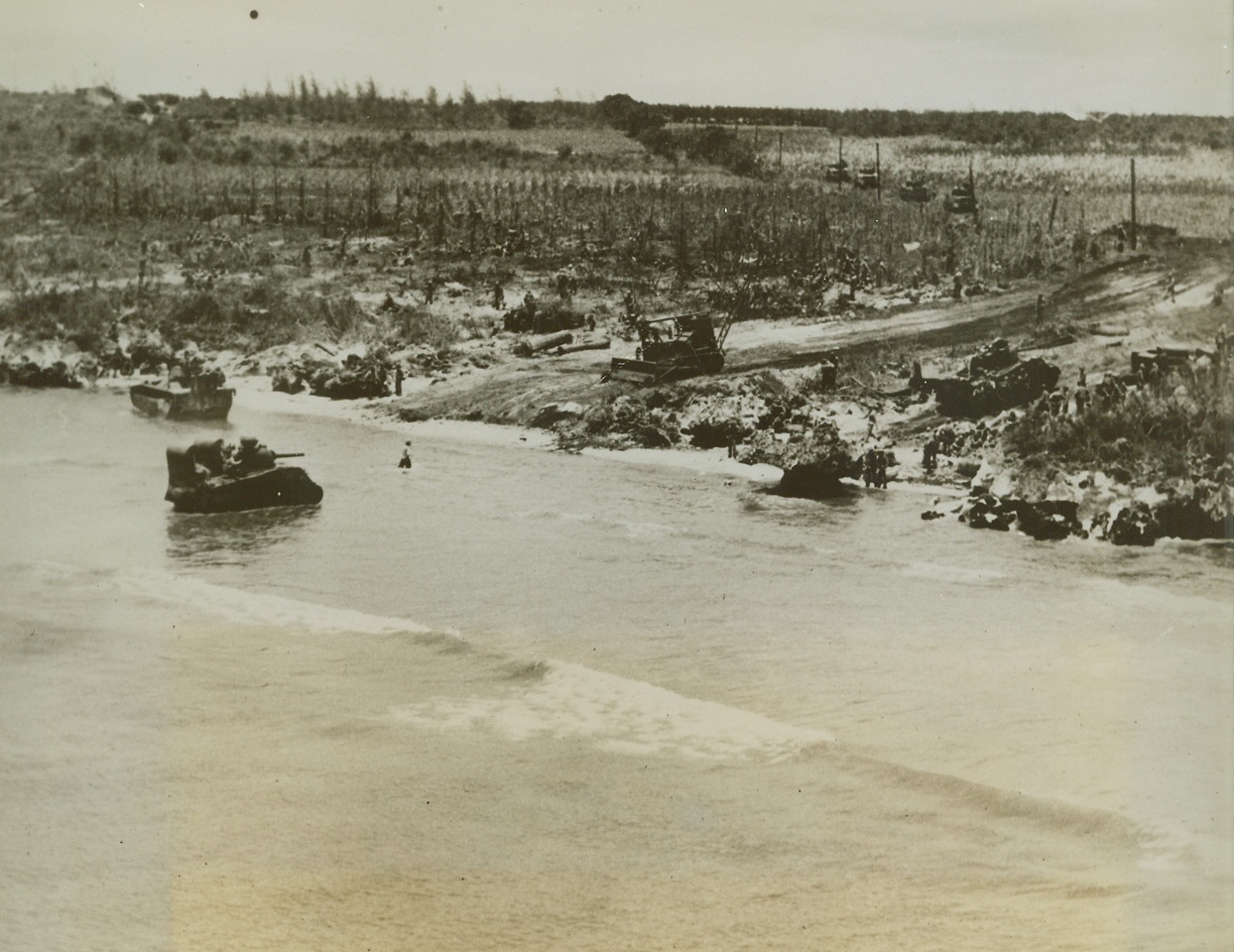
Marines Push Forward on Tinian, 7/28/1944. , Marianas Is. – With monotonous regularity – for the Japanese on the Marianas Islands – the Marines land again. This time it is Tinian, less than three miles from Saipan, and the third in the group to be invaded in less than six weeks. Tanks roar ashore from landing craft, drive up beach road gouged out by a bulldozer toward island’s vital airfields.Credit line Marine Corps Photo from ACME;
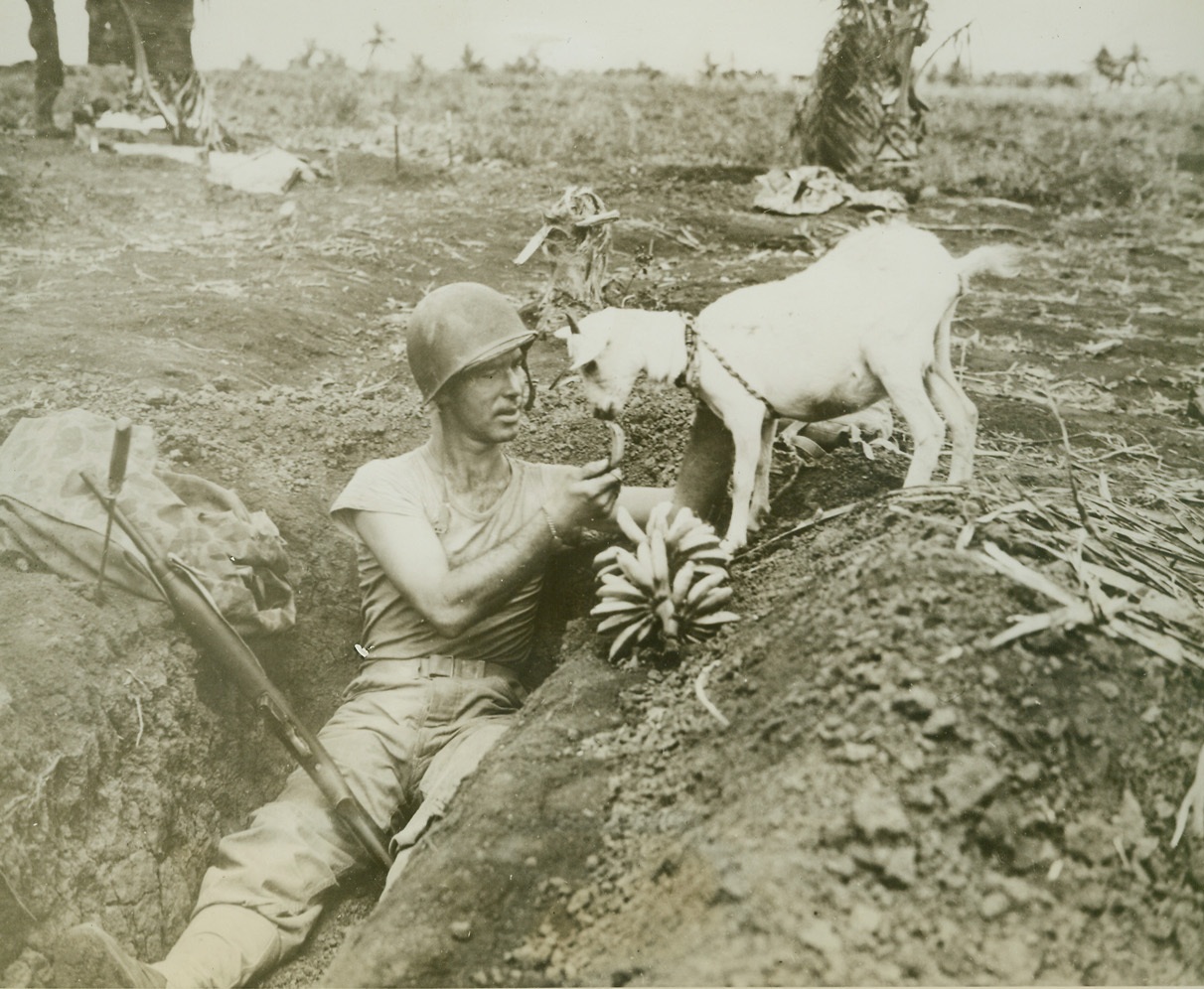
Gee Whiz! Bananas!, 7/3/1944. Saipan, Mariana Is. - - The way this goat is nibbling indifferently at the bananas being fed him by Marine 1st/Sgt. Neil I. Shober, Ft. Wayne, Ind., just goes to show that the animal doesn’t appreciate the finer things in life. Sgt. Shober, a veteran of Guadalcanal and Tabawa, participated in the Marine invasion of Jap-held Saipan.Credit Line (Official Marine Corps photo from ACME);
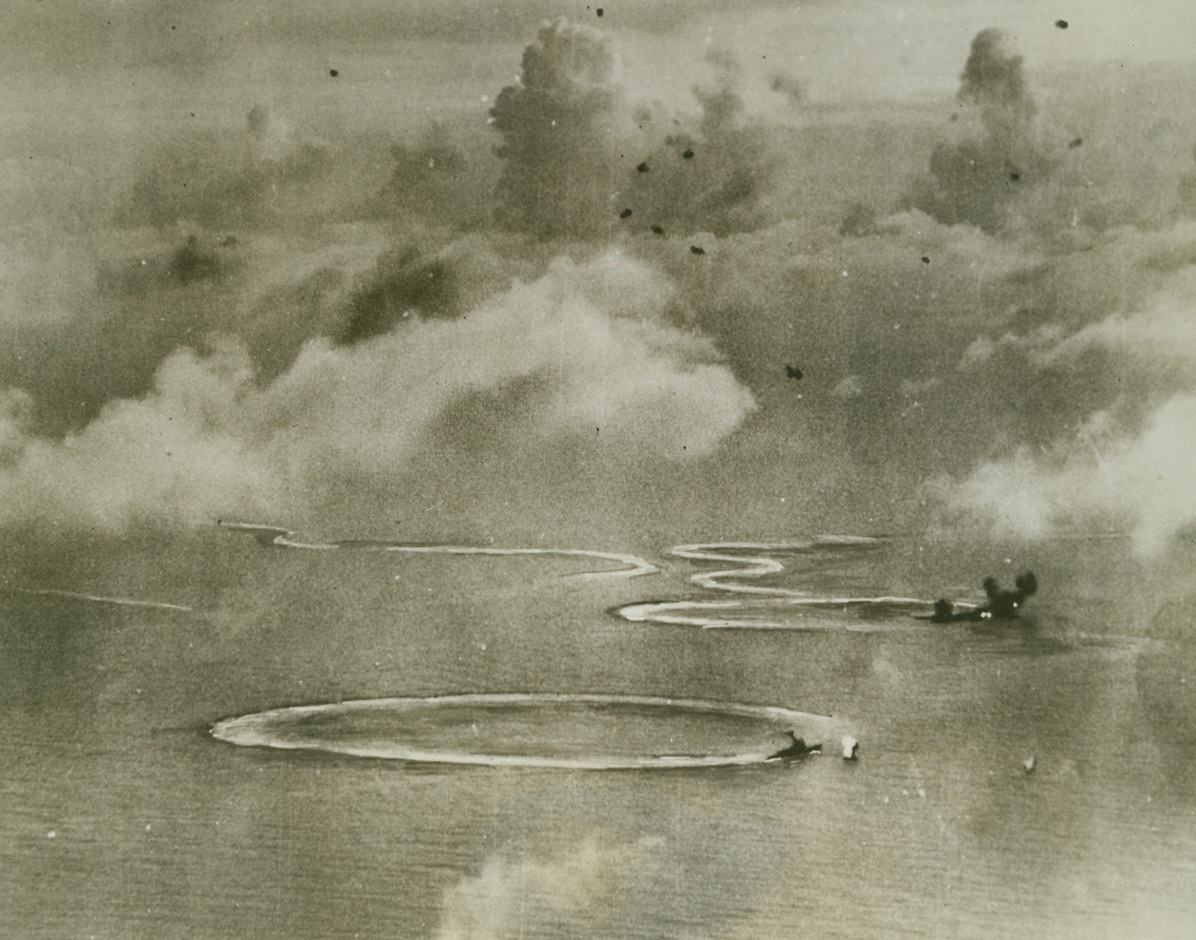
First photo – U.S. – Jap Sea Battle, 7/3/1944. Philippine, Sea – Swinging in tight circles in a desperate attempt to ward off attacks of U.S. Pacific fleet carrier-based aircraft, a Jap heavy cruiser turns counter-clockwise while throwing up a screen of flak. Directly behind are flares of two bomb hits exploding on battleship of the Kongo class and a carrier narrowly avoiding collision. Action occurred between the Marianas and the Philippines on June 20.Credit (US Navy photo from ACME);
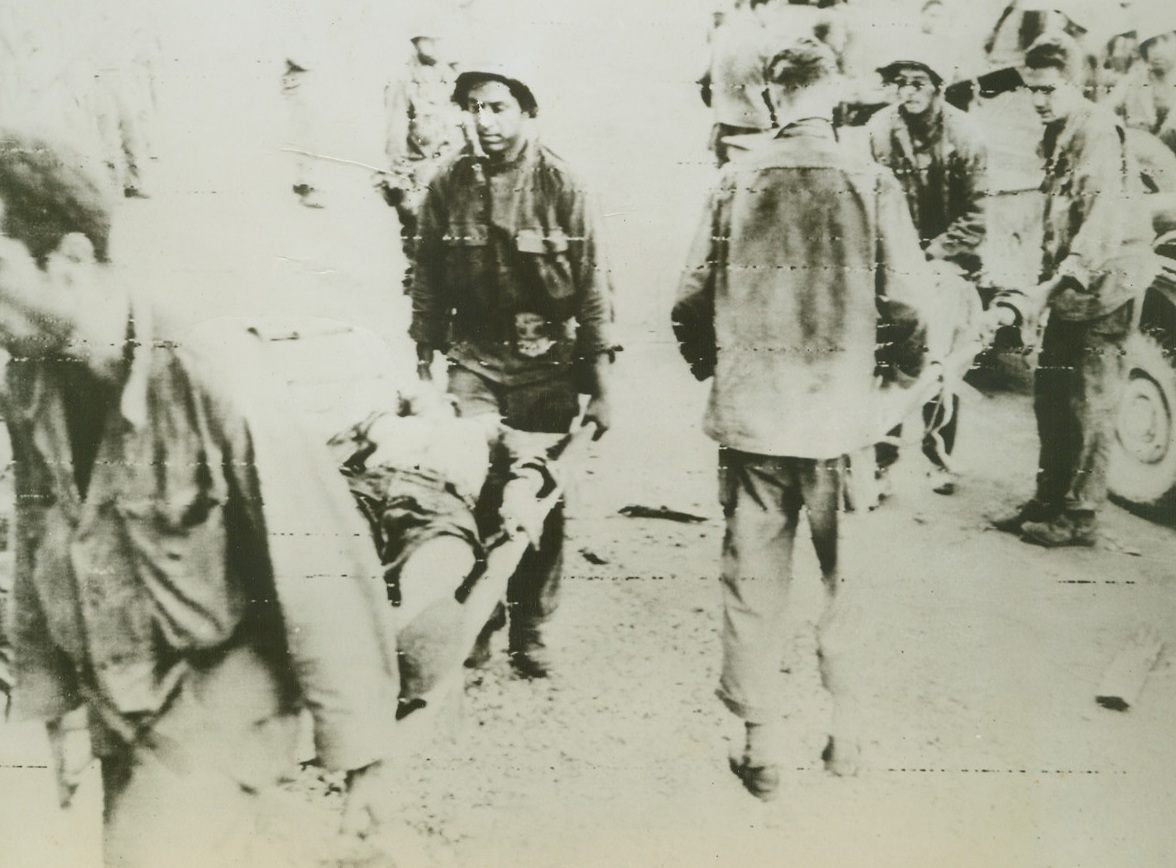
Yank Wounded on Saipan, 7/1/1944. Saipan- - Wounded Americans are brought to a captured Jap shack on Saipan which has been converted to an aid station. Comrades gently carry the stricken soldiers on stretchers. In taking half the Jap stronghold in the Marianas, American Marines and infantrymen have suffered 9,752 killed, wounded, and missing in action.Credit (US Army radio telephoto from ACME);
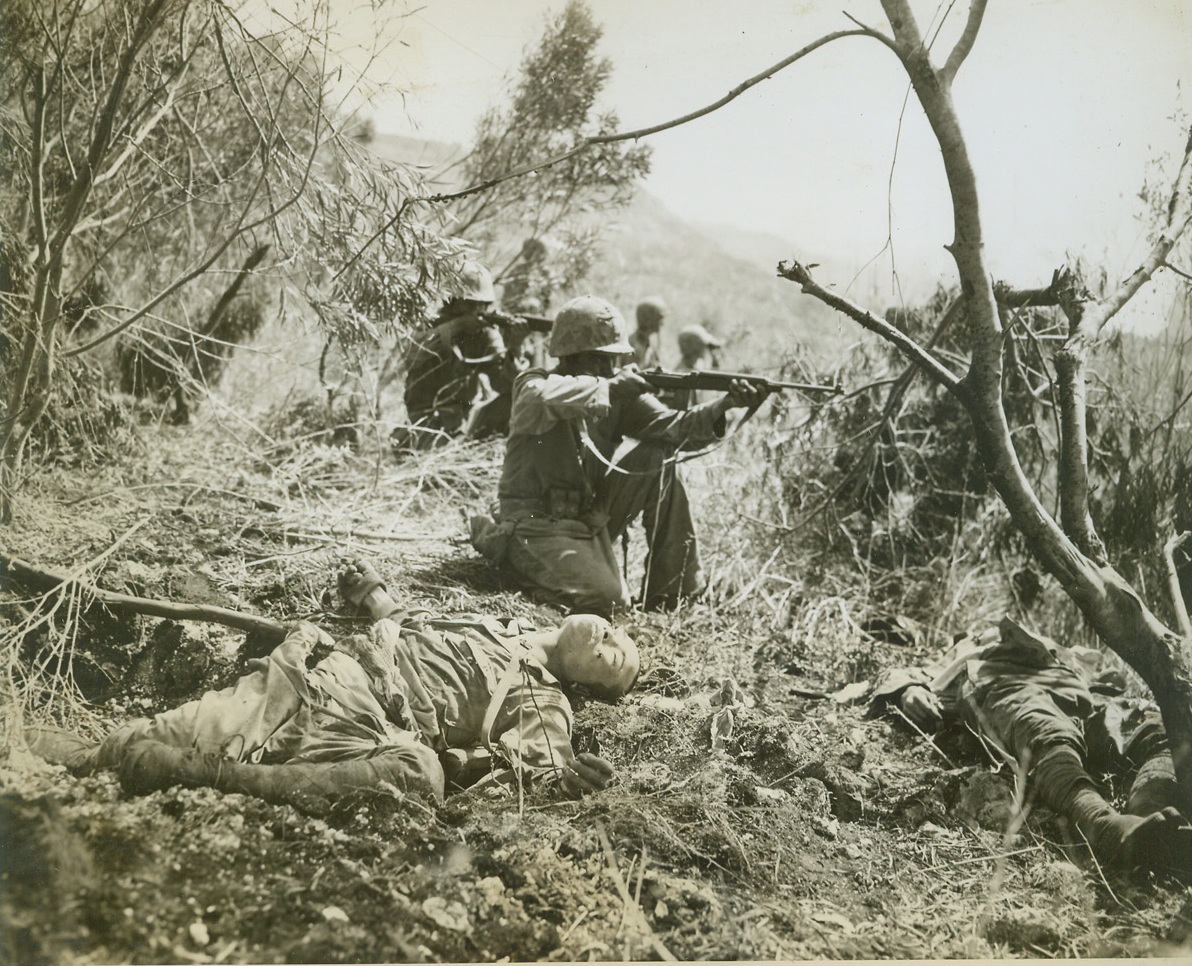
The Quick Heed not the Dead, 7/21/1944. Saipan - - Unmindful of the bodies of enemy soldiers lying close to them, Marine fighters kneel and take aim as they push ahead through Saipan. Members of the Second Marine Division, the warriors are making their way toward the Western beach below Mt. Marpi.;
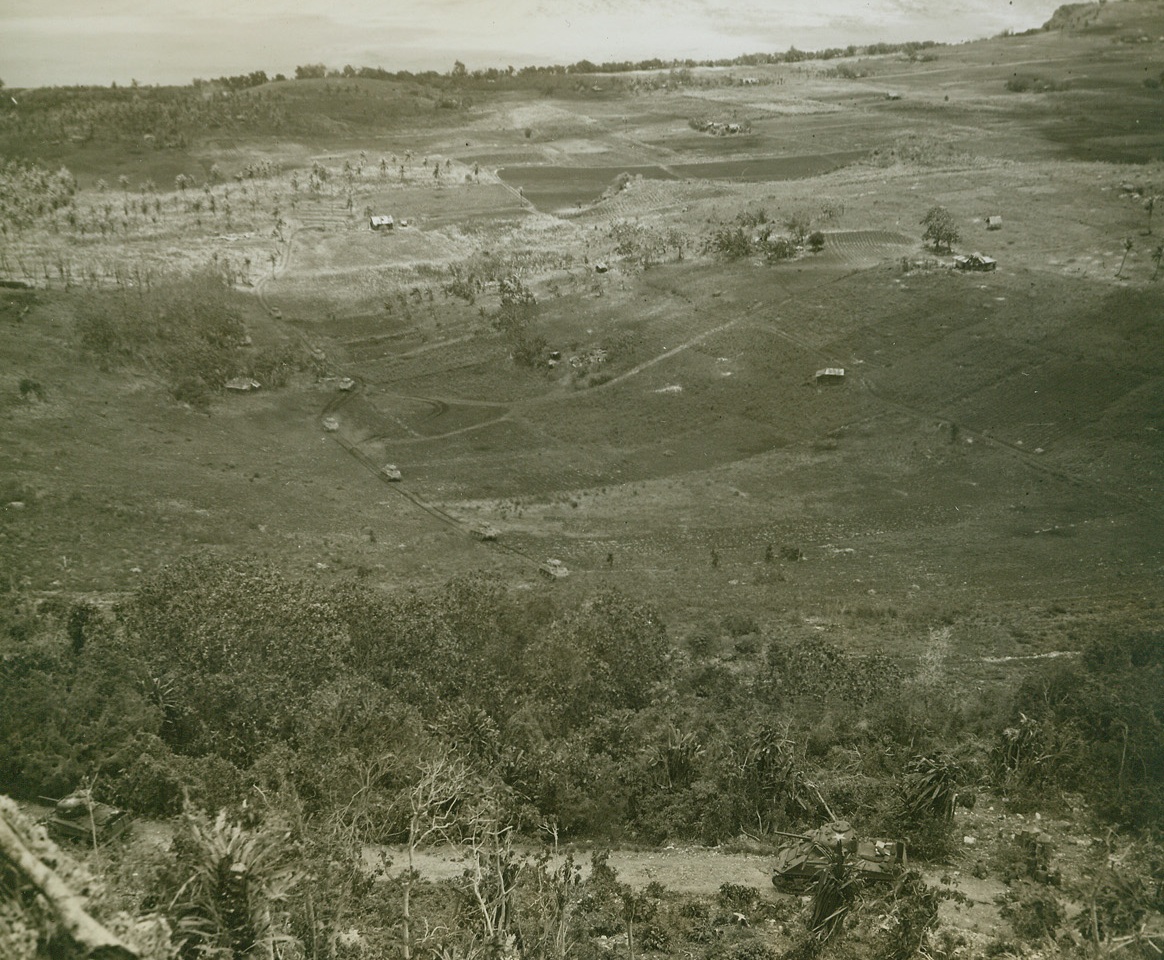
Saipan Panorama, 7/21/1944. Saipan - Second Division Marine tanks move up a hill above Tanapag Harbor in this panoramic view of fighting on Saipan. The tanks were used to knock out enemy machine gun nests threatening our front line troops.;
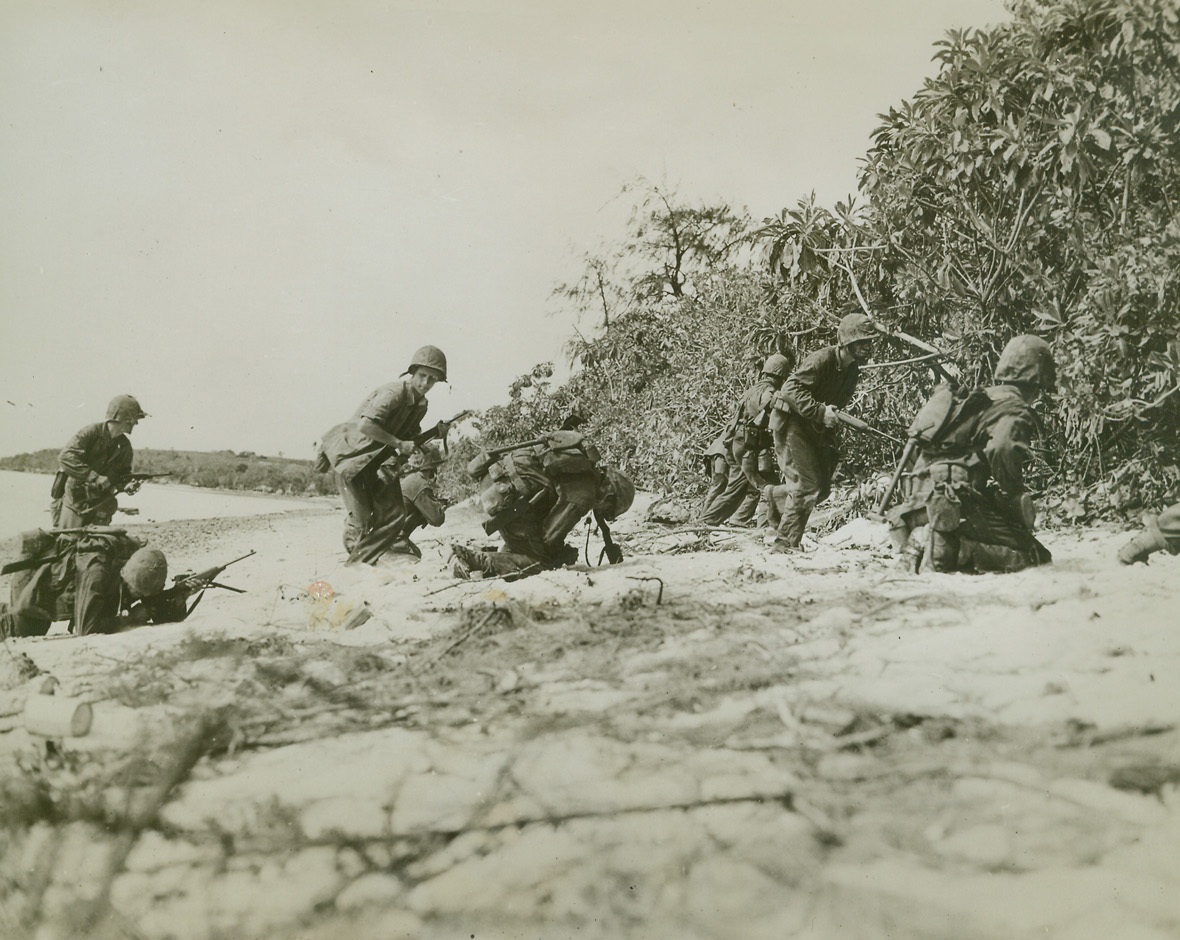
Sniper’s Bullet Fells a Marine, 7/21/1944. Saipan – Fighting Marines hit the ground as Japanese snipers open up on this small patrol on Saipan. One Marine in foreground doubles up and pitches forward as a bullet hits him.Credit Line (U.S. Marine Corps photo from ACME);
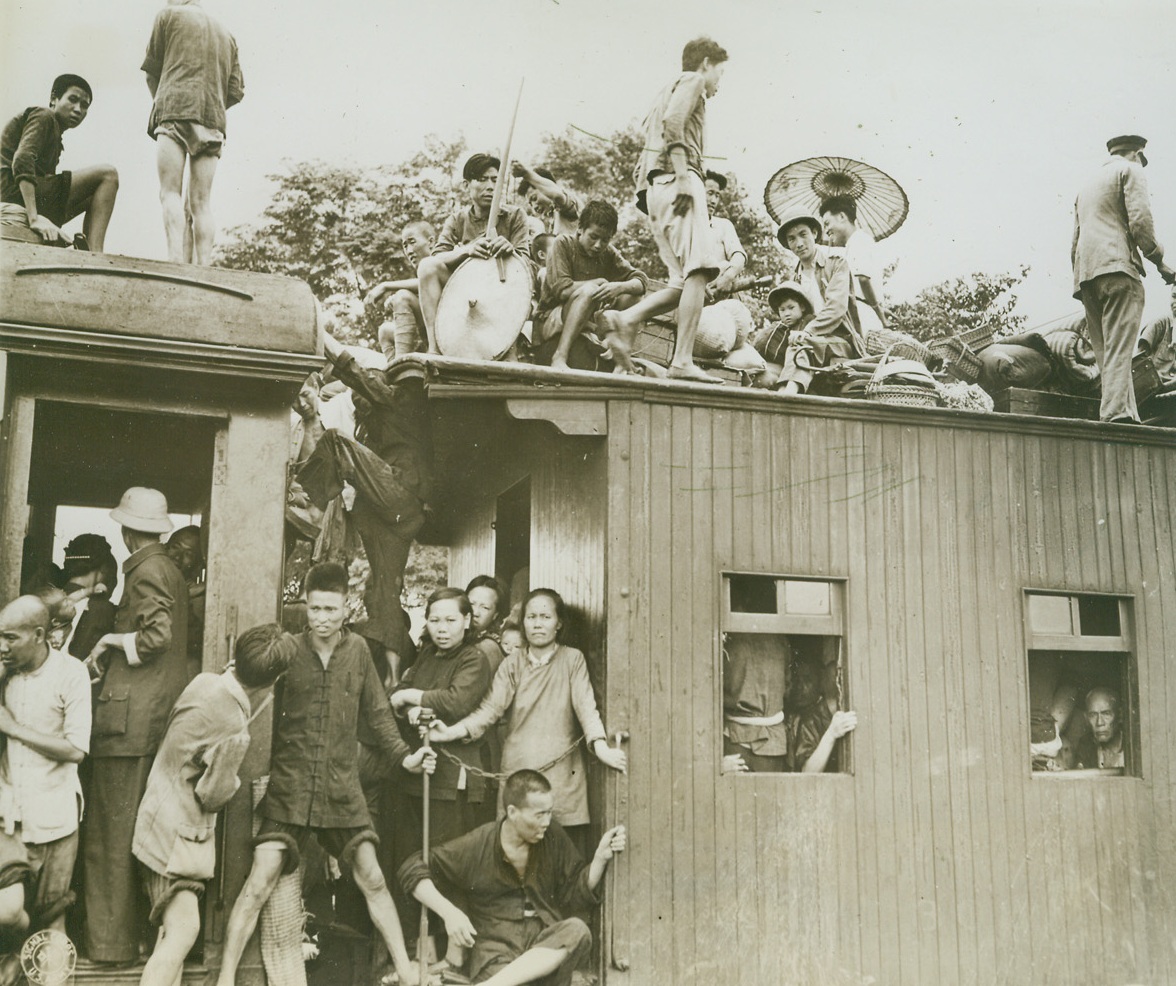
No Pullman Accommodations Here!, 7/20/1944. Chinese evacuees occupy every available inch of space on this train as it leaves South station in Kweilin, China, when Jap forces threatened the city last June. Some of the passengers are perched in dangerous spots between cars, others have belongings piled on the roof. Note one Chinese with parasol. This photo was released in Washington Today.Credit Line (U.S. Army photo from ACME);
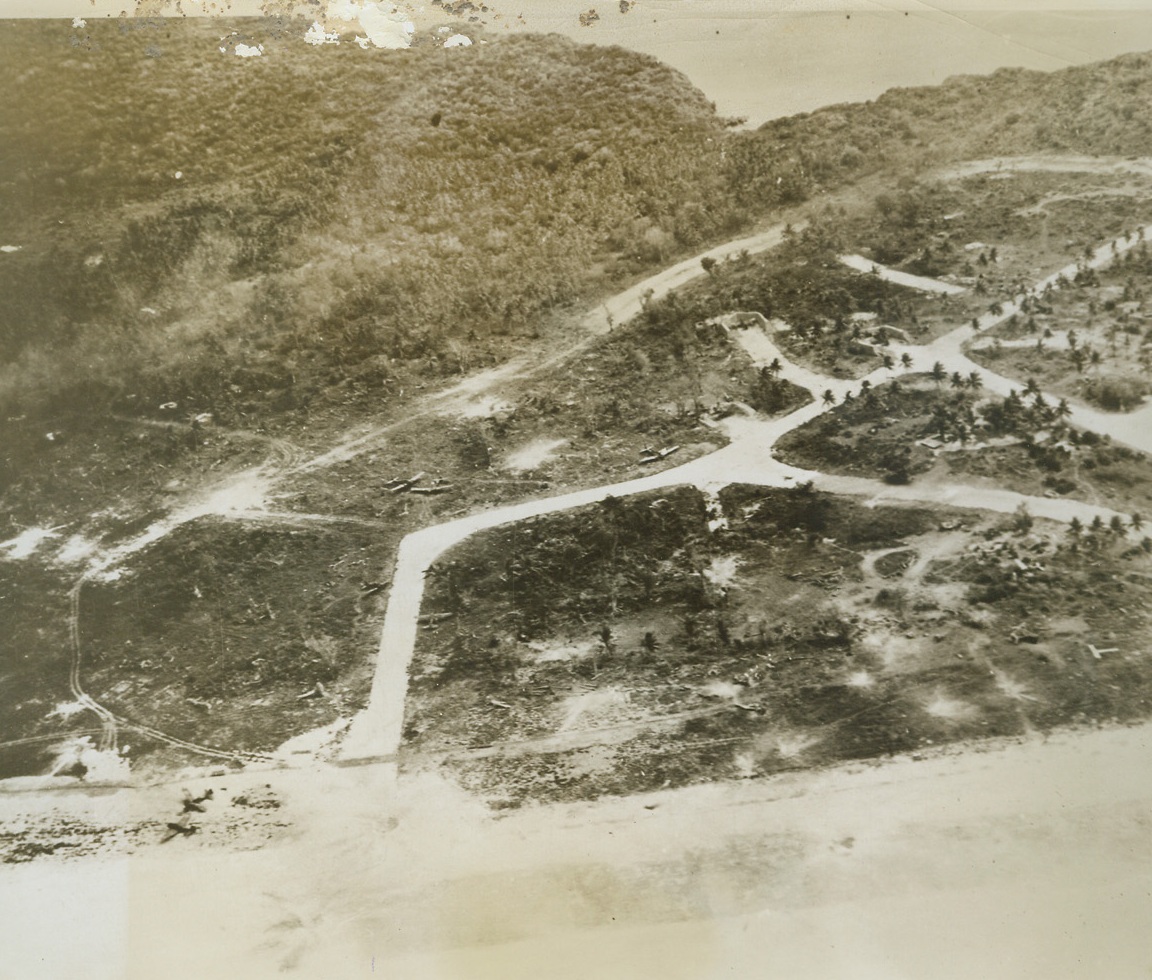
Guam Airfield Blasted, 7/26/1944. Guam – A Japanese airfield dispersal area on Guam received accurate bombing from carrier-based aircraft June 19th as is shown here by the wrecked Nipponese planes strewn on the beach, in revetments, and in open dispersal areas. This is one of the airfields currently being assaulted by the combined American forces, and may now be in the hands of the invading Yanks. Credit Line (U.S. Navy photo from ACME);
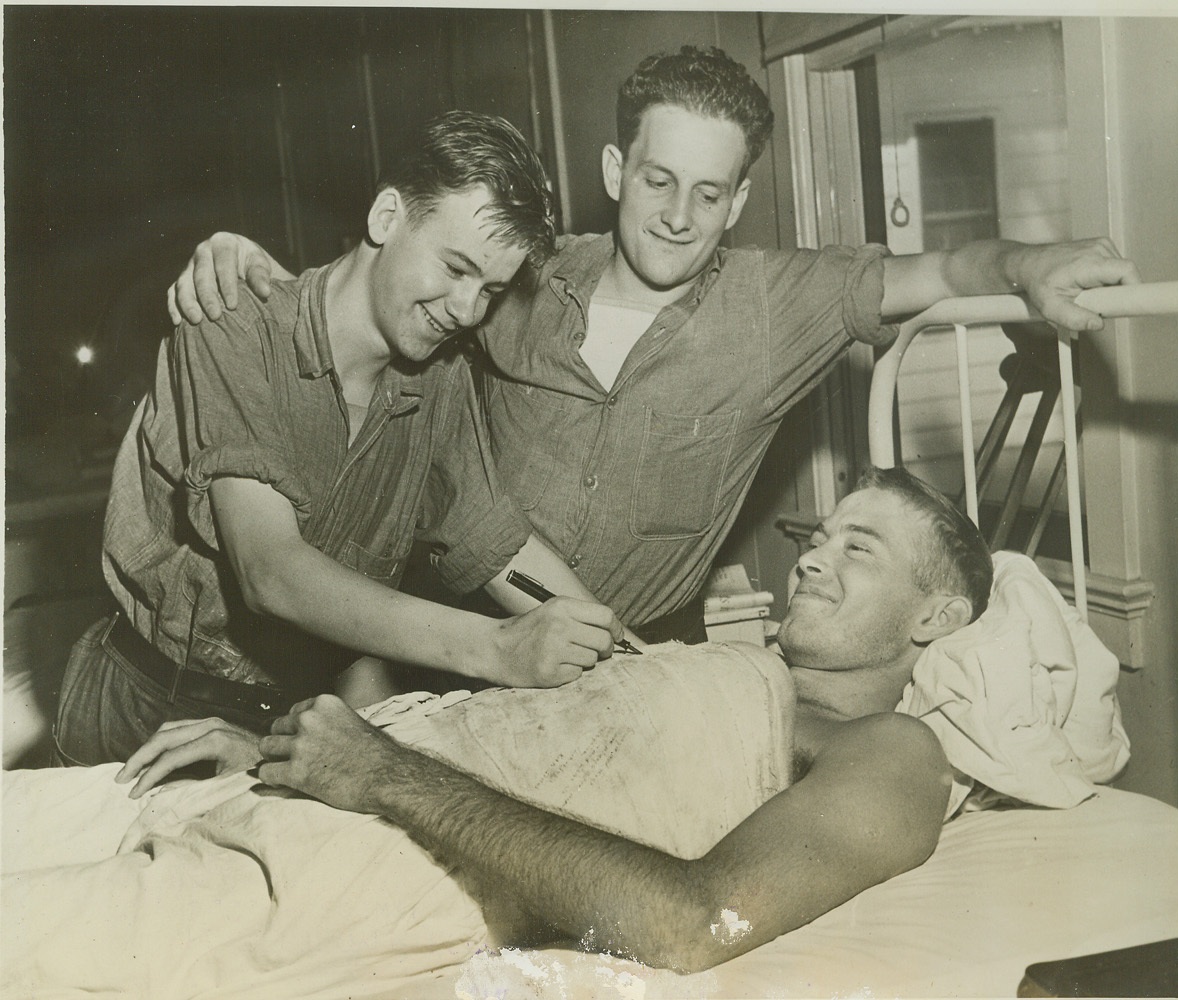
Survived Destroyer Escort Sinking, 7/15/1944. Charleston, S.C. -- Recently returned to the States aboard a hospital ship and now under-going treatment a the Naval Hospital in the Charleston Navy Yard for injured backs, these three sailors were among survivors of the sinking of the U.S. Destroyer Escort Fechteler in the Mediterranean during the month of May. Seaman 2/c Edward Laurence Andruss, Malden, Mass., adds his autograph to the many decorating the cast on Seaman 2/c ...vin Garvin Pritchett, Dallas, Tex., while Water Tender 2/c ...k John Galanic, ...ain, O., looks on. Credit (US Navy Photo from ACME);
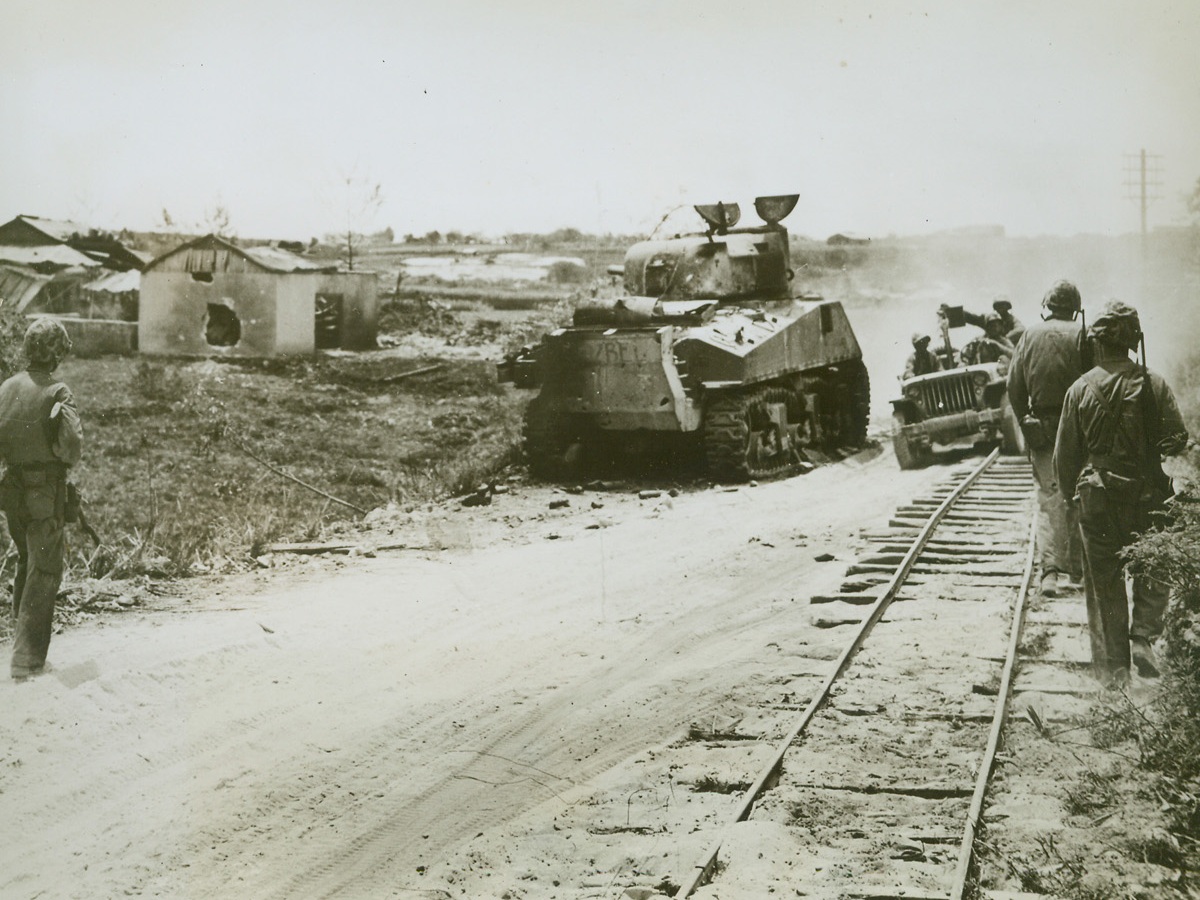
Stilled Scene of Battle, 7/1/1944. Saipan – Marines on foot and in a jeep, bypass the charred remains of an American tank along a road on Saipan. The Leatherneck tankmen fought a battle with Japs hidden in the concrete building at which the turret gun is pointing. A gaping hole in the side wall is evidence of a direct hit by one of the shells from the tank. Credit (Marine Corps photo from ACME);
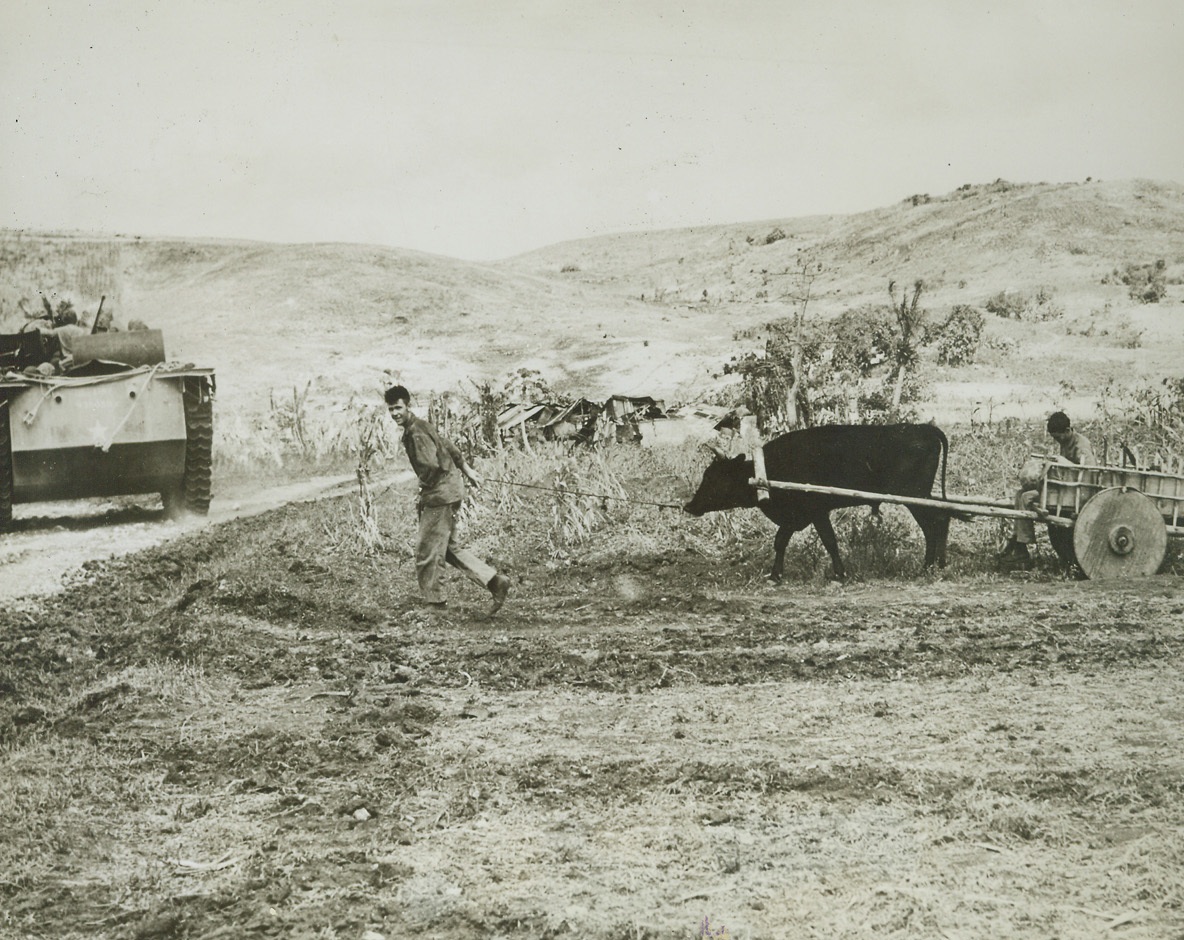
The Old and the New, 7/1/1944. Saipan—In marked contrast to scenes of death and destruction marking the bitter fighting on Saipan in which 9,752 American soldiers were killed, wounded or listed as missing in action, is this peaceful scene showing two modes of transportation over a thousand years apart. Marines in amphibious tractor at left are hauling supplies to front lines while two Leathernecks commandeer a Jap ox cart to move some of their equipment forward.Credit (Marine Corps photo from ACME);
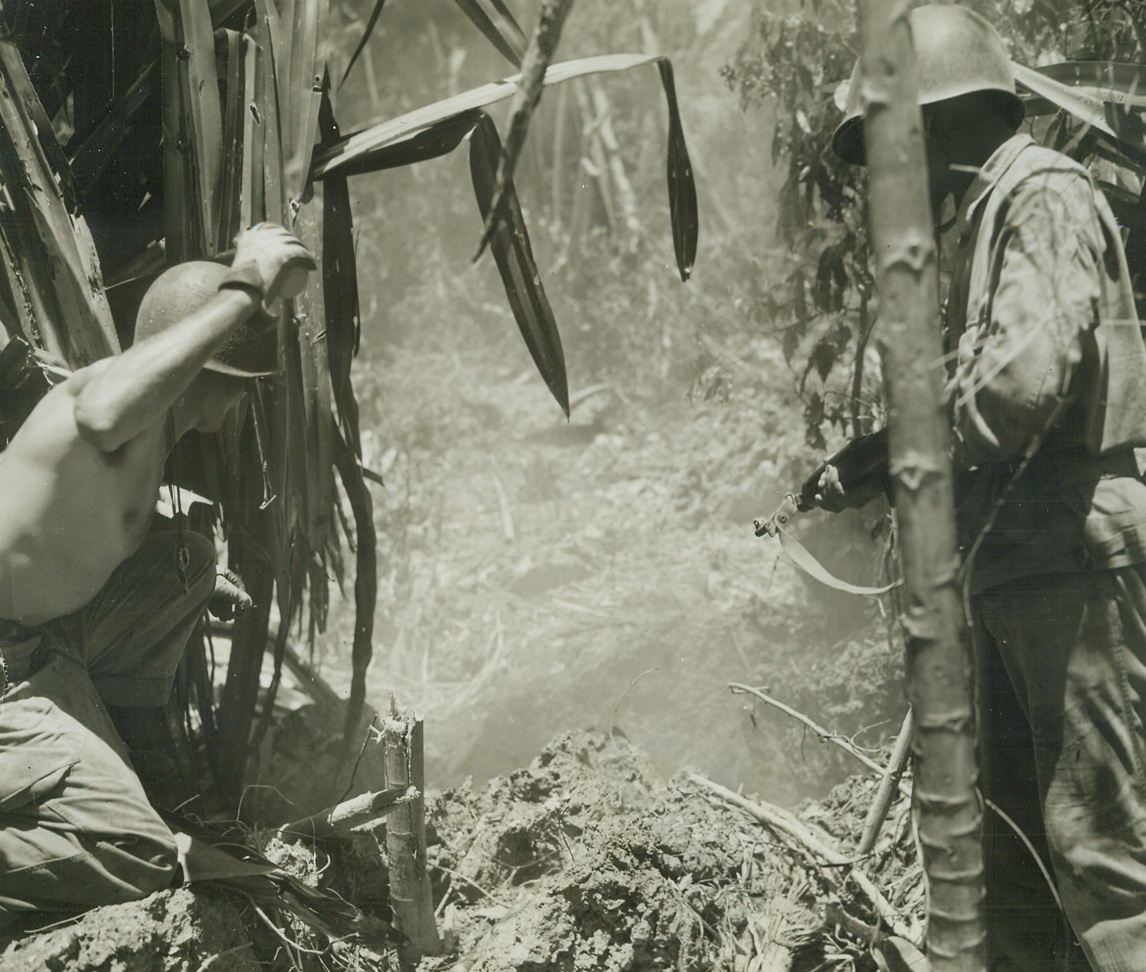
Blasting Out Dug-In Japs, 7/12/1944. Saipan – Meeting increased resistance from Japs on the Northern tip of Saipan, American soldiers are shooting, bombing and smoking the enemy from caves and deep fox holes, such as this one. The Yank at left is tossing another smoke bomb into the hole to force it’s reluctant occupants out in the open as the rifleman at right prepares to finish them off if they come out fighting.Credit Line – WP – (ACME photo by Stanley Troutman, War Pool Correspondent);
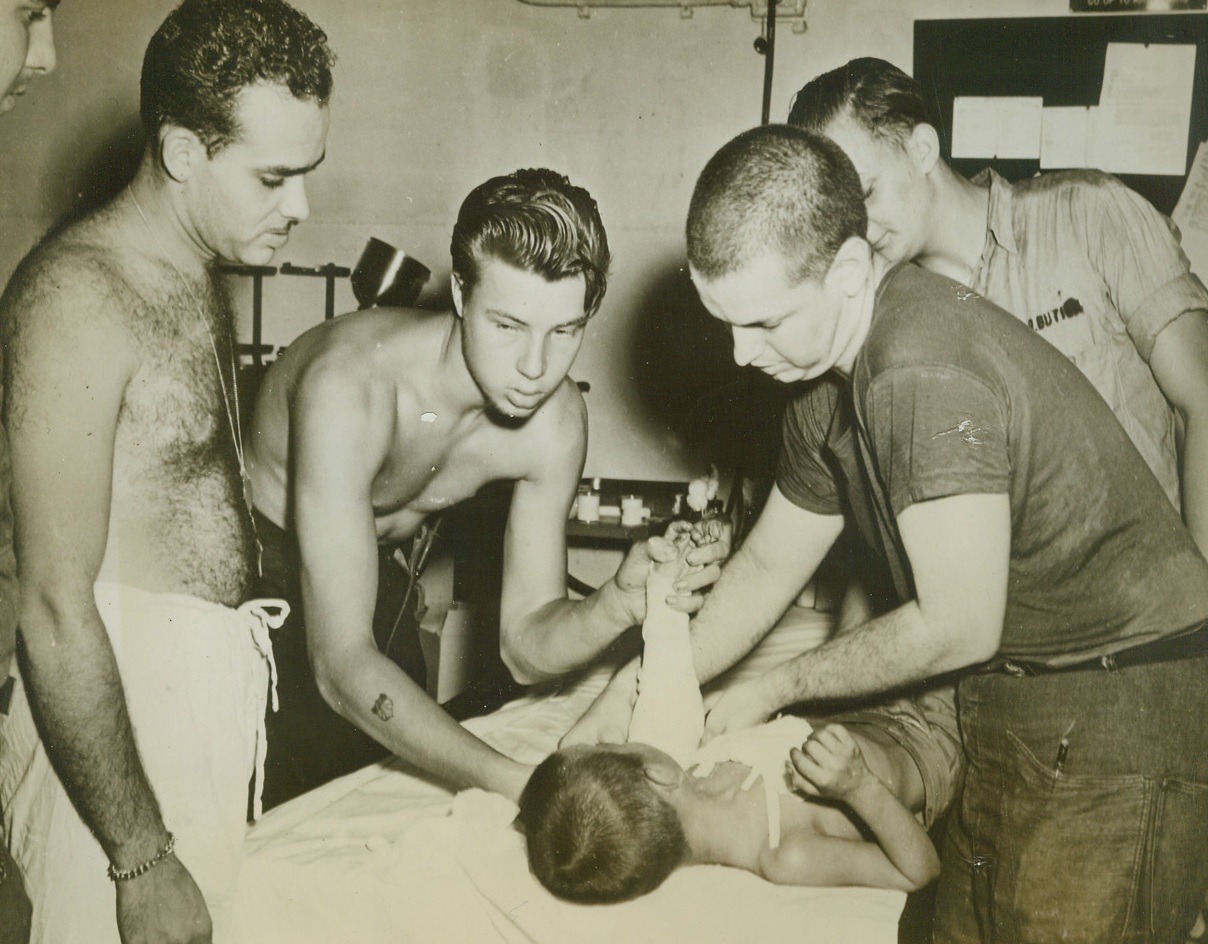
GENTLE HANDS TO HELP HIM, 7/9/1944. SAIPAN—Tenderly, Coast Guardsmen dress the wounds of a young Japanese boy, an innocent bystander who suffered serious wounds in the battle for Saipan. Forgetting the child’s nationality, the fighting men provide medical attention in the American way, aboard a Coast Guard manned transport. Left to right: Jack Schwartz, PhM 3/c, Atlantic City, N.J.; Arnold Allen, S l/c, Portland, Oregon; and Charles Schlicter, PhM 1/c, Harrisburg, Pa. Credit: U.S. COAST GUARD PHOTO FROM ACME.;
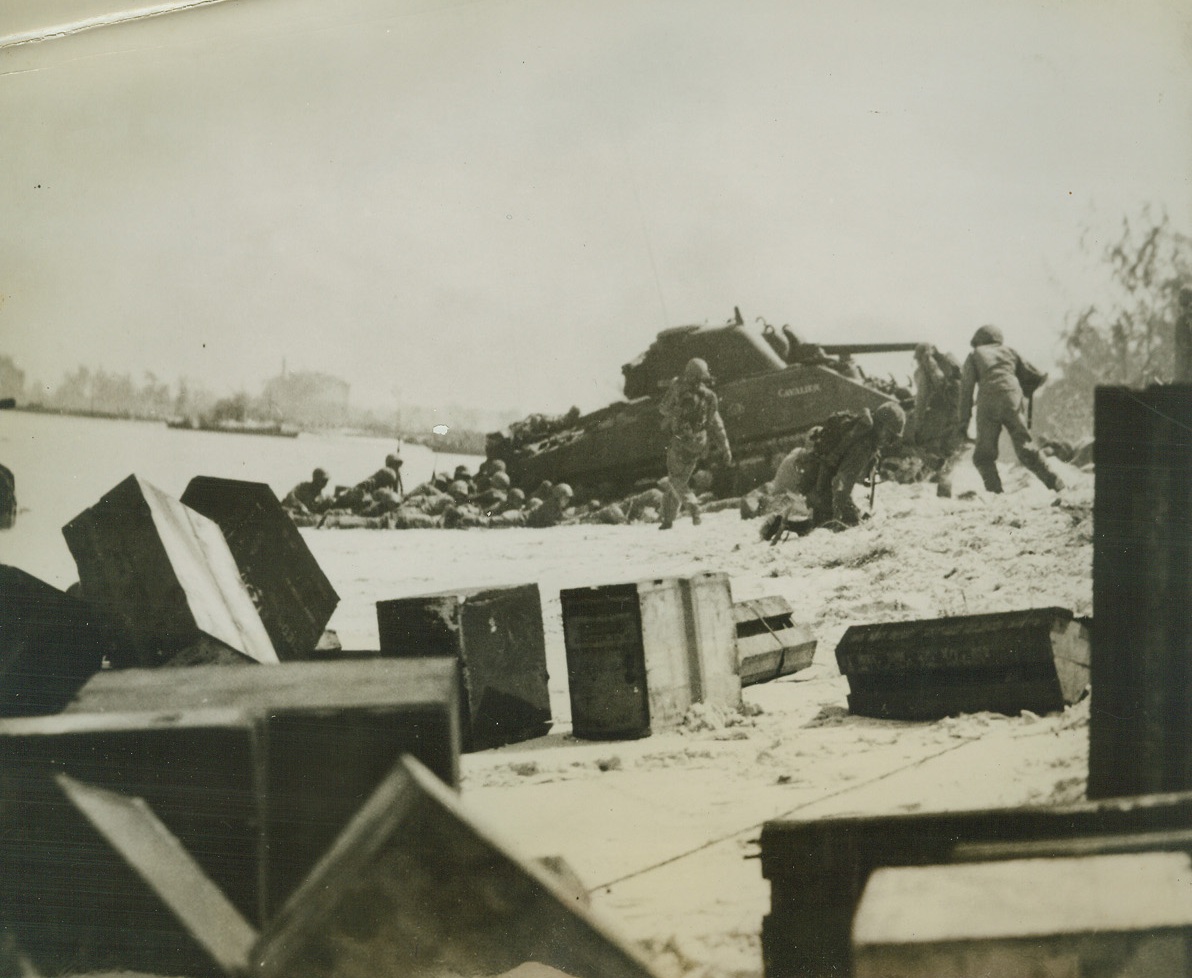
DUCK FOR COVER, 7/10/1944. SAIPAN—Members of a Marine assault wave duck behind a tank for cover as the Japs spray the beachhead at Saipan with machine gun fire. The Leatherneck on his knees in center of photo appears to have been hit while scrambling for shelter. Credit: MARINE CORPS PHOTO FROM ACME.;
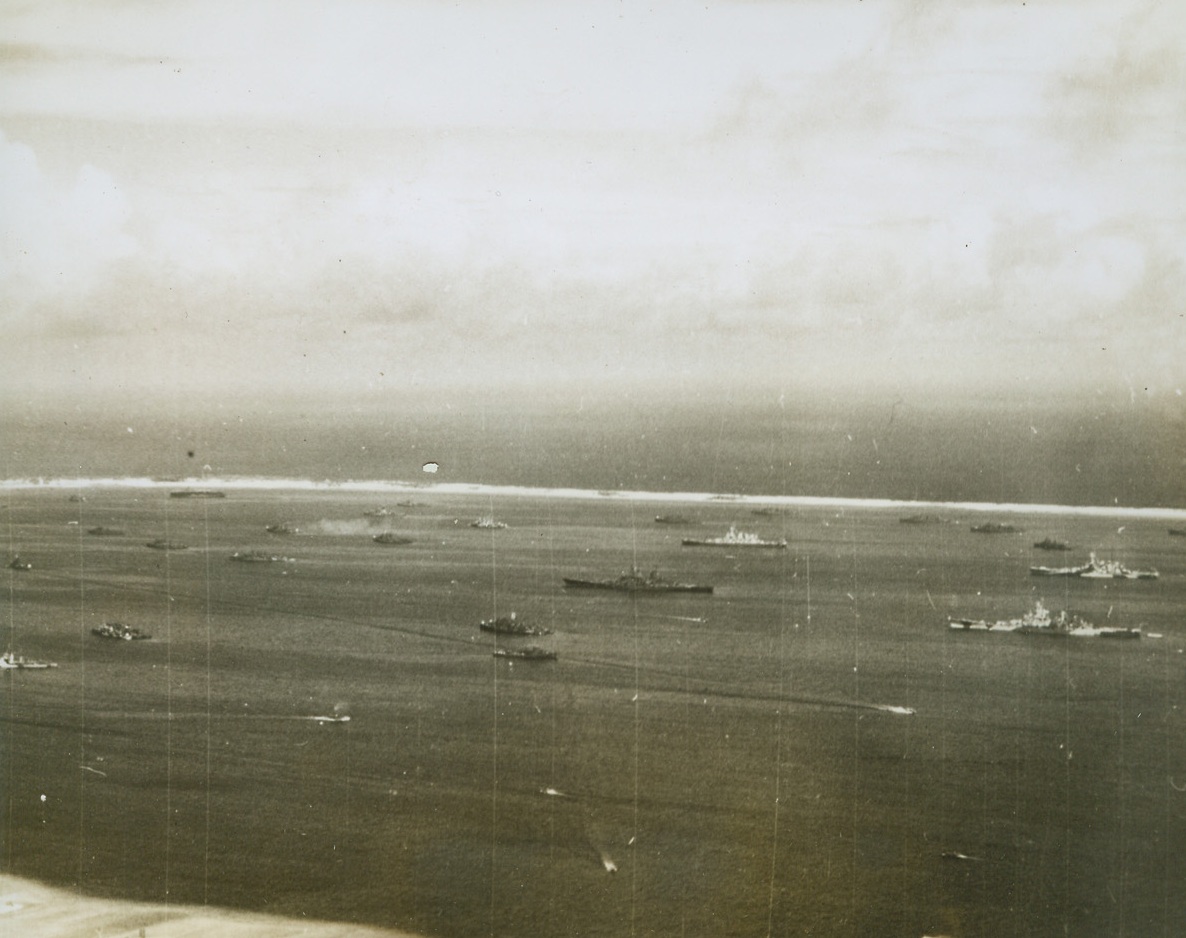
RECEIPE FOR JAP NIGHTMARE, 7/8/1944. PACIFIC—Packing the world’s most powerful punch a huge Navy Task Force lies at anchor in a Pacific harbor before going out on another assignment of Japanese destruction. Even as this caption is being written, the armada—battleships, cruisers, flat tops and destroyers—might be sailing in force to meet what is left of the Jap fleet somewhere in the Pacific. On its last mission this force, or one as powerful, came within 500 miles of the Nipponese capital. See ACME photo #W 729678 for another dramatic scene of the ships that are giving the Japs their biggest nightmare. Credit: U.S. NAVY PHOTO FROM ACME.;
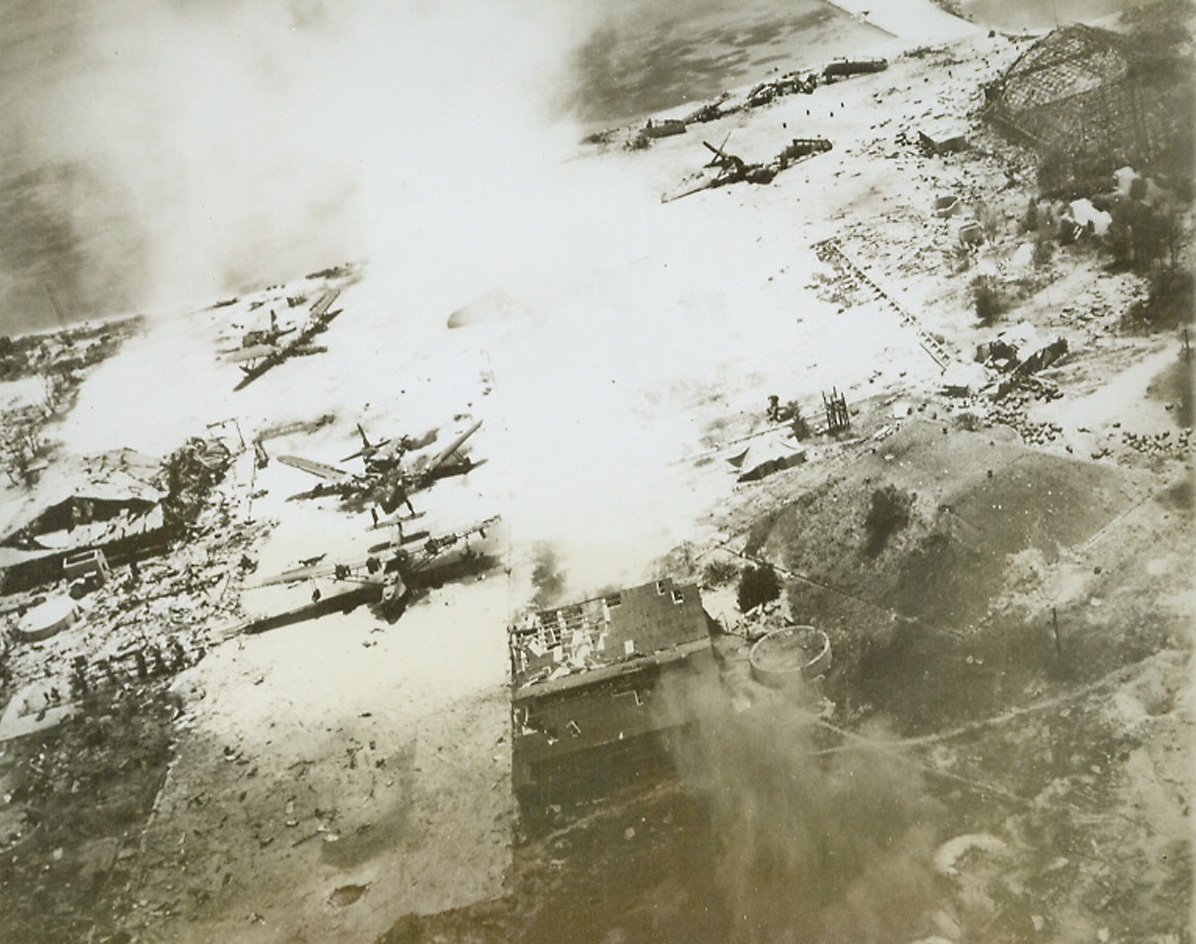
NIP SEAPLANTS ON THE FRISK, 7/8/1944. SAIPAN—The apron of this Jap seaplane base in upper Tanapog Harbor is littered with smashed planes caught by our carrier-based planes and naval bombardment during the invasion of Saipan. Hangars and repair huts have been wrecked. Although his airstrip is still in Jap hands-it is of small use to the enemy, for it has been almost totally wrecked. Credit: ACME.;
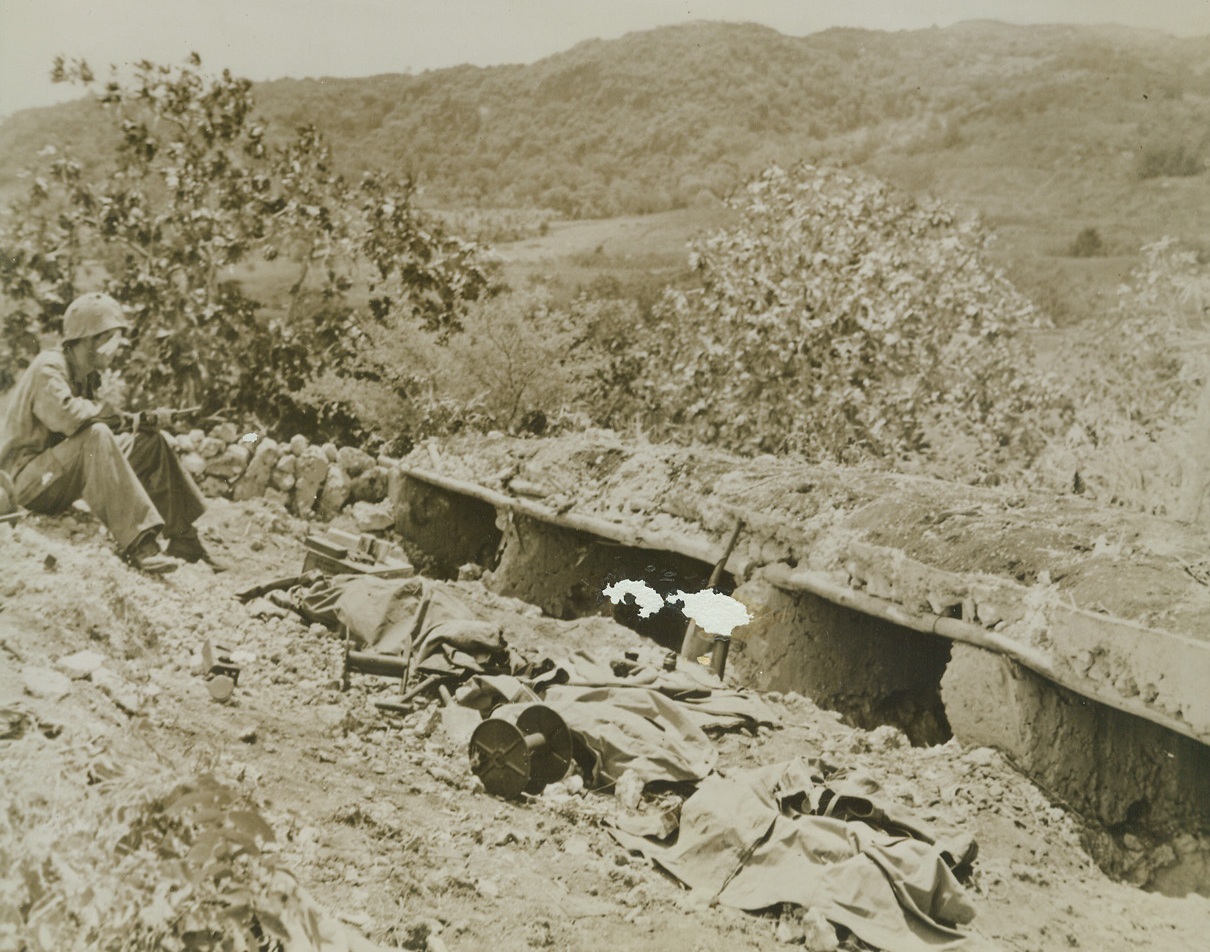
LONE VIGIL, 7/8/1944. SAIPAN, MARIANAS —A wounded marine keeps a lonely vigil over the poncho-covered forms of dead comrades as he awaits evacuation to a rear base on Saipan. Soldiers were killed and their guardian wounded while cleaning out the Jap pill boxes at right. Total dead on Saipan has exceeded by three times the number killed in the battle of Tarawa. Credit: MARINE CORPS PHOTO FROM ACME.;
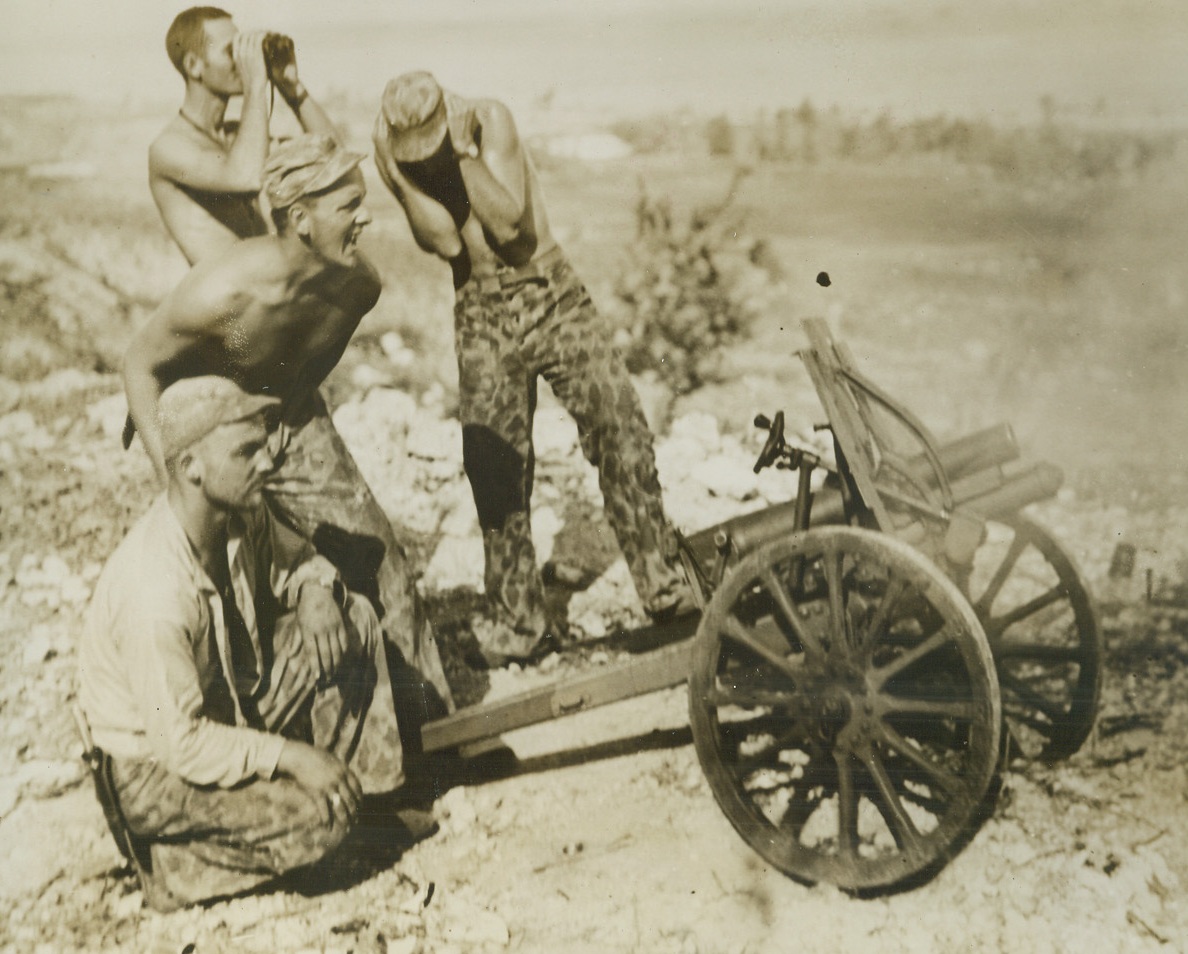
LET ‘ER RIP!, 7/7/1944. SAIPAIN, MARIANAS—The wallop packed by this Jap gun captured on Saipan is well evidenced here. Even the tough Leatherneck hides his face from the repercussion of its fire, as one of his buddies shouts “Let ‘er go,” as they turn the gun on its former owners during the fight for Garapan, key Jap city on Saipan. Credit: OFFICIAL U.S. MARINE CORPS PHOTO FROM ACME.;
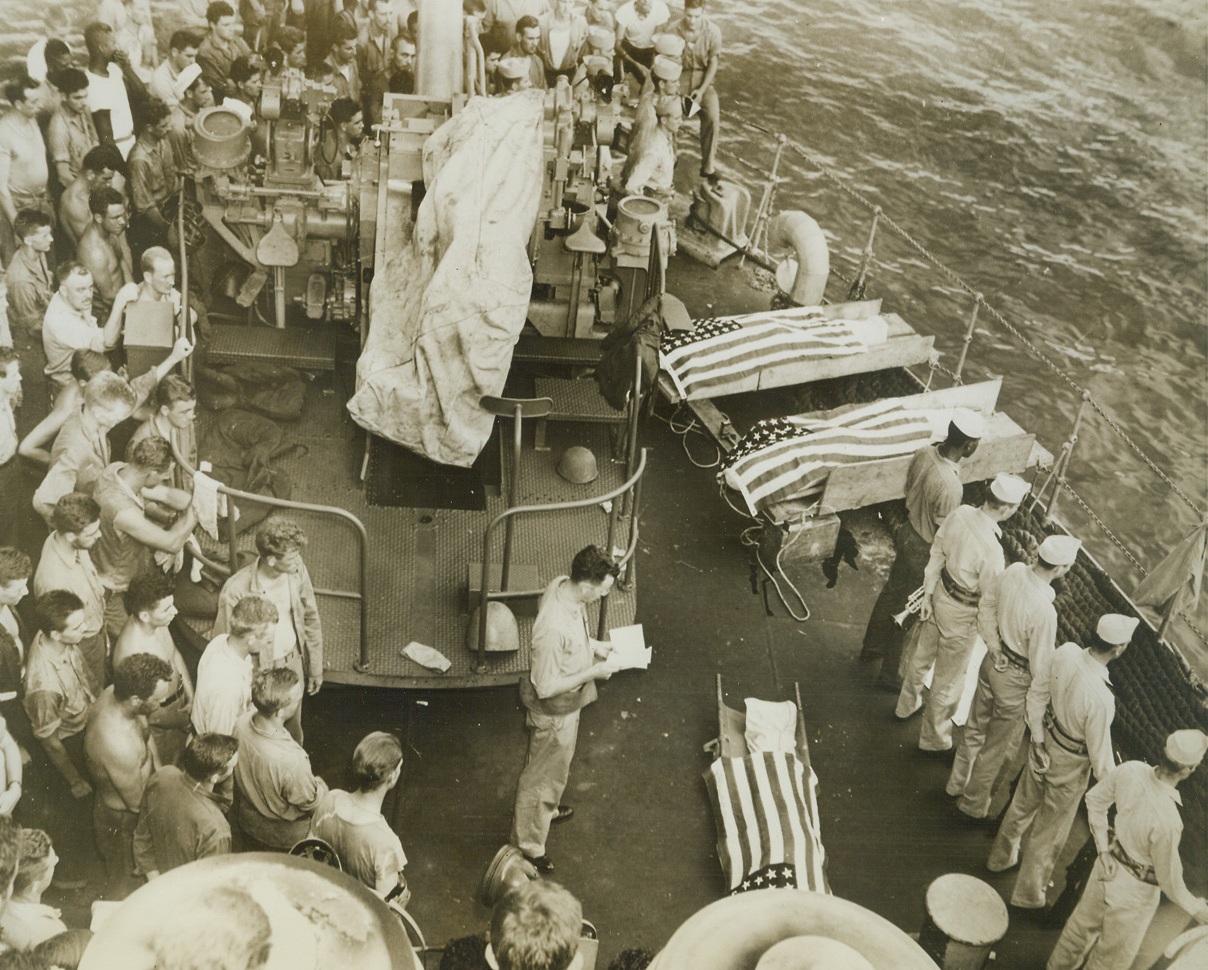
SEA GRAVE FOR AMERICAN HEROES, 7/7/1944. SAIPAN—While the noise of battle rumbles in the distant, three Americans who gave their lives in the early assault waves on Saipan are buried at sea from a Coast-Guard-manned transport. As the chaplain reads the simple service, Coast Guardsmen stand solemnly near the flag-draped bodies. When the honored dead were consigned to the sea, the guard of honor (lower right) fired a volley and taps was sounded. Scene took place off Saipan on the third day of the invasion. Credit: COAST GUARD PHOTO FROM ACME;
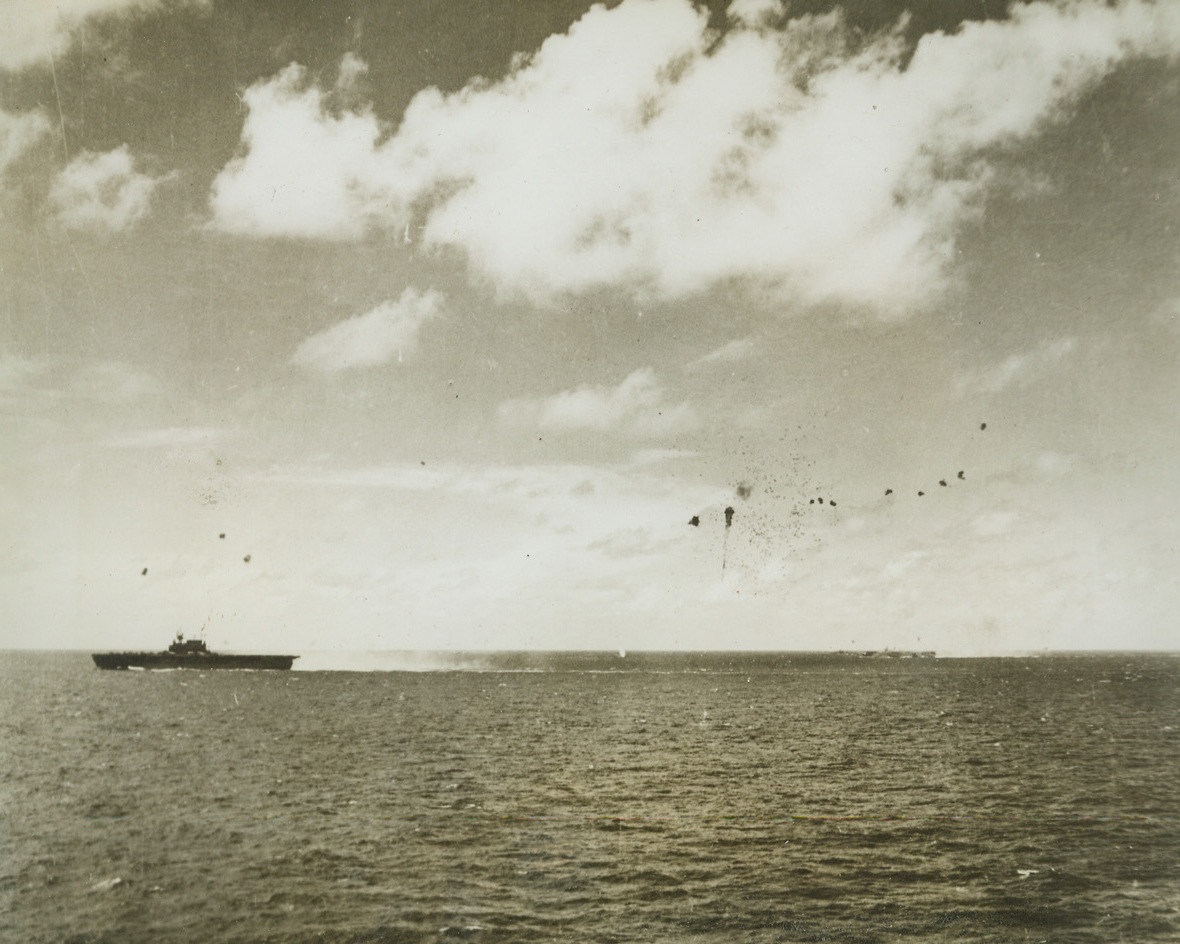
JUST A WRECK OF ITS FORMER SELF, 7/8/1944. SAIPAN, MARIANAS—A Jap dive bomber (right) is shot into tiny pieces as it moves in to attack the U.S. carrier during the big air battle off Saipan, when Adm. Mitscher’s fleet engaged the Jap navy. No lives were lost in this air battle, but two pilots were killed in a night crash on deck. American forces invading Saipan have shoved the Japs into a small six square mile space on the Island. Credit: ACME.;
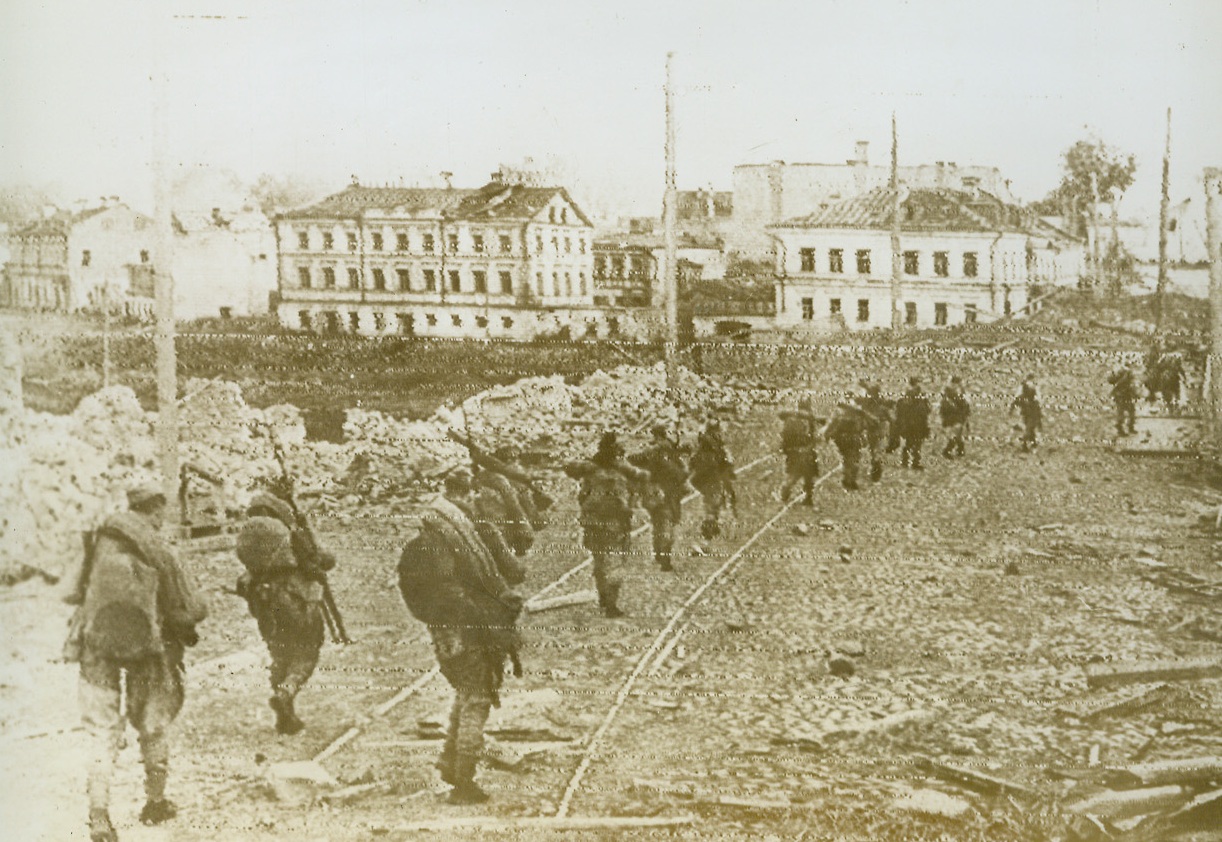
Soviet Infantry on the March, 7/25/1944. PSKOV, POLAND—Soviet infantrymen pass through a street in Pskov after fleeing Germans demolished the town. The Russian Army is now less than 50 miles from Warsaw, the Polish capitol. Credit: ACME Radiophoto;
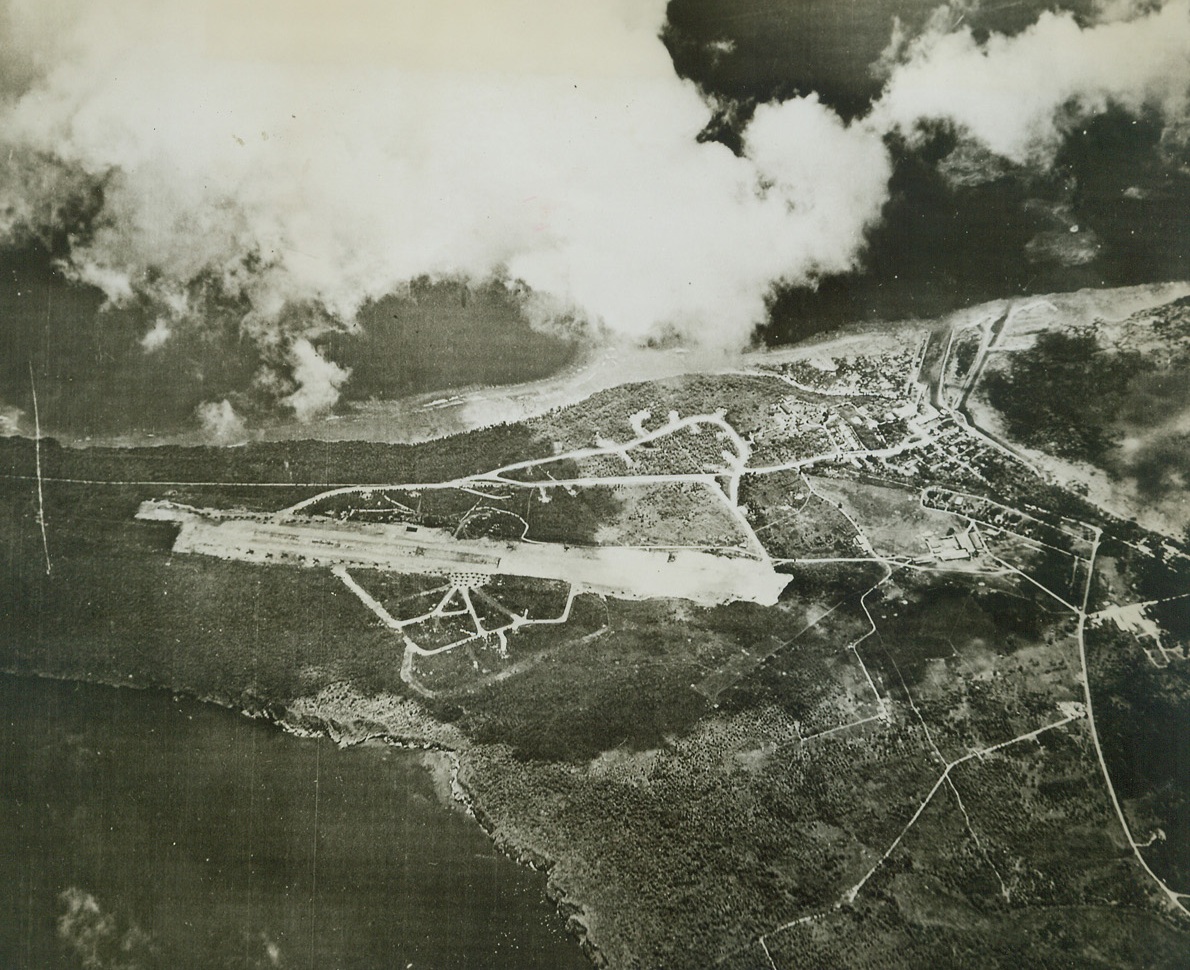
Objective in Guam Attack, 7/21/1944. Guam Is. – This Jap airfield on Guam, pictured from a Navy reconnaissance plane, is one of the objectives toward which Marine and Army troops are pressing after the invasion of July 20. Guam is only 579 miles Southeast of Tokyo. Credit (US Navy official photo from ACME);
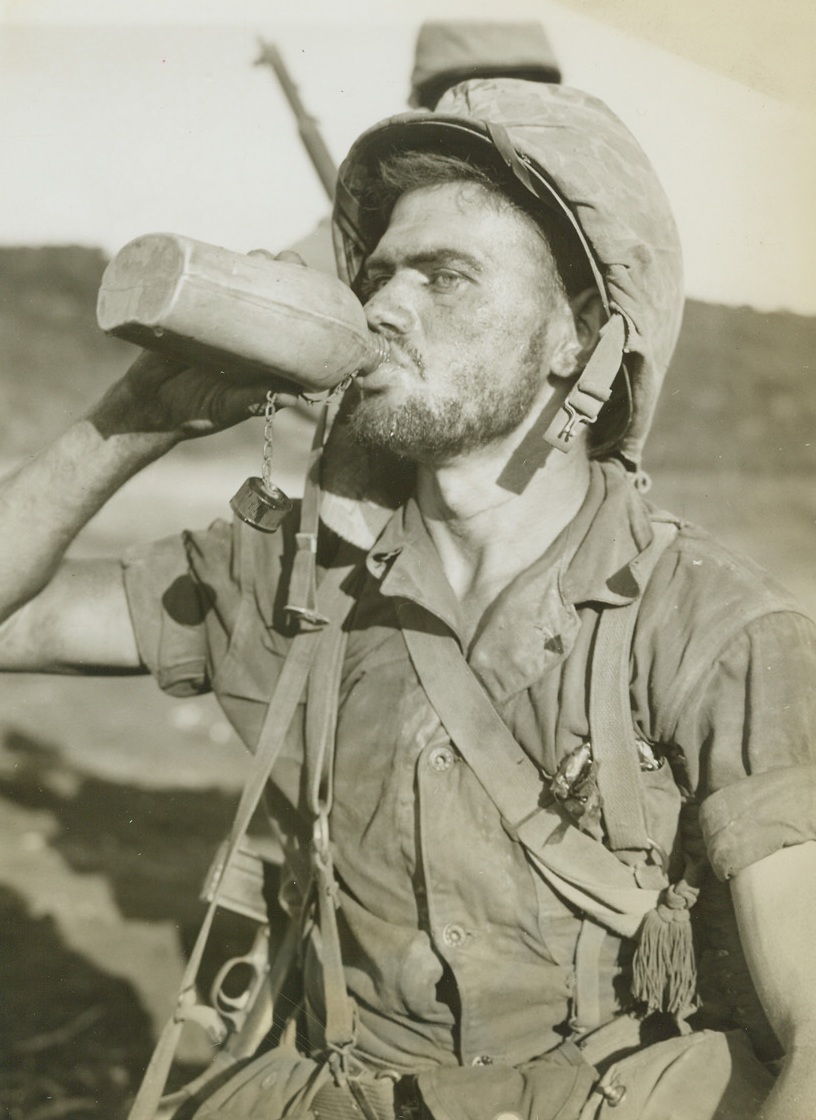
Thirsty Leatherneck, 7/21/1944. Saipan – Hot and weary after fighting on the Western beaches below Saipan’s Mt. Marpi, Marine Pfc. T.E. Underwood of St. Petersburg, Fla., takes a long, cool drink of water from his canteen. Beads of perspiration glisten on the weary Leatherneck’s unshaven face. Credit line –WP- (ACME photo by Stanley Troutman for the War Picture Pool);
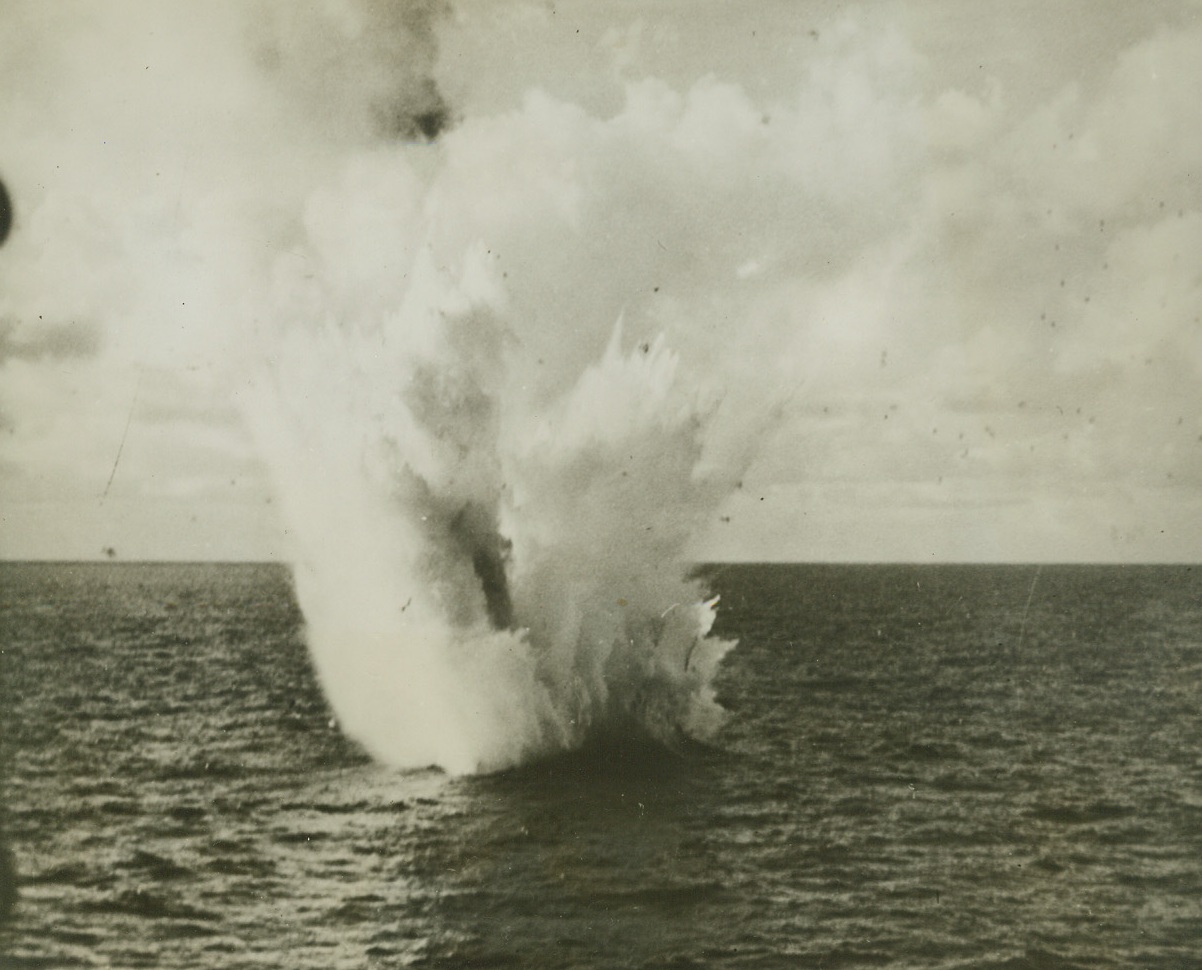
Into the Deep!, 7/24/1944. Testifying to the accuracy of U.S. Navy anti aircraft fire, this photo shows the fiery end of a Jap twin-engined plane shot down in the Pacific by an American flattop’s gunners. A salty geyser marks the grave of the warbird. Credit line (Official U.S. Navy photo from ACME);
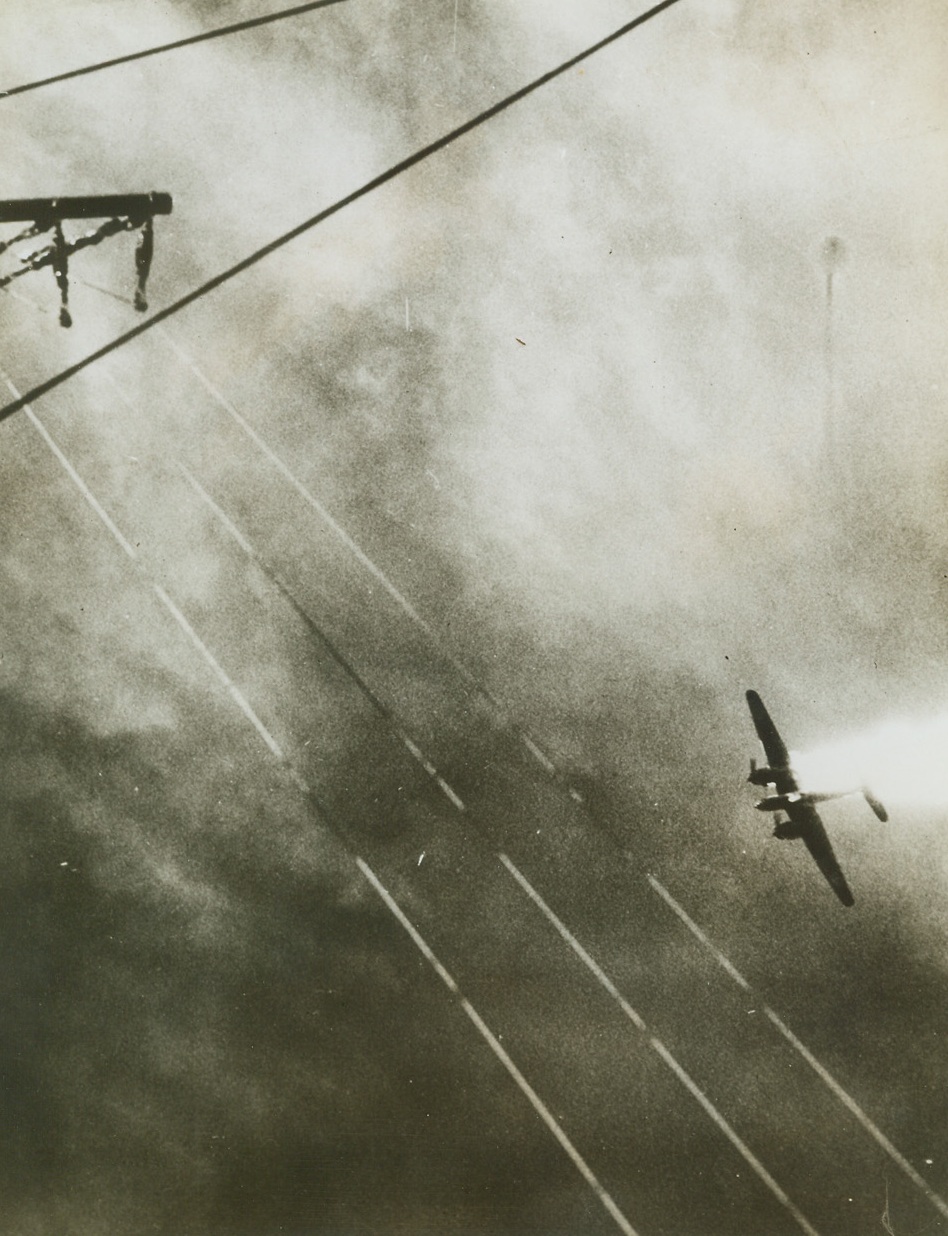
Jap Plane Goes Down, 7/24/1944. Testifying to the accuracy of U.S. Navy anti aircraft fire, this photo shows the fiery end of a Jap twin-engined plane shot down in the Pacific by an American flattop’s gunners. Streaming smoke and flame, the plane plummets into the ocean. Credit line (U.S. Navy photo from ACME);
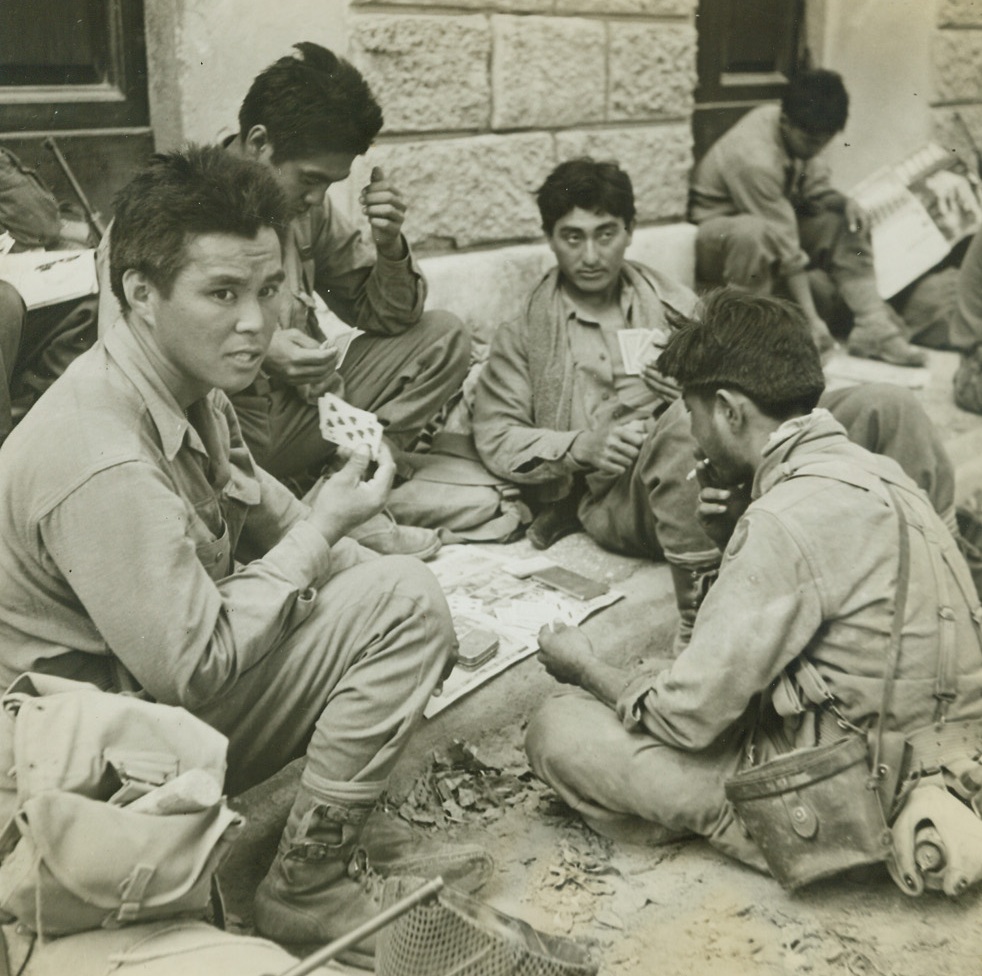
Relaxation’s in the Cards, 7/24/1944. Livorno, Italy – Relaxing in one of the park squares at Livorno, loyal Japanese-Americans squat for a lively poker game. These are some of the warriors who helped the Fifth Army to take the valuable Italian port. Credit line –WP- (ACME photo by Sherman Montrose for the War Picture Pool);
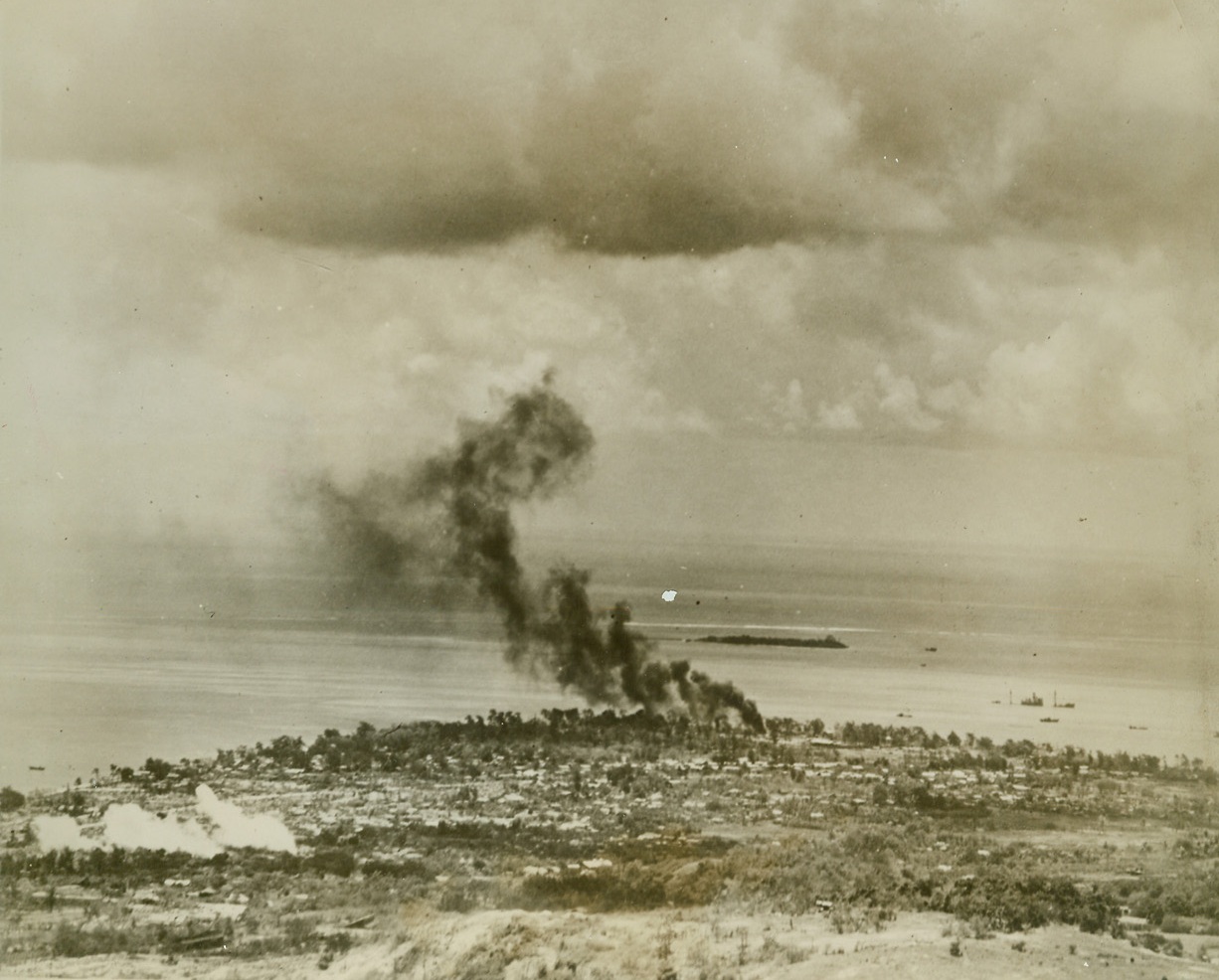
Warships Shell Garapan, 7/5/1944. Garapan, Saipan – Leathernecks from the Second Marine division – the conquerors of Tarawa – were tightening the vise around the city of Garapan, capital of Saipan, when this photo was taken. Fires in the coastal area were caused by fleet bombardment and sunken Japanese shipping can be seen in the harbor. Garapan has surrendered and is now in American hands. Credit line (Coast Guard photo from ACME);
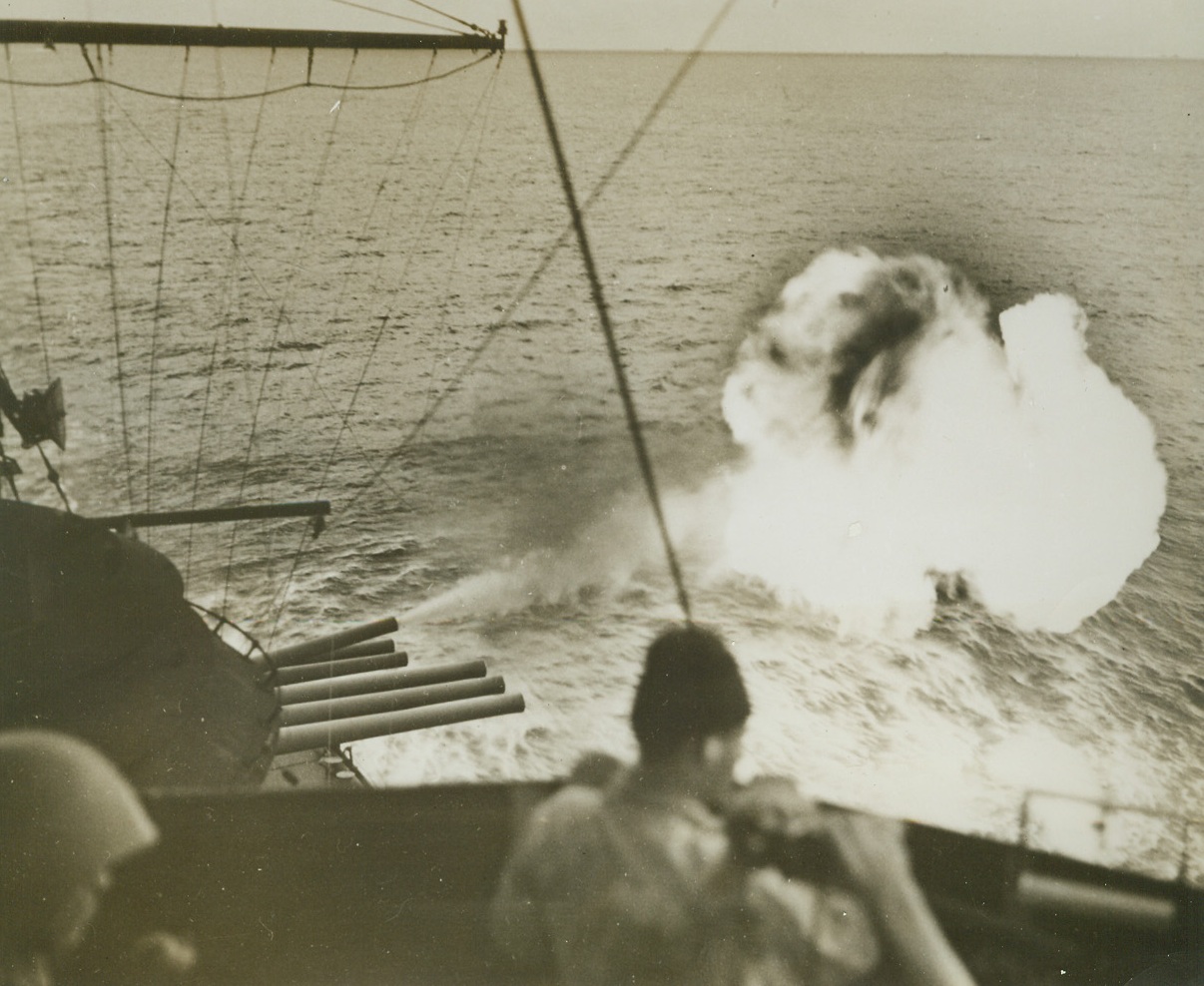
Fireball, 7/5/1944. Off Saipan – With a roar and a blast of vivid flame, a 14-inch gun aboard a U.S. battleship hurls screaming steel toward Jap positions on Saipan island. This is only one of the hundred of guns of a giant Navy task force that helped U.S. Marines and Army troops establish their beachhead, last June 14. Today, with the exception of a small pocket of resistance, American forces are in full possession of the strategic Mariana island. Credit line (U.S. Navy photo from ACME);
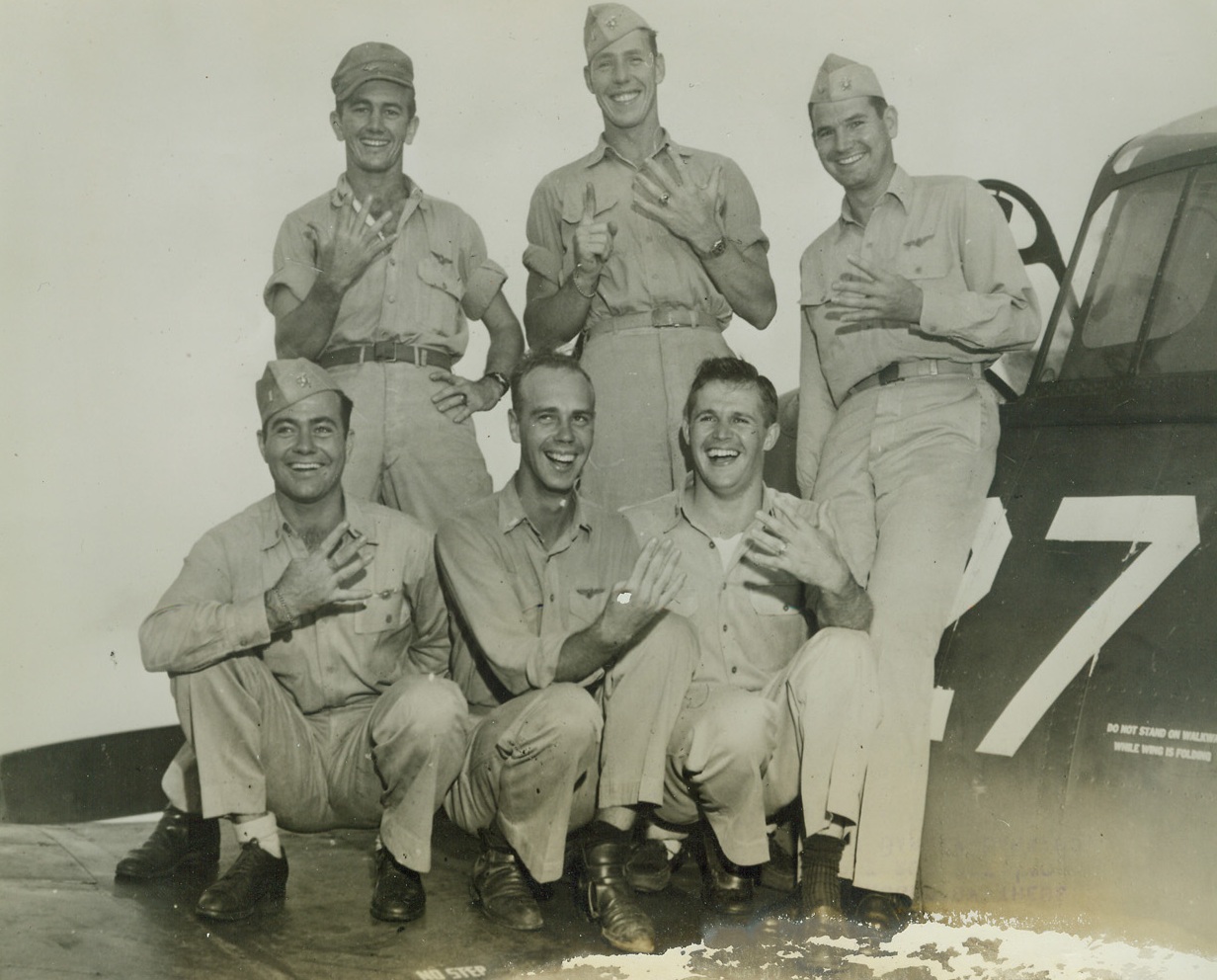
They Downed 28 Jap Planes, 7/6/1944. Pacific Fleet – Twenty-eight Jap planes were bagged by these members of famous “Ripper Squadron” in a singl run off Iwo Jima, June 24. Top row, left to right: Lt. (JG) Barney Barnard, Donna, Tex., who bagged 5; Ens. W.B. Webb, Wichita Falls, Tex., 6; Comdr. William A. Dean, Coronado, Calif., 4. Bottom row, left to right: Lt (JG) Merriwell W. Vineyard, Whitewright, Tex., 4; Lt. (JG) E.C. Gargreaves, Brimfield, Tex., 4; and Lt. Russell L. Reisener, Redwood City, Calif., 5. The squadron has shot down 120 planes in combat, destroyed more than 120 on ground. Credit line (ACME);
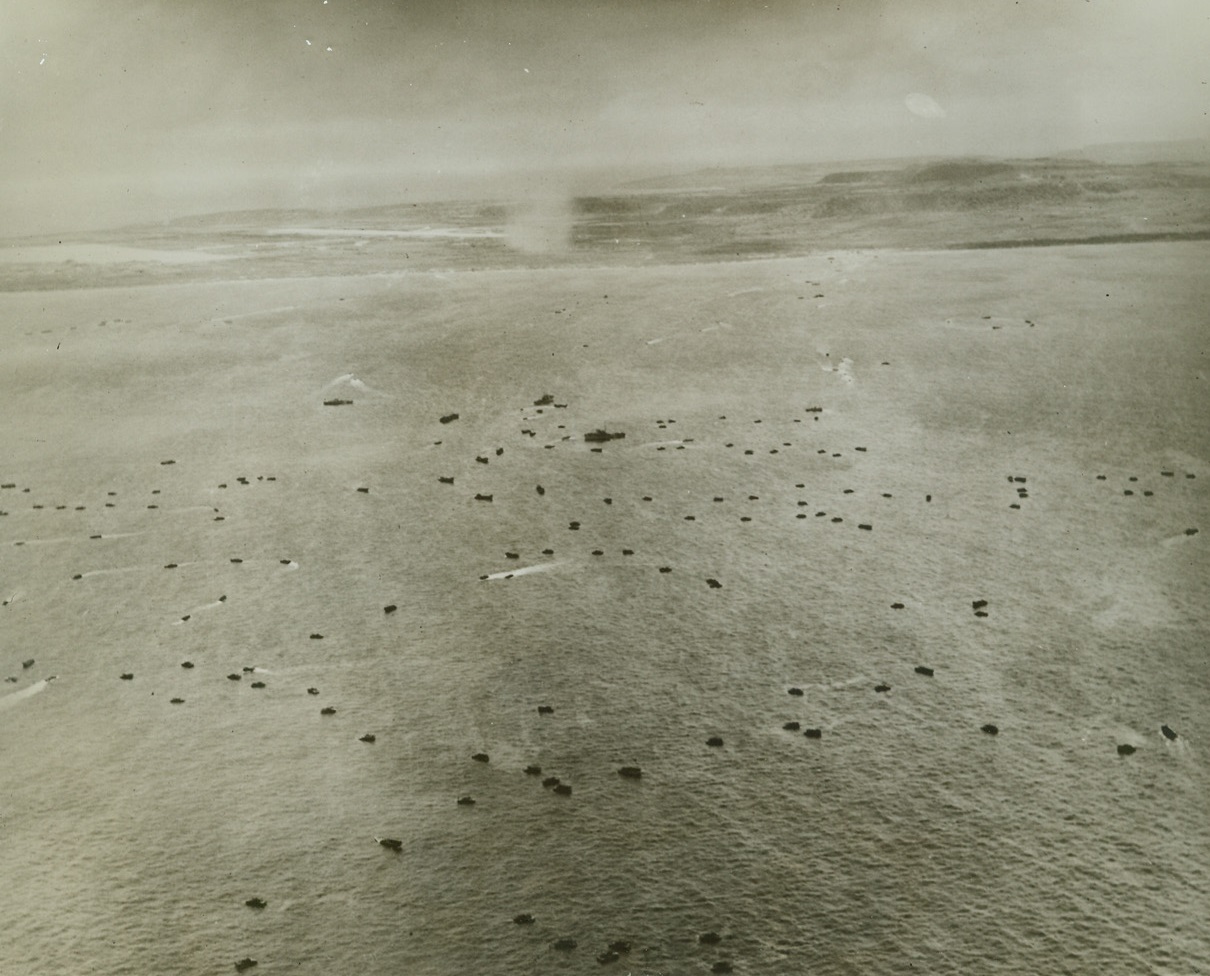
Tinian Invasion Gets Under Way, 7/30/1944. Tinian, Mariana Is. – As smoke rises from pre-invasion artillery pounding on Tinian, waves of small landing boats head for the beach as Marines begin their invasion of the island. This was the third island of the Marianas to be invaded by US forces within 6 weeks. Credit (Marine Corps photo from ACME);
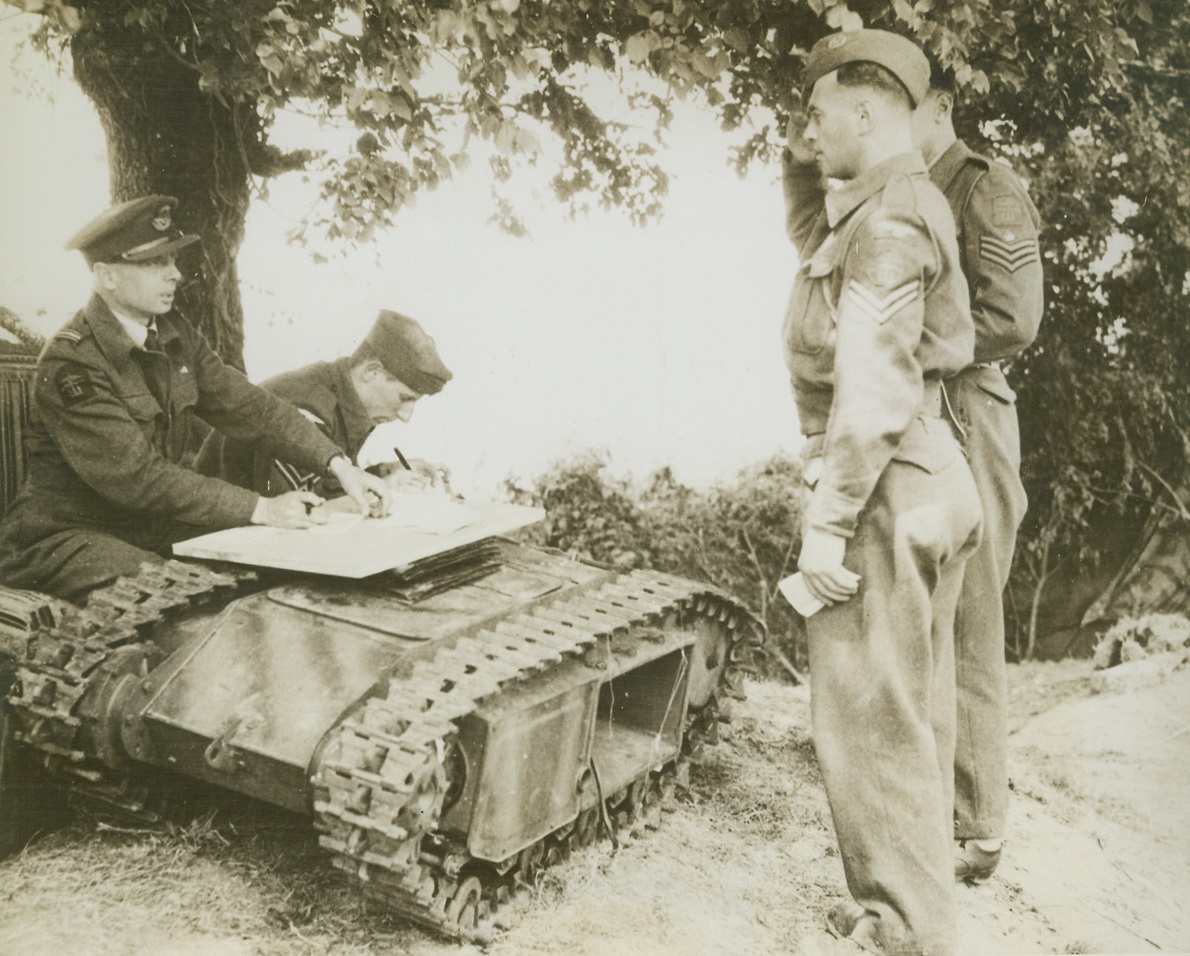
“Beetle” Tanks Serves Allies, 7/12/1944. France - - Using a knocked out German “beetle” tank as a desk, members of an R.A.F. beach squadron receive their first pay since their arrival in Normandy. Cpl. R.W. Richards salutes his officer behind the German miniature tank tightly clutching three-weeks pay in his free hand. Squadron arrived on June 6, and was so busy unloading ships that the unit requested pay be delayed since there was no time to spend it anyway. Credit (British official photo from ACME);
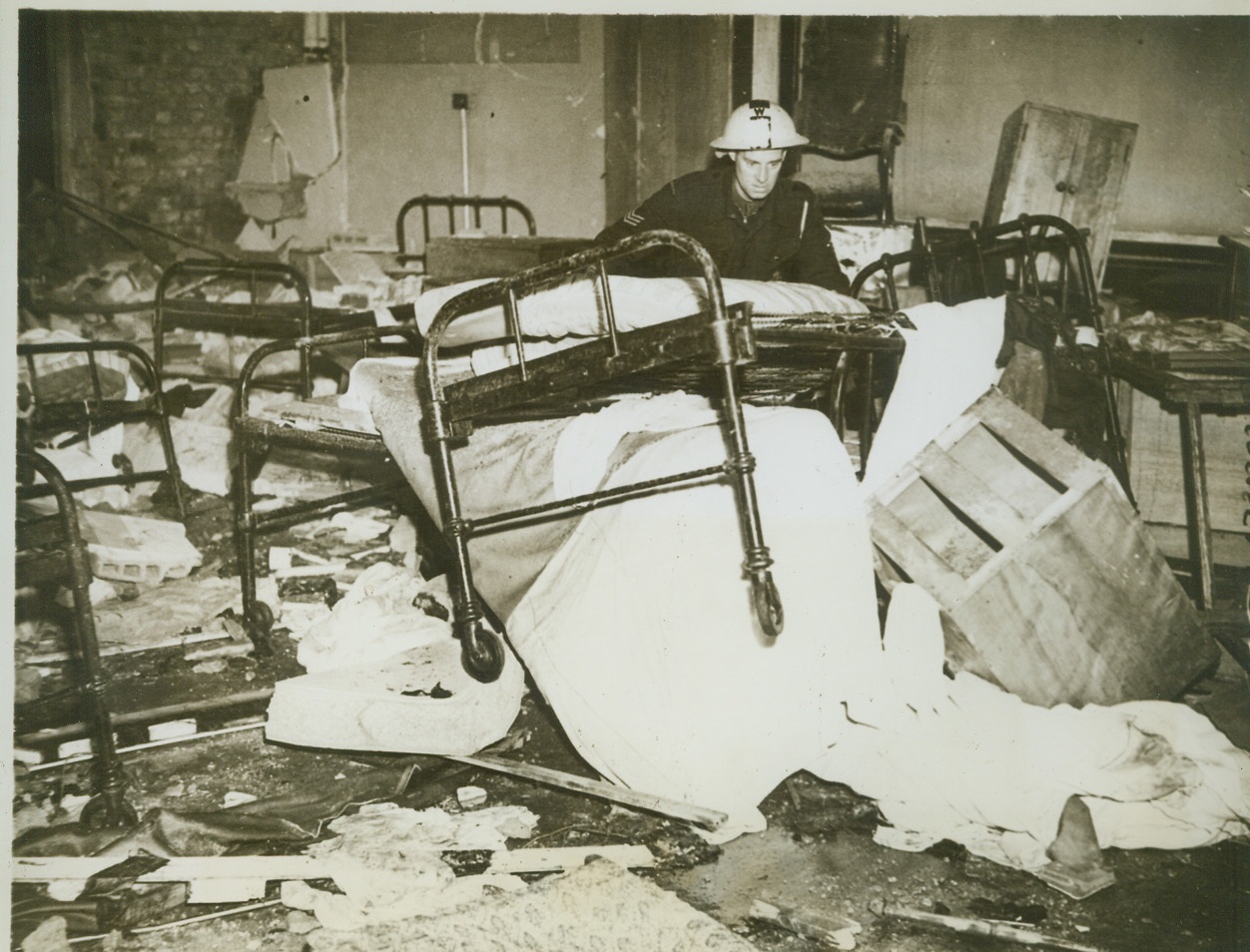
Flying Bomb Strikes Again, 7/14/1944. ENGLAND -- A British soldier looks horror-stricken at the havoc to the ward of a hospital in southern England by one of the Nazi flying bombs. These bombs, a revenge of the Nazis for the Allied invasion of their "Festung Europa", have brought many casualties to the residents of southern England, but Allied planes have been consistently attacking the launching platforms. Credit (ACME);
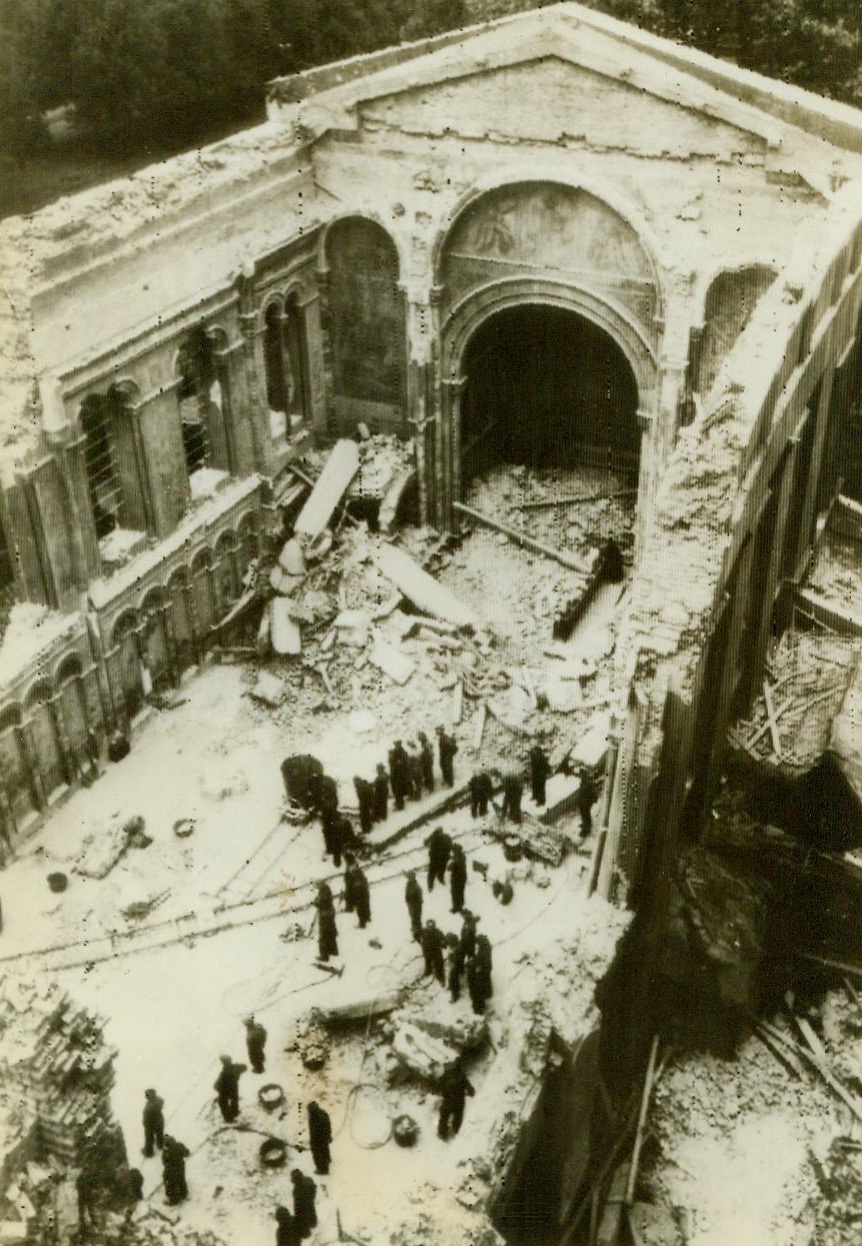
Guards chapel hit by robot bombs, 7/9/1944. LONDON - Many casualties resulted when the famous guards chapel of Wellingon barracks was badly damaged by Hitler's robot bombs. Wreckage of the place of worship is shown in this overhead view, as salvage workers begin to clear the debris. Endling the longest lull since the launching of Germany's "Ersatz Blitz", the blind bombs again thumped down over southern England last night. CREDIT LINE (ACME Radiophoto) 7/9/44;
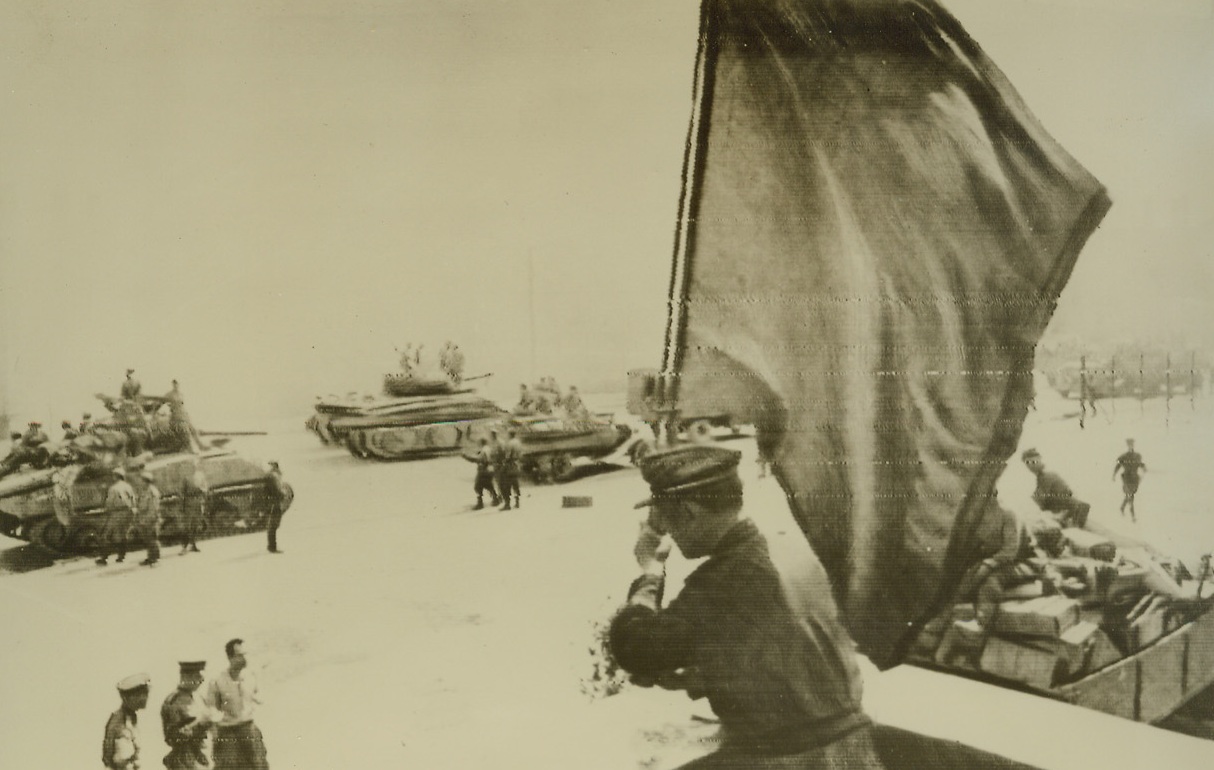
Minsk Loses Nazi Bombs, 7/6/1944. Minsk—Tanksmen stand and watch as the Red Flag of the Soviet Union is raised once more over the industrial city of Minsk. Russian armies rolled forward with terrific speed to retake the city which had become a key Nazi bastian. Credit: ACME radiophoto.;
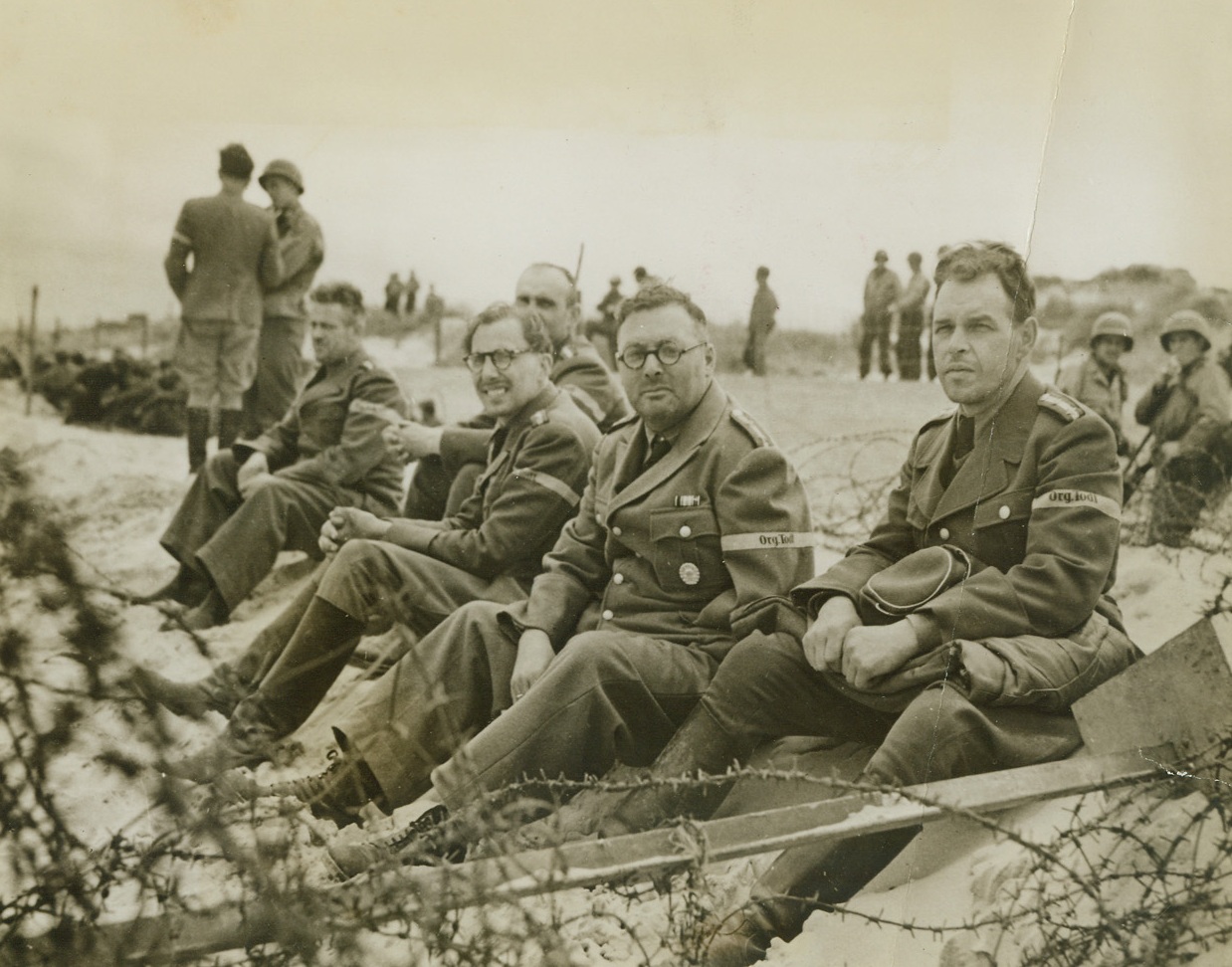
They Built the Impregnable Wall, 7/3/1944. NORMANDY, FRANCE - From behind their barbed wire cage, these officers of the German ...Organization Labor Battallion watch with interest (and is there a trace of disdain?) the Yanks who were partially responsible for the downfall of the Atlantic Wall and the Siegfried Line which the...Organization built. Taken prisoner when the allies invaded the French Coast and blasted the famed wall into nothingness, these master minds of engineering will go into hibernation for the duration.;
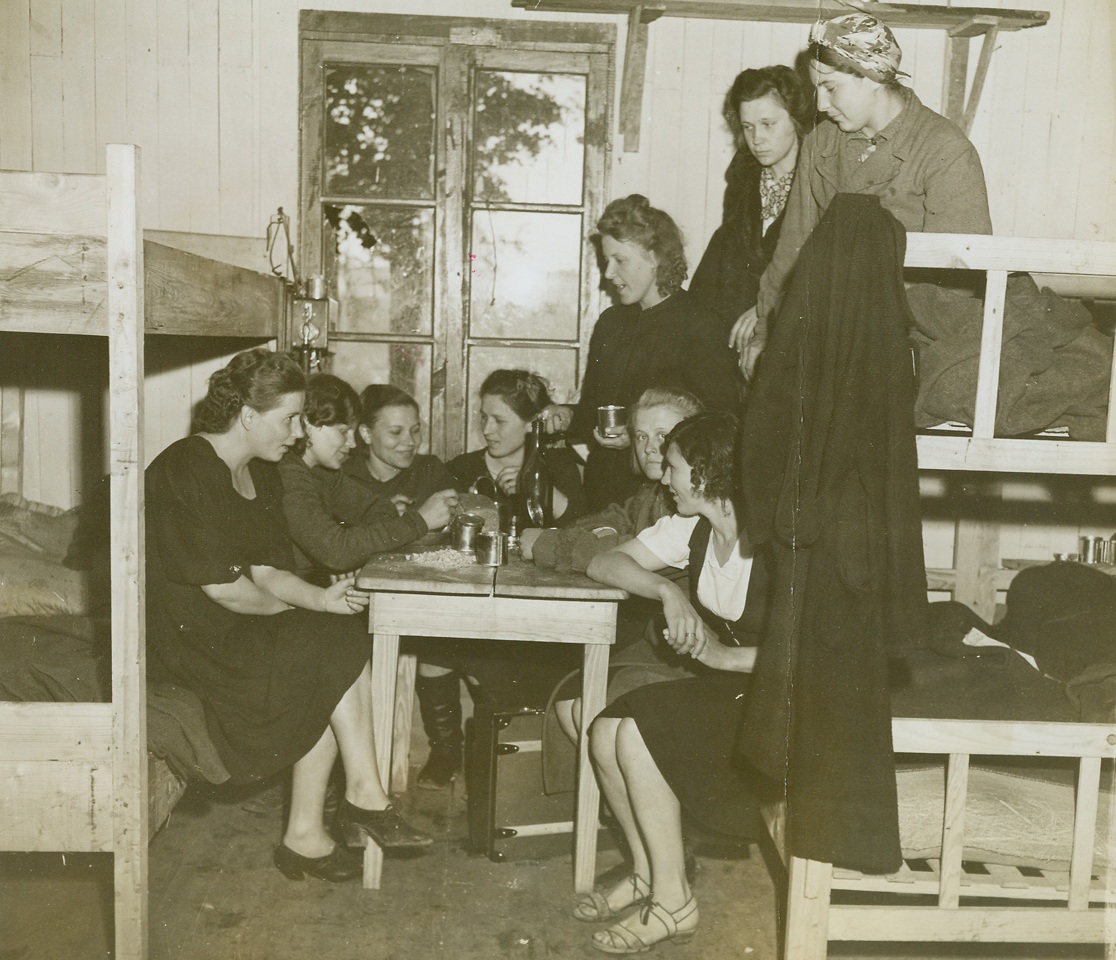
Gab Fest Among Women Refugees, 7/10/1944. Normandy, France—French refugees, driven from their homes by the course of the war in France, gather in a friendly group among their bunks in an evacuation camp and talk about the days that were and the happy days to come after the Germans have been driven from their homeland. Yesterday in a triumphant push, British and Canadian forces entered Caen, principal blockade on the road to Paris. Credit: ACME photo by Andrew Lopez, War Pool Correspondent.;
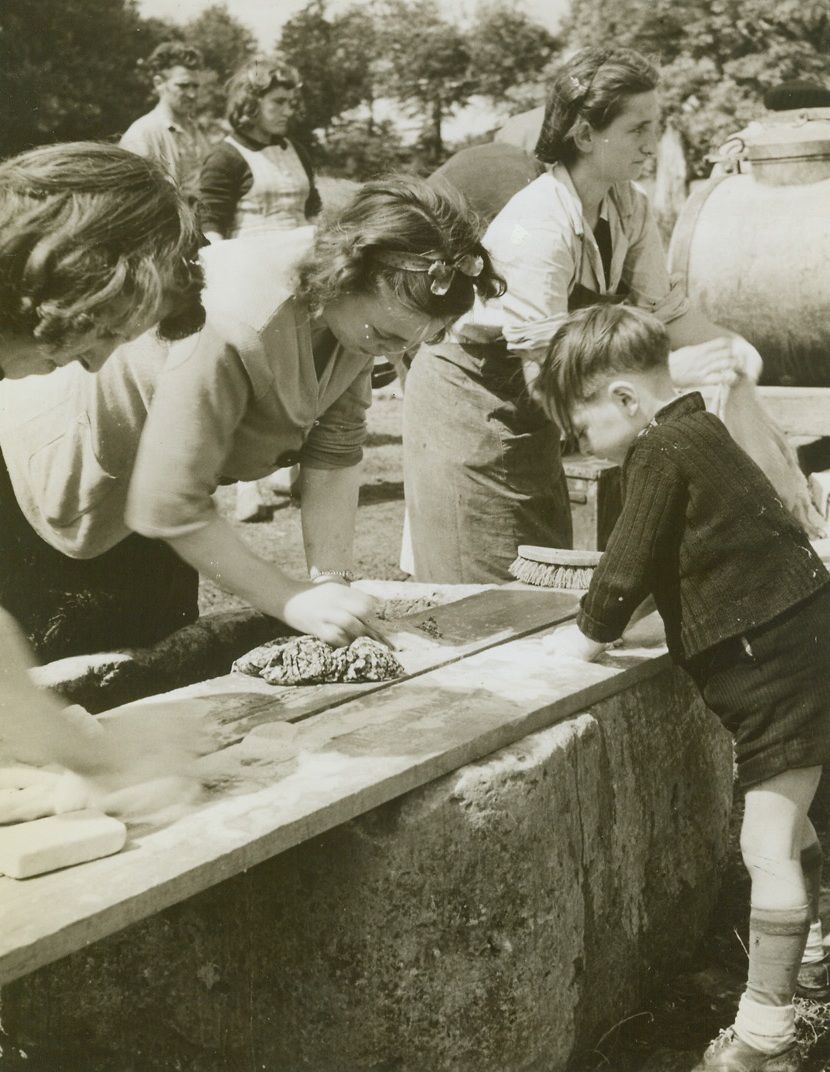
Mother’s Little Helper, 7/10/1944. Normandy, France—Intent upon his work, this little French boy scrubs away as he gives a hand to French women refugees as they do their washing. Note the old-fashioned way they wash—using boards to scrub the clothes on, just as their ancestors did in days gone by. They are in special camps for refugees established by Allied civil affairs. Credit: ACME photo by Andrew Lopez, War Pool Correspondent.;
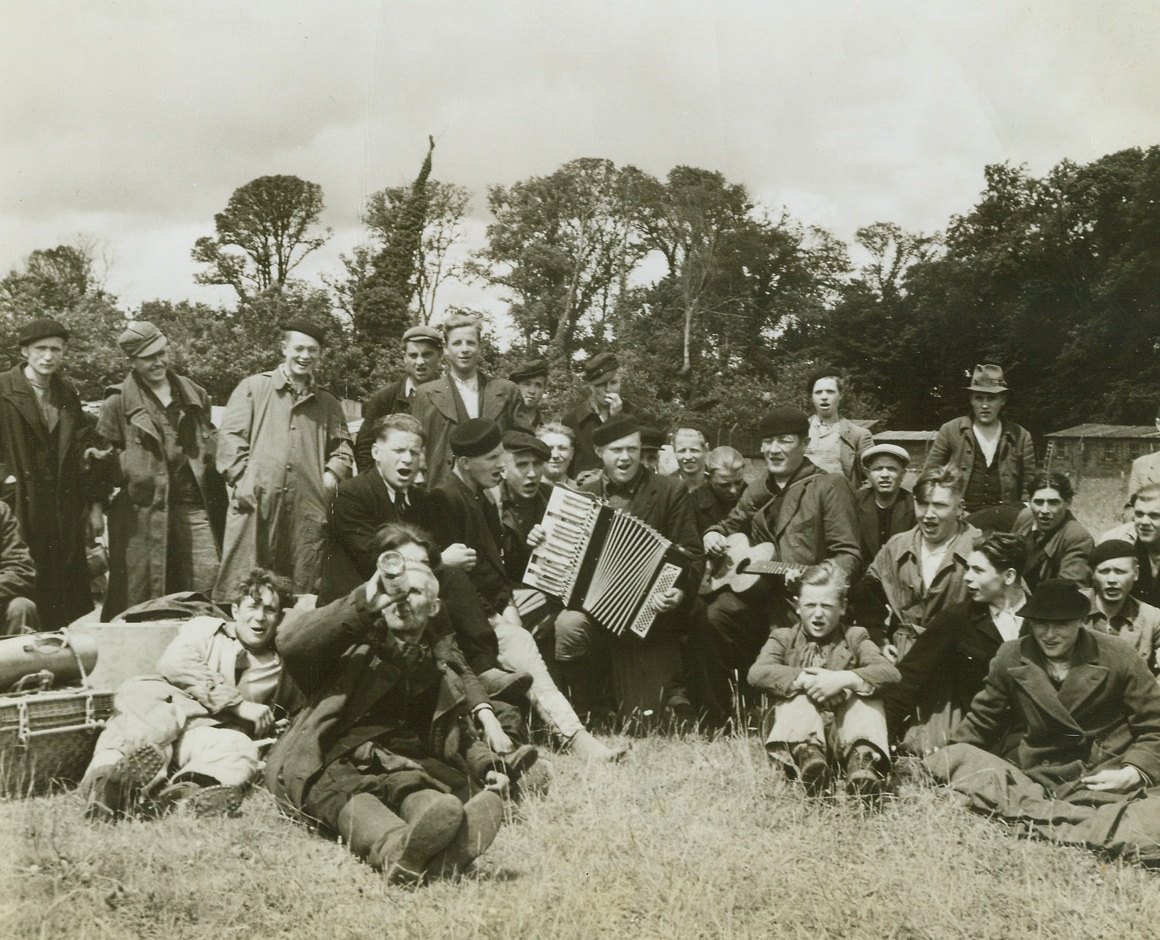
Freed Russians to Return to Homeland, 7/10/1944. Normandy, France—This hilarious group of Russians, freed by the Allies from their enforced labor with the German army, celebrate their liberation in the traditional way—wine and song (their women are waiting for them back in Russia). They are waiting in an Allied camp for transportation to England and from there to Russia. Credit: ACME photo by Andrew Lopez, War Pool Correspondent.;
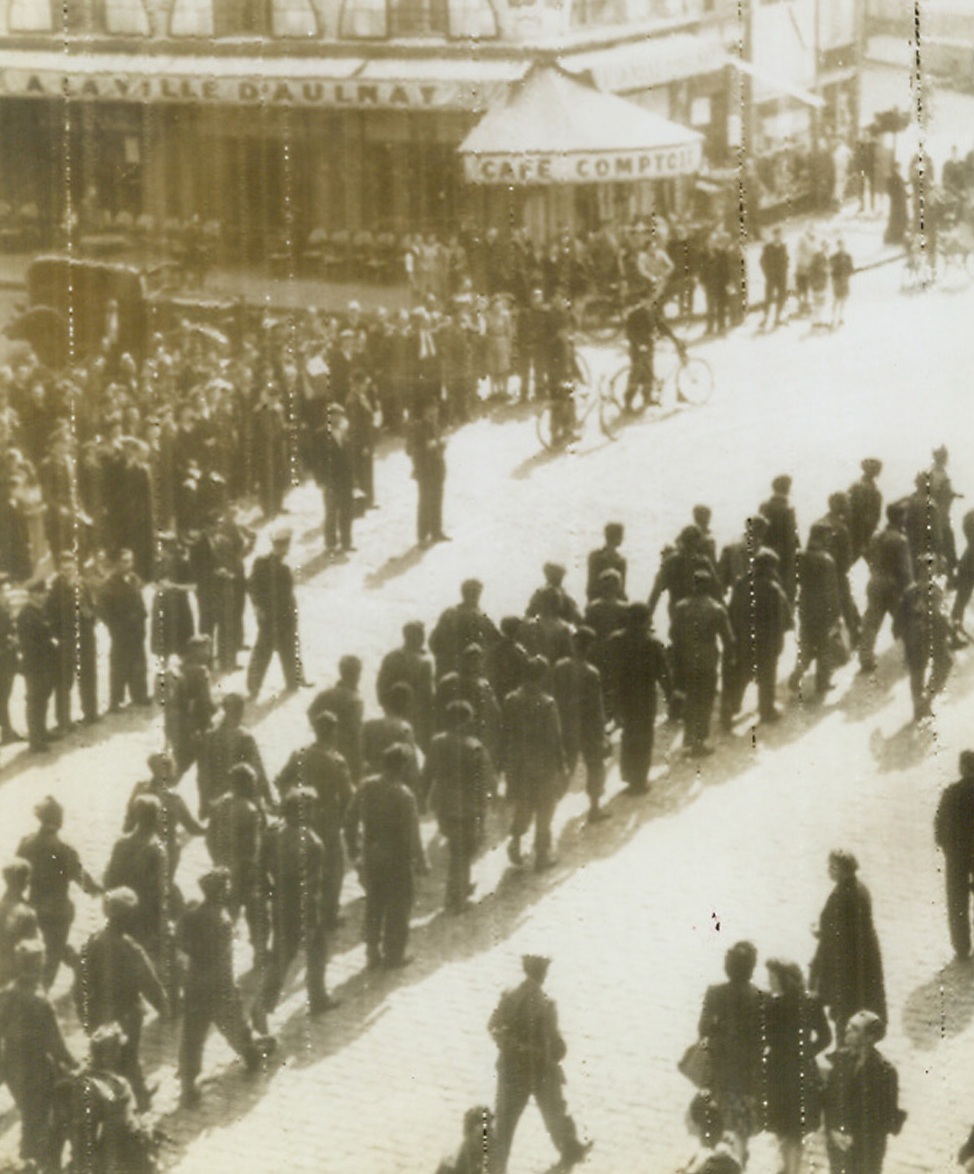
Allied Prisoners March Through Paris, 7/11/1944. According to the German caption accompanying this photo, radioed today (July 11) from Stockholm, these are American and Canadian prisoners from Normandy marching through German-held Paris. Probably as a retaliation for Allied pictures of German prisoners reaching England, the Nazi propaganda line on this photo blares out, in highly sarcastic tone, “the liberators marching through Paris.” Credit: ACME radiophoto.;
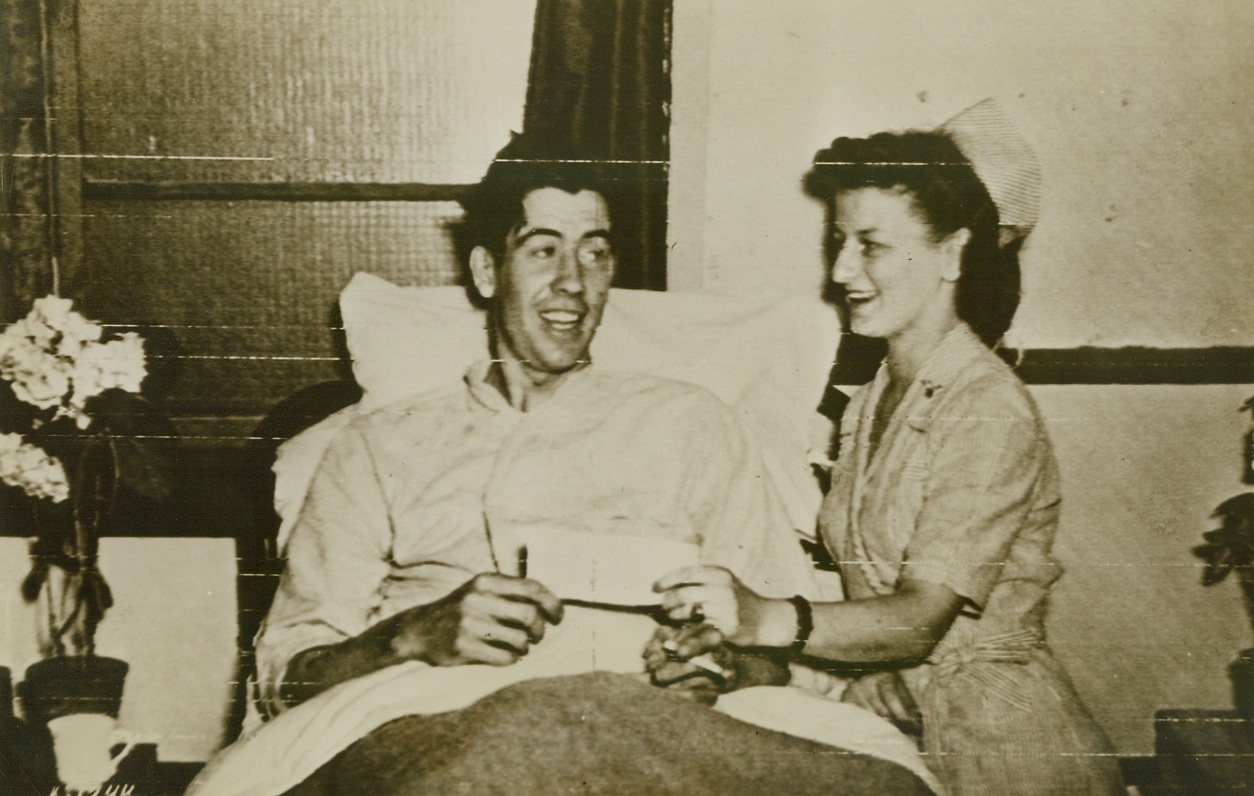
Buried Alive by Robot Bomb, 7/12/1944. England—Sgt. Emery Barefoot, of Vienna, Ga., lived through one of the most amazing experiences of World War Two, when he was emtombed by the explosion of a German Robot Bomb, and spent four days in his “grave” before he was rescued. During that time he ate plaster and portioned out the water in his canteen, trying from time to time to dig himself out with a fork, and having weird dreams every time he fell asleep. He is shown at an English hospital where he is recovering from his injuries. His nurse is Lt. Yolande Carrado, of Corona, L.I., NY. Credit: Army radiotelephoto from ACME.;
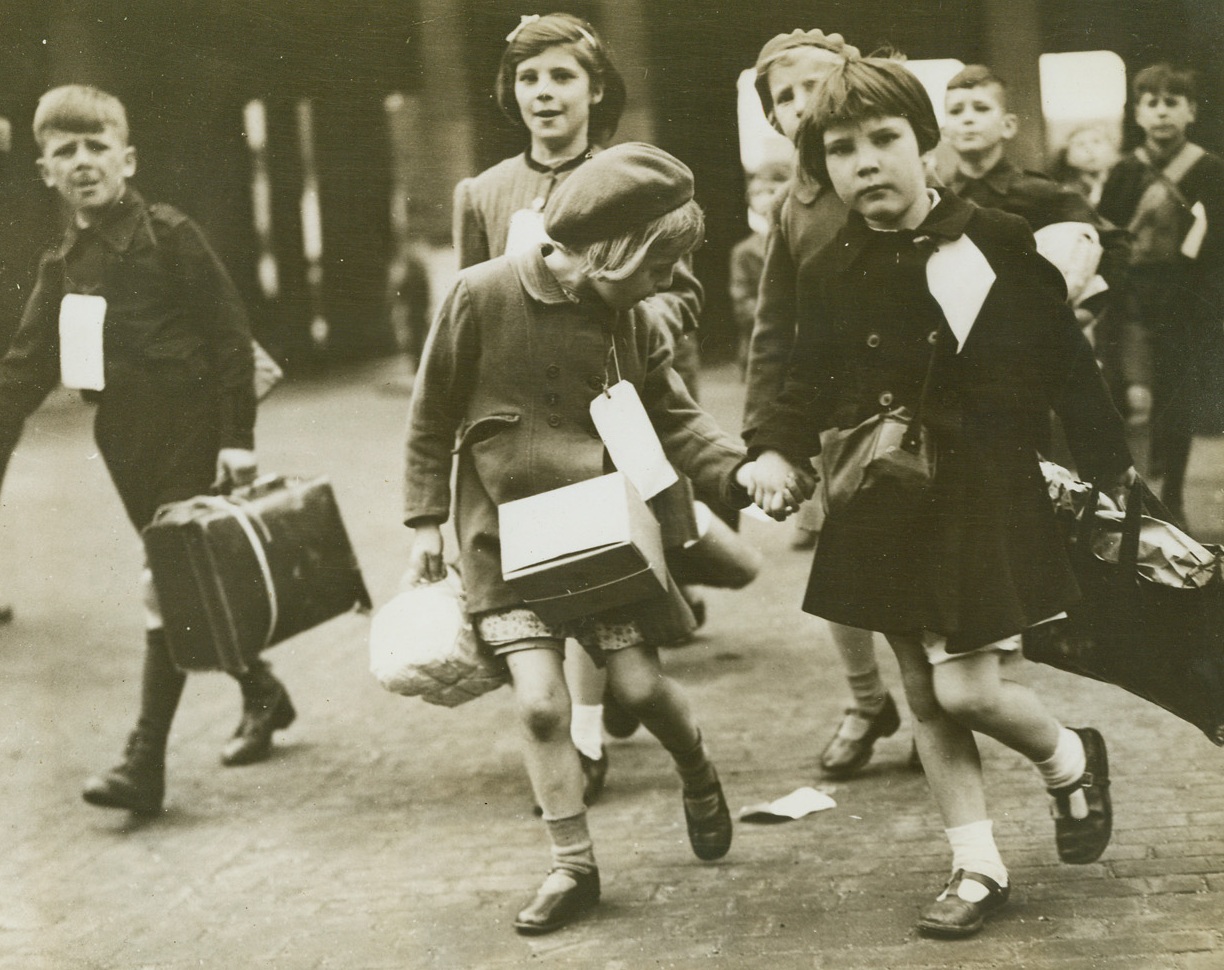
Evacuate London Children, 7/12/1944. LONDON - London authorities are continuing the evacuation of children from the city limits to get them away from the indiscriminate shelling by the Nazi robot bombs. Recently hundreds left for safer areas in the midlands and north England. Carrying parcels , little evacuees bound for the countr walk toward their train.;
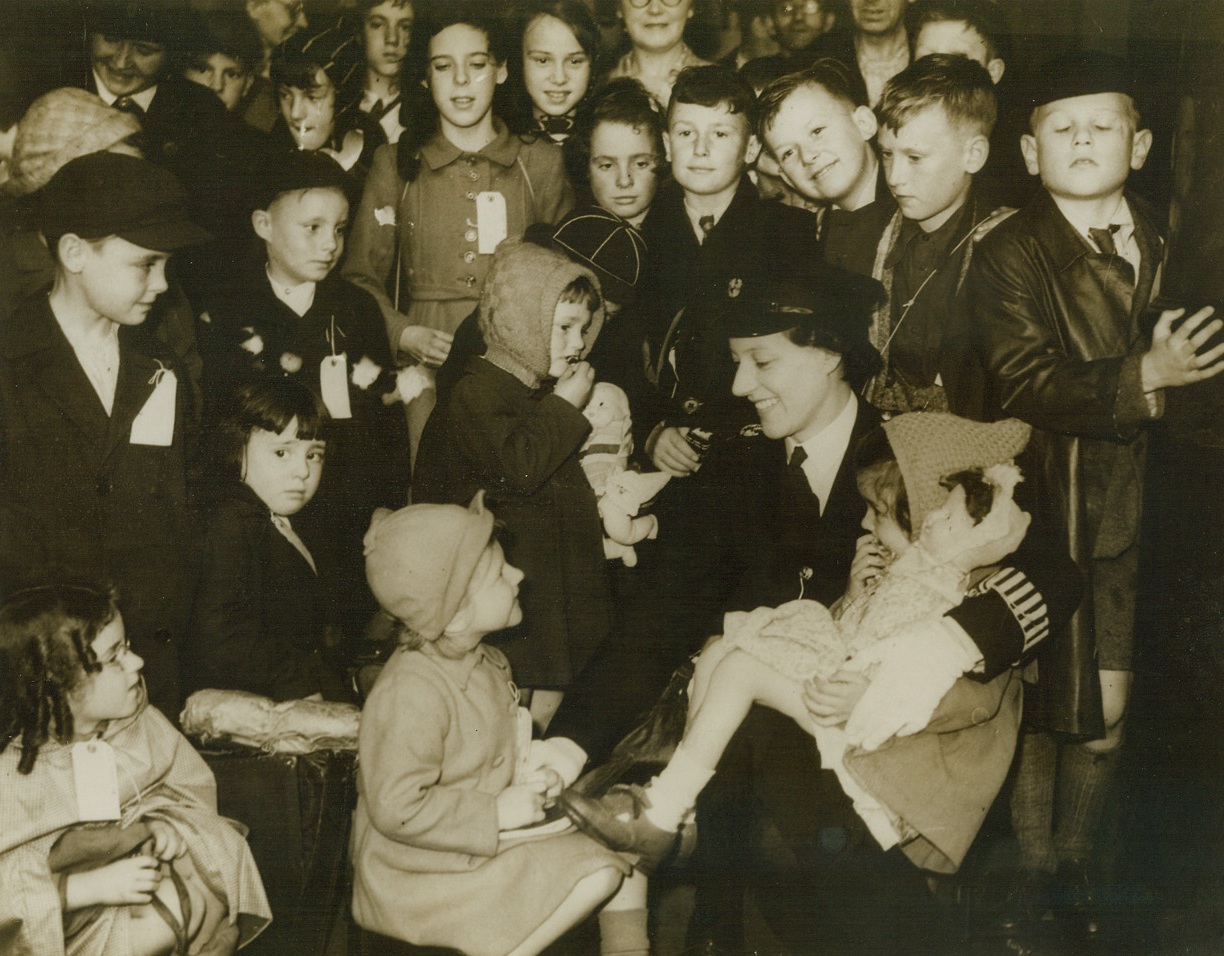
Children Evacuated from London, 7/14/1944. London, Eng.—A policewoman reassures these children who are being evacuated from London to a zone which is safe from the Nazi flying bombs which have been hitting at southern England. Tagged for identification, these youngsters embark upon their new adventure with smiles, even though most of them are leaving their parents behind in London. Credit: ACME;
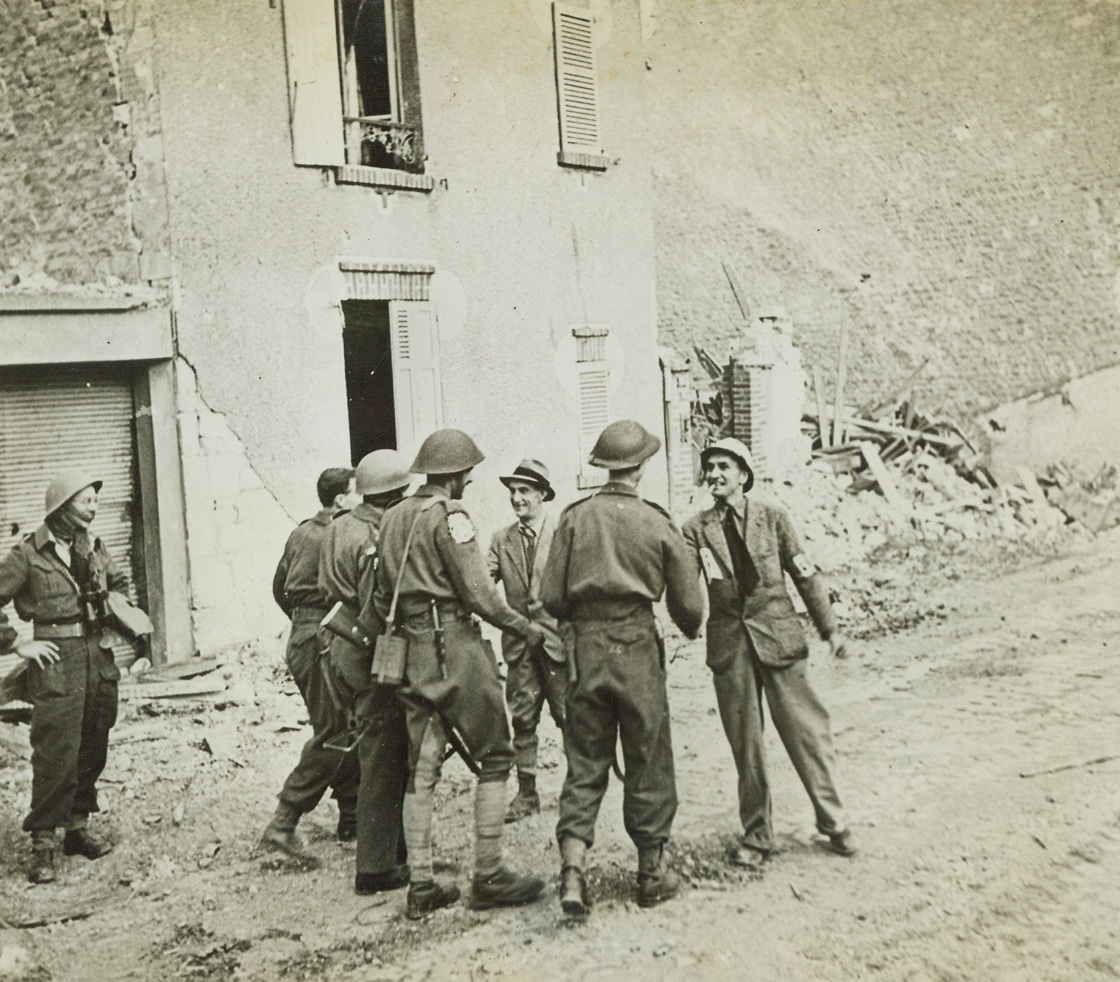
Welcome for Incoming British, 7/14/1944. Caen, France—After a massive land, sea, and air assault, the British and Canadian forces finally entered Caen on July 9, 1944, on the heels of the retreating Germans. Rushing forward to greet the advance troops with smiles of welcome and outstretched hands are Capt. Gille, President of the Committee of Liberation of Calvados, and M. Deuvre, the Prefect of the Calvados, two patriots who remained in the ruined town. Credit: British official photo from ACME;
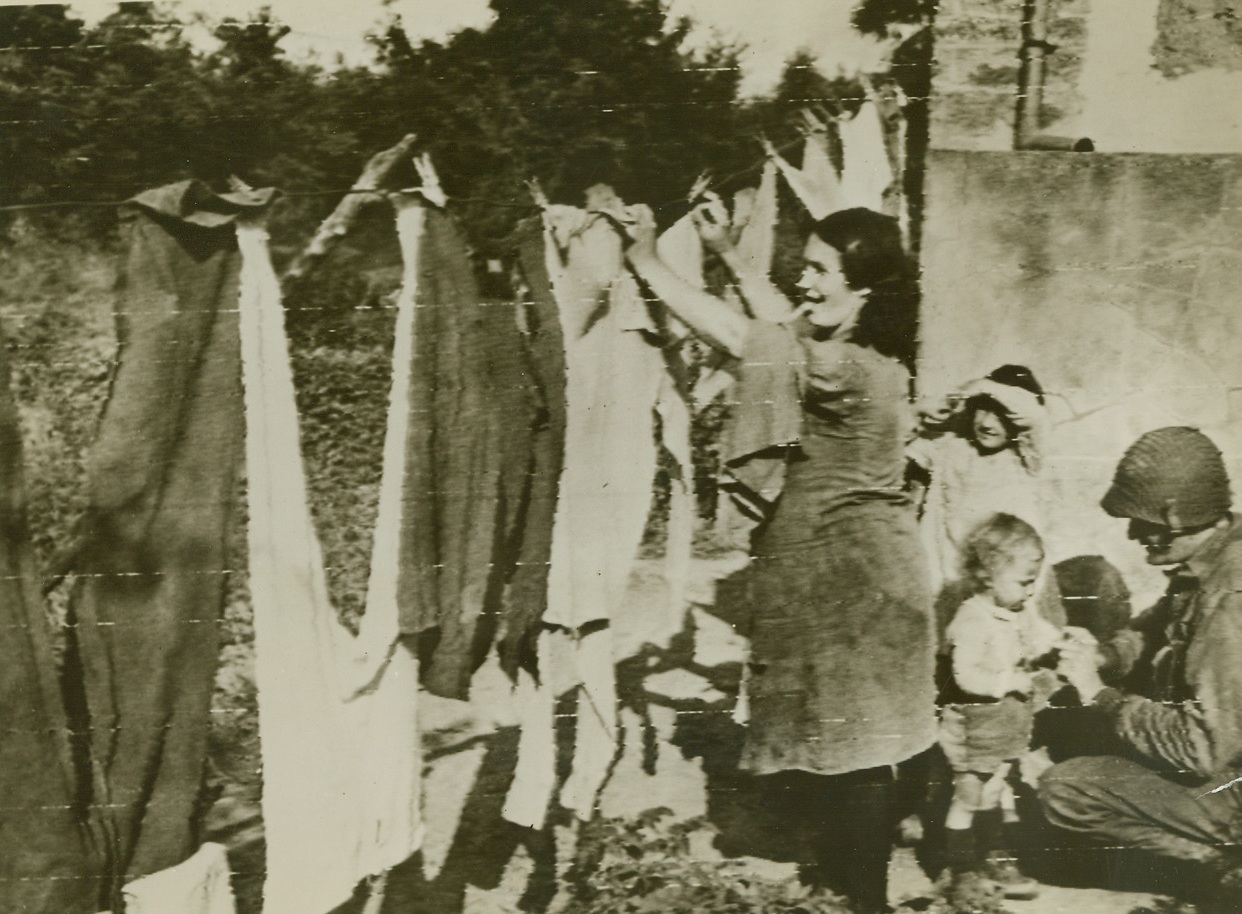
Frenchwoman Does G.I. Laundry, 7/18/1944. St. Lo, France—A happy G.I., relieved of his wash day duties, entertains some French youngsters while their mother hangs some G.I. laundry on the line. The soldier is T/Sgt. Olin Dows, Rhinebeck, N.Y. Credit: U.S. Army radiotelephoto from ACME.;
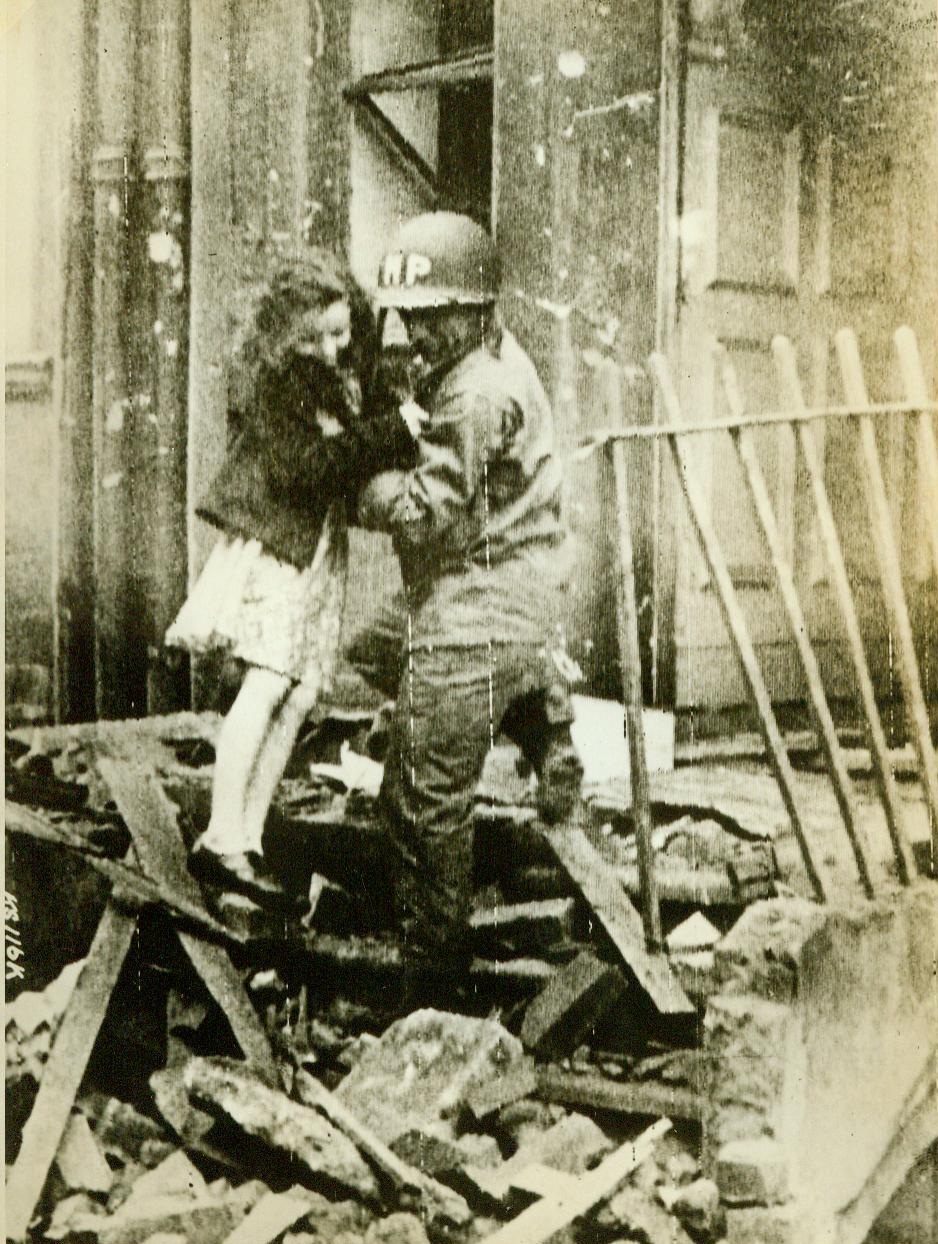
Yank Aids Flying Bomb Victim, 7/5/1944. ENGLAND - An American military policeman...lifts a young British girl out of her home which was hit by a Nazi flying bomb. Bombs, striking indiscriminately, have hit schools, hospitals and churches. Scene took place somewhere in England.;
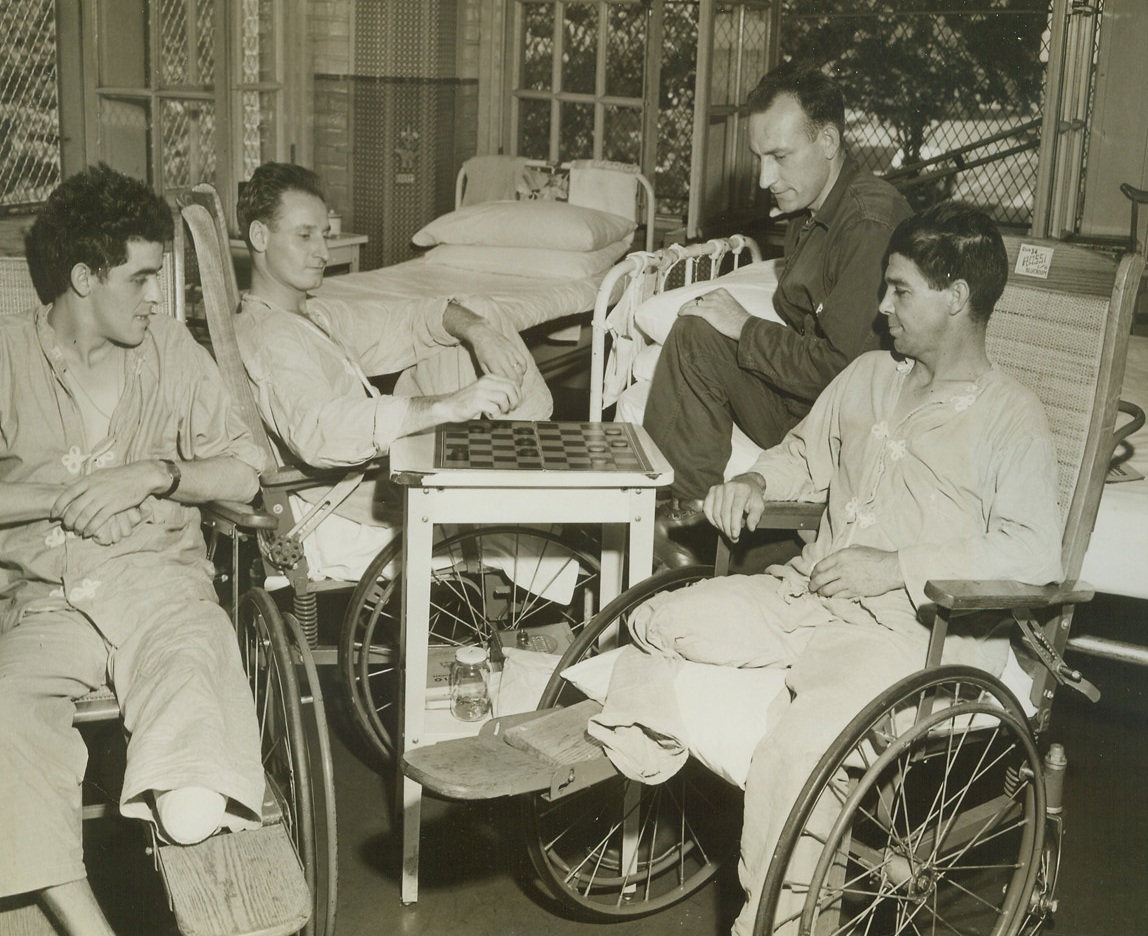
First Normandy Wounded Here, 7/12/1944. Washington, D.C.—Among the first wounded to be brought home from the Normandy beachhead, these four Yank heroes while away the hours with a checkers game, at the Walter Reed Hospital in Washington. Left to right, are: Pfc. James R. Hines, 25, Brookville, Pa.; Pvt. Clarence Osher, 24, Redford, N.Y.; Pfc. Lester A. Walter, 33, Auburn, N.Y.; and Pvt. Lewis E. Morris, 37, Crozet, Va.Credit: ACME.;
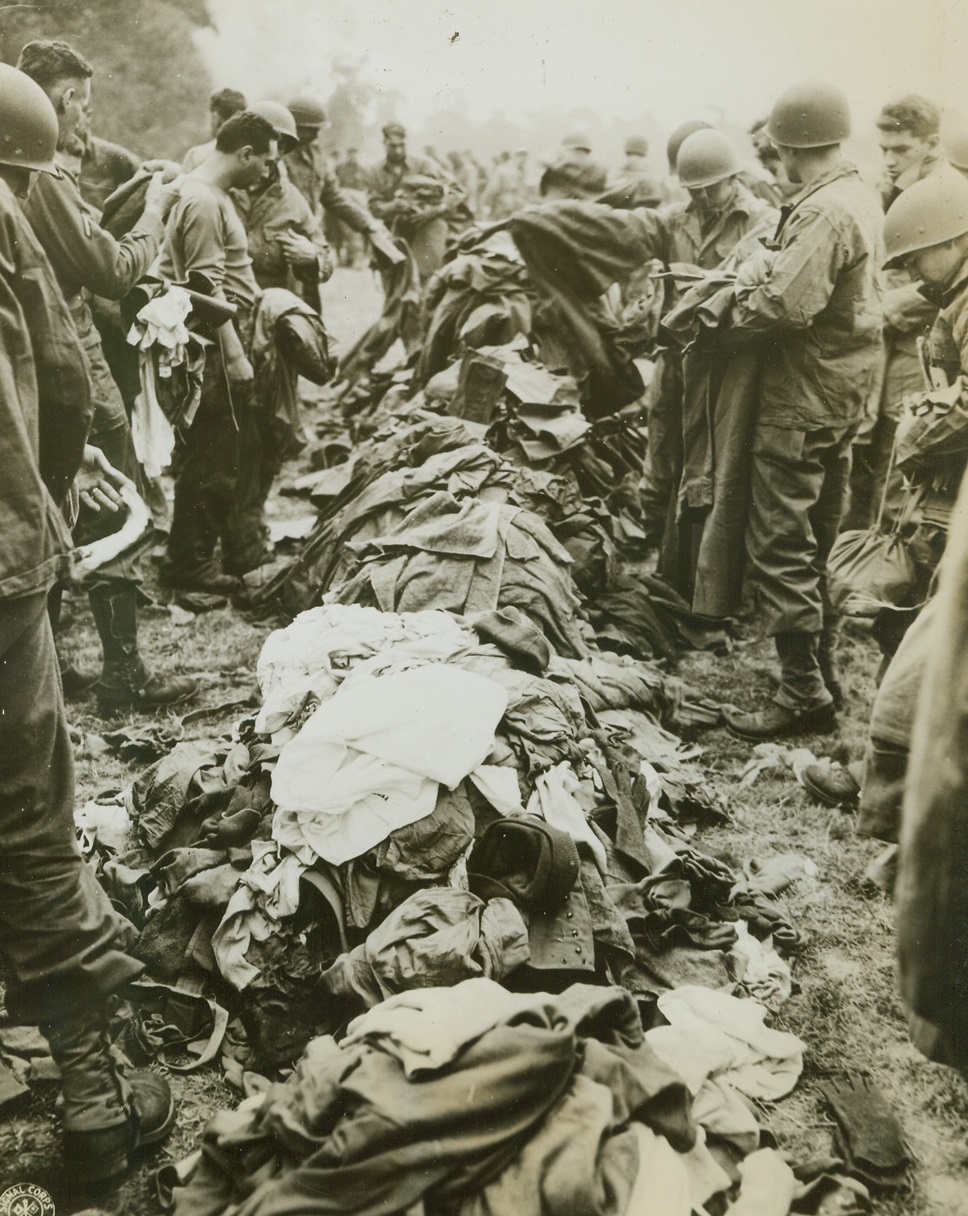
Excess Baggage, 7/26/1944. About to ship out as replacements to a combat unit, American soldiers rid their packs of clothes not needed at the battle front. Assigned to a combat unit, they must travel with the lightest possible gear. Credit: U.S. Army photo from ACME;
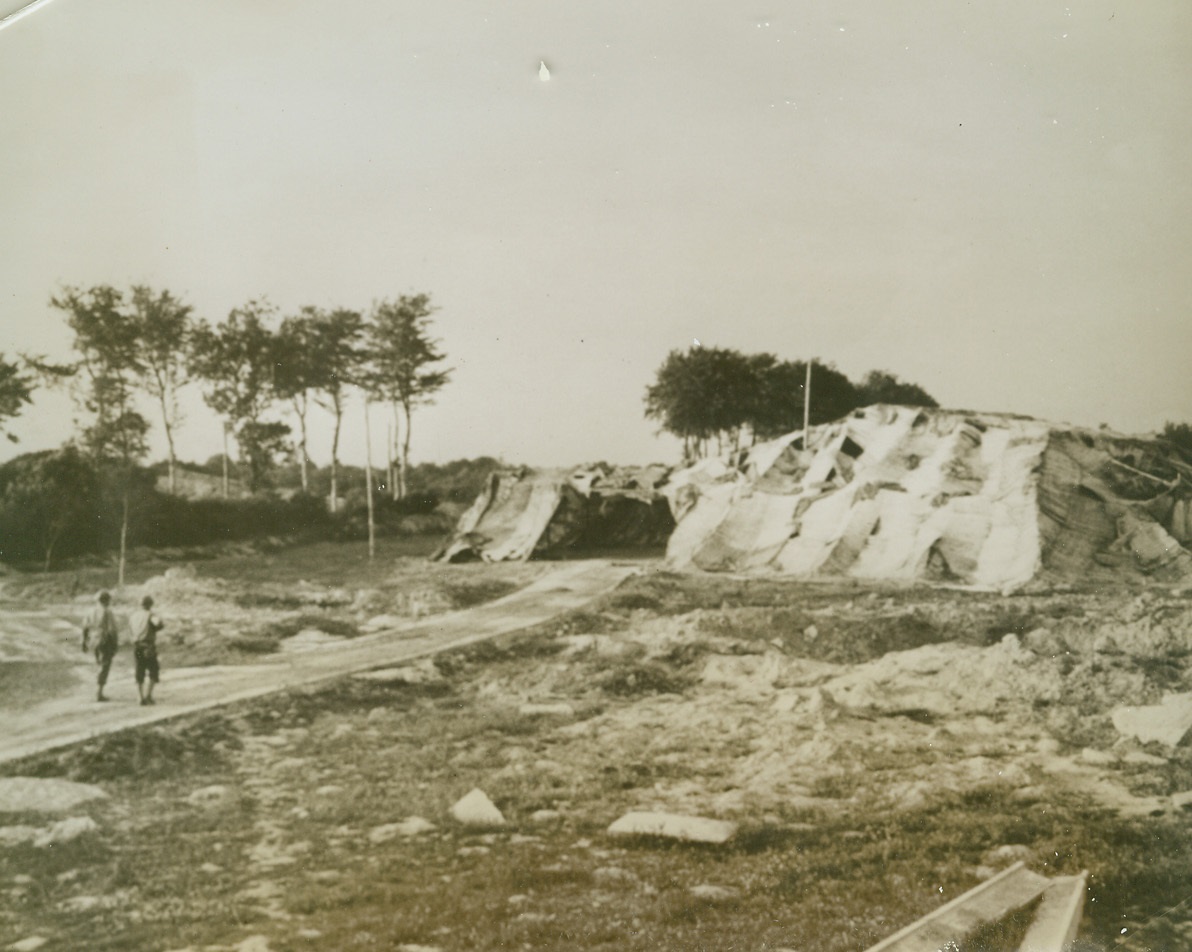
“Flying Bomb” Site Captured by Allies, 7/2/1944. Delassy, France – Chosen by the Nazis as a good spot from which to launch rocket bombs, this flying bomb site was captured by the Yanks during the Normandy assault. Two Yanks walk toward the heavily camouflaged control house in background. Credit: ACME;
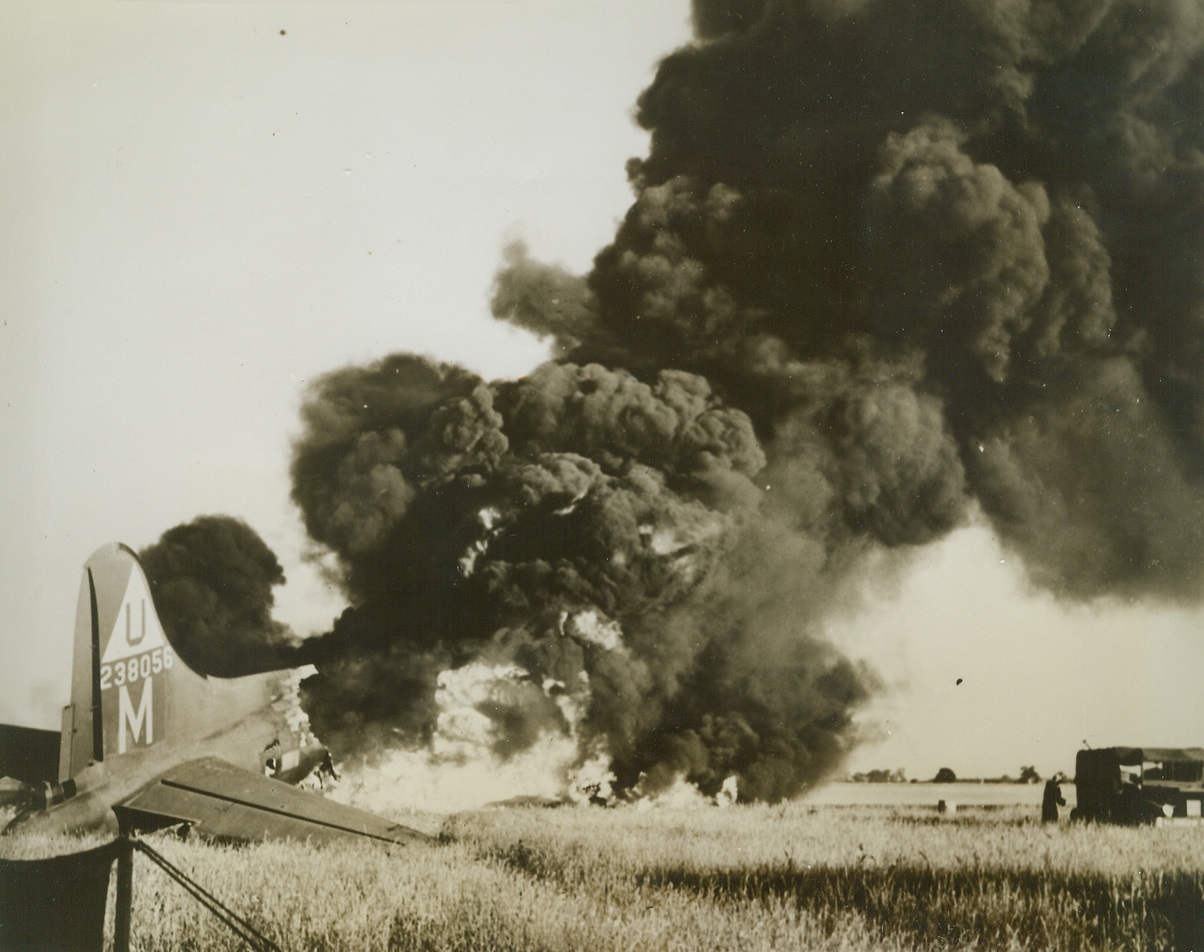
Plane Crashes on Return From Mission, 7/10/1944. A B-17 Flying Fortress of the US 8th Air Force, returning from a mission over Roeun, France, with its brakes shot out, crashed into another B-17 parked near the end of the runway. Fire immediately broke out, engulfing both planes, but the crew miraculously escaped injury. Credit: Air Force photo from ACME. Radiotelephoto;
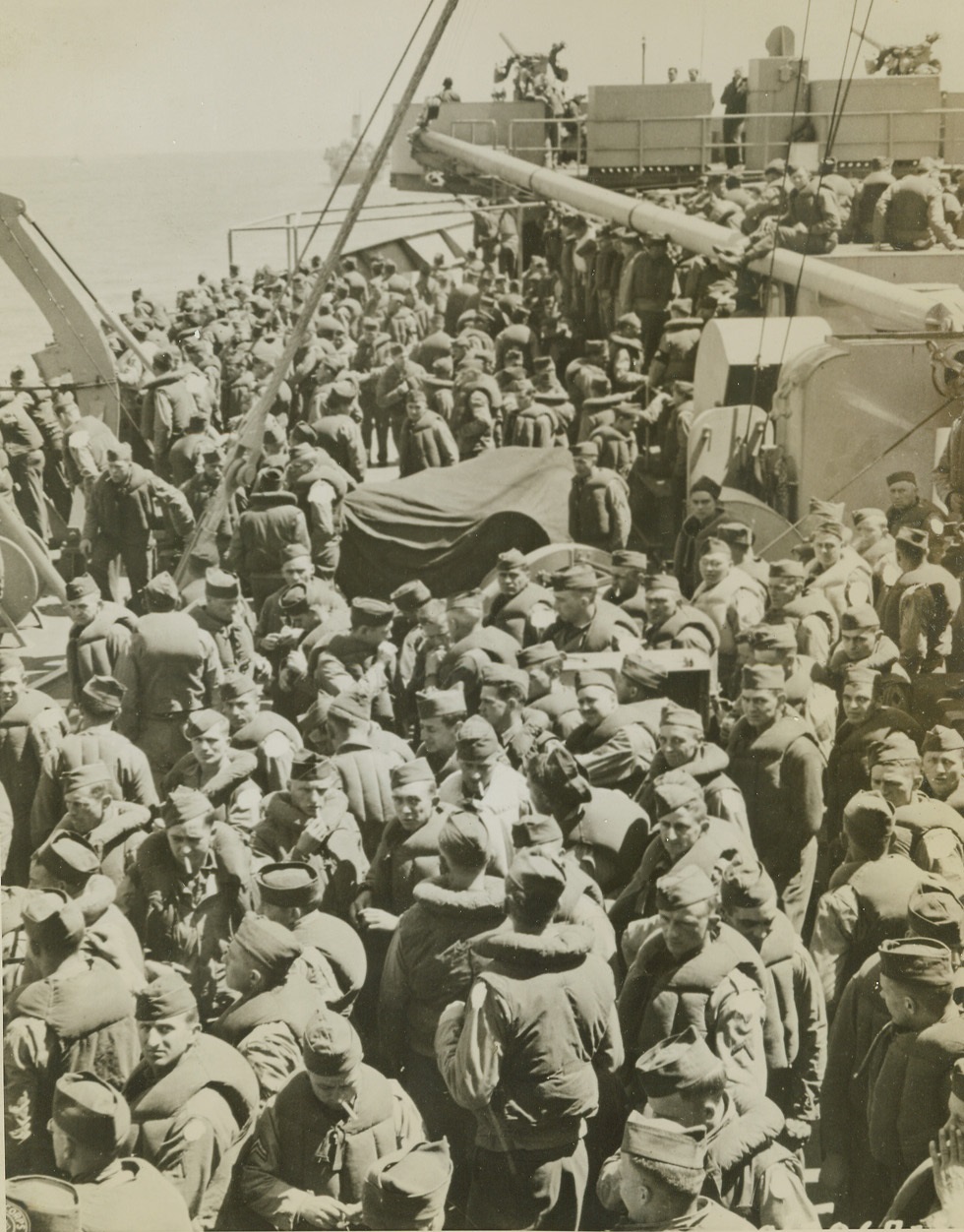
They’re Going Over, 7/17/1944. En Route to France—Bundled up in puffy life jackets and crowding together on the deck of an Allied vessel taking them to the coast of France, American infantrymen smoke and chat about the adventure before them. They’ll reinforce Yank troops now chasing Jerry back across the fields of France. Credit: Signal Corps Photo from ACME.;
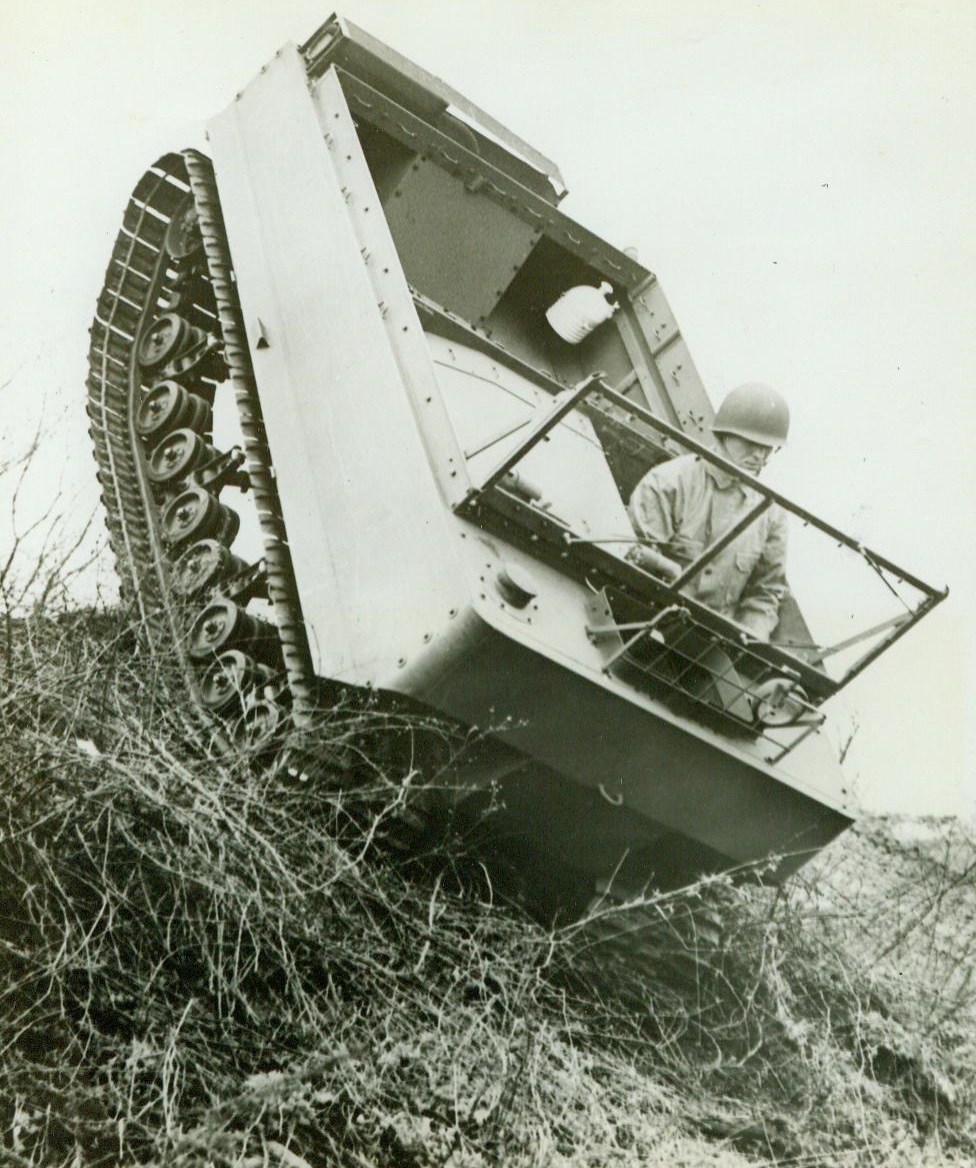
Weasel Joins the Army Parade, 7/3/1944. SOUTH BEND, IND. - In secret production for two years at the Studebaker Automobile Factory in South Bend, Ind., a radical war vehicle is shown for the first time by the Army. Known as the "Weasel" (official name is M-29) it is a low-slung, square-faced personnel and supply carrier, capable of operating over snow, deep mud, sand or on paved highways, a greater variety of terrain conditions than possible in any other previous vehicle. The Weasel's light weight combined with broad rubber-padded tracks allow for high speeds on any ground condition. Pressure on the ground exerted by the Weasel is about One-Fourth that of a fully equipped infantryman. The Weasel, minus its camoflage and canvas curtain top for summer use, negotiates a steep grade with ease.;
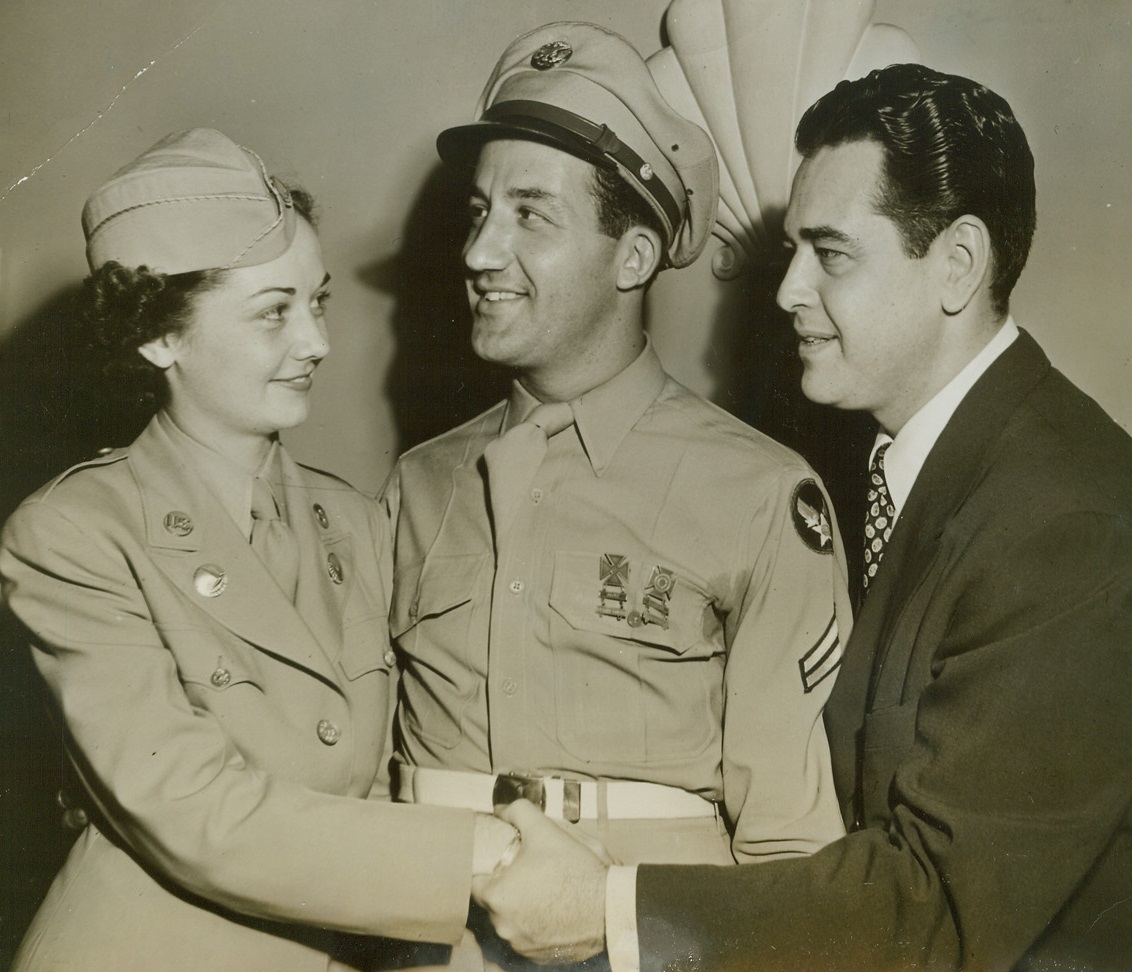
ATC’S COVER GIRL, 7/15/1944. NEW YORK—Pvt. Lucille Berman (left), of the Ferrying Division, Love Field, Dallas, Tex., has been acclaimed Typical WAC by the Air Transport Command. The contest was judged solely by Harry Conover (right) who chose the winner from letters written by various soldiers describing the virtues of their candidate. Cpl. Bernie Berman, Jacksonville, Fla., who wrote the winning letter, married Pvt. Berman three days after she was announced the winner. Pvt. Berman was given official tribute at the Conover Model Agency today (July 15). Credit (ACME);
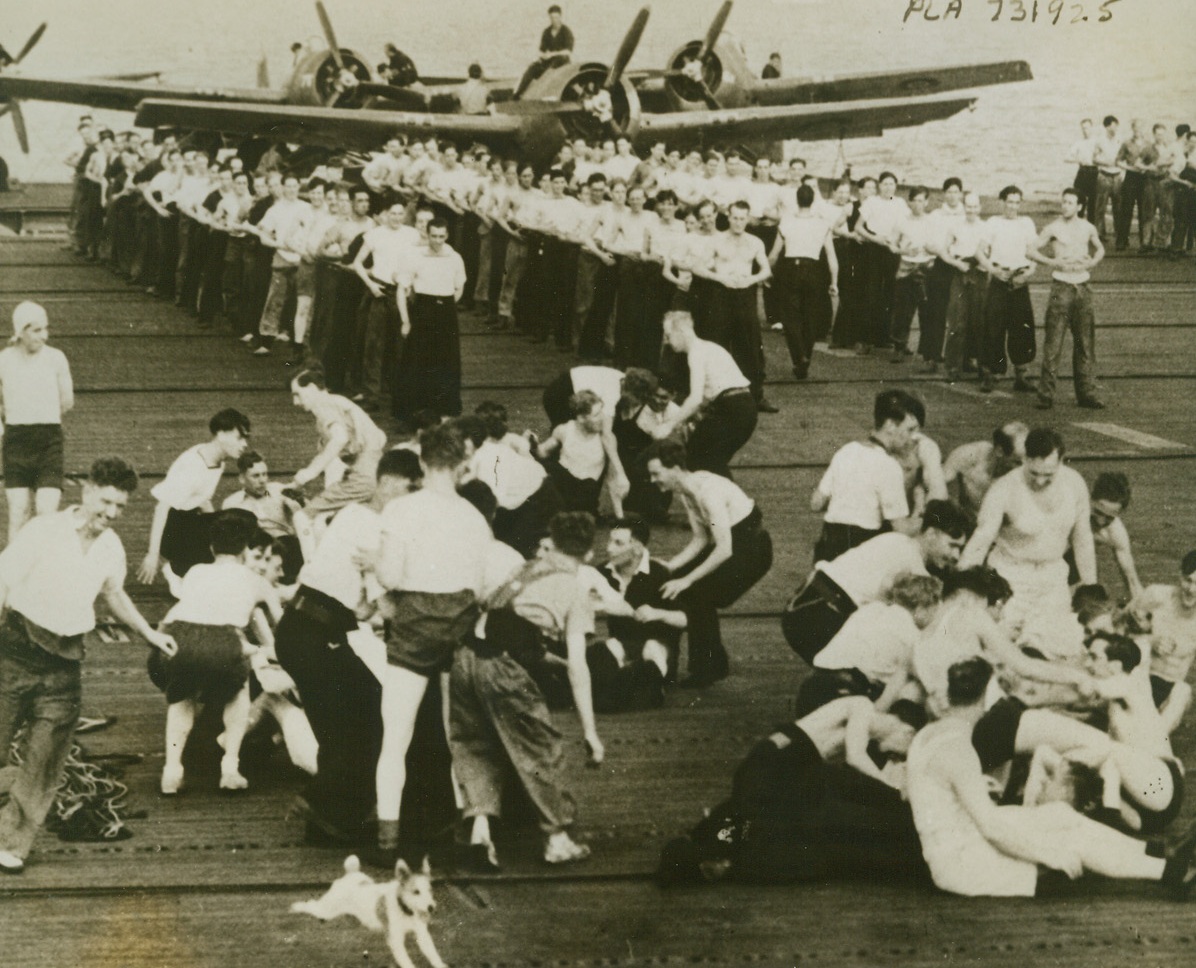
Just a Friendly Tussle, 7/28/1944. The crew of the British Escort Carrier HMS Searcher keep in physical trim by staging a free-for-all tussle on the ship’s flight deck. “Able Dog Spud”, the ship’s mascot, (foreground) flees from the mad scramble, while the rest of the crew (background) awaits its turn. Credit: British official photo from ACME;
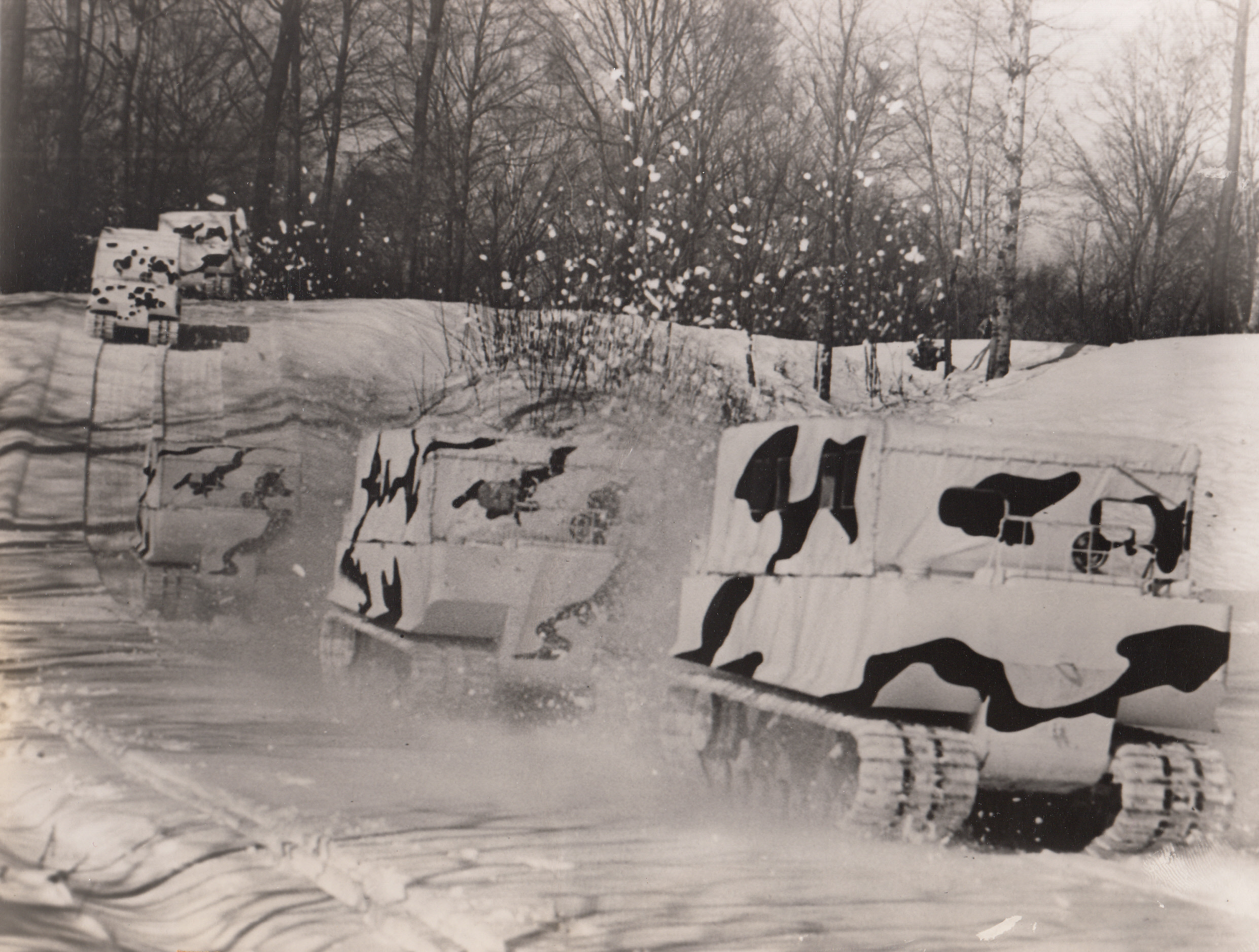
Weasel Joins the Army Parade, 7/3/1944. South Bend, Indiana -- In secret production for two years at the Studebaker automobile factory in South Bend, Indiana, a radical war vehicle is shown for the first time by the army. Known as the “Weasel” (official name is M-29), it is a low-slung, square-faced personnel and supply carrier, capable of operating over snow, deep mud, sand or on paved highways, a greater variety of terrain conditions than possible in any other previous vehicle. The Weasel’s light weight combined with broad rubber-padded tracks allows for high speeds on any ground condition. Pressure on the ground exerted by the Weasel is about one-fourth that of a fully-equipped infantryman. In winter, over snow-packed ground and camouflaged in weird black and white pattern, the Weasel fairly skims along the surface likes its animal namesake.;
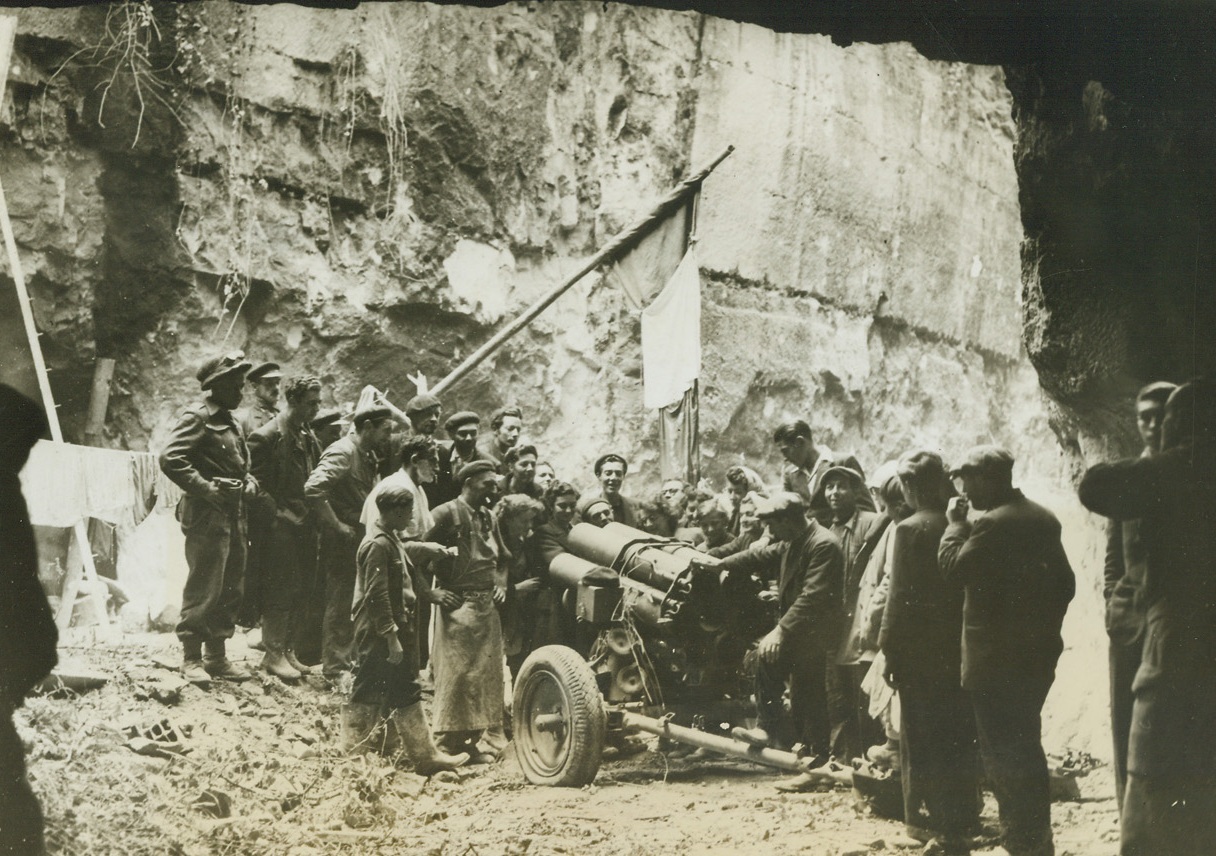
“MOANING MINNIE” IS KAPUT, 7/26/1944. FLEURY-SUR-ORNE: Patriots raise their French flag over a six-barrelled German mortar, which was called “moaning Minnie” and which had been posted at the mouth of a cave near here. The cave had also been used by the Germans for storing ammunition, and for the last six weeks had been used as a shelter for 900 people of the village. Credit: Acme;
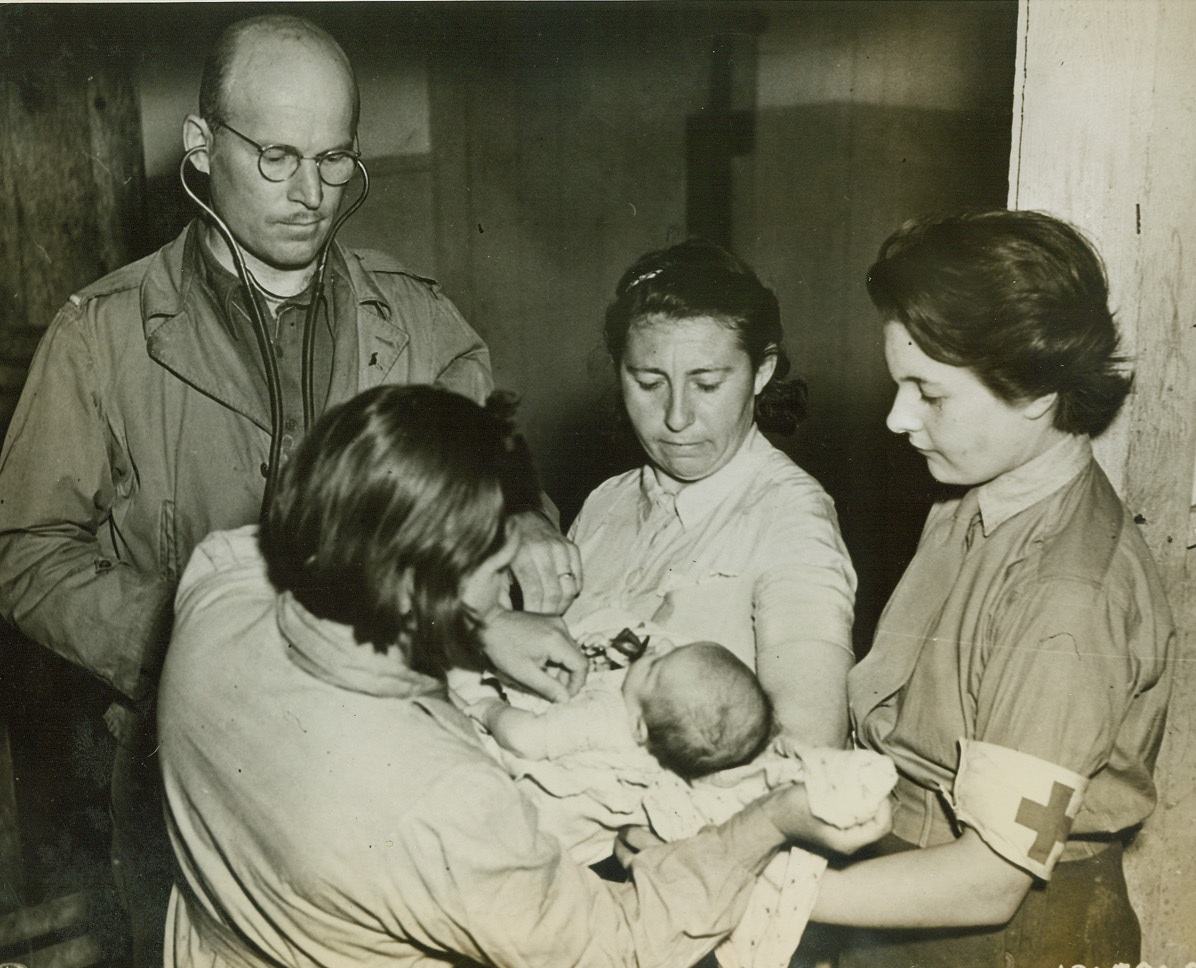
MEDICAL AID FOR FRENCH BABY, 7/25/1944. FONTENAY-SUR-MER, FRANCE – Lt. Samuel J. Ravitch, of Quincy, Fla., U.S. Army medical officer with a civil affairs unit, examines a French baby. Helping him, are (facing camera): Eugenia Fuchs (center), former surgeon with the Russian forces at Leningrad, who was captured by the Germans and forced to care for TODT organization workers; and Louise Portman, a Swiss girl, member of the medical corps of the Free French Army.Credit: U.S. Army photo from Acme;
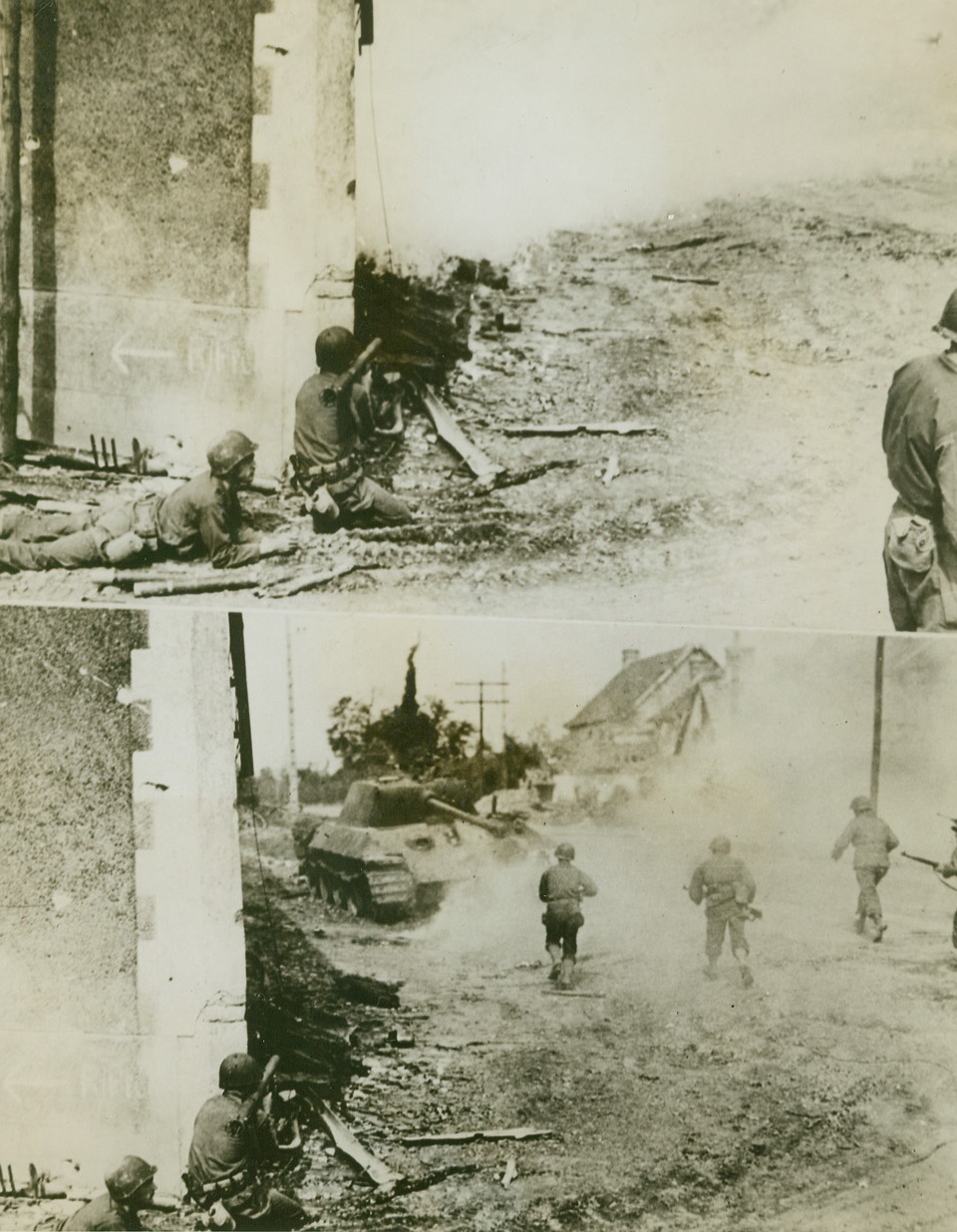
BAZOOKA KNOCKS OUT NAZI TANK, 7/30/1944. NORMANDY, FRANCE—This dramatic photo series shows the destruction of a Nazi tank that had blocked the advance of our forces through a Normandy village. At top, Bazooka gunners have just fired their projectile, which explodes and envelopes the tank in smoke and flames. In the bottom photo a detachment of infantrymen, under Sgt. James F. Kelly, Boston, Mass., push toward the battered tank to care for any possible survivors from the tank’s crew. Credit (ACME);
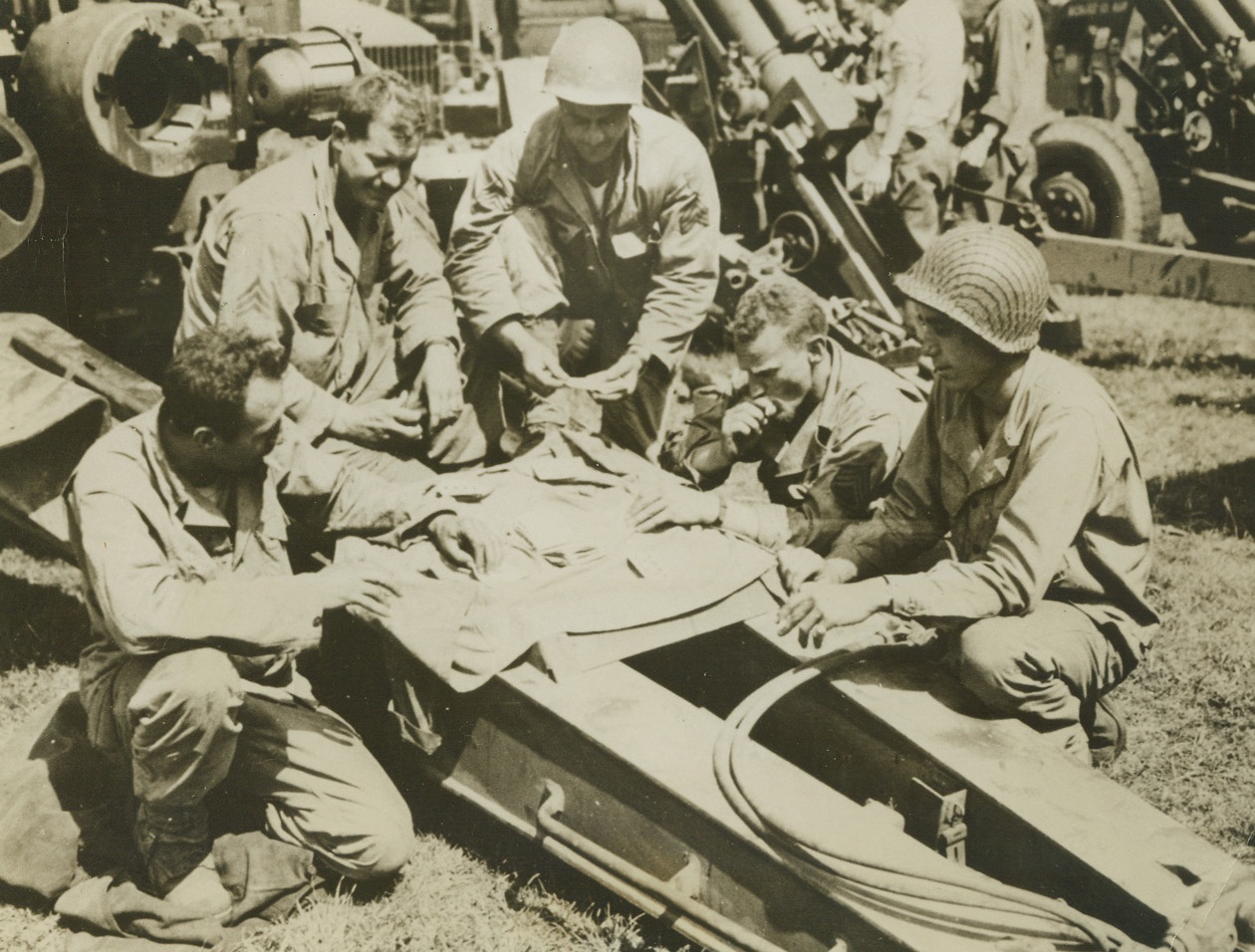
PROTECTION AND POKER, 7/29/1944. FRANCE—In an off-duty moment at a base in Normandy, card players take extra special precautions against Nazi kibitzers. Intent on their cards are (left to right): Sgt. Louis Rossi, Brooklyn, N.Y.; Sgt. Joseph Grillo, Brooklyn, N.Y.; S/Sgt. Edward Kamalsi, Detroit, Mich.; and Sgt. Edward Bearden of Waco, Tex. Credit Line (ACME);
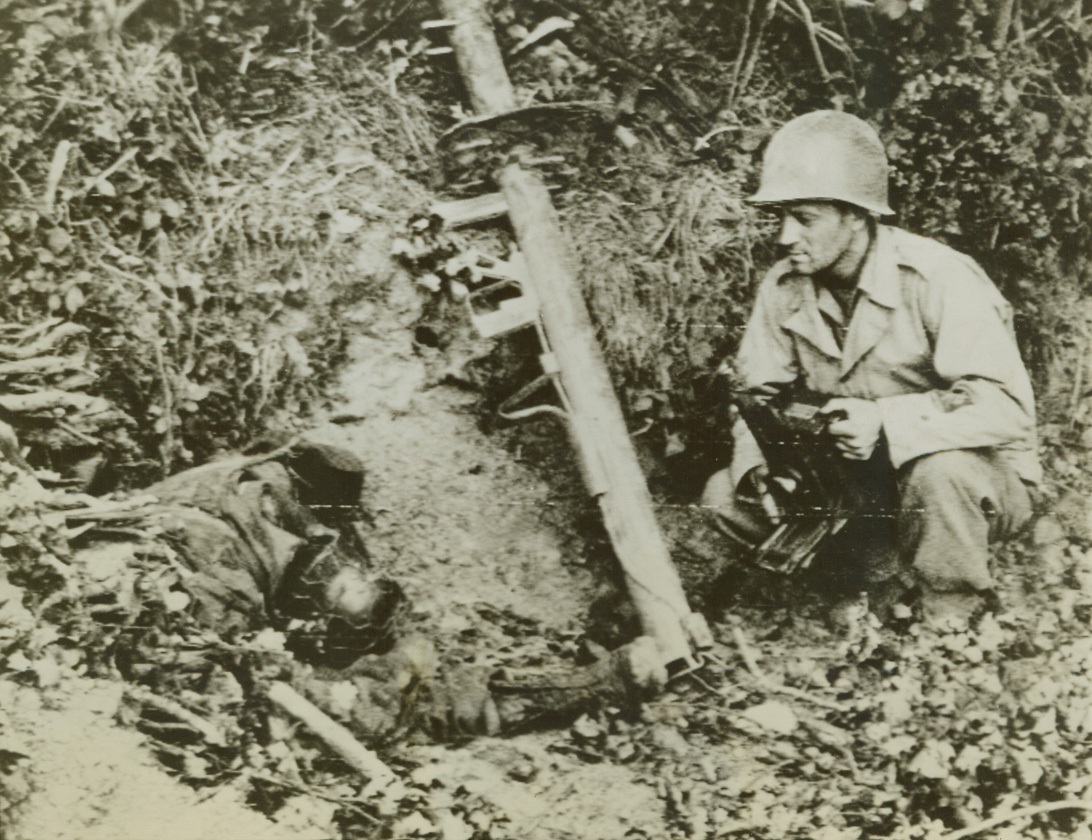
Title Covered, 7/29/1944. FRANCE—Sprawled by his weapon, a Nazi bazooka gunner lies dead, a victim of the terrific allied aerial and artillery attack in the Marigny area of France. A U.S. Signal Corps photographer, camera in hand, looks over the gunner and the weapon which will no longer toss shells at American tanks. Credit (Signal Corps Radiotelephoto from ACME);
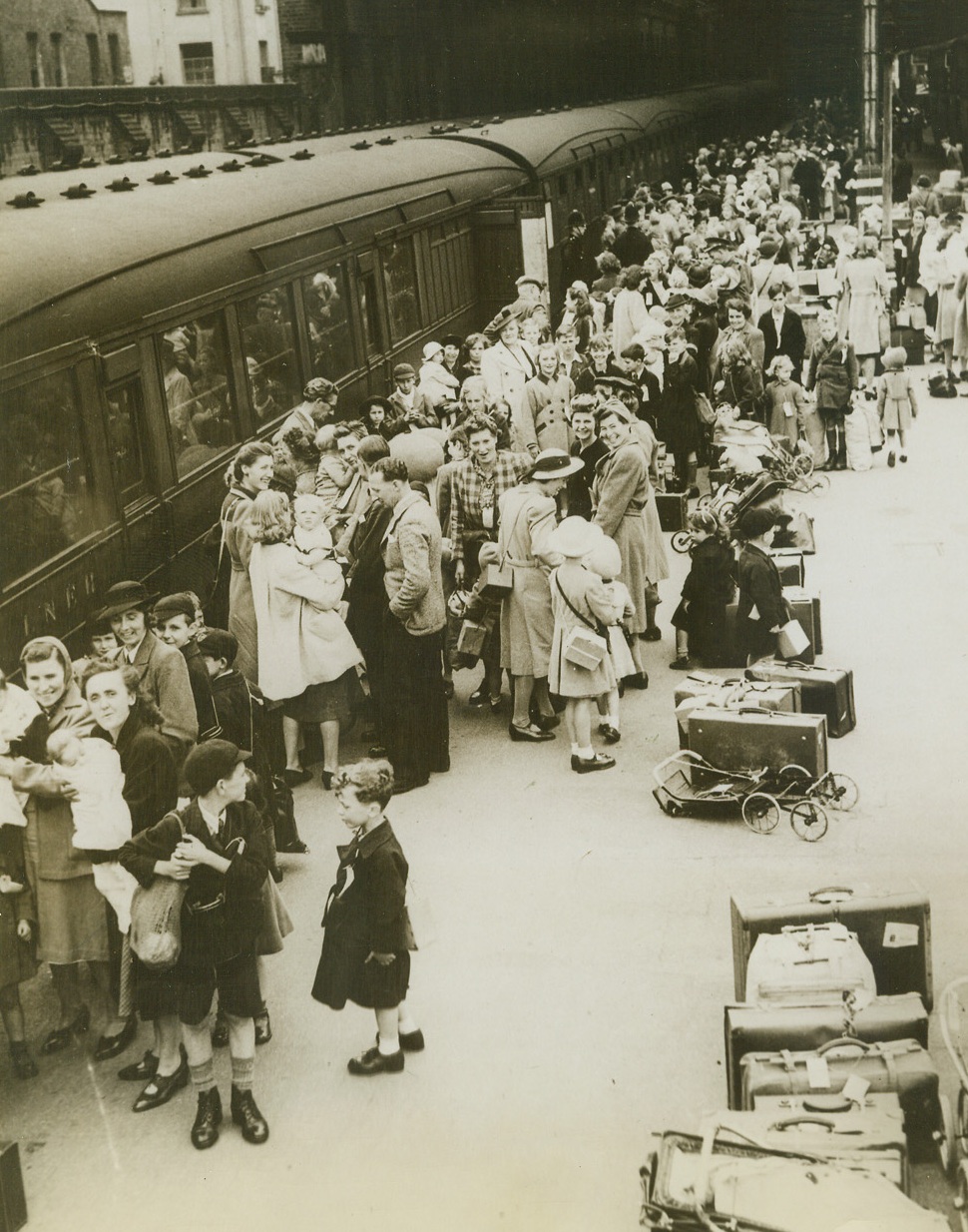
ROBOT BLAST STRIPS TREE, 7/18/1944. ENGLAND—The explosion of a German Robot flying bomb wrecked the front of this building and stripped the leaves from this tree near London. Bits of clothing from the house are draped on the limbs of the tree as a result of the blast. Credit Line (ACME);
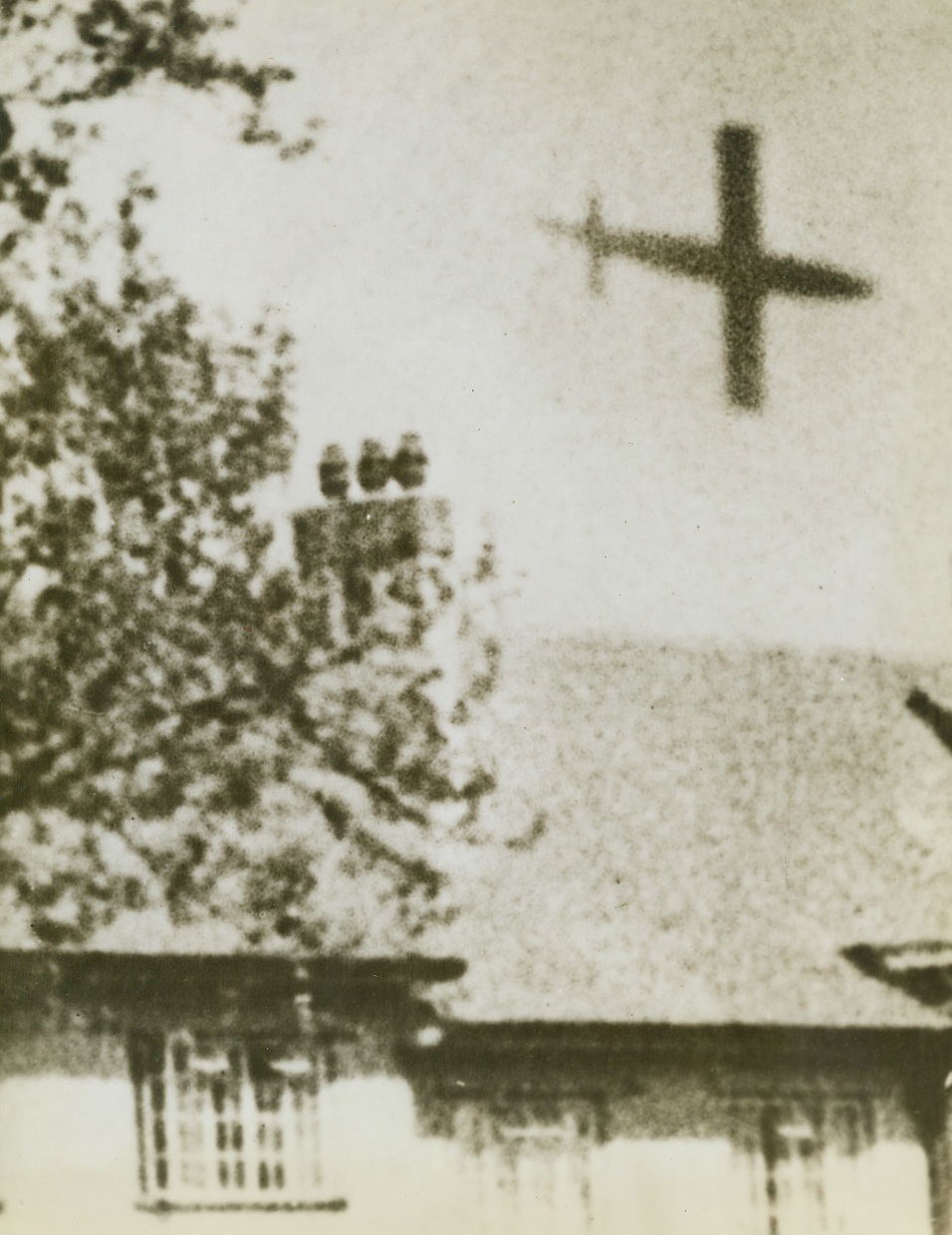
ROBOT HEADS FOR TARGET, 7/18/1944. ENGLAND—A German robot flying bomb about to crash behind a row of small houses in Southern England. Credit Line (ACME);
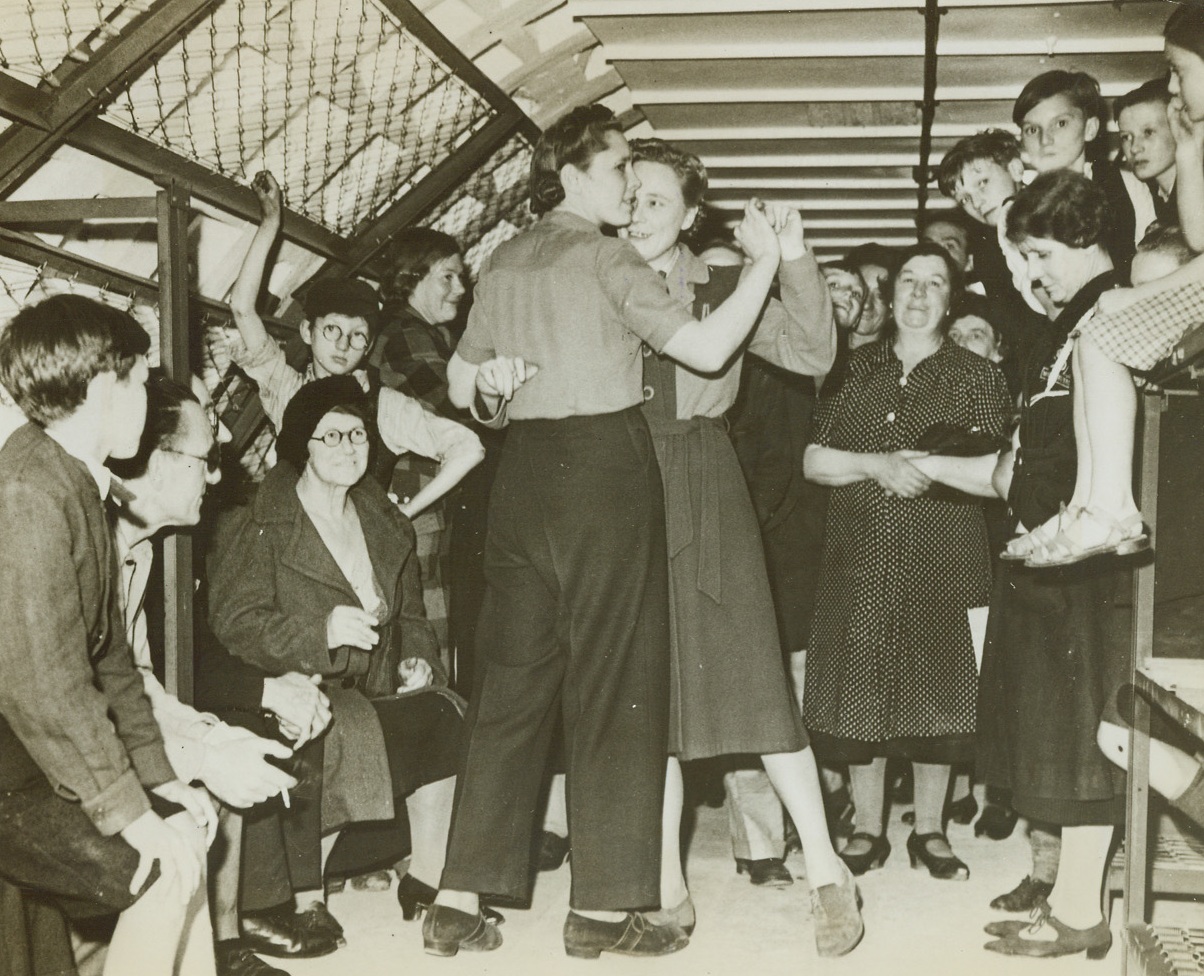
NEW DEEP SHELTER AGAINST “BUZZ-BOMBS”, 7/27/1944. LONDON, ENG—To allow Londoners protection and to give them some opportunity to sleep while the city is under bombardment by German Robot “Buzz Bombs,” the first of a series of deep shelters has been opened. These new shelters consist of two main twin tunnels running beneath existing tube railway (subway) lines. They are divided into 6 sections each fitted with bunks for 500 persons. Cross-passages connecting the two tubes contain first aid posts, lavatories and machinery control rooms. Bunks fold against the walls when not in use to allow free passage of traffic. Four canteens are provided at suitable points, run by volunteer organizations. The shelters are controlled and administered by commissioners for the London civil defense region. Each shelter is in charge of a shelter superintendent, with a nucleus staff of fulltime wardens supplemented by volunteer wardens. New York Bureau In one of the shelters, Londoners enjoy a bit of recreation, dancing before retiring for the night. Credit Line (ACME);
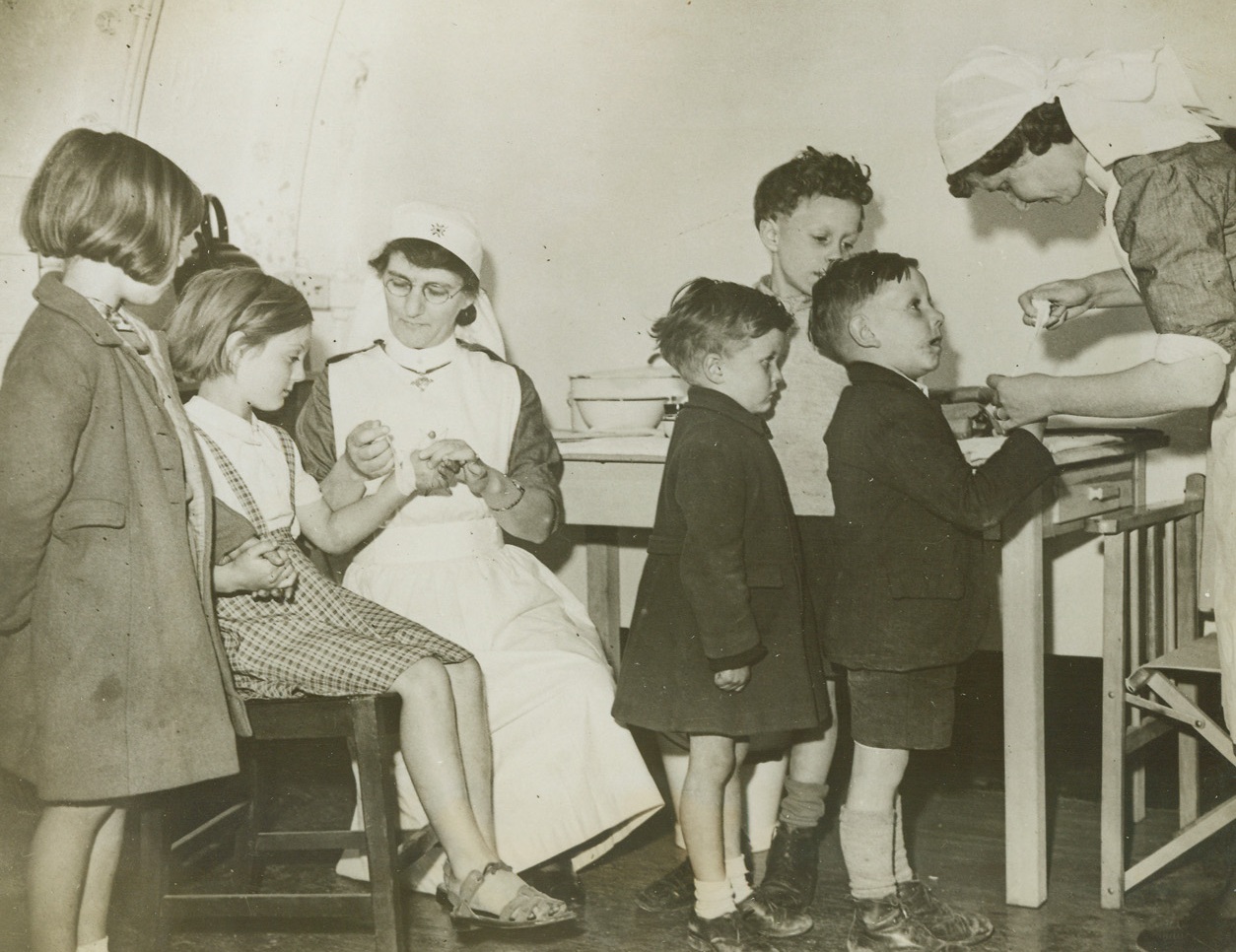
New Deep Shelter Against "Buzz-Bombs", 7/27/1944. LONDON, ENG—To allow Londoners protection and to give them some opportunity to sleep while the city is under bombardment by German Robot “Buzz Bombs,” the first of a series of deep shelters has been opened. These new shelters consist of two main twin tunnels running beneath existing tube railway (subway) lines. They are divided into 6 sections each fitted with bunks for 500 persons. Cross-passages connecting the two tubes contain first aid posts, lavatories and machinery control rooms. Bunks fold against the walls when not in use to allow free passage of traffic. Four canteens are provided at suitable points, run by volunteer organizations. The shelters are controlled and administered by commissioners for the London civil defense region. Each shelter is in charge of a shelter superintendent, with a nucleus staff of fulltime wardens supplemented by volunteer wardens. New York Bureau At a First Aid station, nurses take care of minor casualties. Credit Line (ACME);
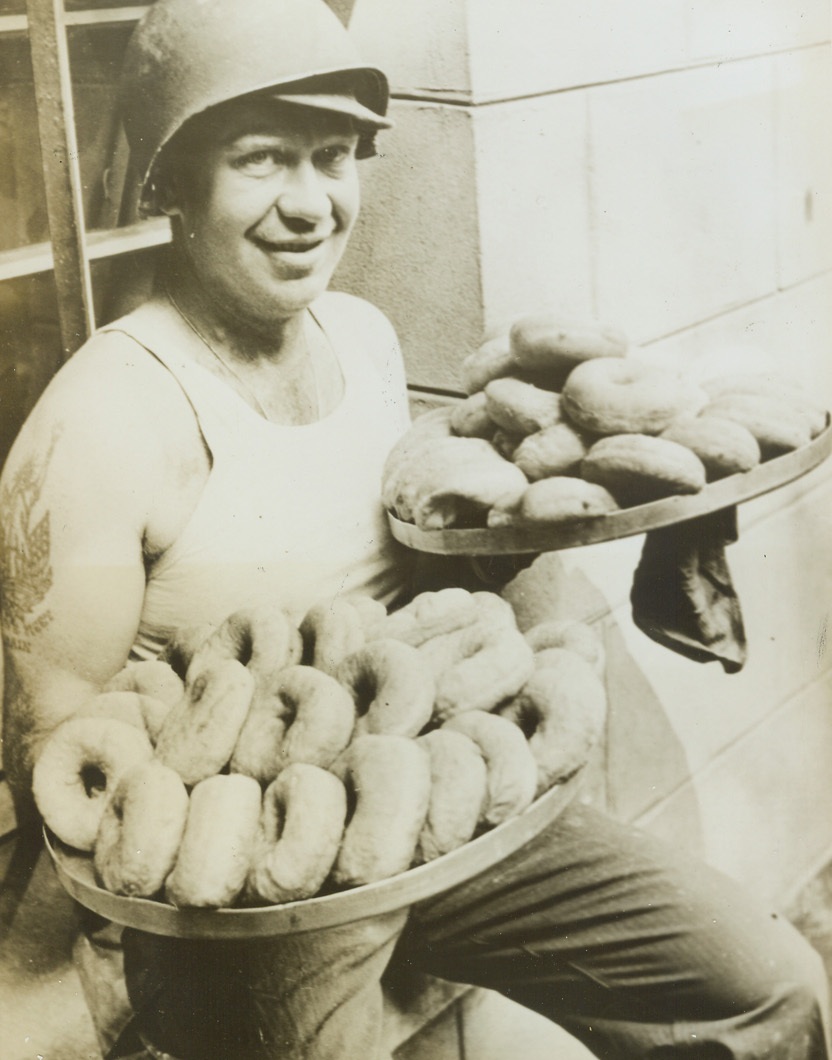
SINKERS FOR THE JAVA, 7/15/1944. LA HAYE DU PUITS, FRANCE—With a sly grin on his face and a twinkle in his eye, Pvt. Paul Taylor, Springfield, Mo., Division Artillery H.Q. mess cook, pauses enroute with a surprise for the ever-hungry Yank forces in his division. His peculiar knack with a few simple ingredients has produced two lovely platters of raised doughnuts, and with a little java, the boys have a great treat in store for them. Credit (ACME) (WP);
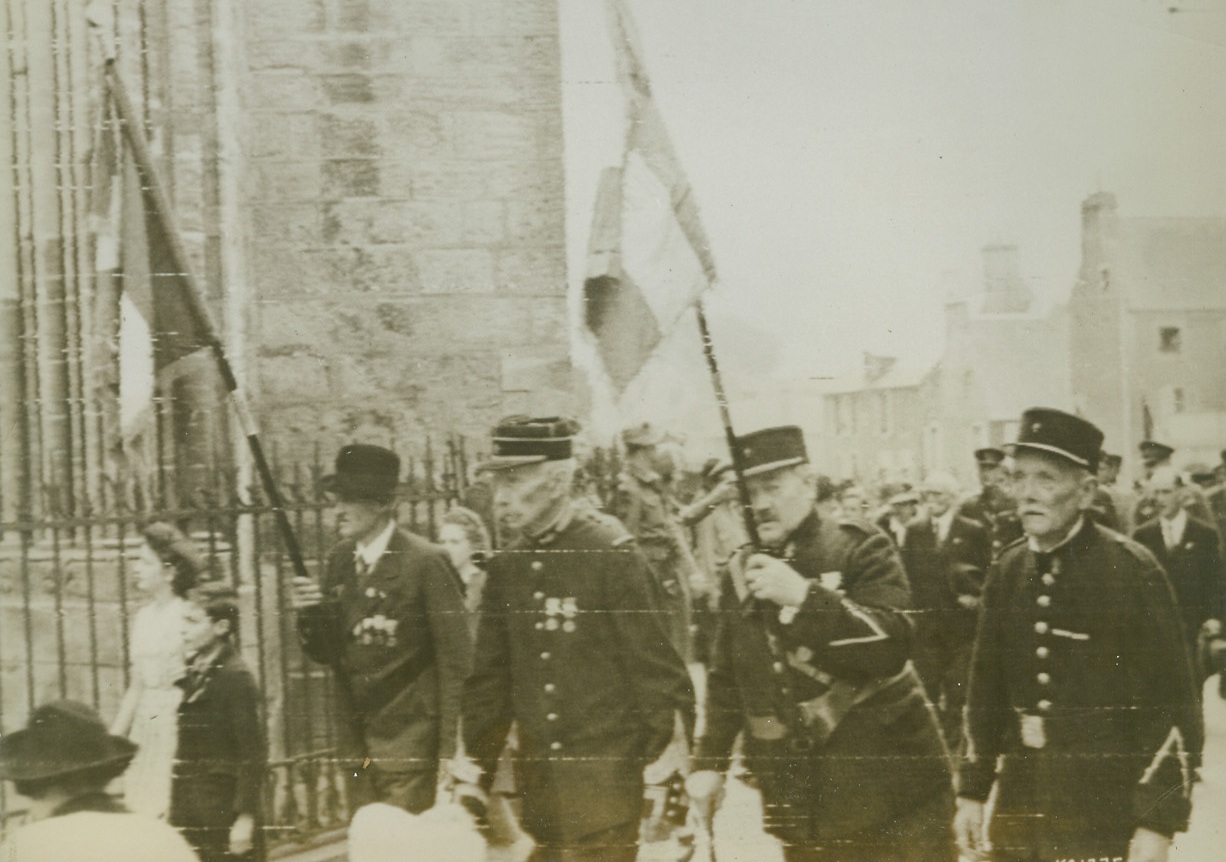
FRENCH ARMY VETS FETE BASTILLE DAY, 7/15/1944. FRANCE—Proudly carrying the tricolor of France, these French Army veterans march through a street in Bayeux, France, during Bastille Day celebrations. British troops in the French town joined in the festivities which symbolize the triumph of freedom for the peoples of the world. Credit (Signal Corps Radiotelephoto from ACME);
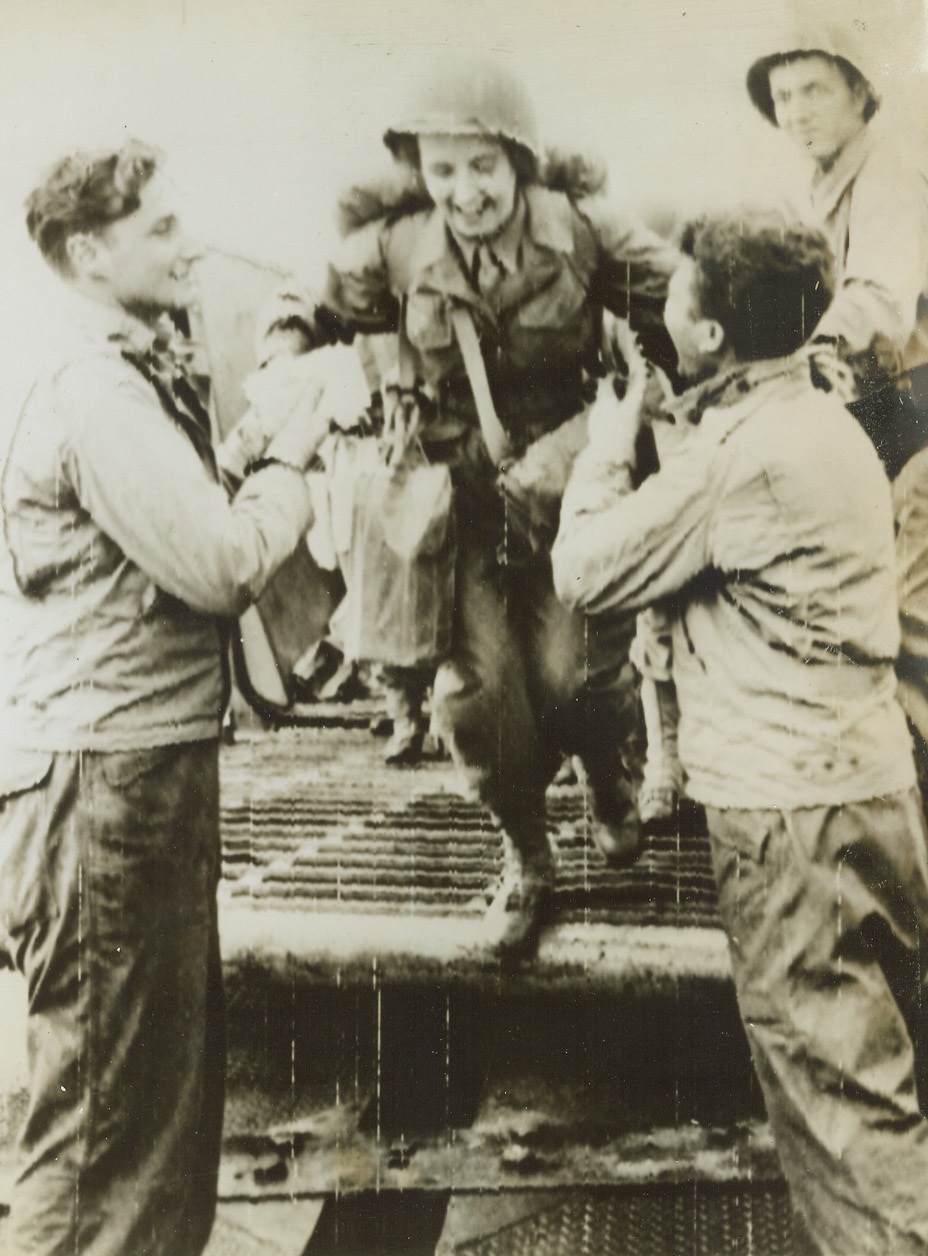
WACS ARRIVE IN FRANCE, 7/18/1944. FRANCE—Grinning G.I.’s willingly assist some of the first US WACS to land in France. Note the soldier on the left still clutching mail in his hand. Credit (US Army Radiotelephoto from ACME);
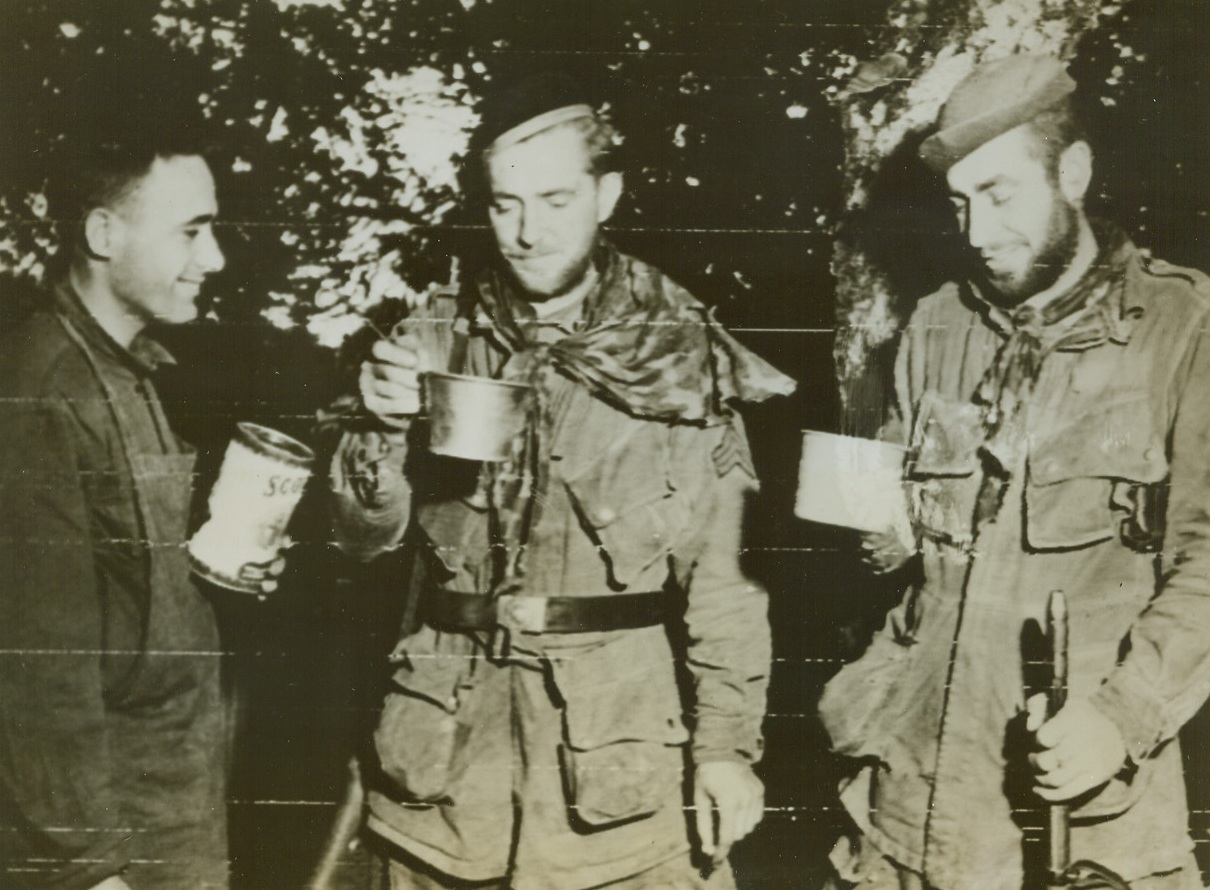
END OF 37 FOODLESS DAYS, 7/18/1944. FRANCE—Pvt. John C. Rodrigues, Pawtucket, R.I. (left), gives paratroopers Sgt. R.D. Henderson, Seattle, Wash., and Sgt. H.W. Lazenby, Nashville, Tenn., (right) their first food in 37 days after their capture by Germans on D-Day. The ‘troopers escaped and made their way back to Yank lines. Credit (US Army Radiotelephoto from ACME);
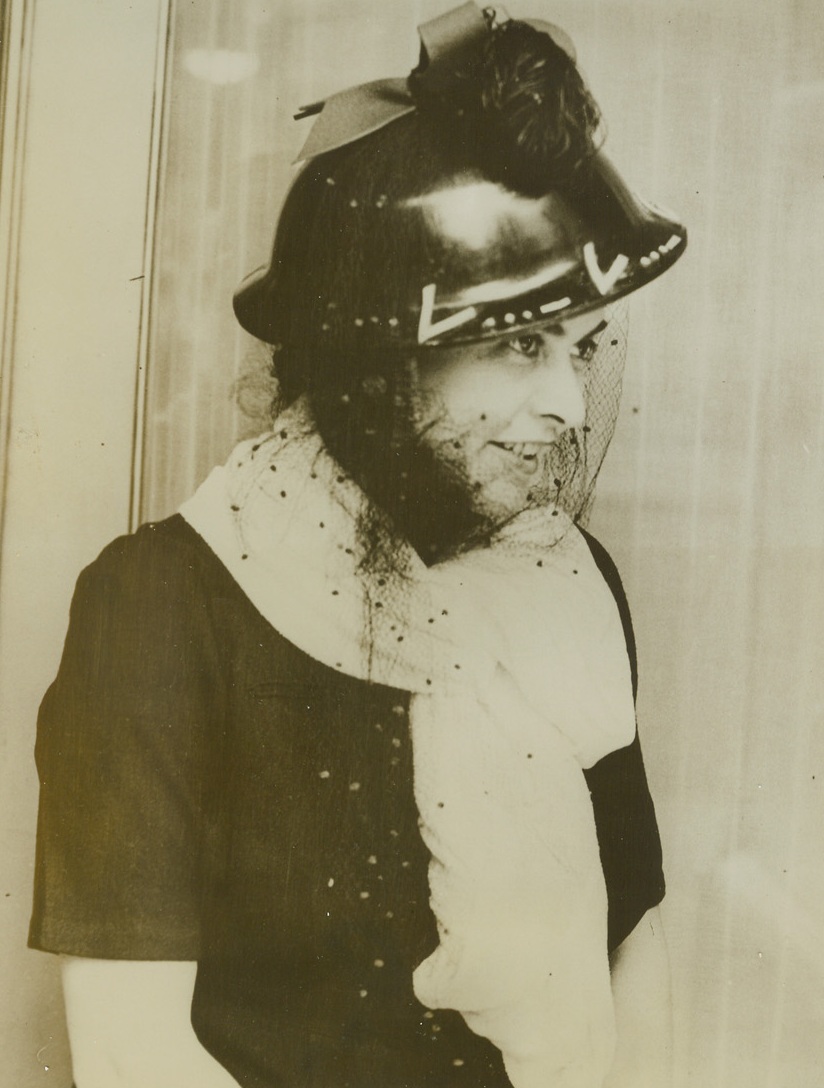
NEWEST THING IN AIR RAID MILLINERY, 7/15/1944. LONDON, ENG.—Ingenuous English milliners have come forth with this new be-ribboned, be-ruffled, and be-feathered version of the tin helmet. Designed to be worn during air raids by England’s fashionable, it features felt V’s and morse V-signs around the brim and a wealth of red-dotted black veiling which ties coyly under the chin. The whole concoction is topped by a large bow with a curled feather. Milady, this is truly the last word-le dernier cri! Credit (ACME);
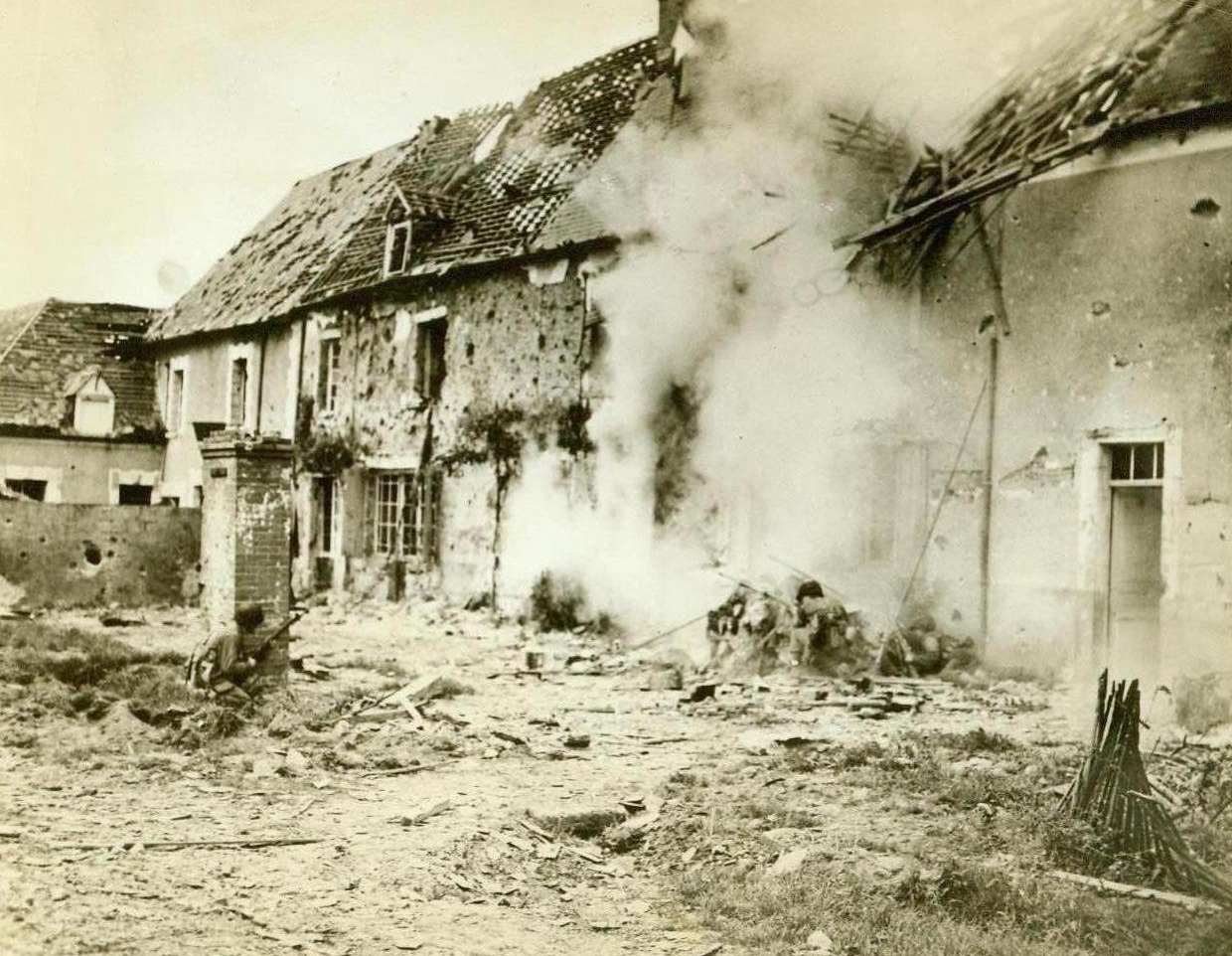
Doom For Snipers, 7/24/1944. Saintenay, France - Taking cover behind a brick pillar and a pile of rubble, American infantrymen send bullets whizzing into a snipers nest in Saintenay. Their prey hides in the bomb-ruined houses in background. Credit: ACME;
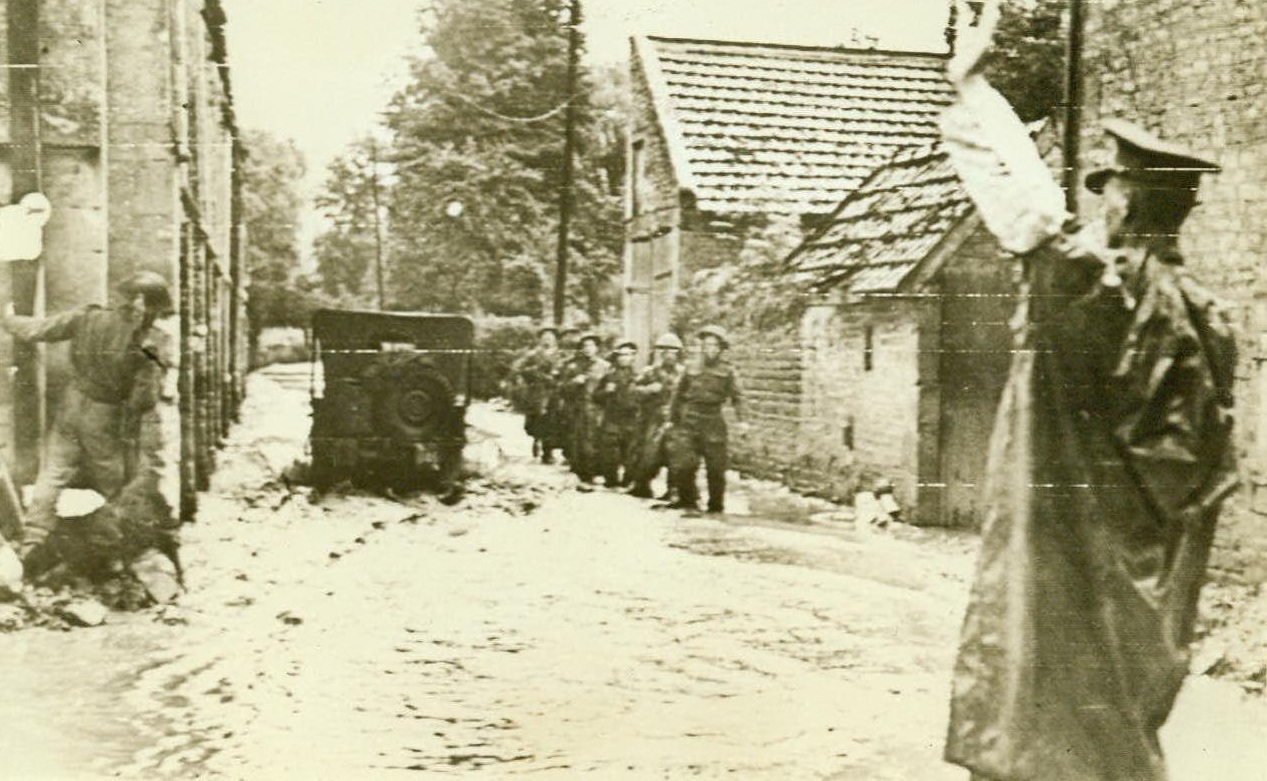
And The Rains Came, 7/24/1944. Normandy, France - Battling the Germans in the area around Caen, British troops had to combat heavy rains as well as enemy fire. Here British Tommies advance through a small village, marching knee-deep in water while their vehicles bog down in the mud. Credit: US Army Radiotelephoto from ACME;
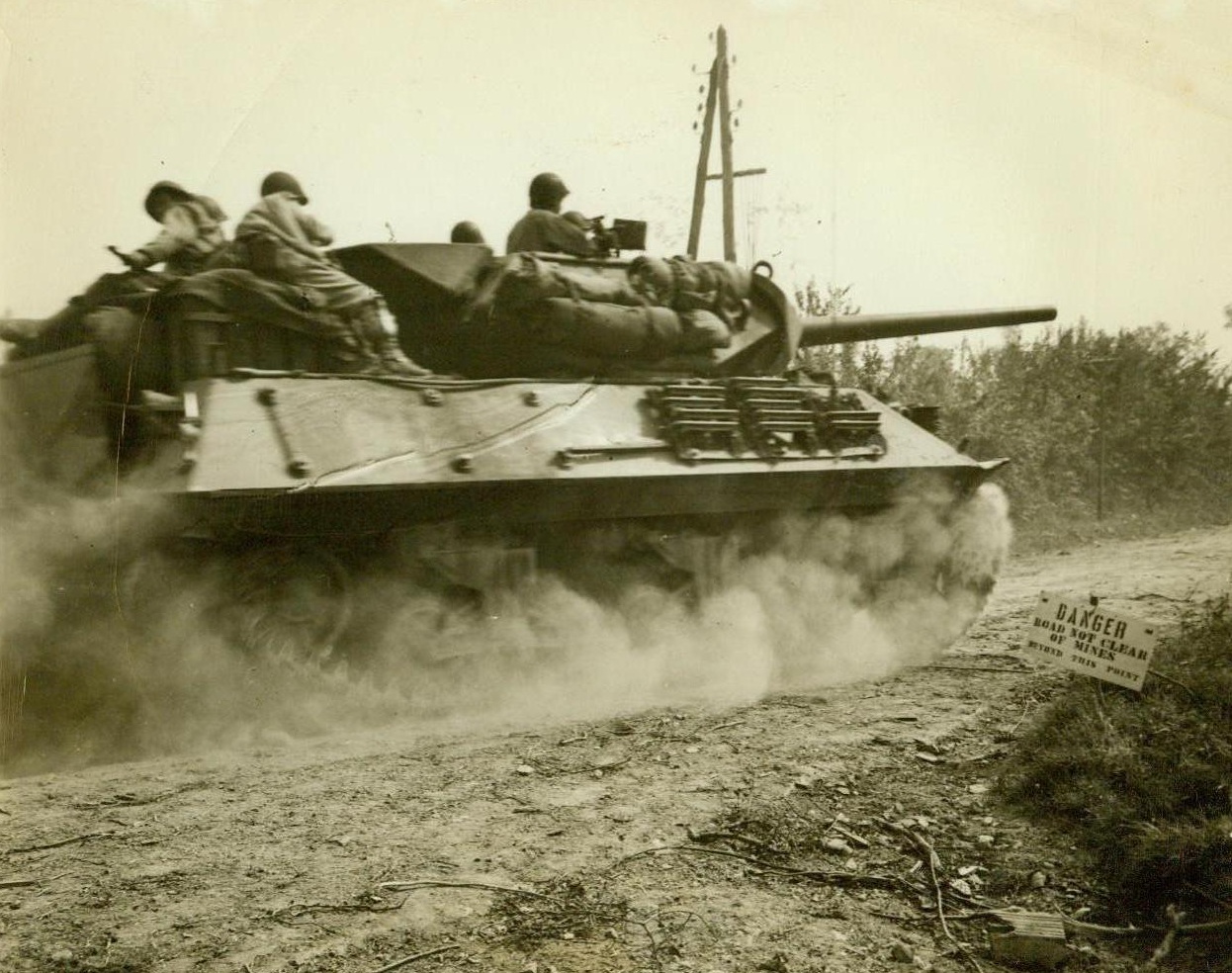
Moving Up For The Kill, 7/24/1944. St. Lo, France - An American Heavy Tank, loaded with Infantrymen, sweeps into the outskirts of St. Lo for the final attack on the town. Note sign on roadside at right: “Danger, Road Not Clear of Mines Beyond This Point.” Credit: ACME photo by Andrew Lopez, War Pool Correspondent;
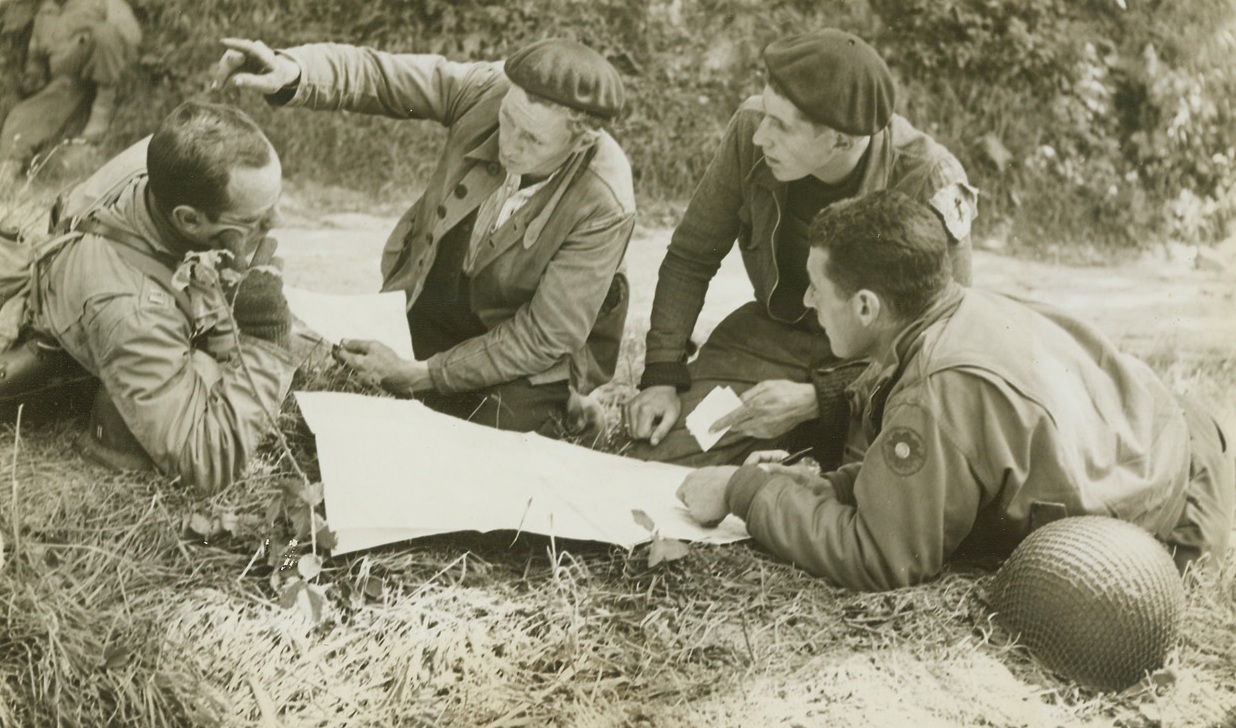
The Underground Has Its Day, 7/17/1944. Normandy – After four long years of fearless resistance to the Nazi oppressors of France, the French Underground today is gradually emerging from hiding to fight the last lap of its battle for freedom. Gleaning vital information about German fortifications, the patriots try to establish contact with Allied forces moving through Normandy. They come in small groups of two and three, bringing their useful news to Allied commanders, sometimes revealing enough Nazi secrets to shorten our battle by days, even weeks. In these first photos of patriots joining hands with Yank forces, two Frenchmen make their report at American Headquarters near Cherbourg, before that city fell to the Yanks. One aged 18, and the other aged 27, the patriots had spent a day behind German lines defending that city before making their way to American Headquarters. A map of the surrounding terrain spread out before them on the ground, the French patriots point out the exact location of German defenses in the Cherbourg area. The men also revealed information on emplacements, troop concentrations and troop movements to Lt. Carl Ruff (extreme right), of New York City, and the Captain at left. Credit: ACME photo by Bert Brandt, for the War Picture Pool;
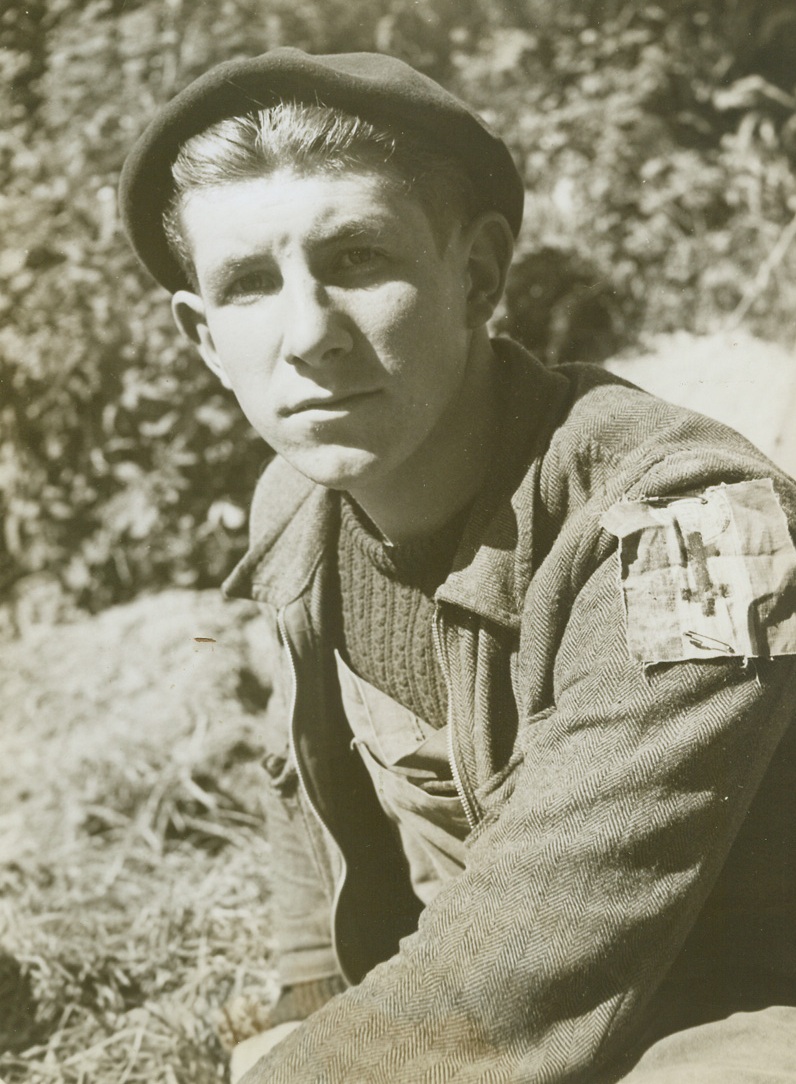
The Underground Has Its Day, 7/17/1944. Normandy – After four long years of fearless resistance to the Nazi oppressors of France, the French Underground today is gradually emerging from hiding to fight the last lap of its battle for freedom. Gleaning vital information about German fortifications, the patriots try to establish contact with Allied forces moving through Normandy. They come in small groups of two and three, bringing their useful news to Allied commanders, sometimes revealing enough Nazi secrets to shorten our battle by days, even weeks. In these first photos of patriots joining hands with Yank forces, two Frenchmen make their report at American Headquarters near Cherbourg, before that city fell to the Yanks. One aged 18, and the other aged 27, the patriots had spent a day behind German lines defending that city before making their way to American Headquarters. This is the face of a Frenchman who refused to believe that his country could be kept beneath the German heel. A mere boy of 14 when France fell, the 18-year-old had been defying Hitler’s forces for four years. He wears the Cross of Lorraine – the insignia of the French Underground – on his arm. Credit: ACME photo by Bert Brandt, for the War Picture Pool;
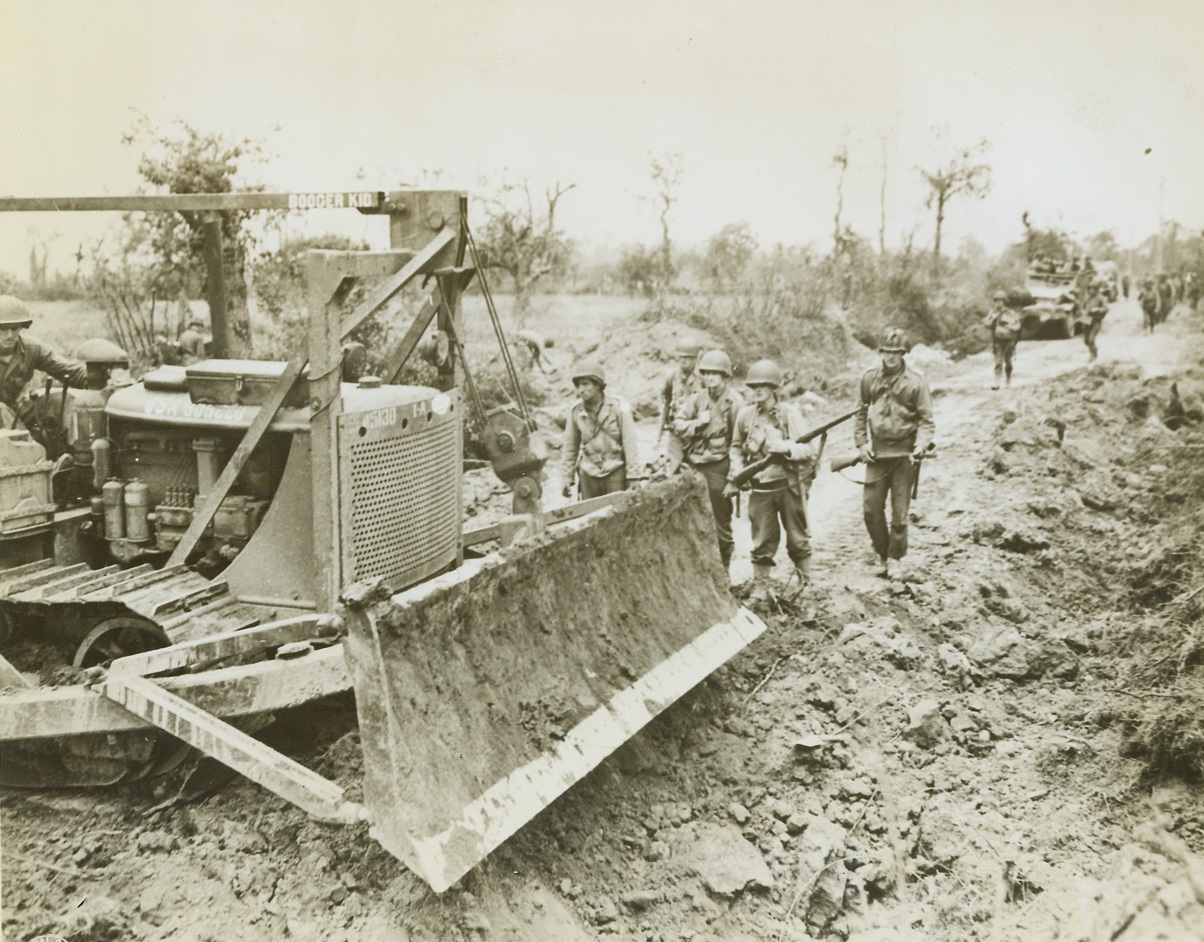
It Puts In and Takes Away, 7/29/1944. France – While trucks wait in the background, the mighty bulldozer fills in bomb craters on a road in France, to clear the way for advancing American forces. The versatile machine has also proved a great asset in clearing debris-filled streets in captured towns. Credit: Signal Corps photo from ACME;
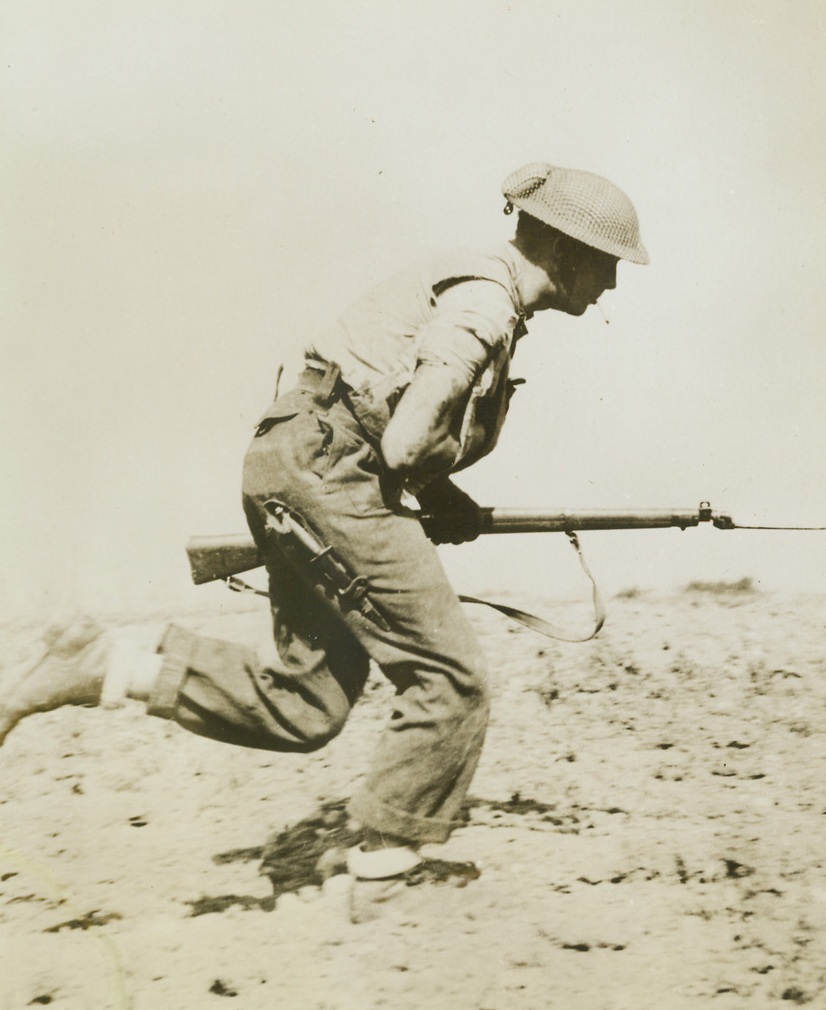
Wounded Canadian Runs To Attack, 7/28/1944. France – Wounded, his arm in a sling, and smoking a cigarette, a Canadian soldier forgets his pain as he dashes ahead to join his comrades in the attack on Colombelle. Taking of the town was part of the assault in which British and Canadian Troops stormed Caen. (Passed by Censor.) Credit: ACME;
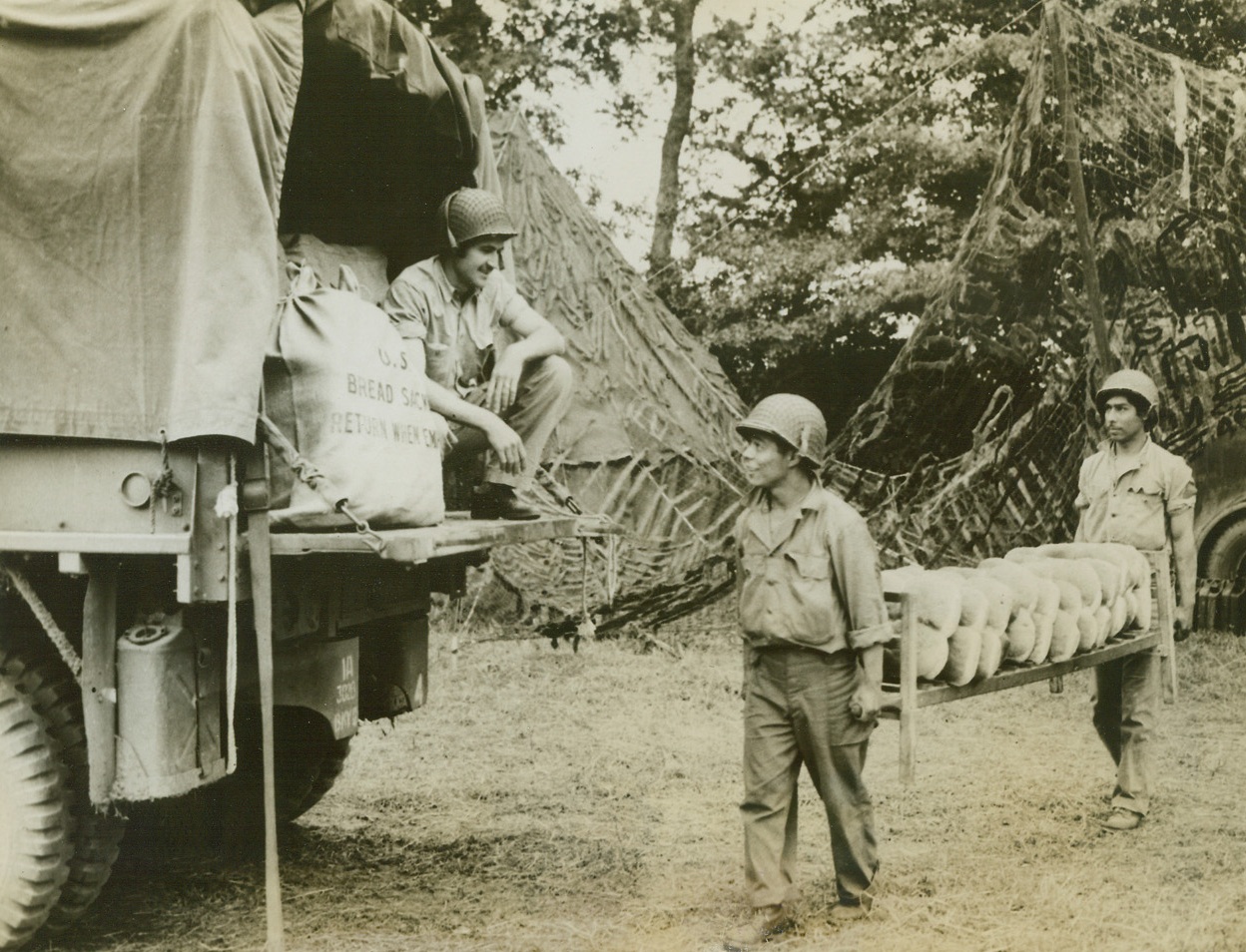
Here’s Bread For The Fighters, 7/17/1944. Somewhere in France – Beginning delivery of the Staff of Life to Yanks fighting on the Normandy front, these Texans load fresh loaves of bread on an Army truck. Pvt. Garth Gilbert of Huntington, Tex., squats on the truck as Cpl. Antonio Palacio of El Paso, and Cpl. Manuel Ricondo (in rear) of San Antonio, bring up the loaves. Credit: ACME;
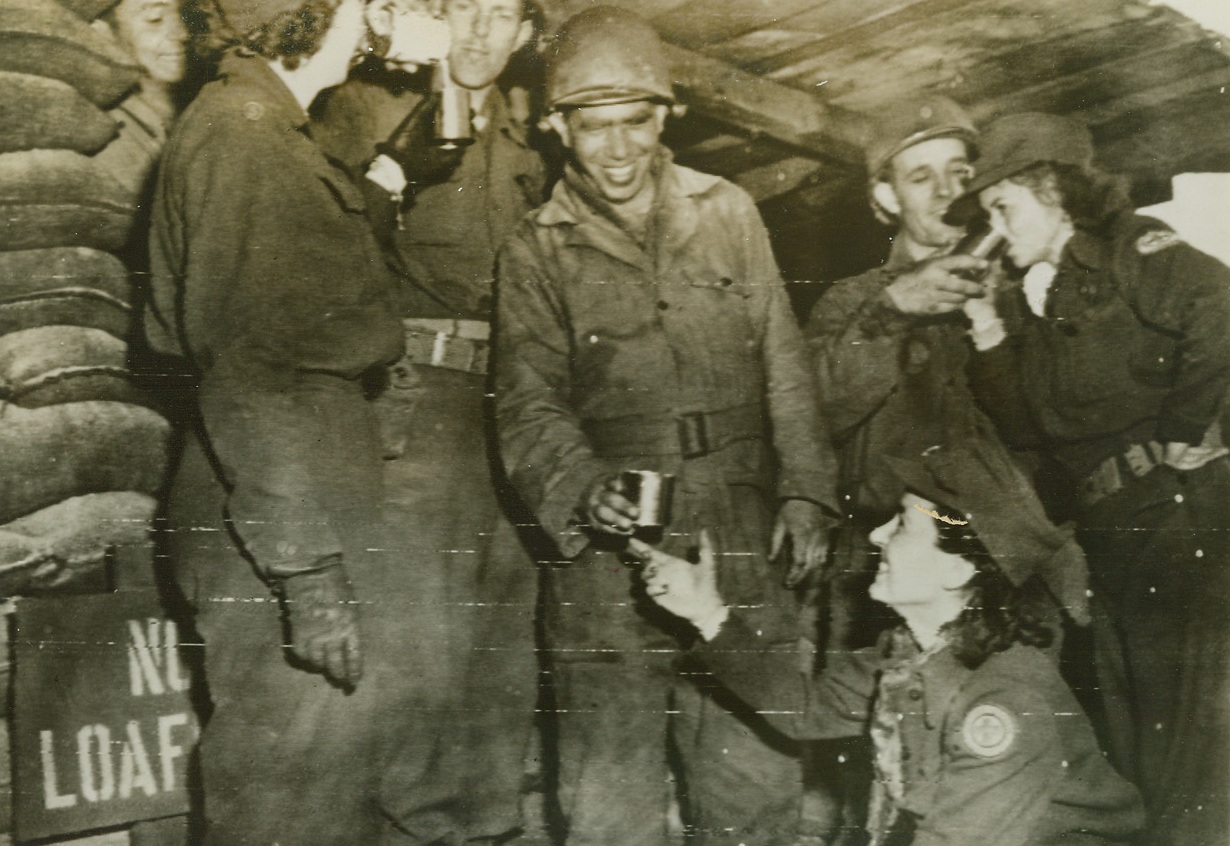
Red Cross Turn About, 7/19/1944. France – Turn about’s fair play so the Army reversed the tables and served coffee in “C” ration cans to Red Cross girls just arrived in France with their Clubmobile. The young ladies receiving hot java are (left to right): Nellie Borland, Scranton, Kas.; Marjorie Lee, Cedartown, Ga.; and Irma Lappay, Detroit, Mich. Credit: US Army Radiotelephoto From ACME;
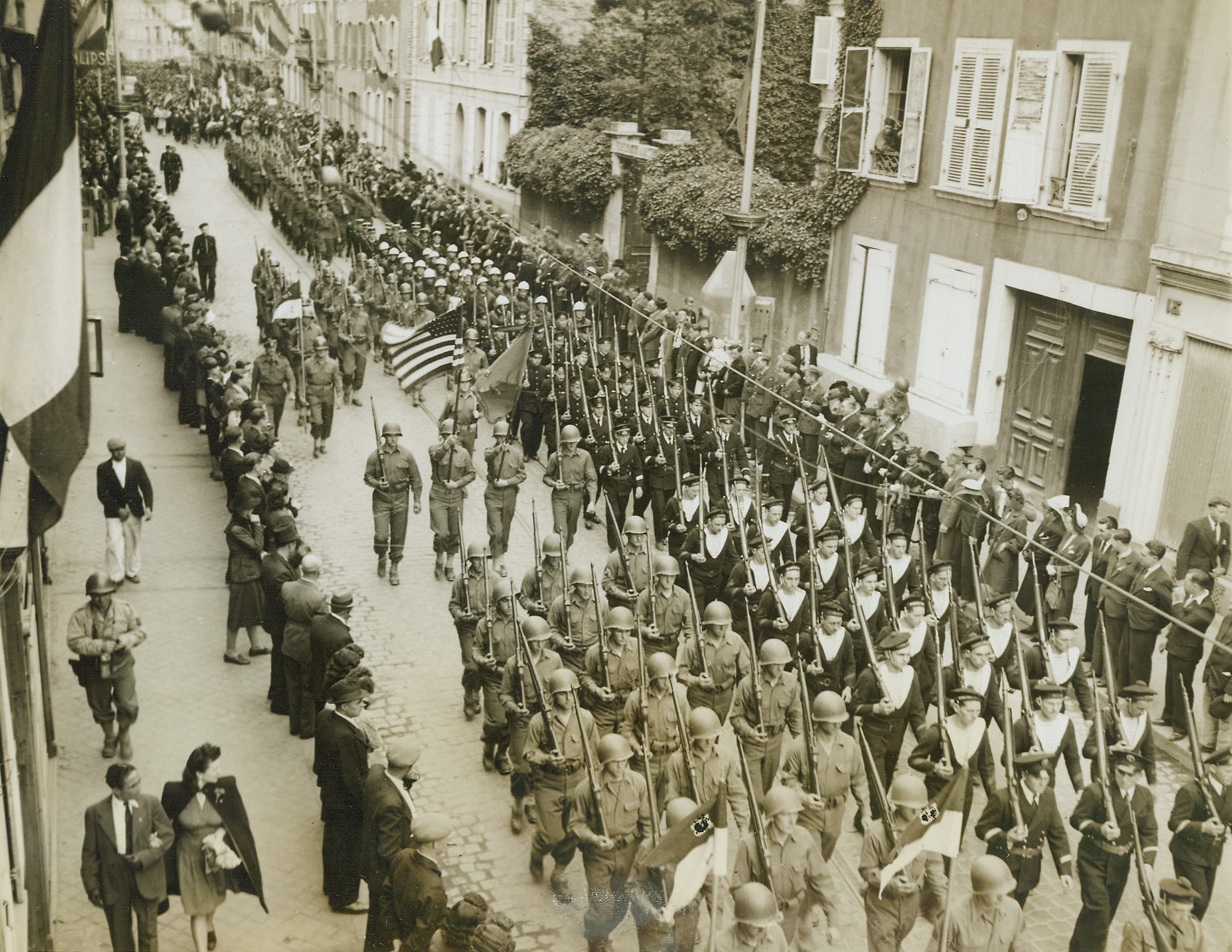
Allied Troops March On Bastille Day, 7/19/1944. France – In close formation American and French troops march side by side through the streets of Cherbourg during Bastille Day celebrations. (Passed by Censors) Credit: ACME photo by Bert Brandt, War Pool Correspondent;
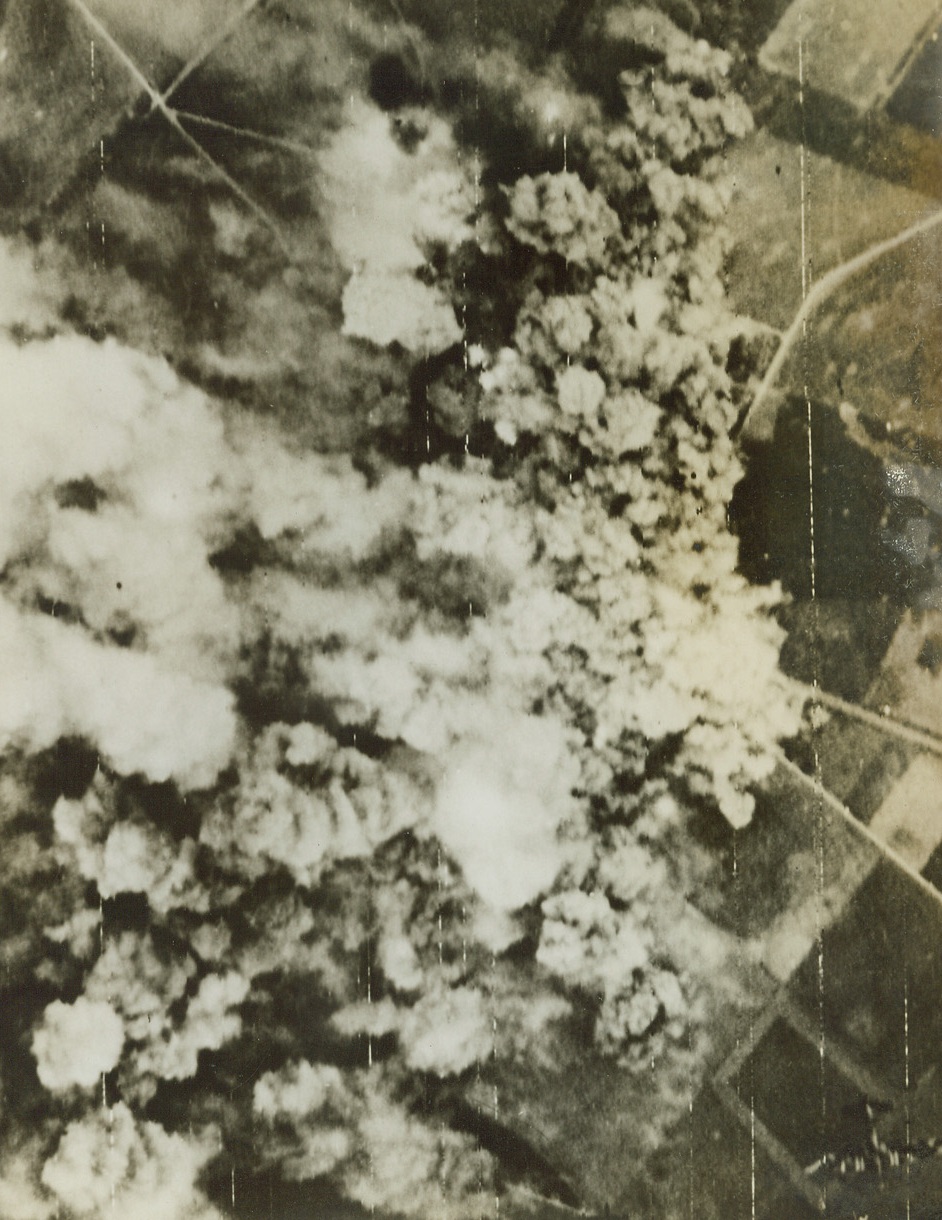
Concentrated Destruction, 7/19/1944. France – Royal Air Force Lancasters left this smoke-smothered target after bombing Nazi gun concentrations at Cagny, southeast of Caen. More than 1,000 planes dropped fourteen thousand tons of bombs during the attack on the German Army in the field. Credit: British Air Ministry photo via Signal Corps Radiotelephoto from ACME;
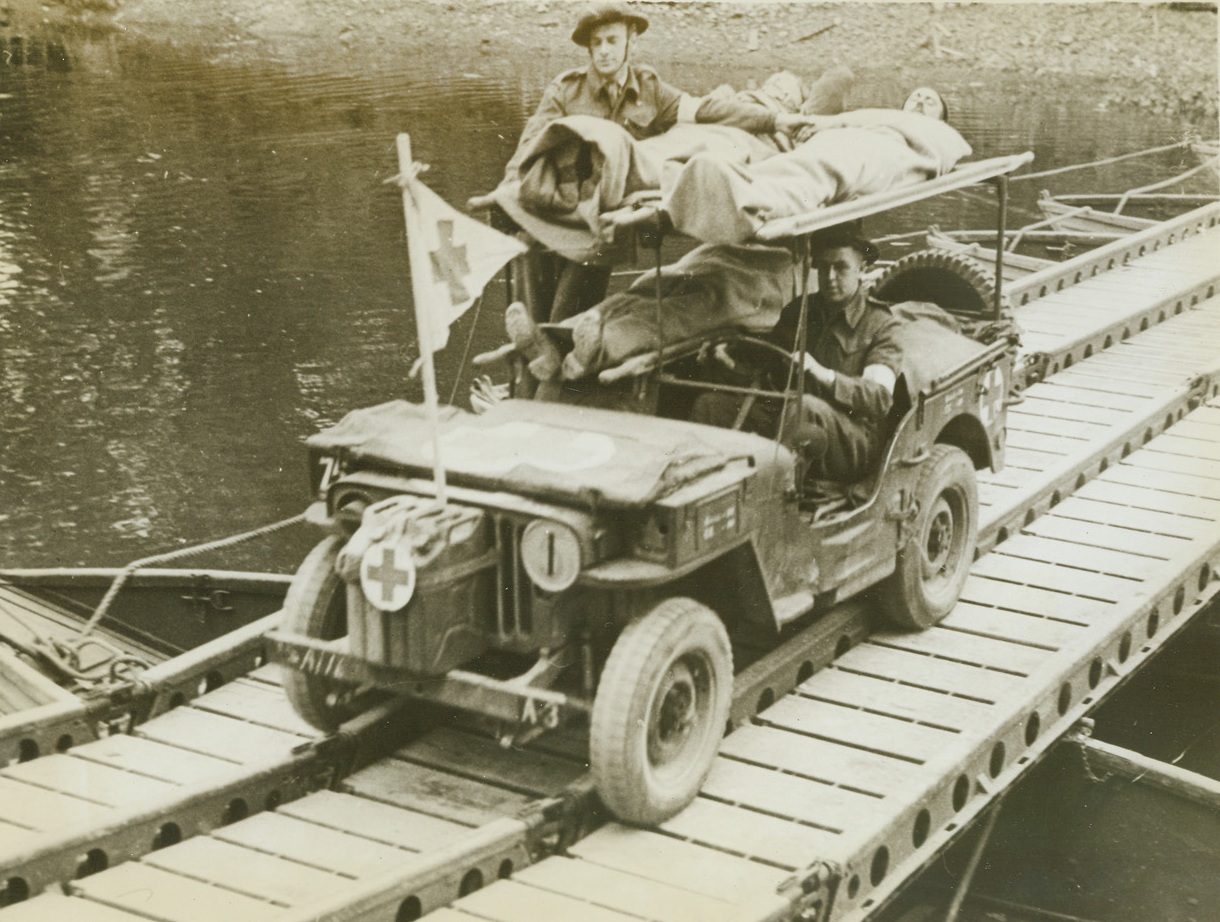
Wounded Tommies Ride Double Decker, 7/7/1944. France – Wounded in the fierce assault that stormed the River Orne and enabled the British to take Caen, three Tommies ride a Double Decker Jeep, manned by two medics, on their way to the rear for treatment. Note the hastily constructed pontoon bridge stretched across a stream. Credit: ACME;
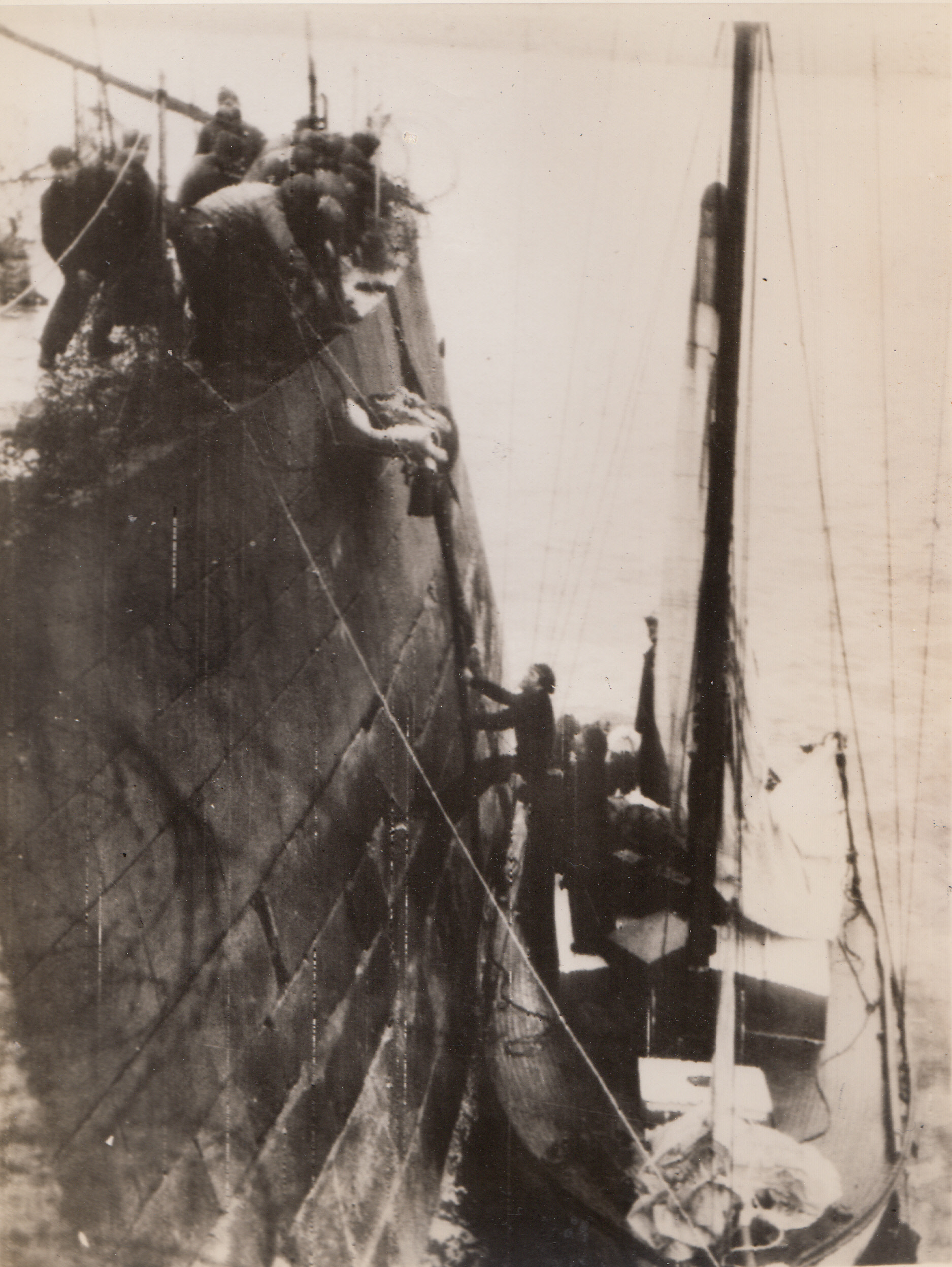
He Guarded The Harbor, 7/3/1944. Cherbourg, France – A sailor stands in the sailboat waiting to receive the stretcher on which is a wounded German non-com. He is being evacuated from a Cherbourg Harbor fort, where he was stationed at the time the American forces invaded the port city.;
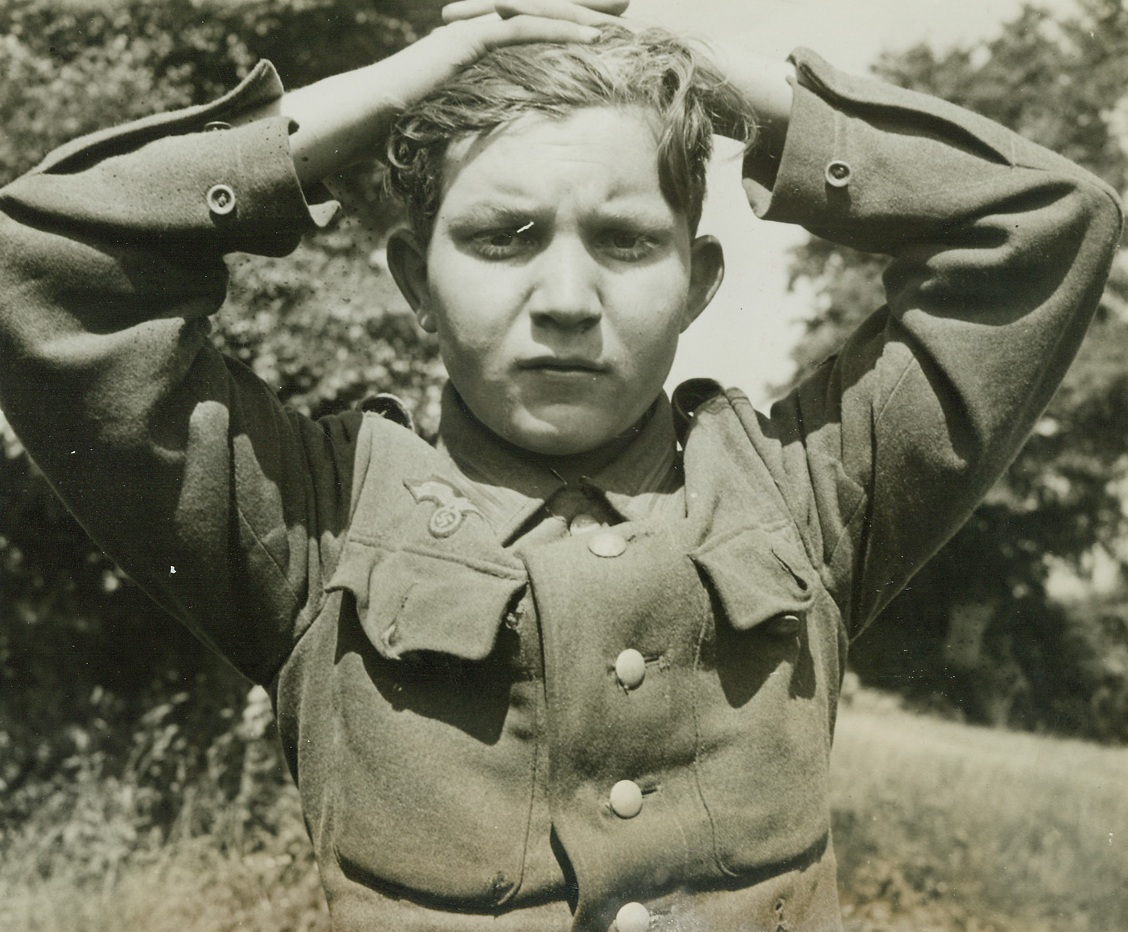
Nazi Youngster Plays Soldier, 7/1/1944. France – Hands over his head, this youthful Nazi was among the thousands captured by victorious Allies in Cherbourg. Only 16 years old, his boyish face belies the fact that the Nazis have made him a killer capable of brutalities of the oldest and most ruthless followers of Hitler. To get children like this back to schools and off the battlefields is one of the reasons—part of the cause the Allies are fighting for. Credit: ACME photo by Andrew Lopez, War Pool Correspondent;
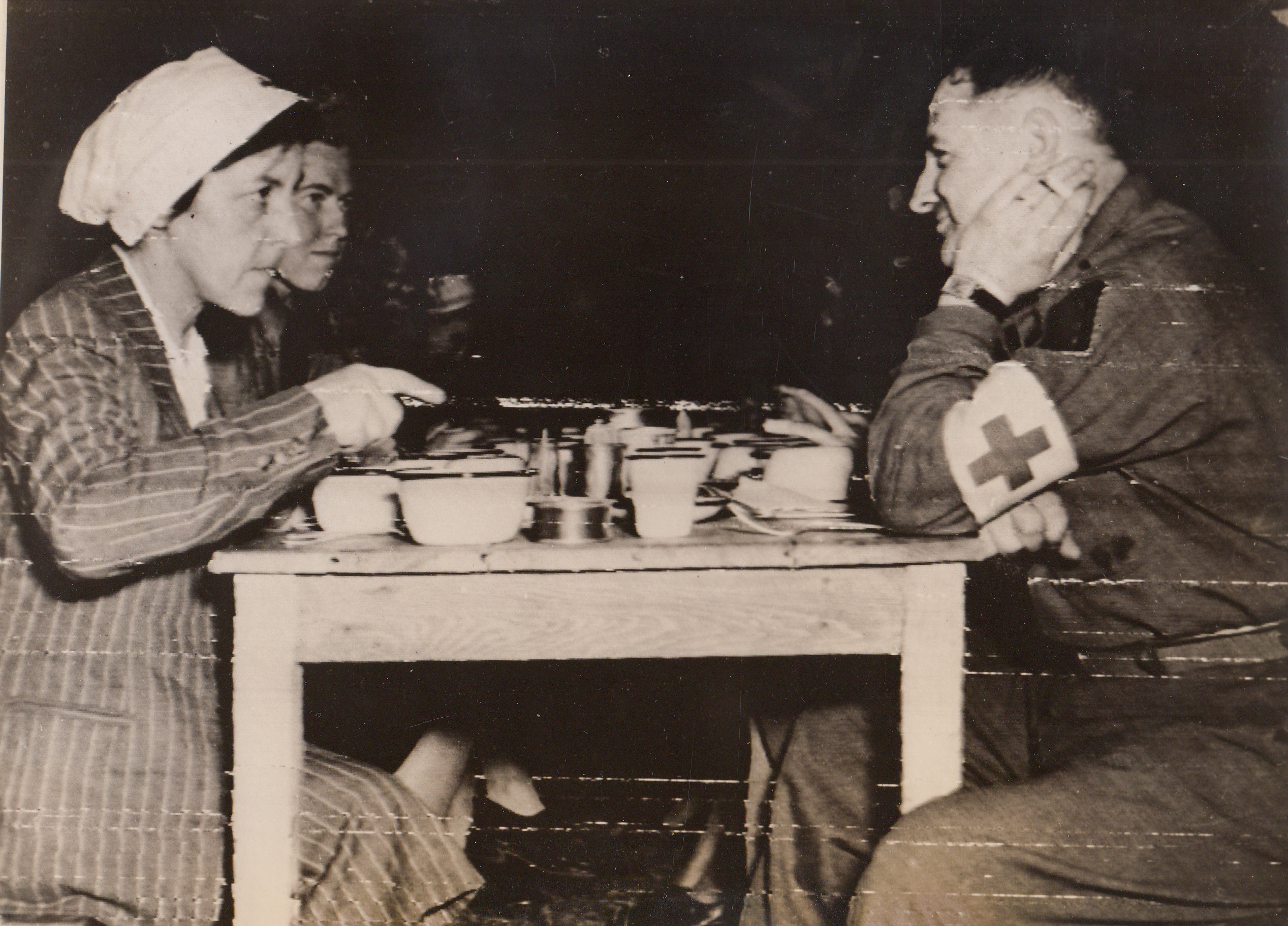
German Nurses Eat American Rations, 7/3/1944. Cherbourg, France – These German nurses, eating with the chaplain in the mess hall of an American hospital in Cherbourg, caused the war on the Cherbourg front to come to a temporary halt. Captured by our American forces, they were returned by ambulance to the German lines while all fire halted in a temporary medical truce. As soon as the ambulance returned to the American line, the big guns once again began their bombarding.;
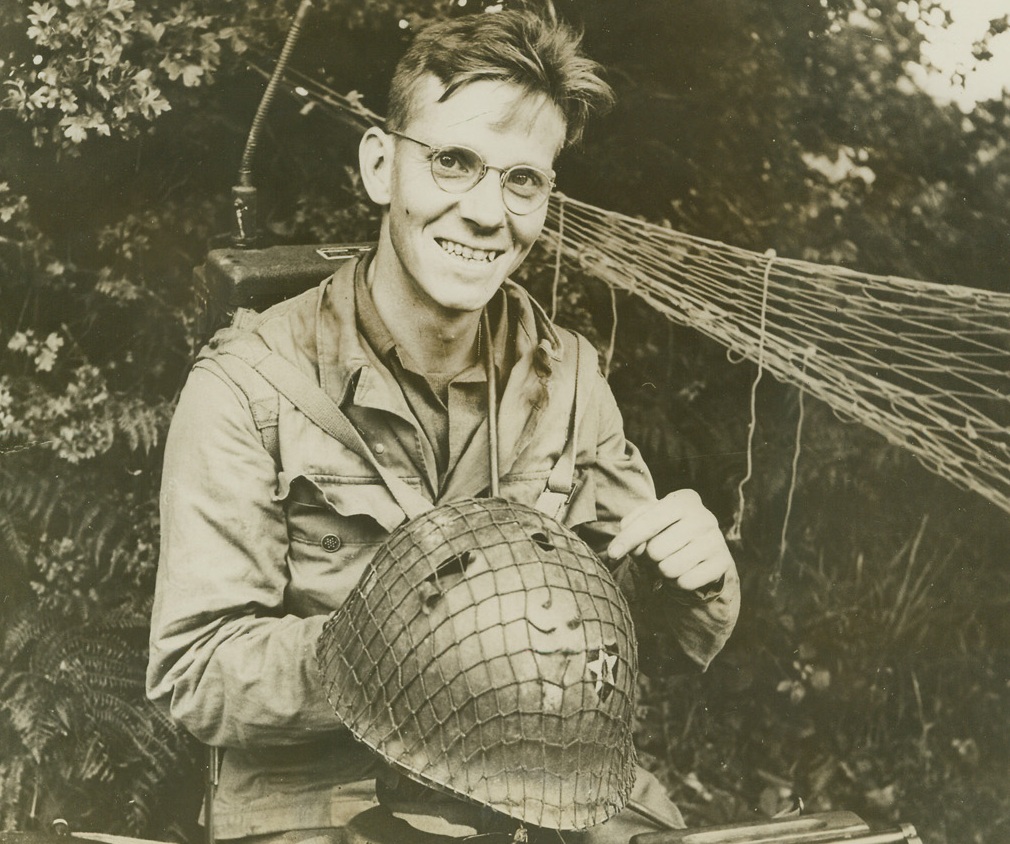
Proof of the Pudding, 7/13/1944. France – Some general recently scoffed at the story that enemy snipers hide in trees and offered five dollars to the first man that could prove it. T/Sgt. Meredith J. Roger, of San Antonio, Texas, lays claim to that “pound” right now, and here’s the proof! He holds his helmet, punctured in two places from a tree-sniper’s bullet. Incidentally, when the bullet hit his tin hat, near Cherbourg, Roger wasn’t even scratched! Passed by censor. Credit: ACME;
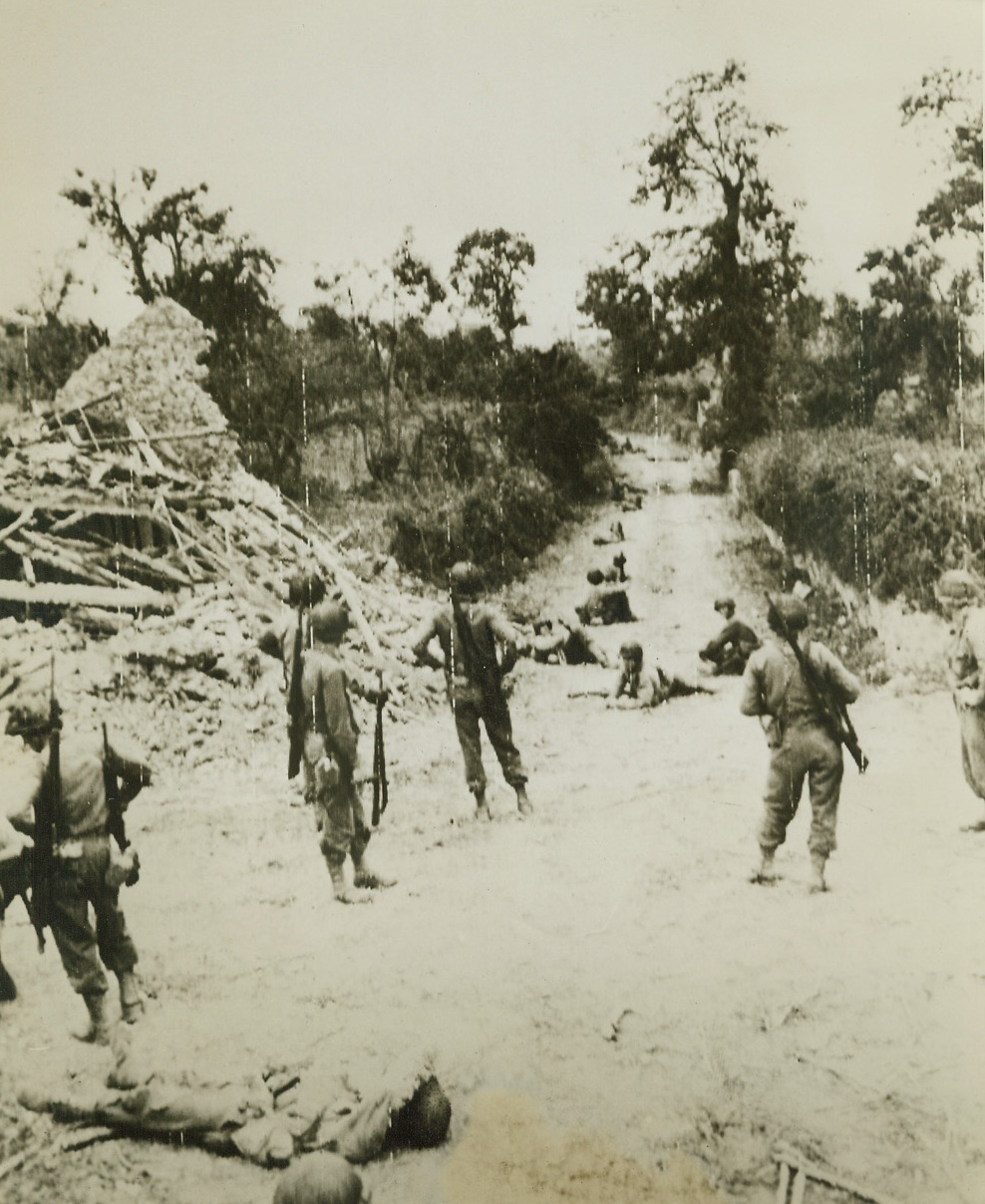
Yanks Stop for Chow, 7/20/1944. France – Beside a wrecked building north of St. Lo, relentlessly advancing American infantry men pause for chow before pushing on to their next objective. Soldiers line the road leading past the ruined house, sitting, reclining, and some catching forty winks. Credit: Signal Corps Radiotelephoto from ACME;
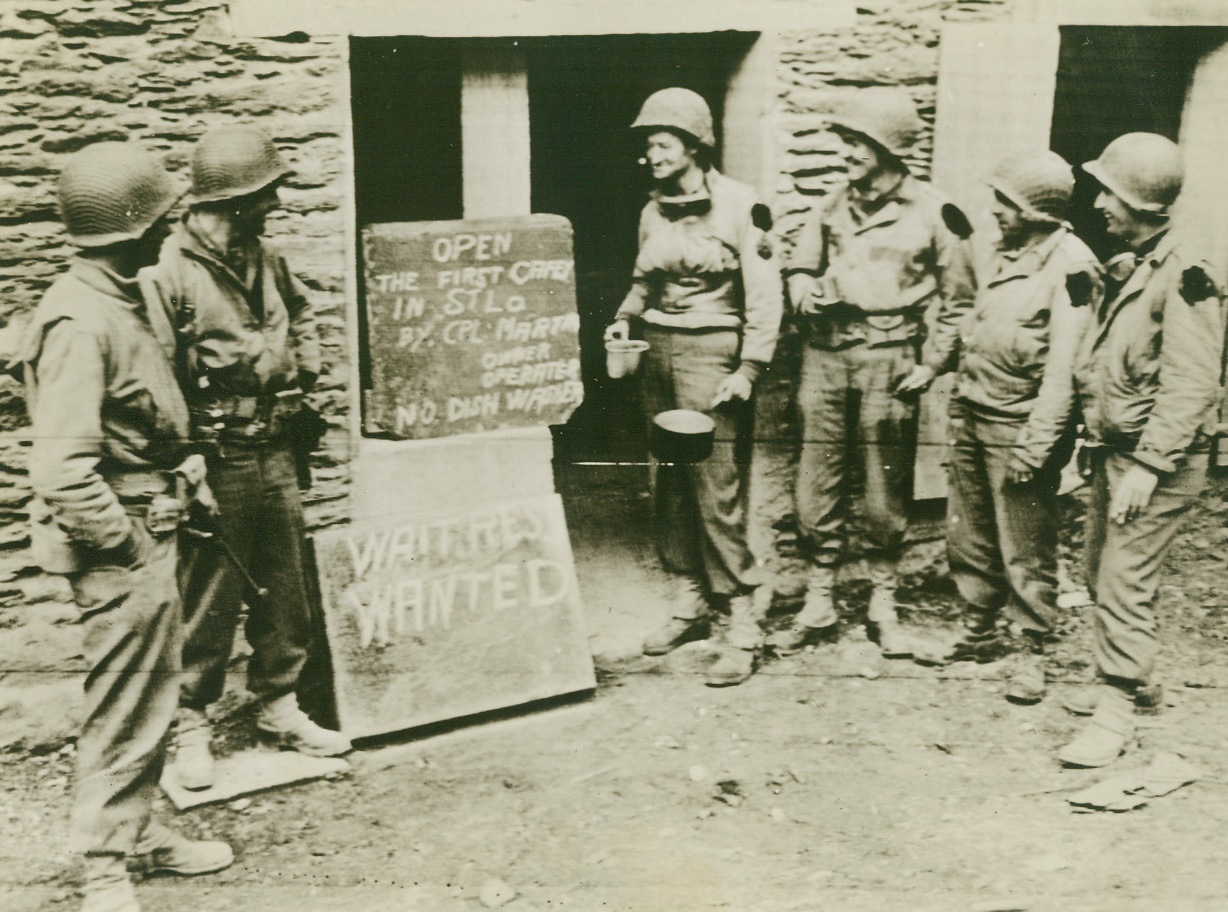
Man Shortage There, Too, 7/21/1944. St. Lo, France – Prominently displayed beneath the sign advertising the opening on the first canteen is a placard seeking waiters. Cpl. E. L. Martin, Martinsville, Virginia, stands at the head of the line with his canteen cup and pan, waiting for the mess call. Credit: U.S. Army Radiotelephoto from ACME;
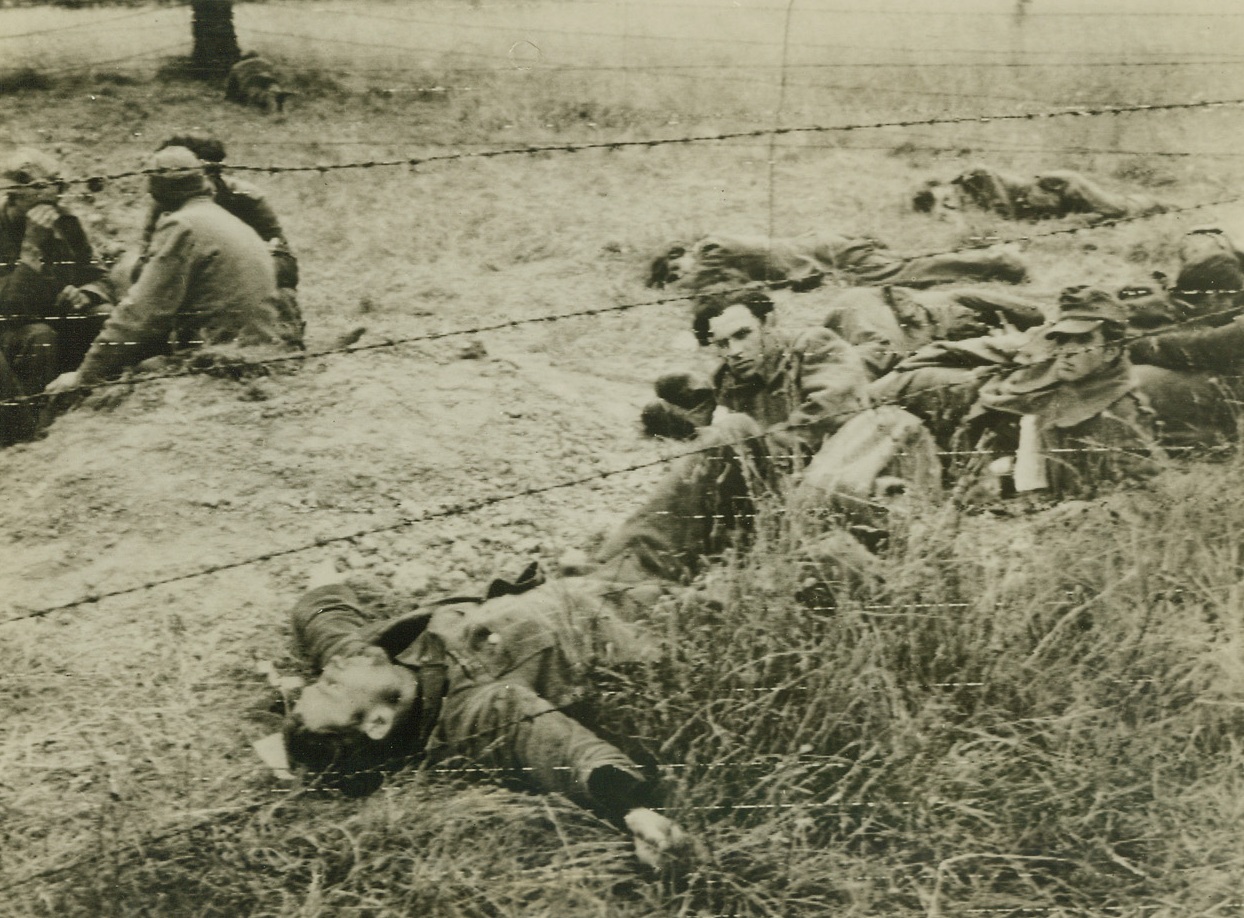
Exhausted Captives, 7/17/1944. St. Lo, France – Battle weary and dazed after witnessing the intense artillery fire from Allied big guns in the St. Lo sector, these German prisoners lounge in a prisoner of war enclosure behind the fighting lines. Lying flat on his back, arms flung out, the captive in foreground sleeps the sleep of exhaustion. Credit: Signal Corps photo from ACME;
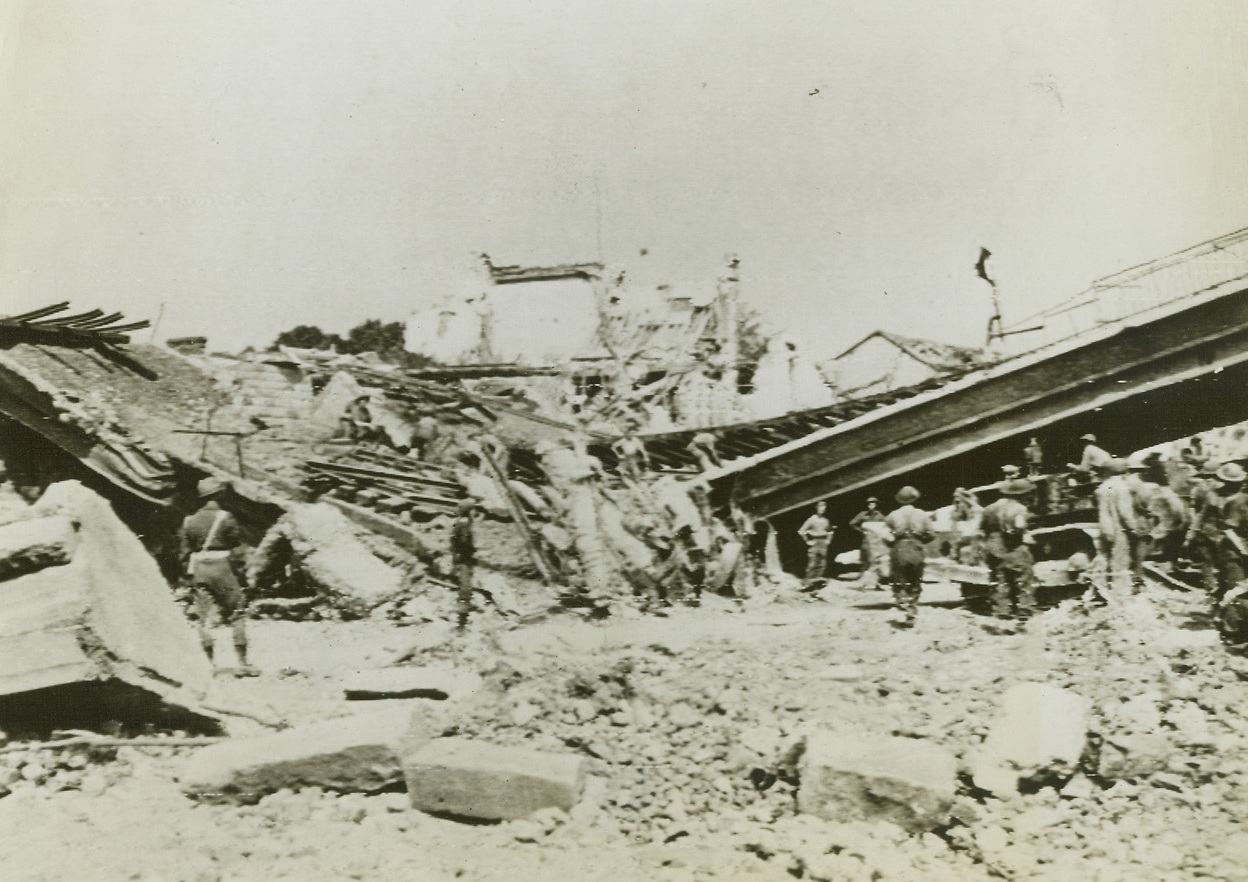
Reconstruction Under Way, 7/22/1944. Vaucelles, France – Destroyed by Allied precision bombing, this bridge proved a blockade for German supply lines and troop movements during the invasion of the Cherbourg Peninsula. Canadian engineers start to rebuild the railway bridge so that it may aid the Allies. Credit: Canadian official photo via US Army Radiotelephoto from ACME;
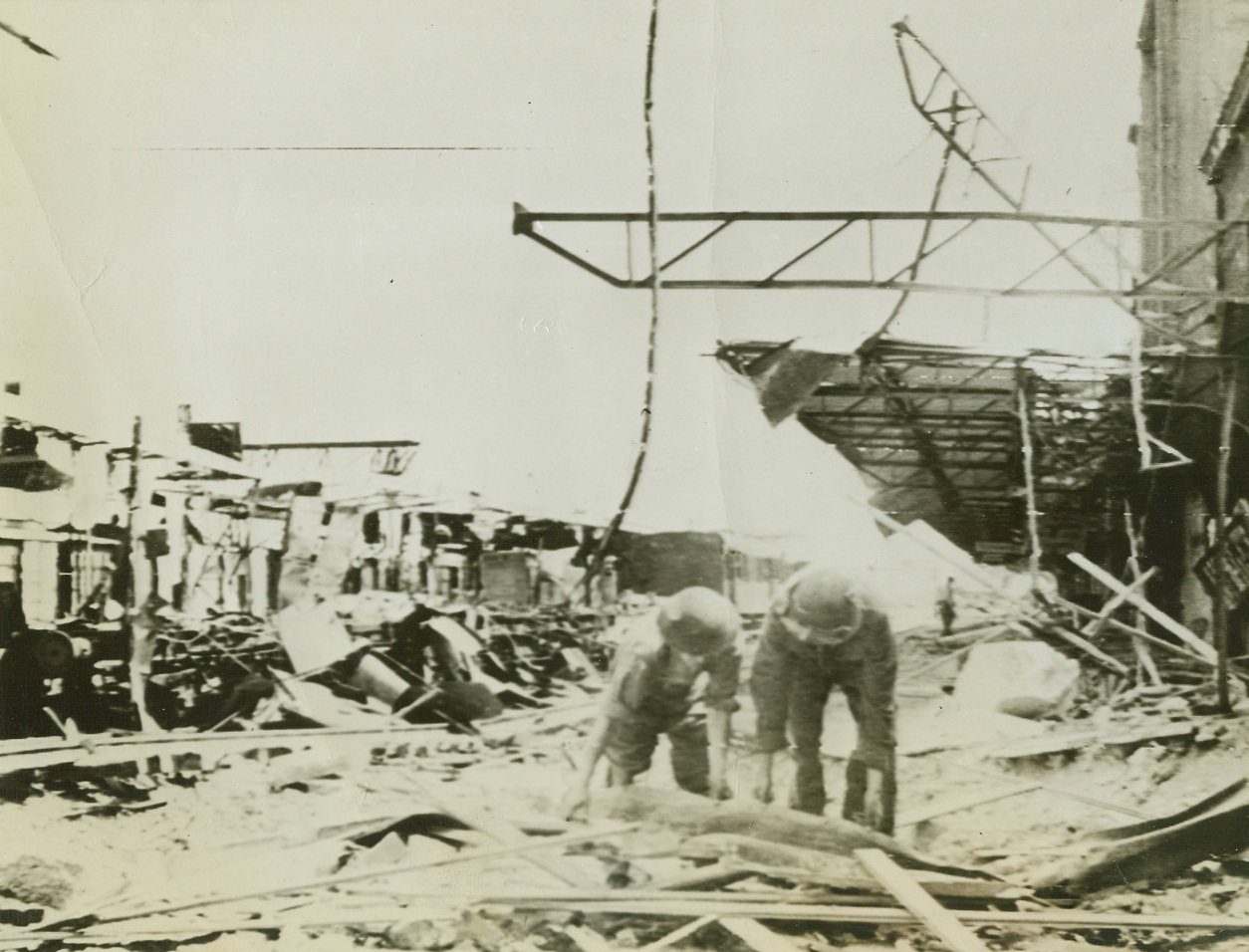
Railroad Repairs Under Way, 7/23/1944. Vaucelles, France – Canadian Army engineers remove the debris from the tracks at the Vaucelles railway station as they quickly repair the rail center for use by the Allies. Credit: Army Radiotelephoto from ACME;
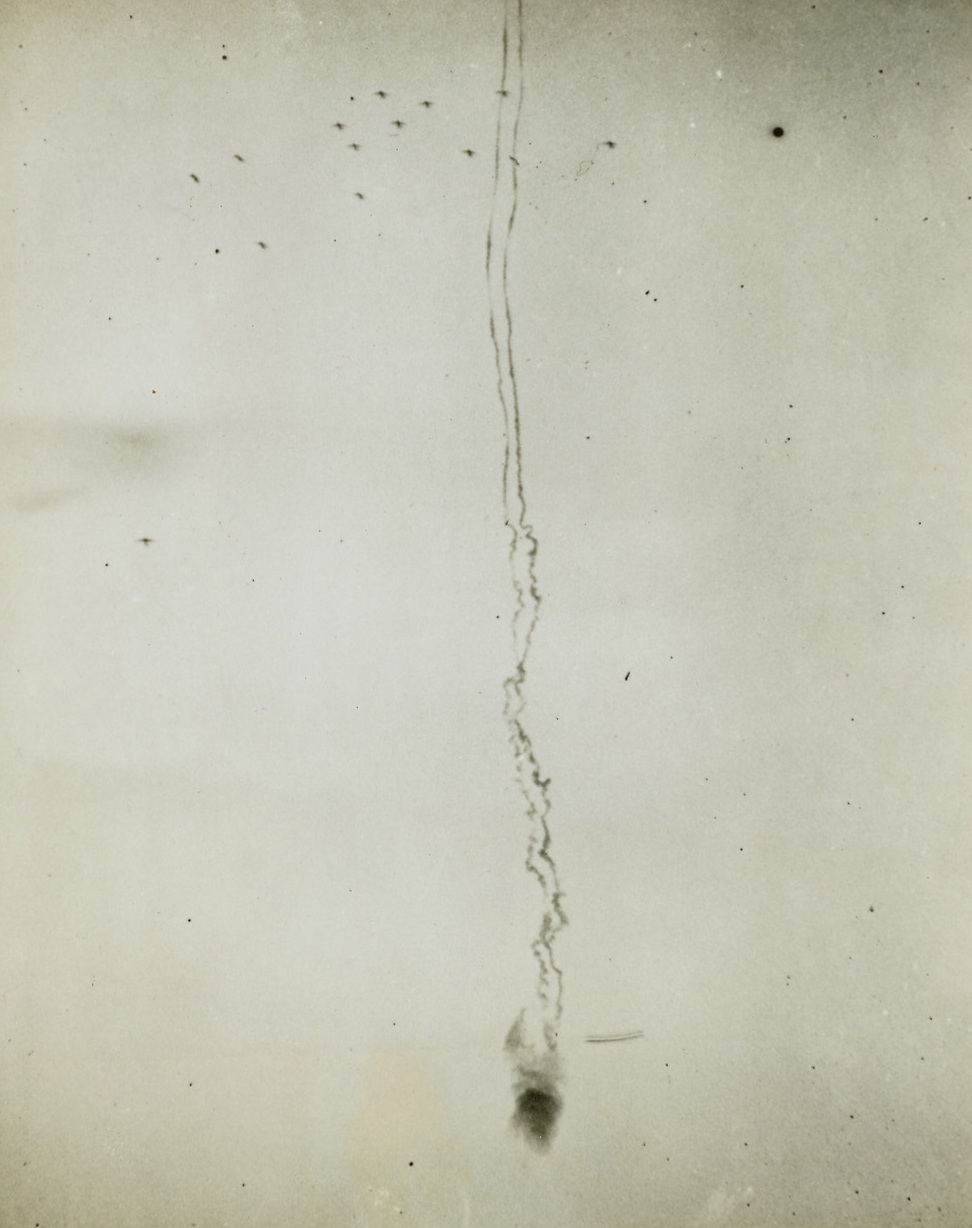
Last Flight for Flying Fort, 7/30/1944. Normandy, France – A smoke trail drifts into the sky after a Flying Fortress had been shot down by flak in the great American close-range bombardment of enemy lines during the preliminary softening-up before the present offensive. Other planes of the squadron can be seen flying in formation. Credit: Acme photo by Bert Brandt, War Pool Correspondent;
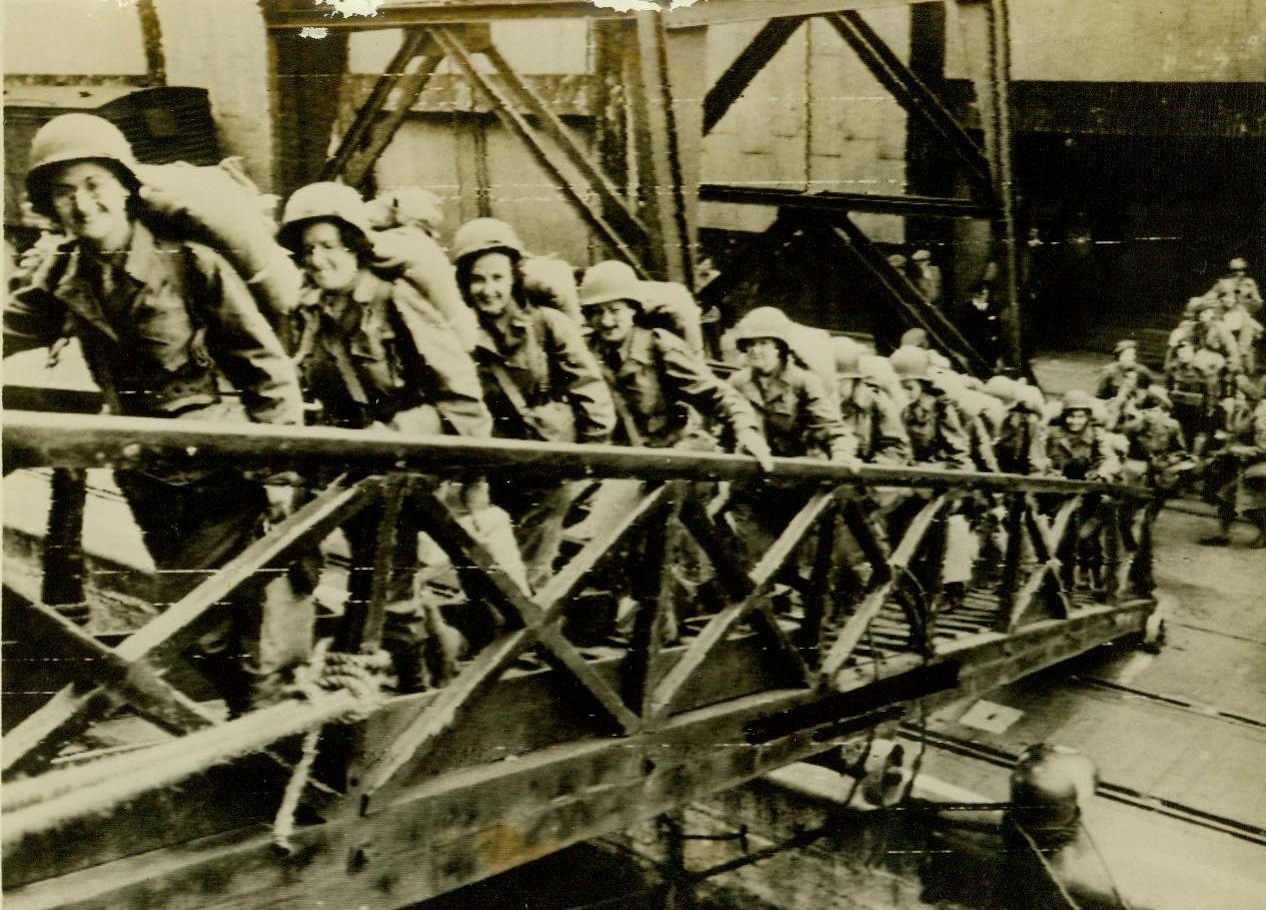
First To Go Over, 7/17/1944. First To Go Over England—The first group of WACs to be sent to France to serve with allied forces, these American women flash happy smiles as the climb up the gangplank of their transport mighty happy about their trip “over there” The girls embarked from a port somewhere in England 7/17/44 (Radiotelephoto—ACME);
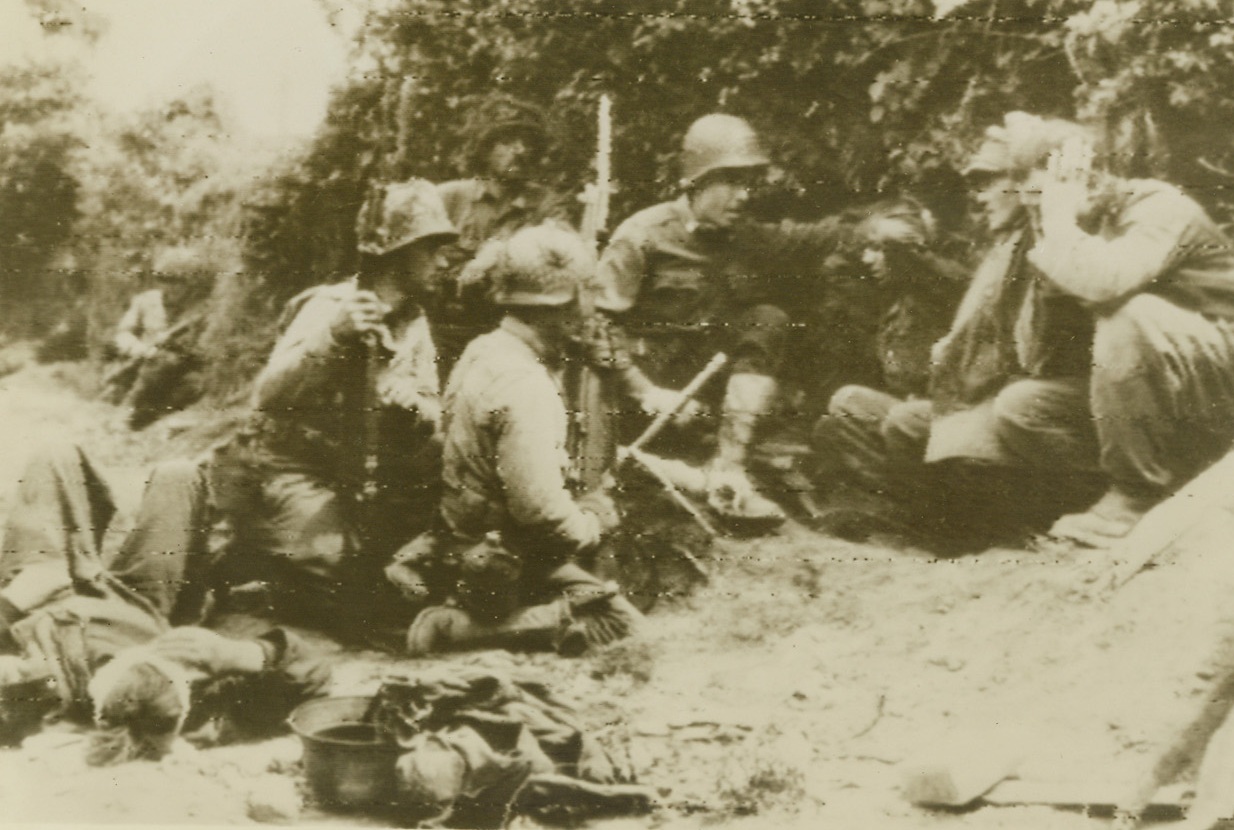
Duck, Nazi, Duck, 7/2/1944. St. Lo, France – Unwilling to meet death, or even injury, at the hands of their own countrymen, the three German prisoners at right hold their ears and duck as Nazi artillery fire blasts over the hedge behind which they and their Yank captors are hiding. A fourth prisoner, who is wounded and has been given first aid treatment, lies at left. Credit: ACME Radiophoto;
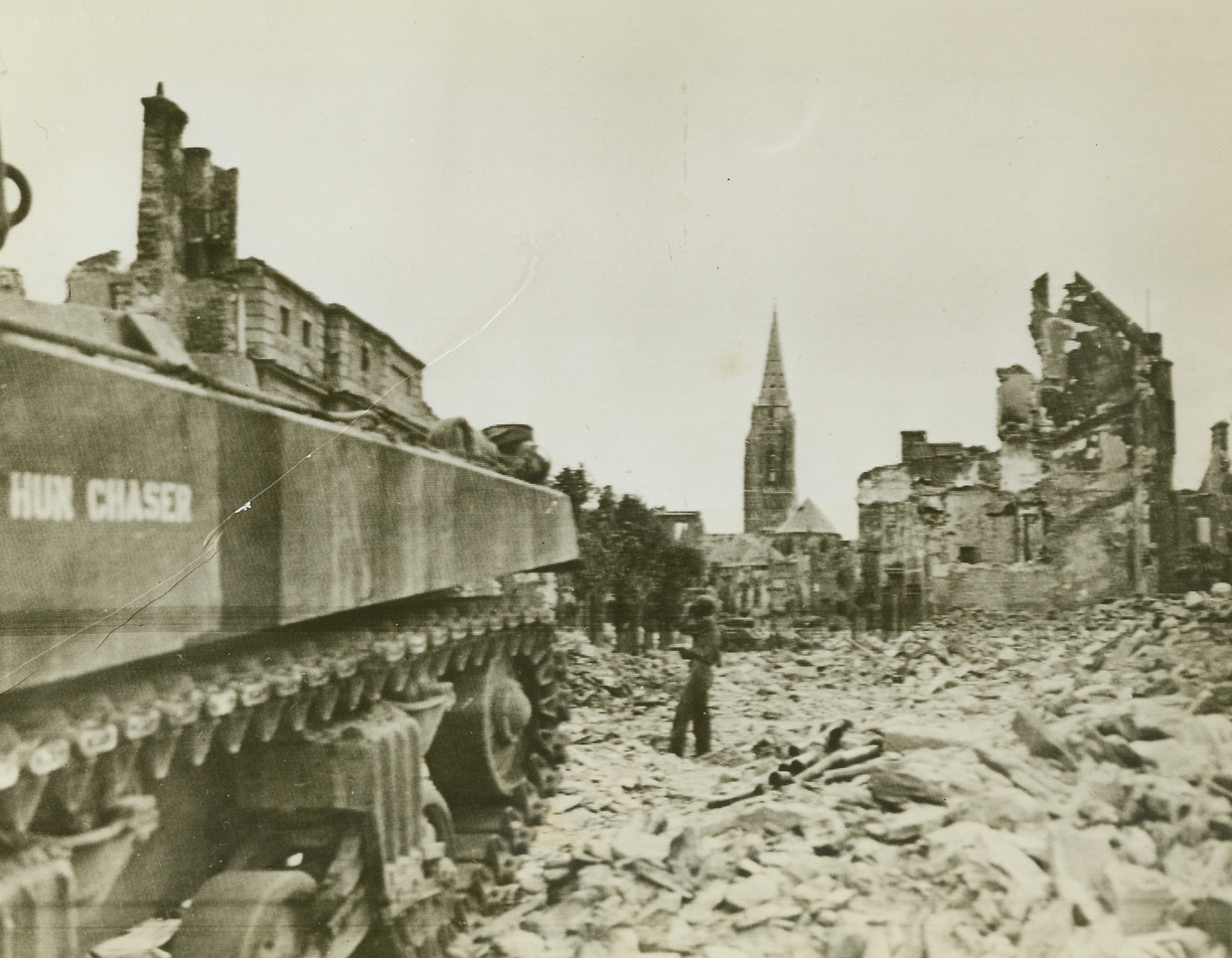
“Hun Chaser” on the March, 7/21/1944. St. Lo, France – While the gigantic “Hun Chaser” tank rumbles through the debris of St. Lo, Pvt. Walter Hatfield, Princeton, Idaho, looks for snipers with field glasses and poised pistol. Blockbusters have not yet cleared the streets of rubble. Credit: US Army Radiotelephoto from ACME;
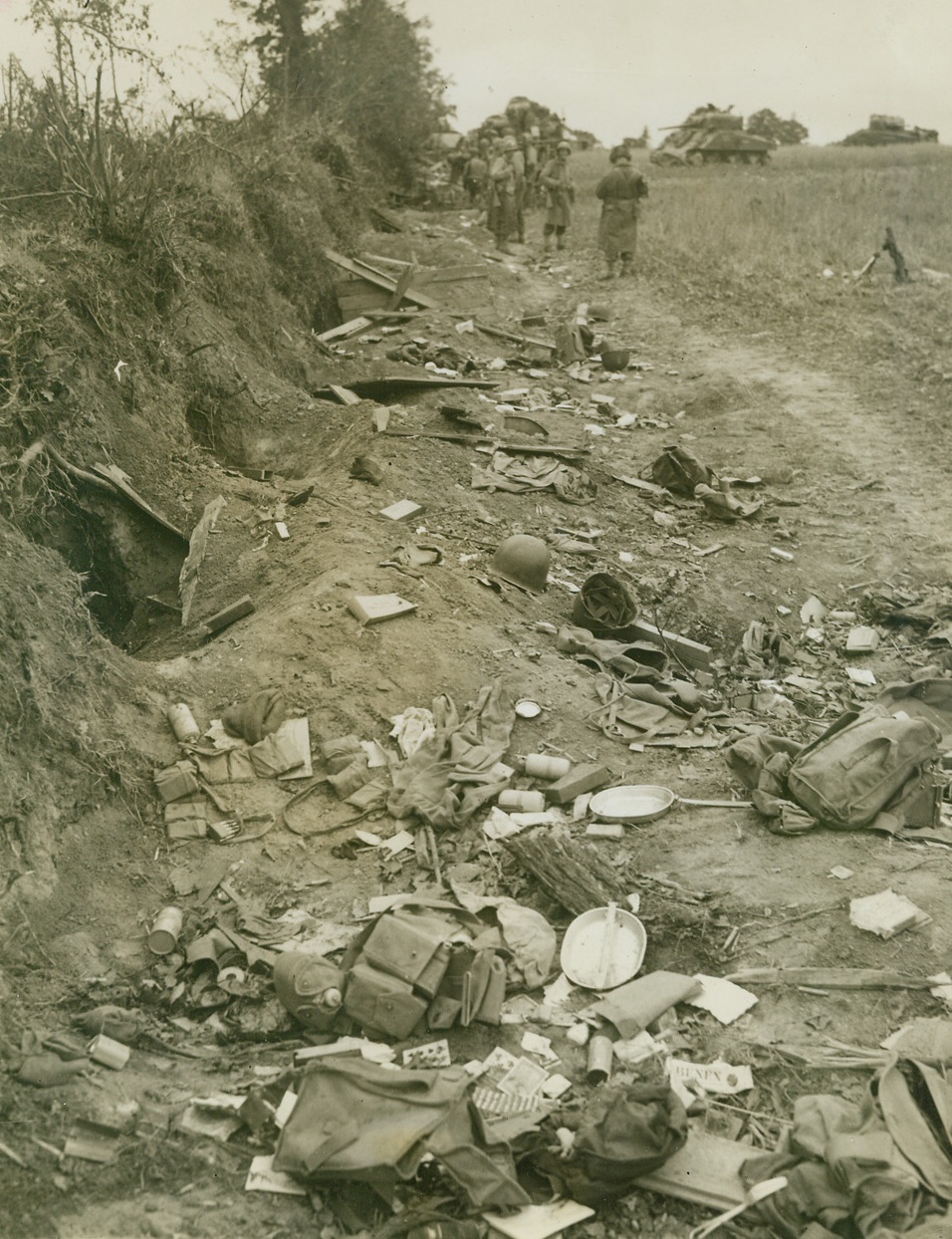
“High Water Mark” of Battle, 7/25/1944. St. Lo, France – Abandoned foxholes and hurriedly discarded effects mark a line behind this hedgerow where American troops rested before plunging on into the battle for St. Lo. Helmets, playing cards, mess kits, and hundreds of other belongings litter this field. In the background, tanks and men are gathered in the field. Passed by censors. Credit: ACME Photo by Bert Brandt for War Picture Pool;
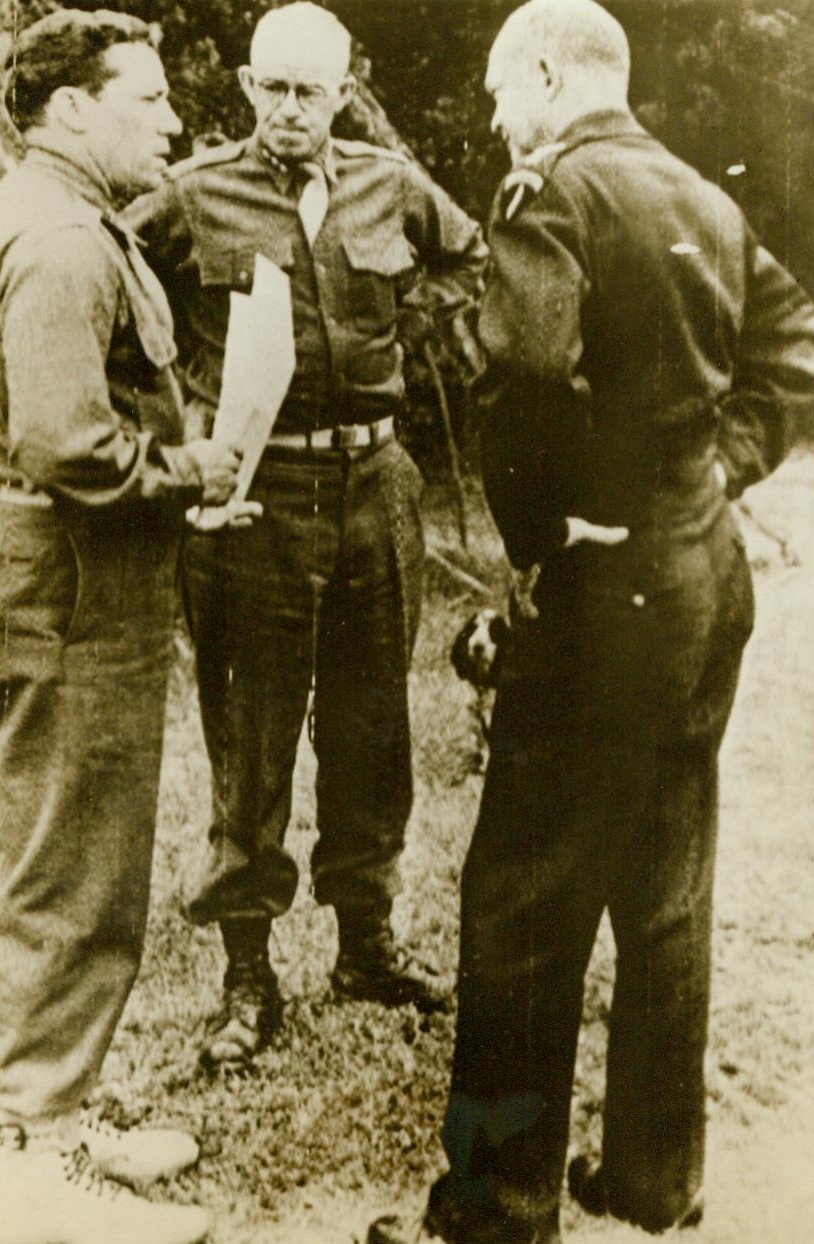
Planning Normandy Break-Through, 7/27/1944. Talking over plans for the record-breaking mission by 1800 heavy bombers which paved the way for the shattering of German lines beyond St. Lo, are, (Left to Right): Maj. Gen. Edwin L. Quesada, of Washington, D.C., Commanding General, 9th fighter command; Lt. Gen. Omar N. Bradley, commanding General, U.S. Ground forces in France; And Gen. Dwight D. Eisenhower. This was Eisenhower’s sixth visit to the Normandy front since the invasion 7/27/44 (ACME RadioTelephoto); And Gen. Dwight D. Eisenhower. This was Eisenhower’s sixth visit to the Normandy front since the invasion 7/27/44 (ACME RadioTelephoto);
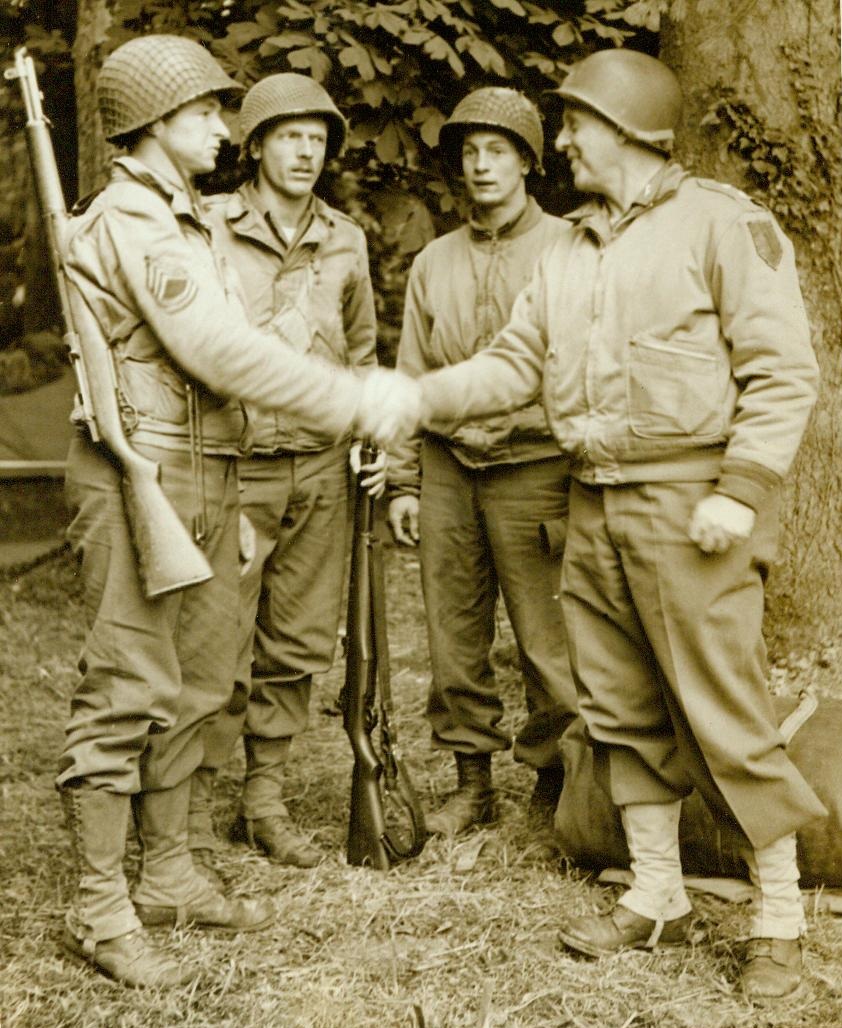
Held French Town for Two Days, 7/9/1944. France— Maj. Gen. Clarence R. Huebner, of Washington, D.C., Commanding the first American Division in Normandy, congratulates (Left to Right); Sgt. Stephen Sternik, Johnson City, N.Y.; Fraut Baldridge, Quitman, Ark.; and Lt. Kenneth Bleau, of Ilion, N.Y. The three men entered the little French town of Colleyville-Sur-Mer on D-Day and throughout that night and the next day held their position killing 100 Germans during the action. They were eventually relieved by their comrades of the First Division. The amazing story of their heroic action has just been disclosed and the men have been recommended for decorations 7/9/44 (ACME);
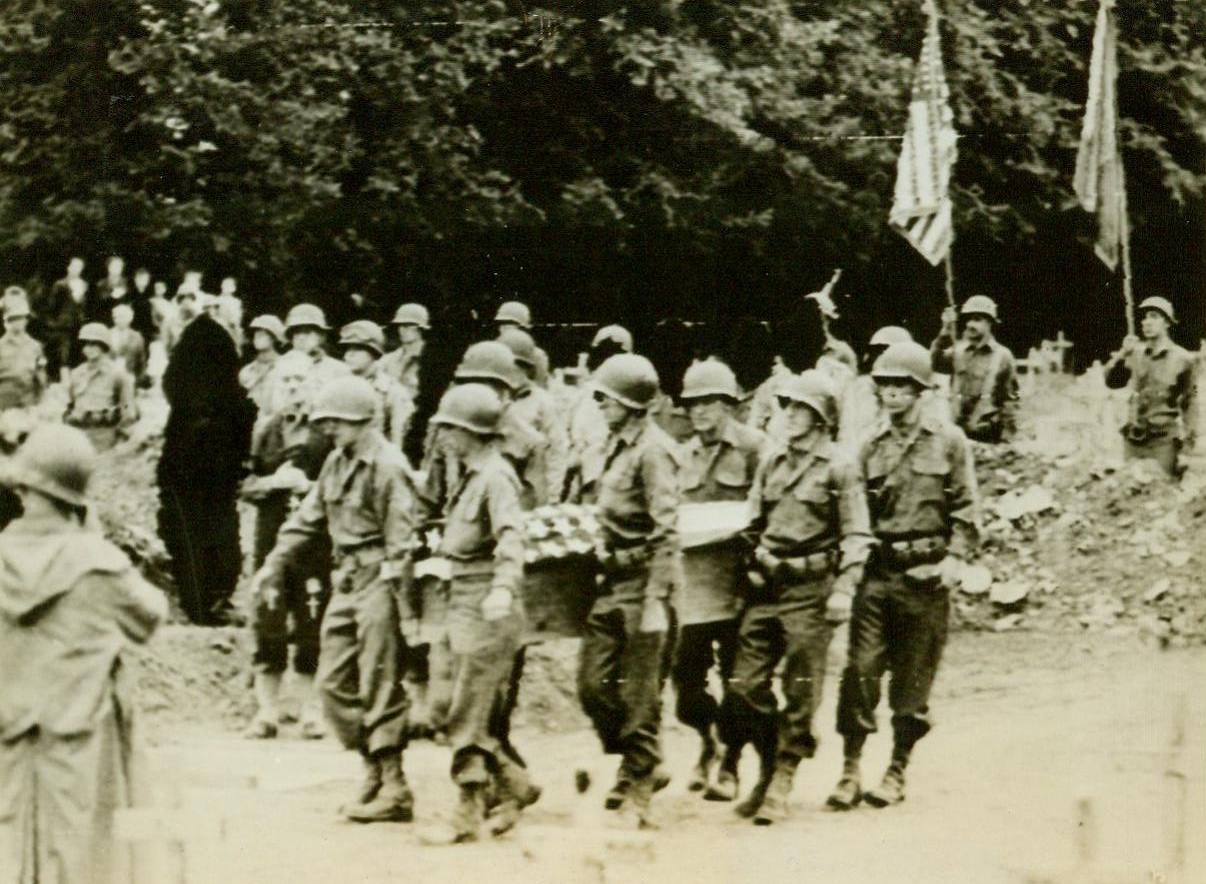
Carry General Roosevelt to Grave, 7/15/1944. France—Eight soldier pallbearers carry the flag-bedecked casket containing the body of Brig. Gen. Theodore Roosevelt to his final resting place in the military cemetery at Ste. Mere Eglise. The beloved General died of a heart attack induced by exhaustion. 7/15/44 (ACME RadioTelephoto);
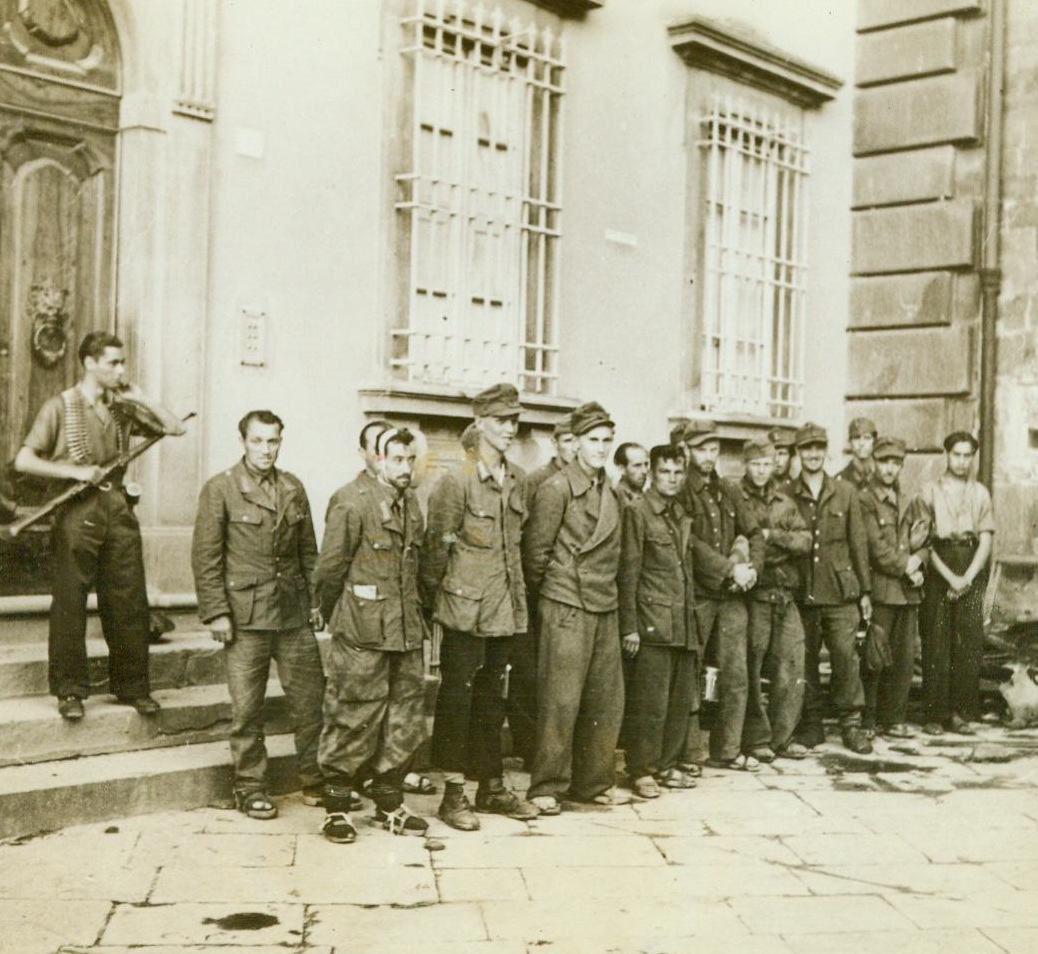
Italian Partisan Guards Nazi Prisoners, 7/20/1944. Italy -- Using equipment taken from Germans they have killed, Italian partisans have been playing their part in the campaign in Italy by rounding up many prisoners and bringing them back to Allied lines. Here, a partisan guards a group of Nazis captured by his band. 7/20/44 (ACME);
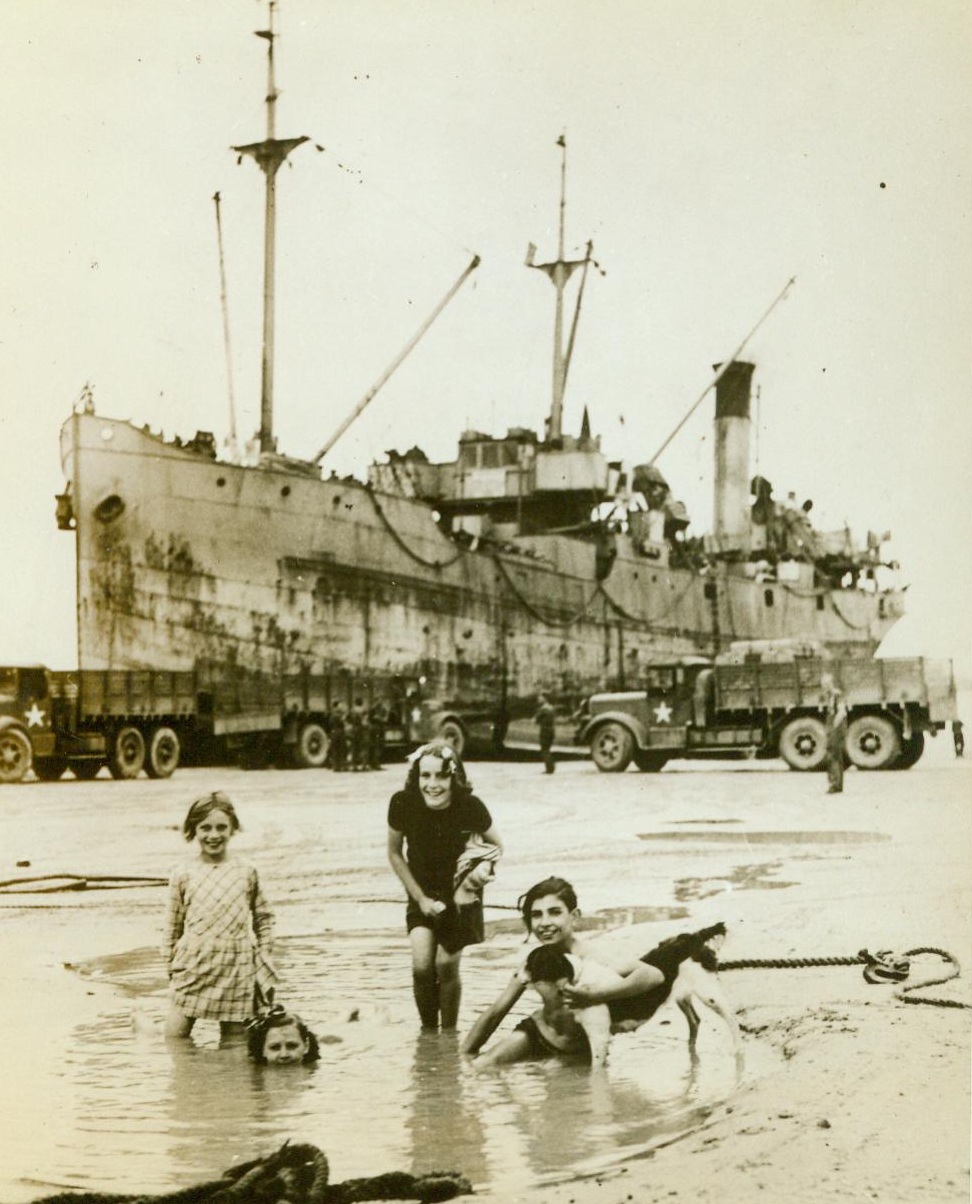
French Children Frolic Near Invasion Craft, 7/28/1944. France -- French children wade in a pool on the beach at Arromanches in the shadow of an invasion craft unloading its cargo Fun has reentered the lives of the children of France in the liberated coastal areas of Normandy. 7/28/44 (ACME);
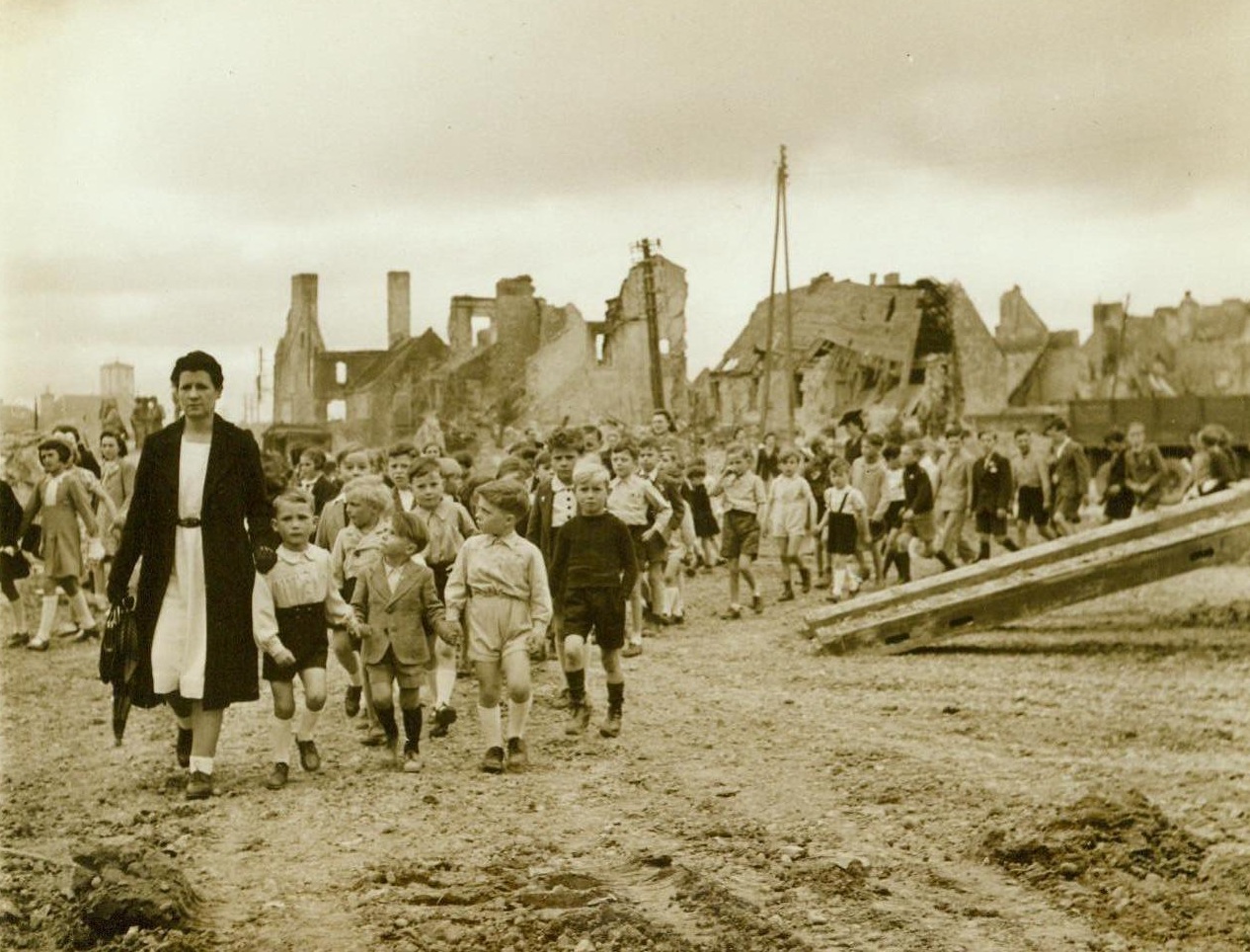
Head For Bastille Day Festivities, 7/19/1944. France -- Marching in orderly fashion past the ruins of their homes, French children head for Bastille Day celebrations in the town of Isigny. Festivities took the form of services at the war memorial in the little Normandy town. 7/19/44;
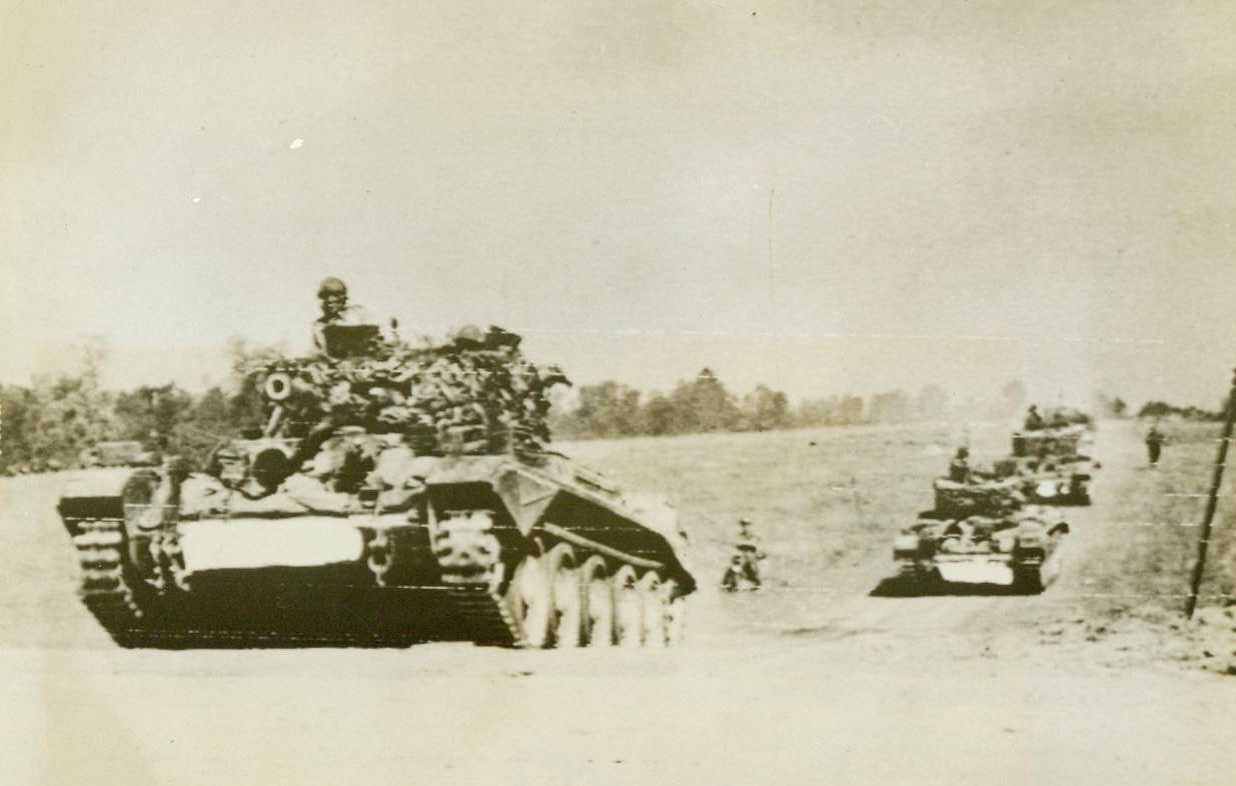
Moving Into Battle Near Caen, 7/19/1944. France -- British tanks move forward across a field during the early stage of the smashing battle between German and Allied armor beyond Caen, July 18th 7/19/44 (ACME);
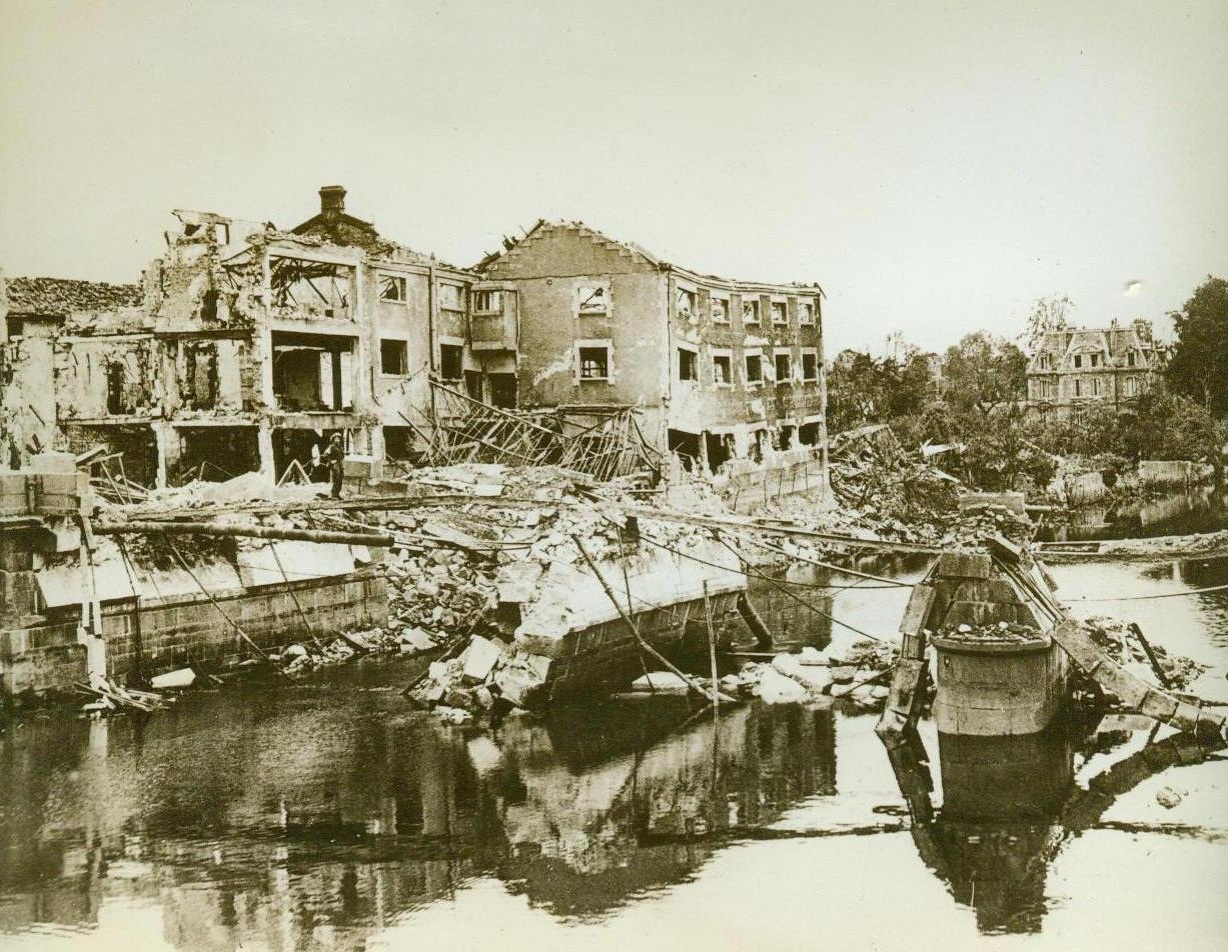
Result Of Allied Bombing, 7/28/1944. France -- Terrific Allied artillery and aerial bombardment preceded the advance by British and Canadian forces past the important city of Caen. The Caen canal to Fauborg remains a mass of twisted steel and rubble after Allied bombers had blasted the area. 7/28/44 (ACME);
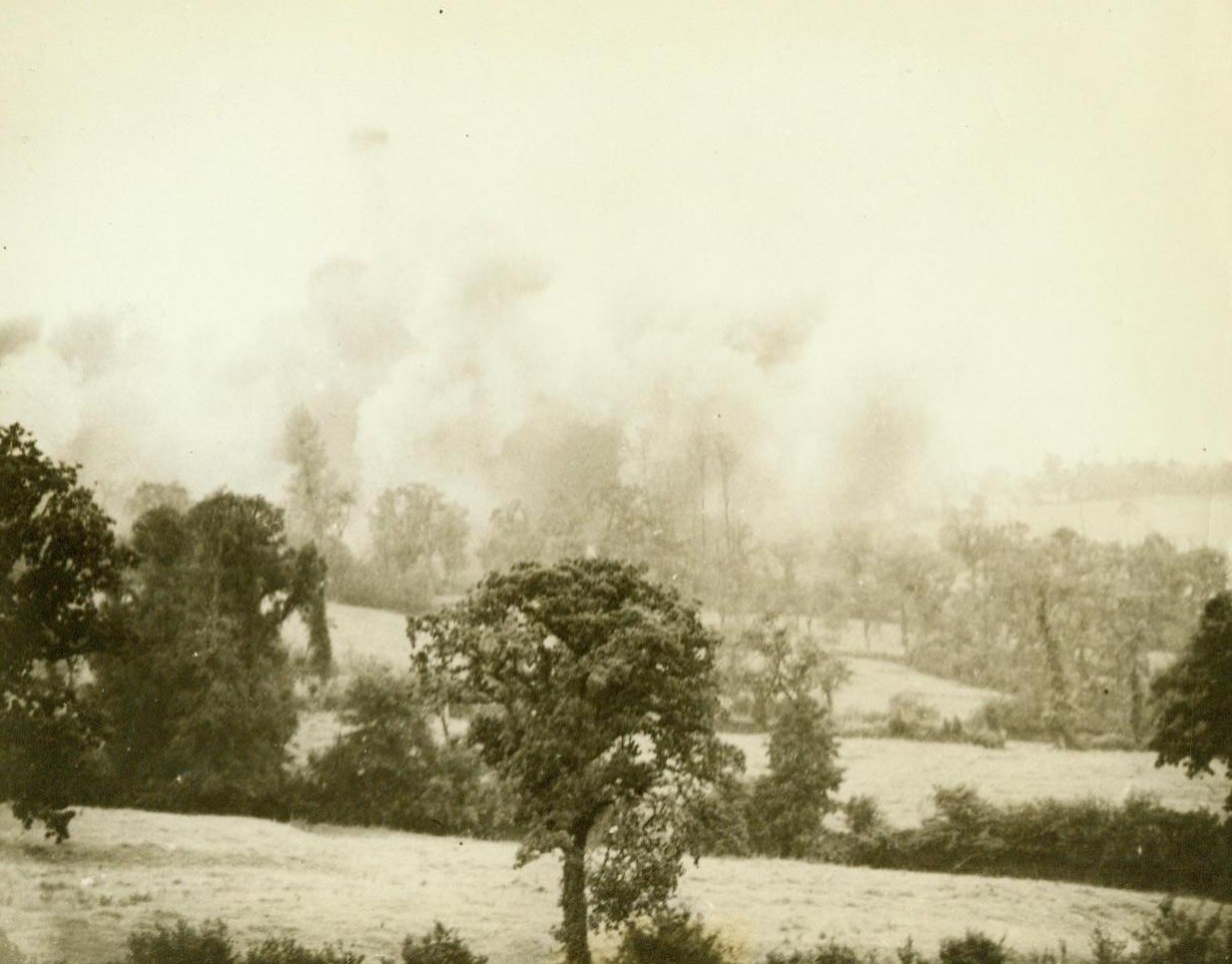
Photographer's Last Picture, 7/27/1944. This photo, taken by Bede Irvin, Associated Press War Pool photographer, just before he was killed by a bomb fragment near St. Lo, France, shows thousand-pound bombs busting on German lines just before the American breakthrough. The film pack containing this graphic equipment left intact by the bomb that killed him. Sent from the front by a fellow cameraman. 7/27/44 (ACME);
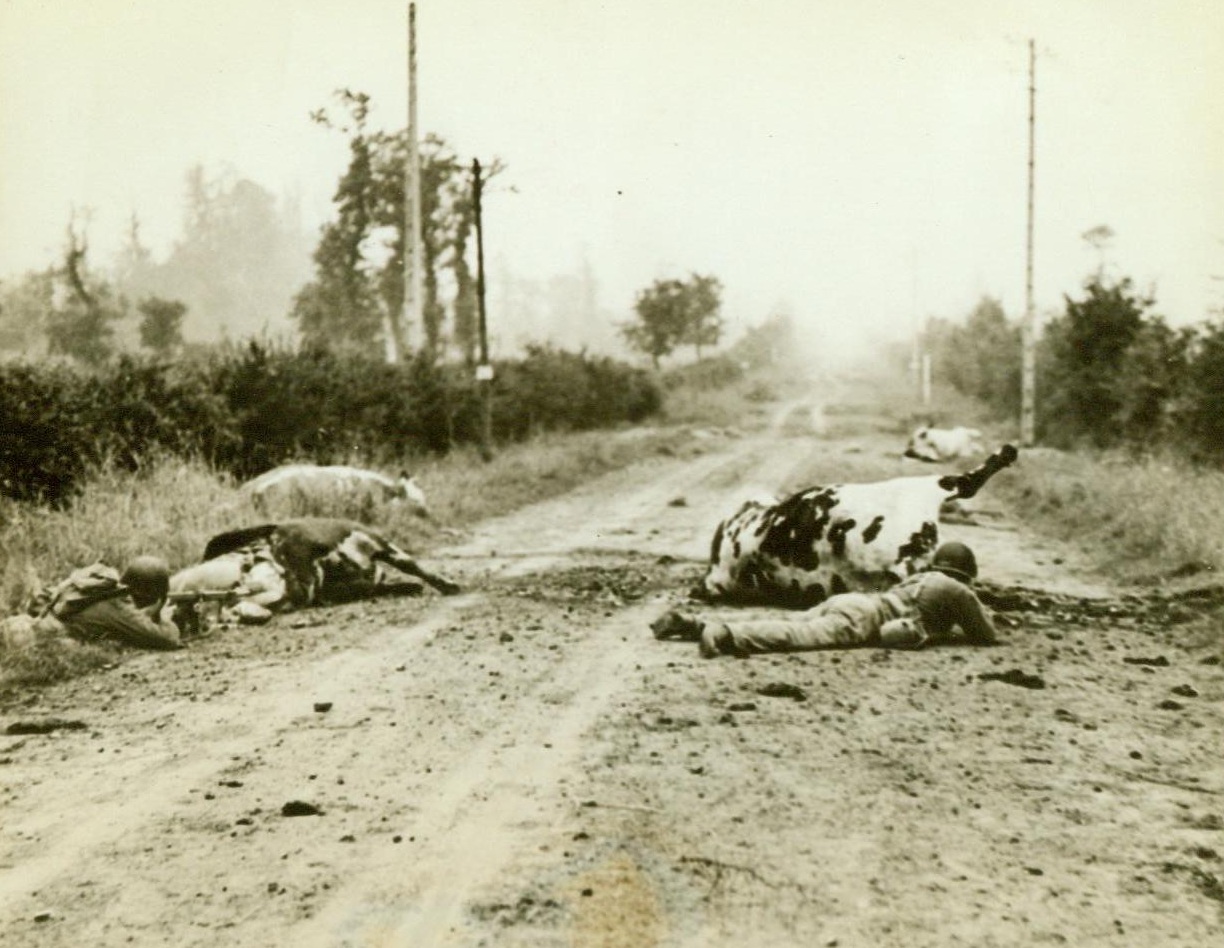
Dead Cattle Provide Cover For Yanks, 7/22/1944. France -- Two Yank soldiers duck low behind the bodies of dead cattle as shells whine over their heads on the road to Periers. Bitter fighting all the way featured the battle for the important city of St. Lo. Americans had to beat Germans back from Periers to achieve their objective. 7/22/44 (ACME);
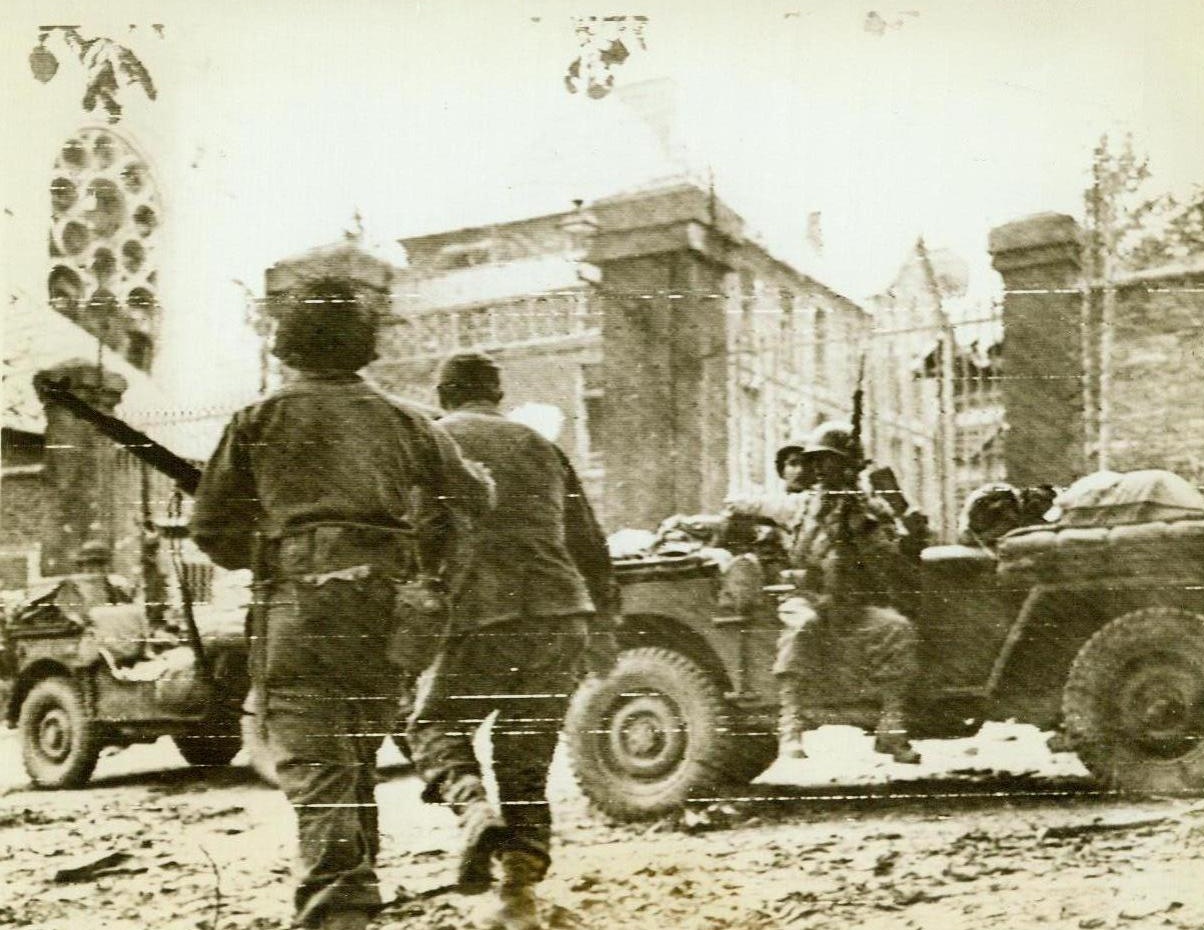
Nazi Captured Under Fire, 7/20/1944. France -- An American soldier (left, foreground) rushes a captured German through the town square in St. Lo, even as the spot was being blasted by enemy artillery. The yank in the jeep at right, points and shouts instructions to the man and his prisoner. 7/20/44 (ACME);
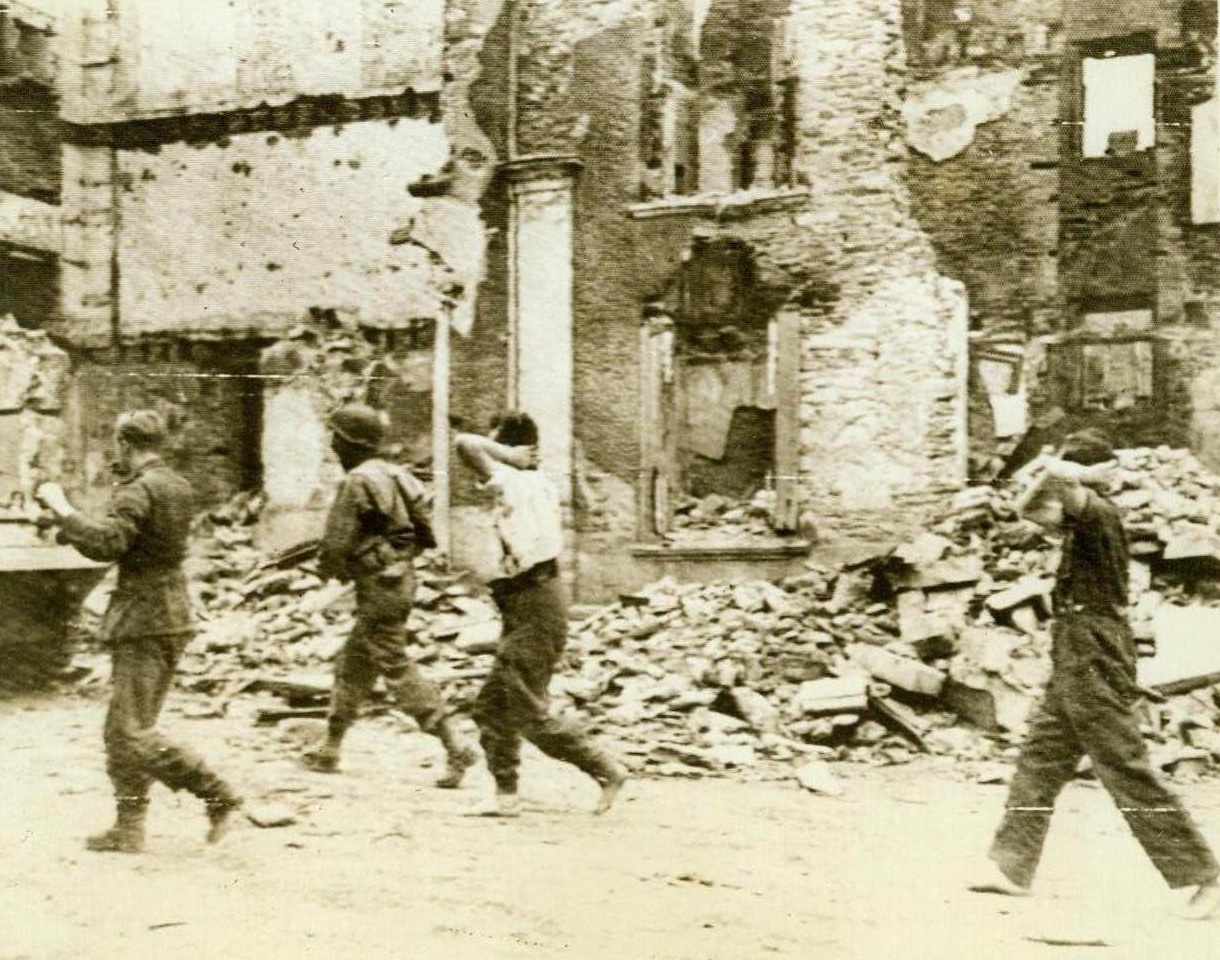
Germans Captured In St. Lo, 7/20/1944. France -- An American Soldier (Second from left, background), herds three Germans through a rubble-strewn street in St. Lo. The prisoners have their hands over their heads and the two at the right are barefooted. Photo as taken as Yanks wrested the town from the enemy. 7/20/44 (ACME);
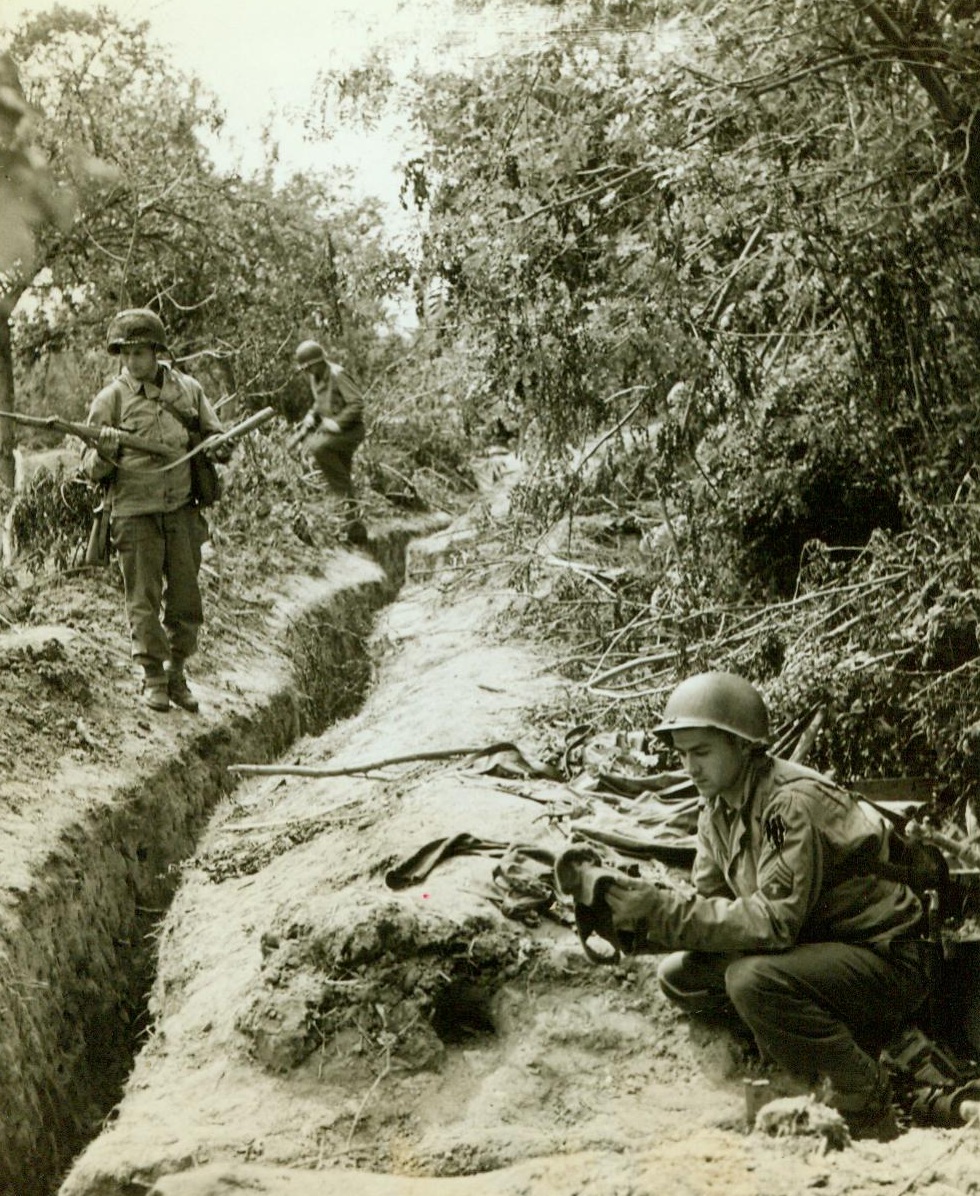
Captured Nazi Trench Near St. Lo, 7/20/1944. France -- Sgt. Thomas McMullen (foreground) of Maplewood, N.J., and Cpl. Leonard Redeyoff, Philadelphia, Pa., examine Nazi defenses in a trench hidden by a hedge in the St. Lo. sector of France. Trench was taken by Yank troops after bitter Nazi resistance had been quelled. Hedgerows around St. Lo provide perfect cover and makes it easy for the Germans to defend any given area. 7/20/44 (ACME);
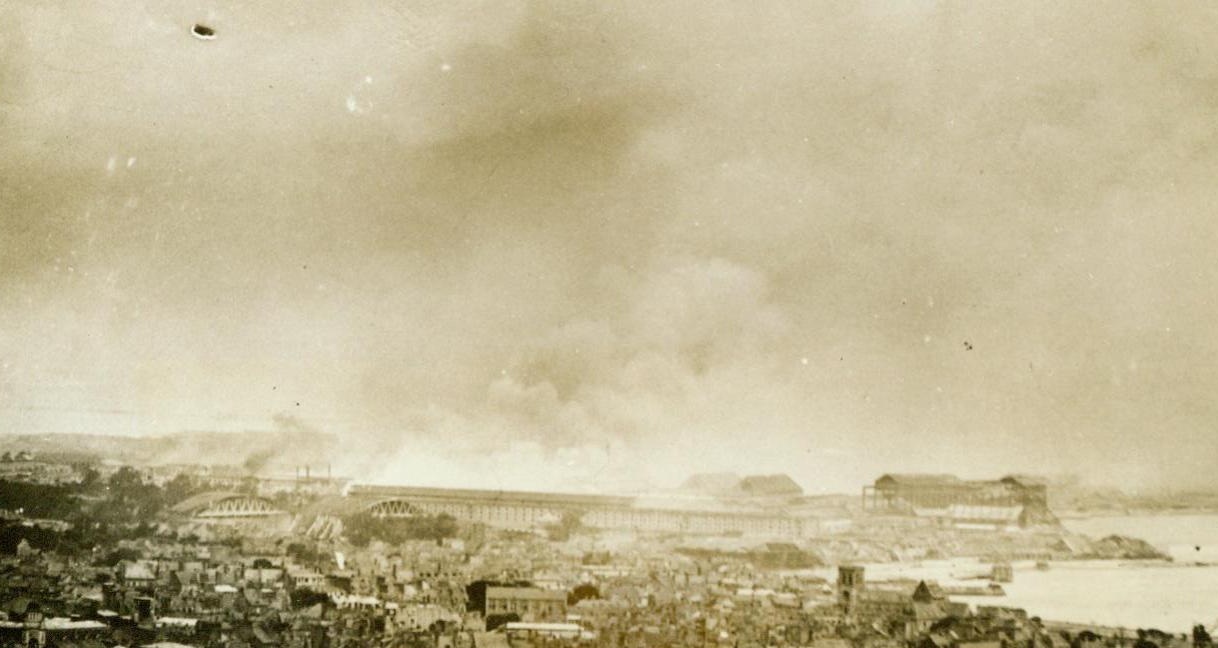
Battle Smoke Over Cherbourg, 7/1/1944. Cherbourg, France – This is a good general view of the port city of Cherbourg. Looking over the harbor as the American troops gradually closed in through the streets. Bomb-torn houses can be seen in the foreground, and smoke rises in the rear from German demolition and artillery fire. 7/1/44 (ACME Photo By Andrew Lopez, War Pool Correspondent);
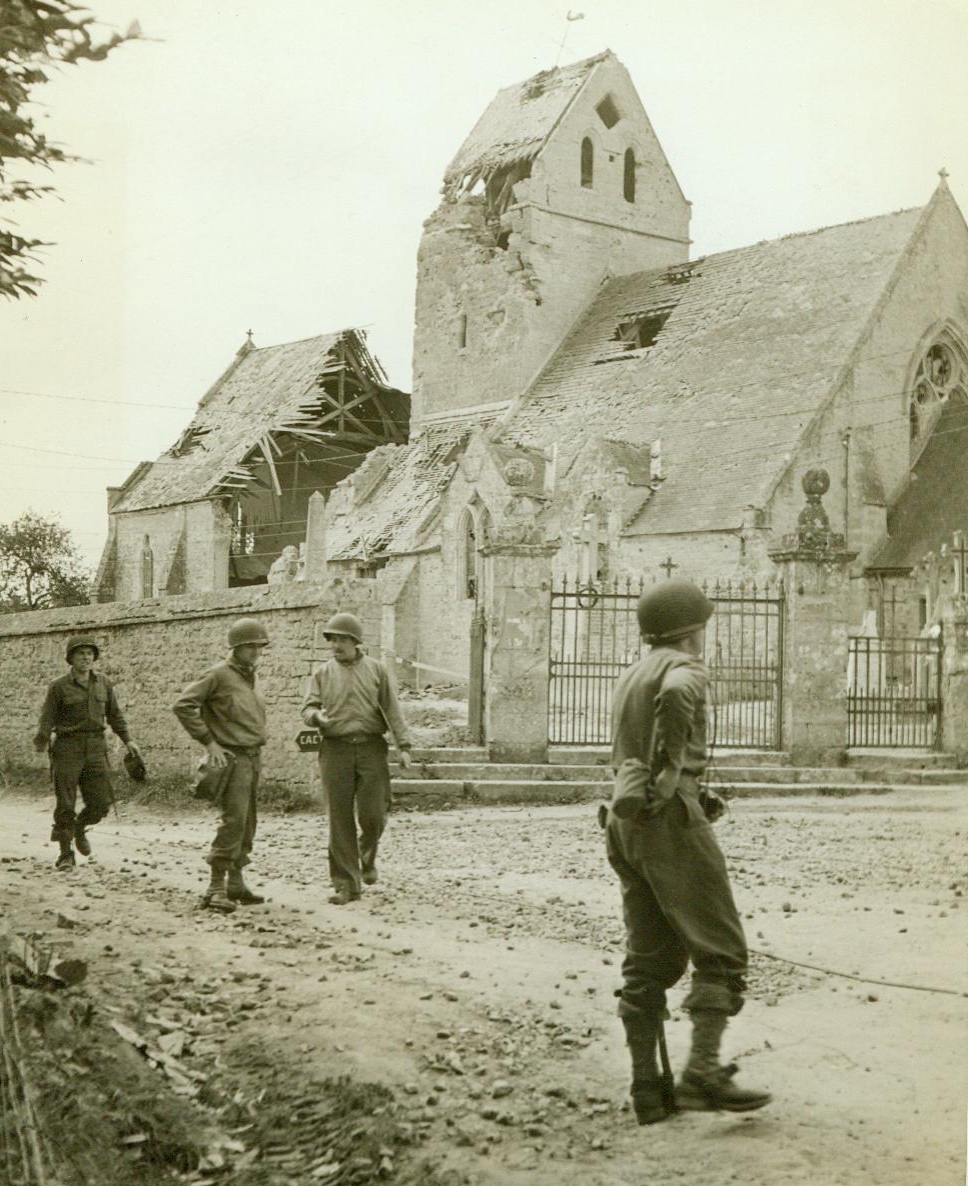
Ruined Church Near St. Lo, 7/20/1944. France – American soldiers in the St. Lo sector of France examine a church battered by shell fire. Nazis often use the steeple of churches for observation posts. 7/20/44 (ACME Photo By Bert Brandt, War Pool Correspondent);
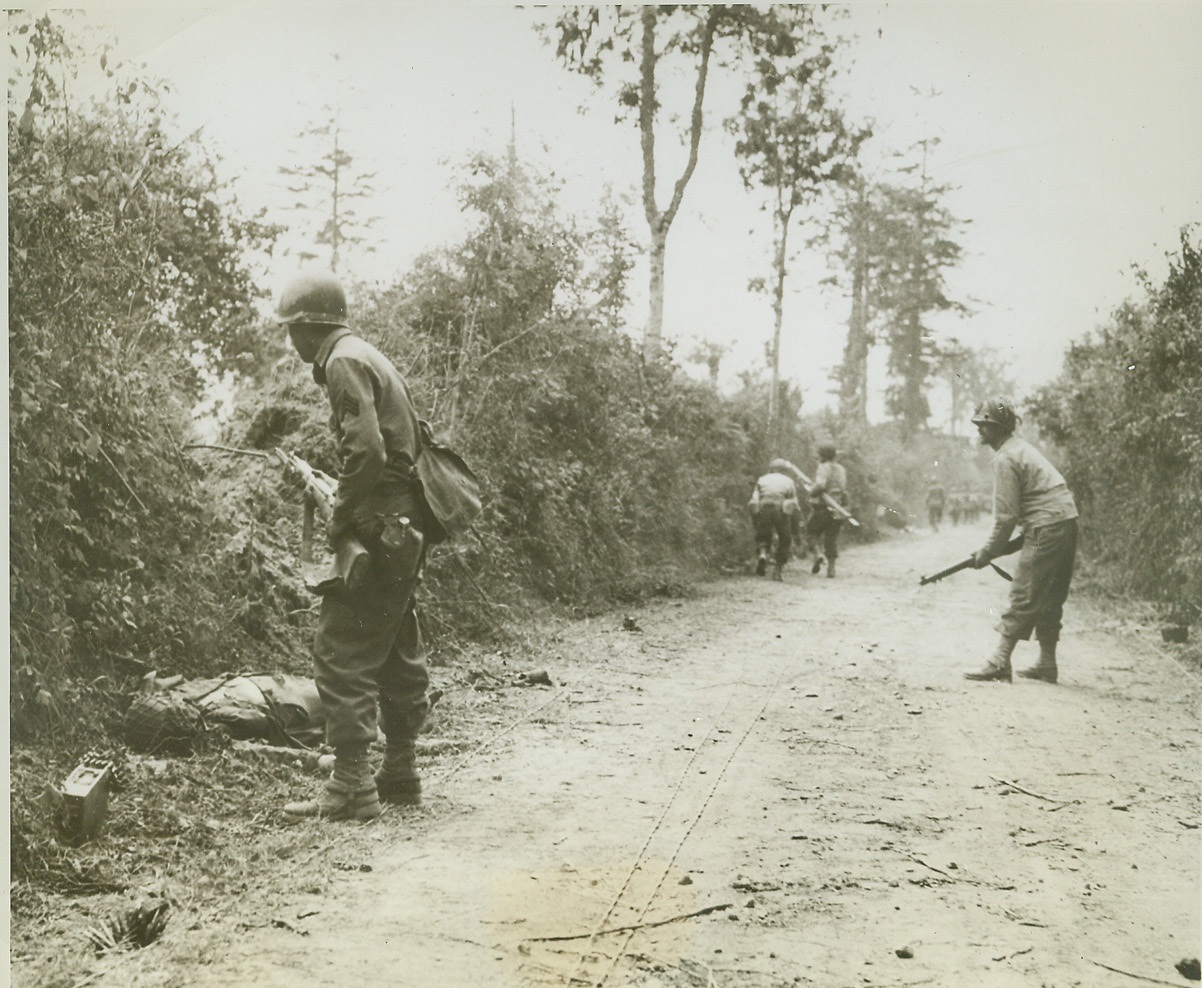
They Must Move Forward, 7/25/1944. FRANCE -- Despite the fact that one of their buddies has been killed by enemy fire, these U.S. Infantrymen continue their advance, carefully watching hedgerows for lurking snipers. Note wires put down along the road by Signal Corpsmen. Photo was taken near St. Lo. Credit: (U.S. Signal Corps Photo from ACME);
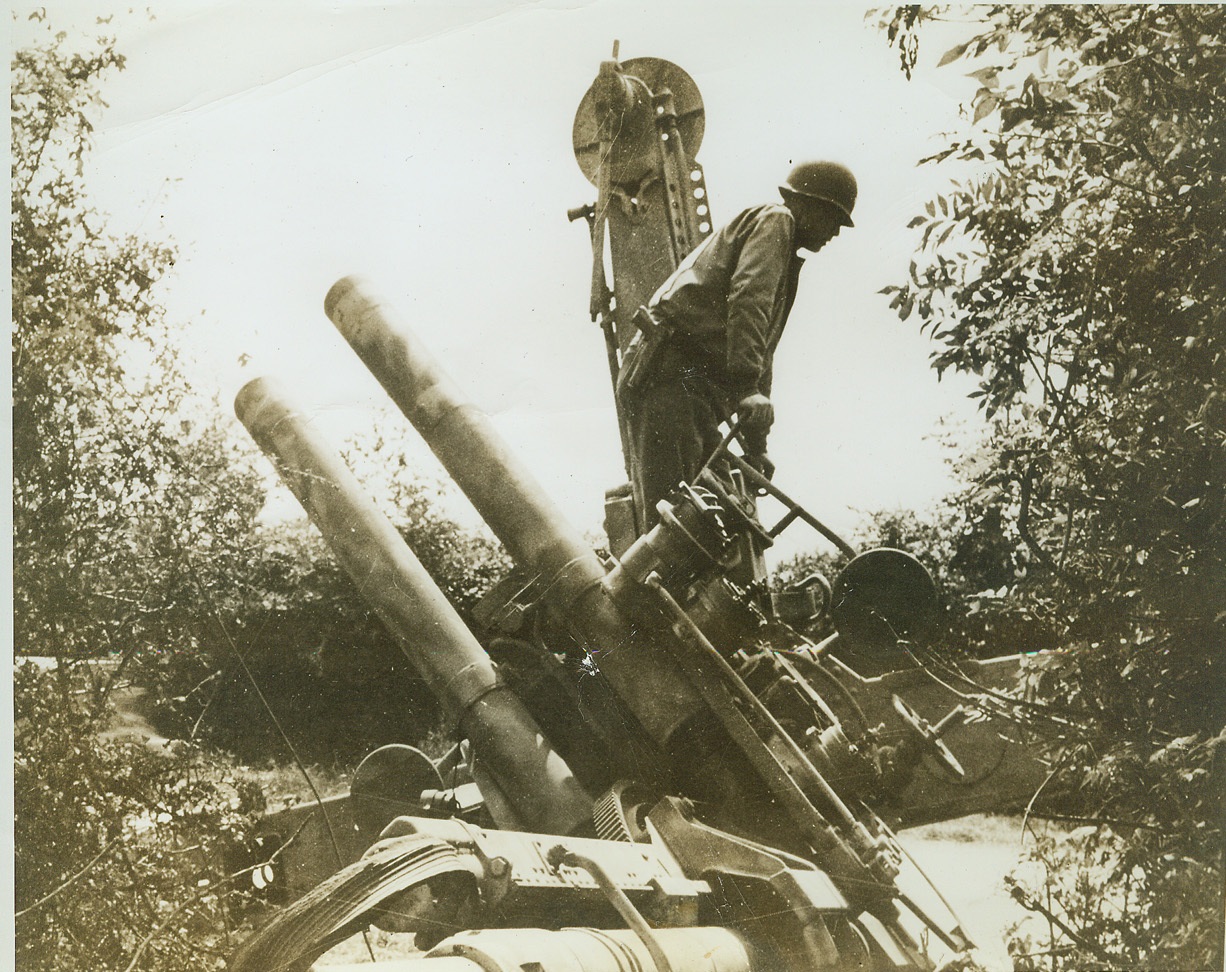
Two Halves Won't Make a Whole, 7/25/1944. NORMANDY, FRANCE -- Nazis fleeing before the American advance in Normandy, paused long enough to do an efficient job of smashing their 88mm gun (above) in halves before they abandoned it. Maj. James Owen, Junction City, Tex., examines the remains of the gun. Credit (ACME) (WP);
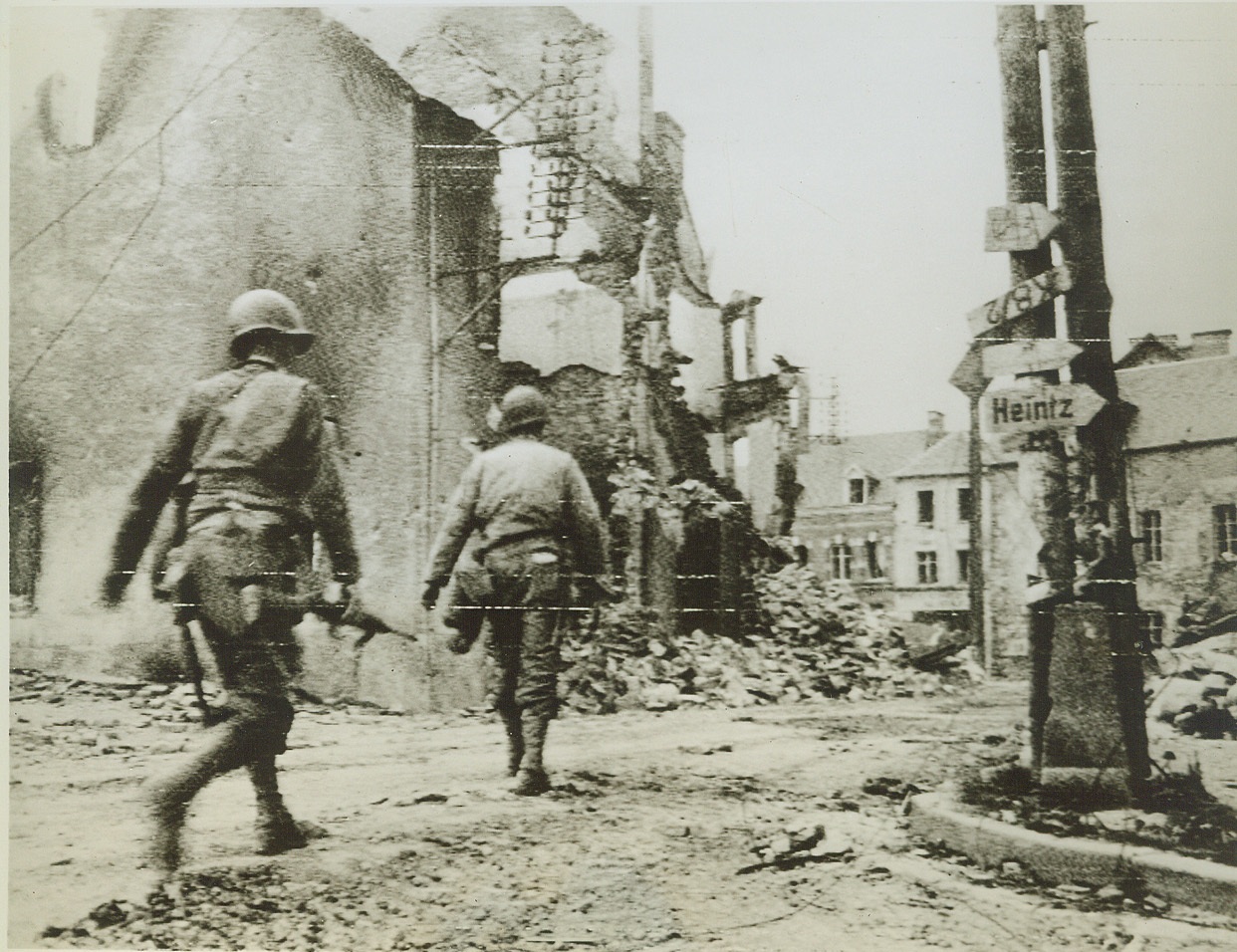
Yanks Mop Up In Marigny, 7/29/1944. France—American soldiers cautiously advance through the ruins of Marigny, France, on the look out for enemy snipers. Last pockets of resistance in the town have been cleaned out by mopping up units. Credit: Signal Corps radiotelephoto by ACME;
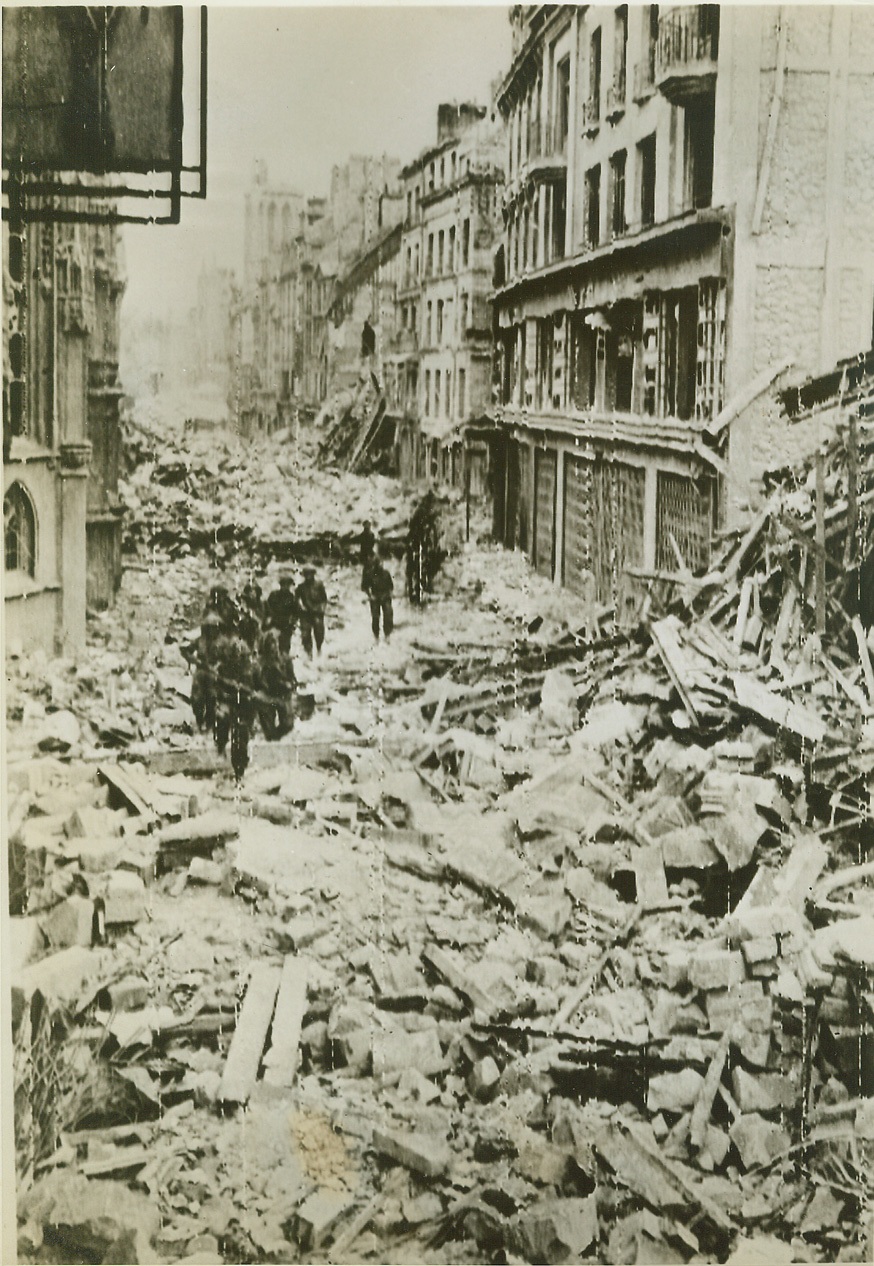
Shambles At Caen, 7/11/1944. France—Its streets filled with the rubble of blasted buildings, Caen presents a desolate picture to Canadian troops entering the city after its capture last July 6th. Here, they advance in single file, their guns ready for instant use against snipers. Today, Germans counterattacked viciously in the Caen sector, temporarily slowing the Allied advance. Credit: Canadian Army photo via U.S. Army radiotelephoto by ACME;
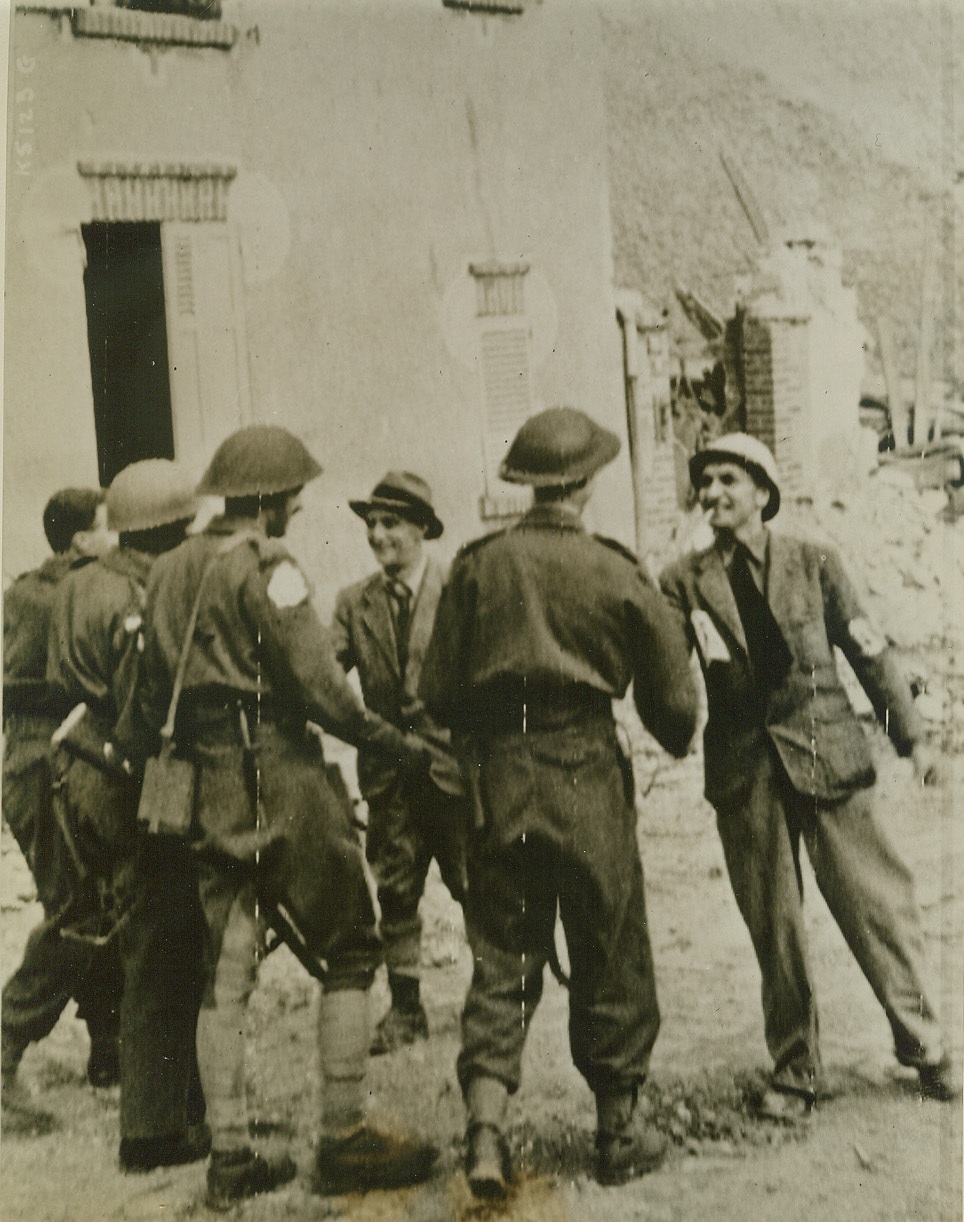
Hearty Welcome to Caen, 7/11/1944. France—With broad smiles on their faces, Capt. Gille (left), President of the Calvados Committee for Liberation, and M. Dauvre (right), Prefect of Calvados, (both men facing camera), rush forward to welcome the first British troops to enter Caen. Credit: Army radiotelephoto from ACME;
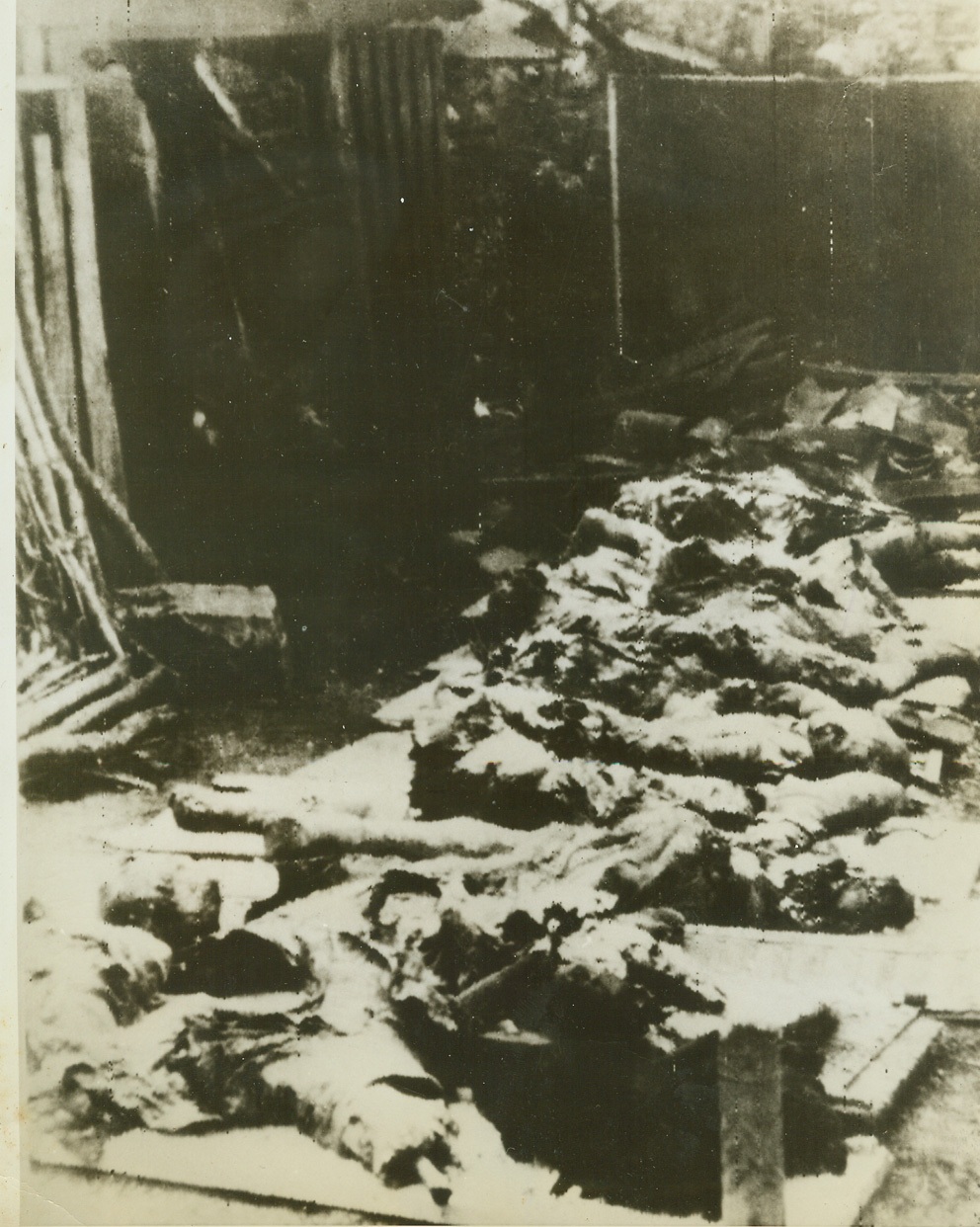
Nazis Make French Town Another Lidice, 7/22/1944. France—In this radiophoto smuggled out of occupied France and received in New York from London tonight, badly mutilated bodies of civilians of Oradour, France, give evidence of the Nazi terrorism which turned the town into another lidice. As Allied liberators advance relentlessly inland, Nazis resort more and more in desperation to ruthless destruction of land, property, and human lives. Credit: ACME radiophoto;
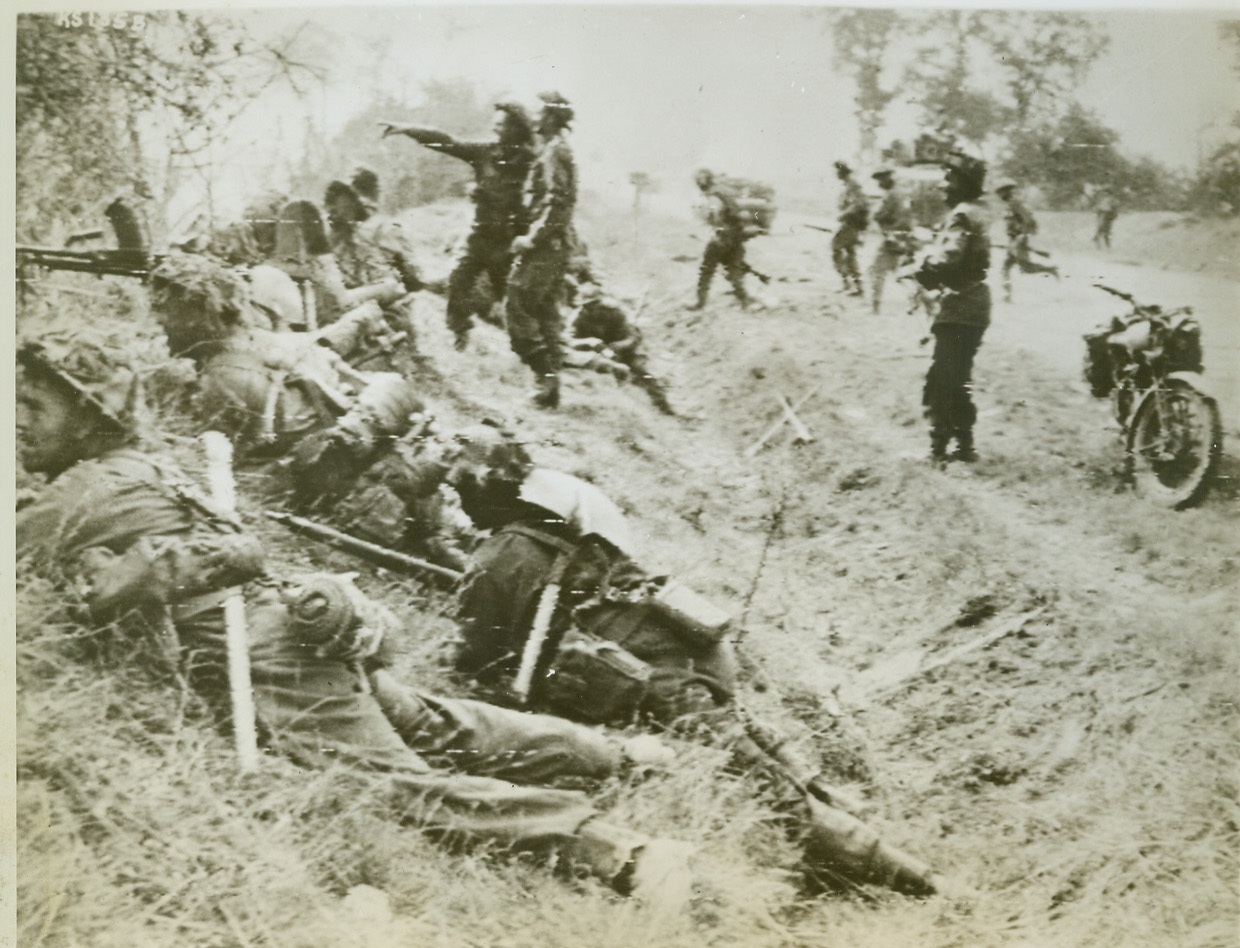
British Attack During Caen Break Through, 7/21/1944. France—Using a ditch for cover, a group of British soldiers attack from a roadside near Cagny, France. Attack was part of the great break through beyond Caen. Credit: British war office photo via Signal Corps radiotelephoto from ACME;
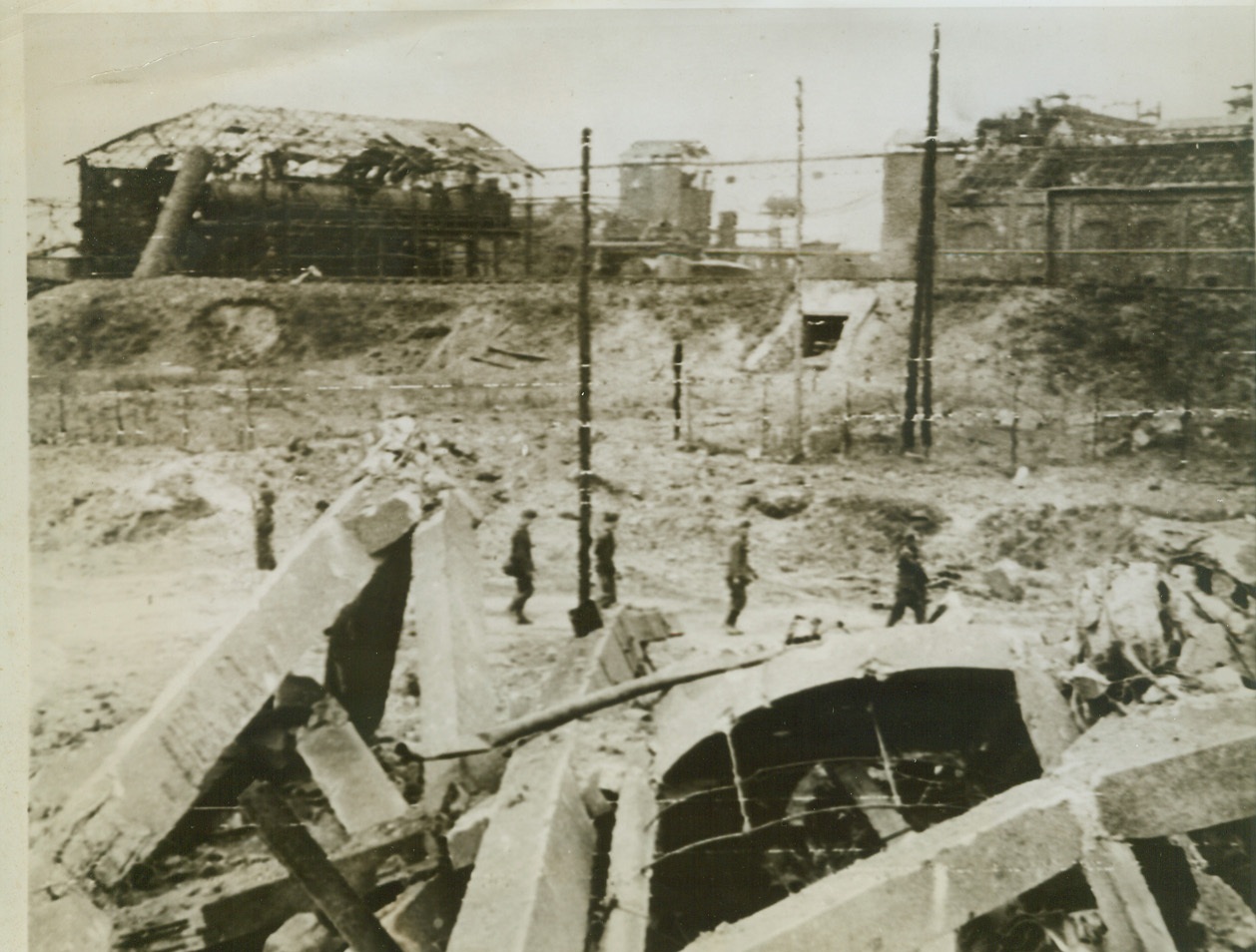
Nazi Prisoners and Desolation, 7/21/1944.France—Captured in the great Allied break-through beyond Caen, Nazi prisoners file dejectedly past the ruins of a water tower that was part of a factory in the industrial area outside Caen. Entire area is a mass of ruins as a result of the awesome artillery barrages that swept the territory. Credit: British war office photo via Signal Corps radiotelephoto from ACME;
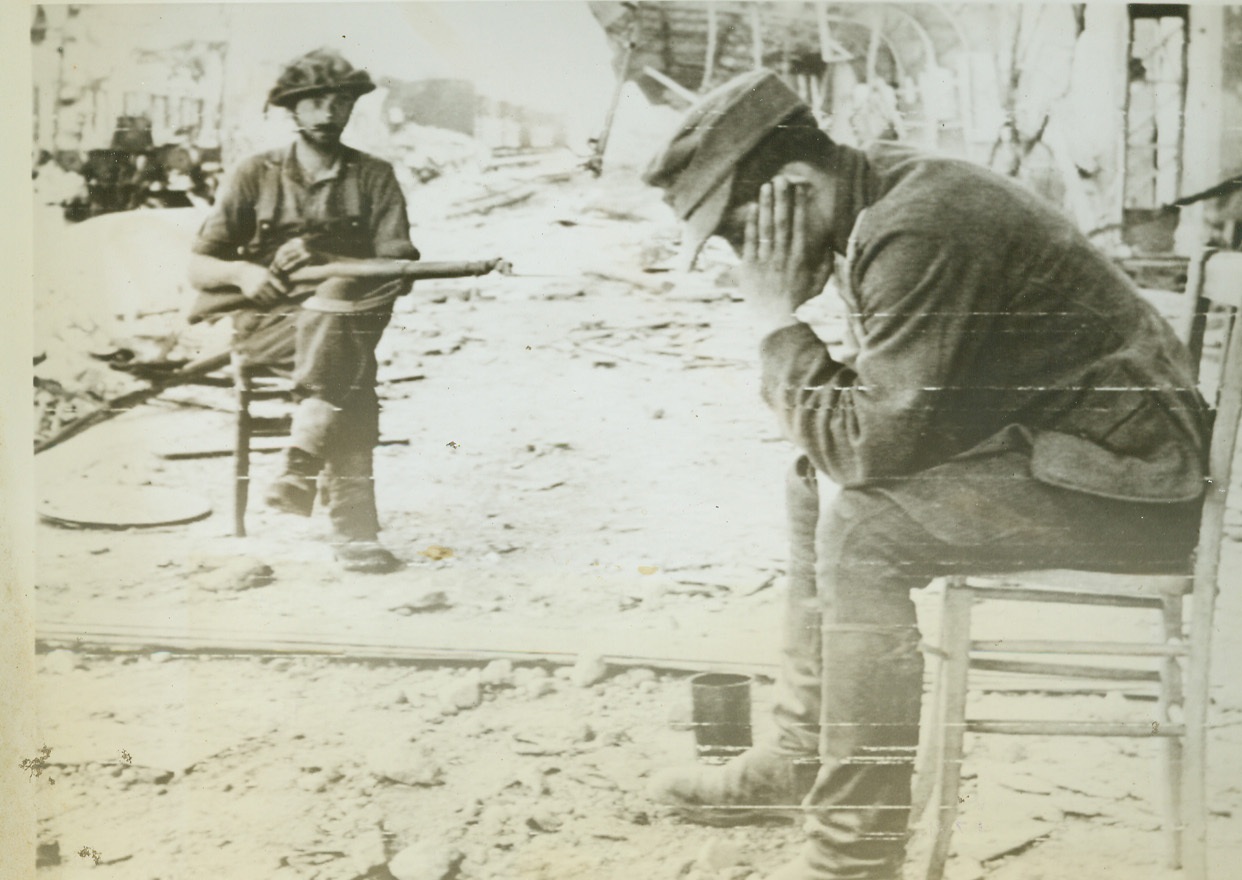
What A Cadache!, 7/23/1944. Caen, France—A weary and dejected Nazi prisoner holds his head in his hands as a Canadian soldier keeps careful watch on him. The prisoner of war cages near Caen are swollen with captives. Credit: U.S. Army radiotelephoto from ACME;
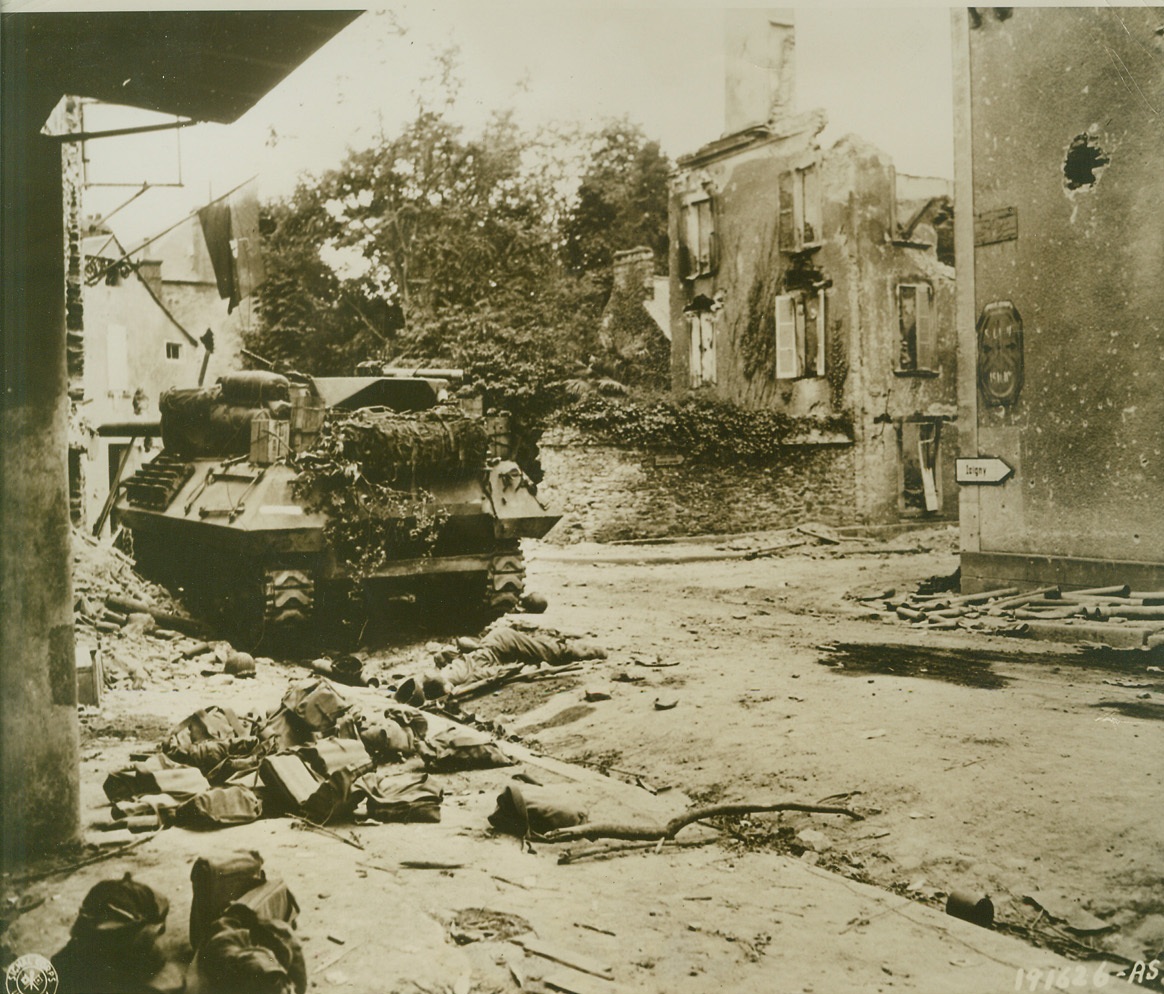
Price of Victory, 7/25/1944. St. Lo, France—A knocked out American tank destroyer, with the body of a dead Yank lying in the road behind it, marks this crossroad in St. Lo, after U.S. forces entered the town. Credit: U.S. Army photo from ACME;
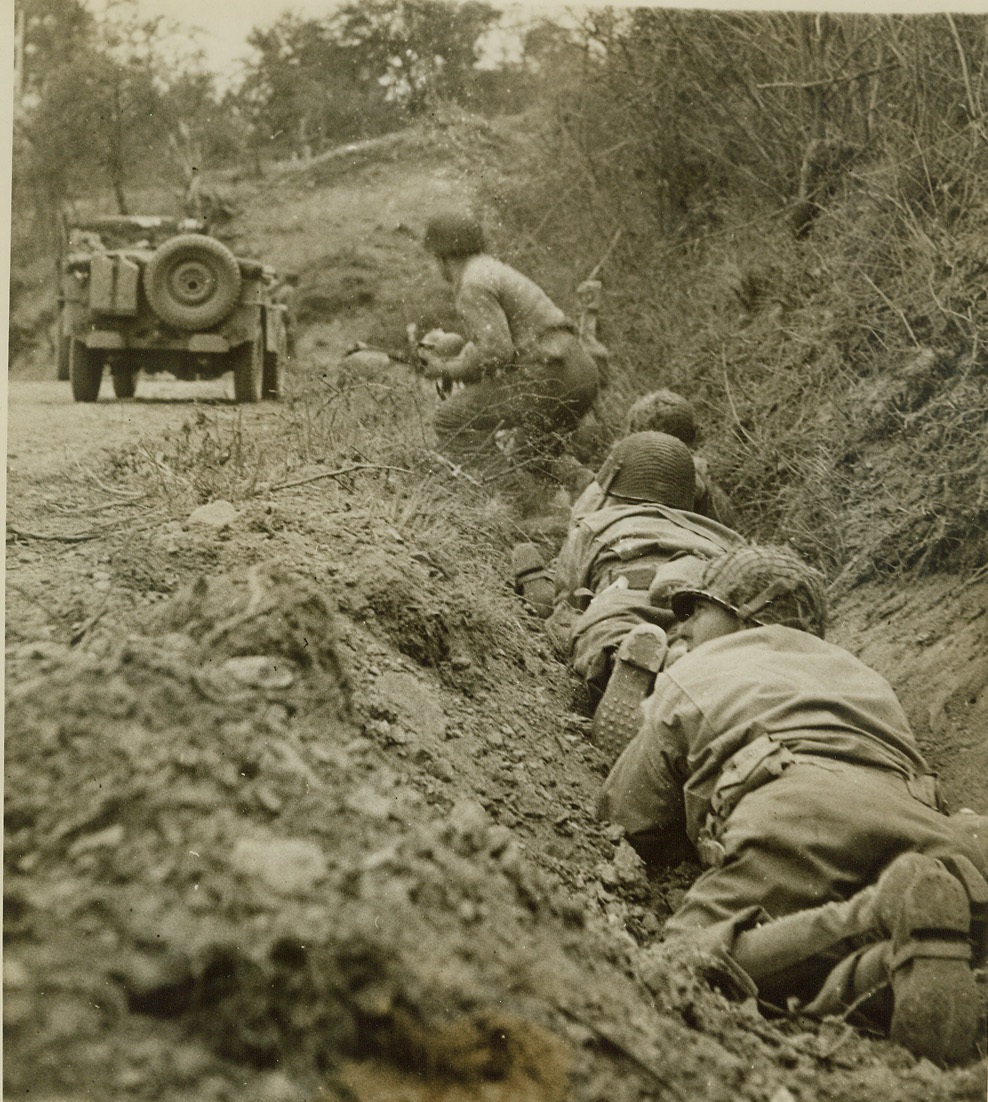
Creeping Up, 7/24/1944. St. Lo, France—In the vicinity of St. Lo, American soldiers inch forward in their foxhole along the side of a road, while they dodge German mortar and machine gun fire. After an eight-day fight, Yank troops captured the town. Credit: ACME photo by Andrew Lopez, war pool correspondent;
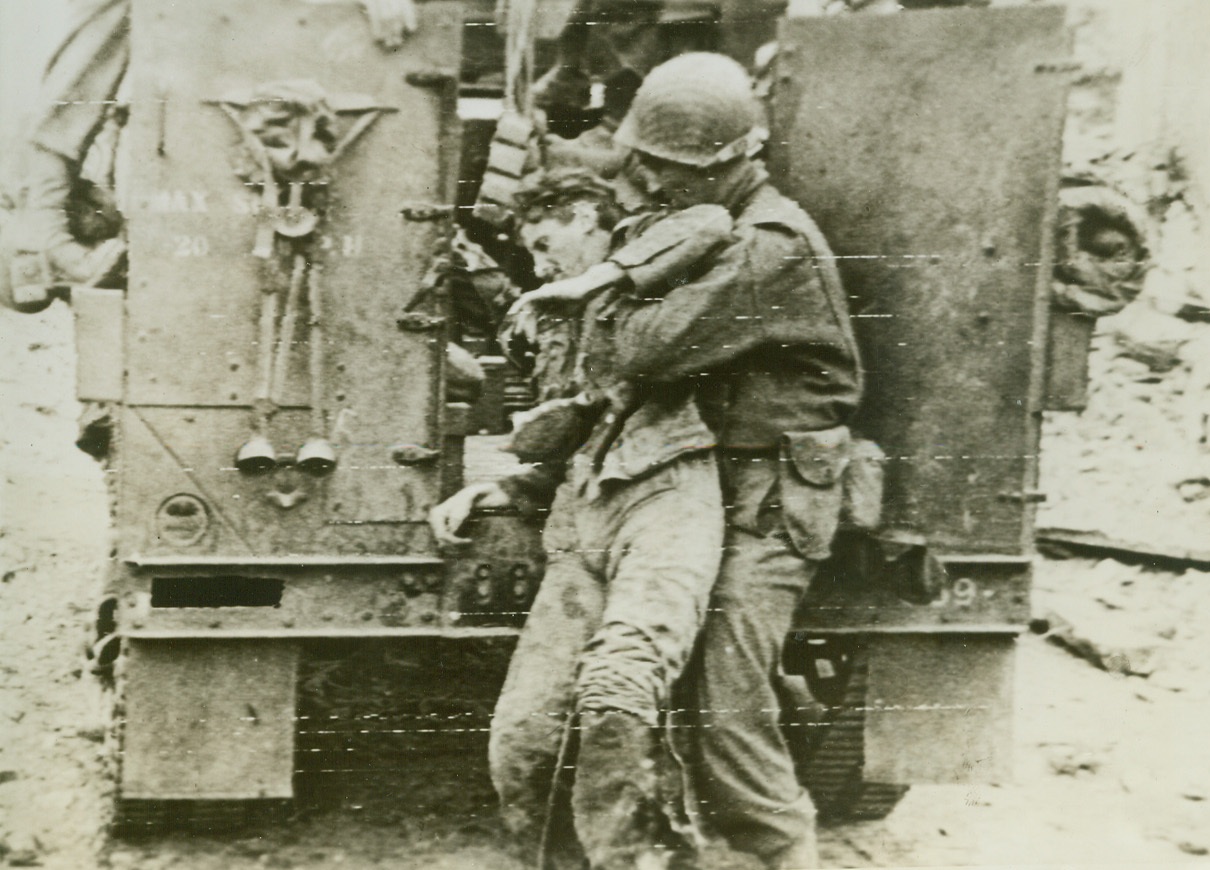
Wounded Nazi Rescued By Yank, 7/22/1944. St. Lo, France—An American soldier picks up a wounded Nazi on the road to St. Lo and puts him in a halftrack after he was abandoned by his comrades. Credit: U.S. Army radiotelephoto by ACME;
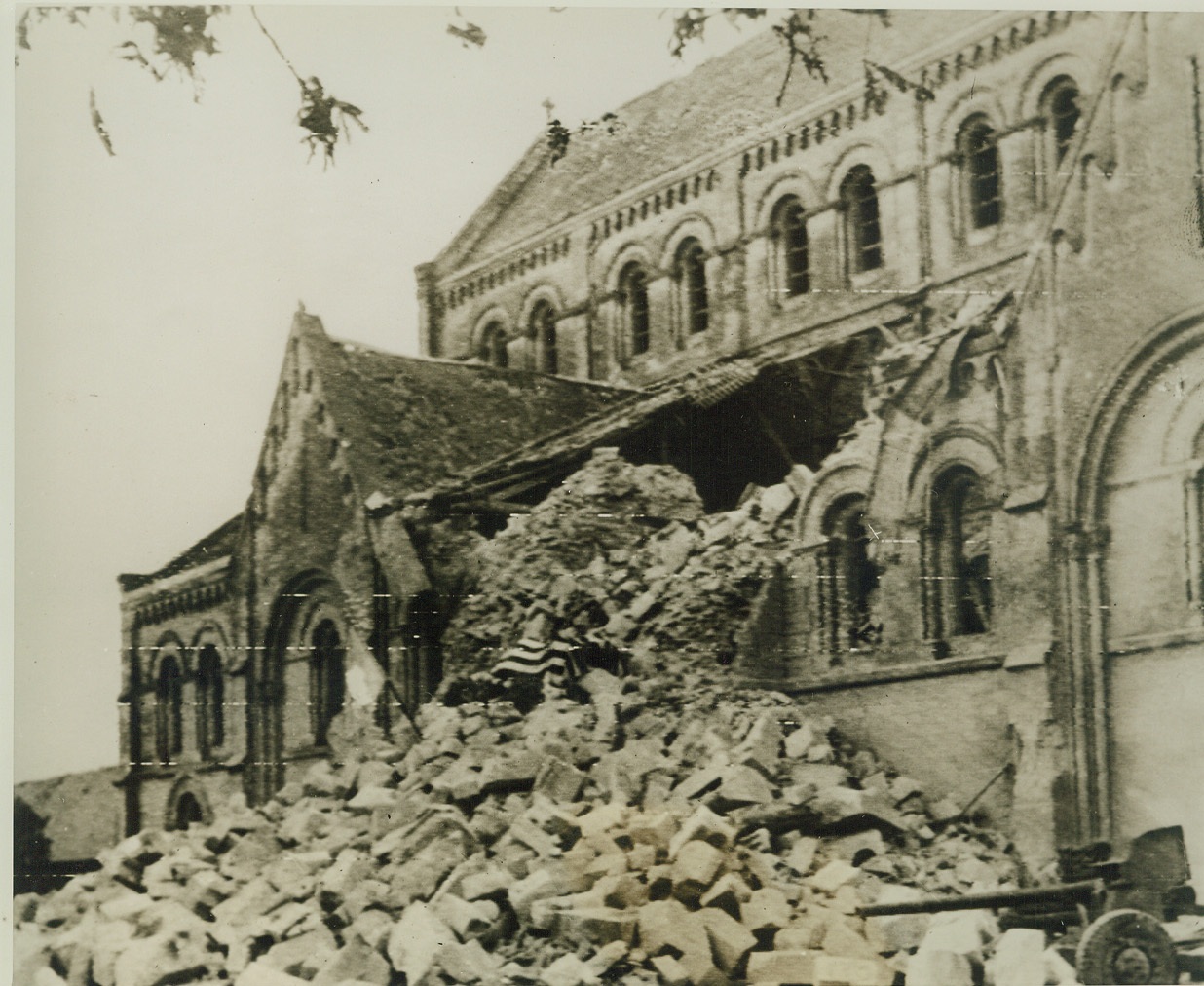
Old Glory Marks Victory At St. Lo, 7/20/1944. France—An American flag (center) has been placed amid the ruins of Holy Cross Church in this important Normandy city, marking the defeat of Germans by U.S. forces. Note half-buried field gun (lower right). Credit: ACME photo via Army radiotelephoto;
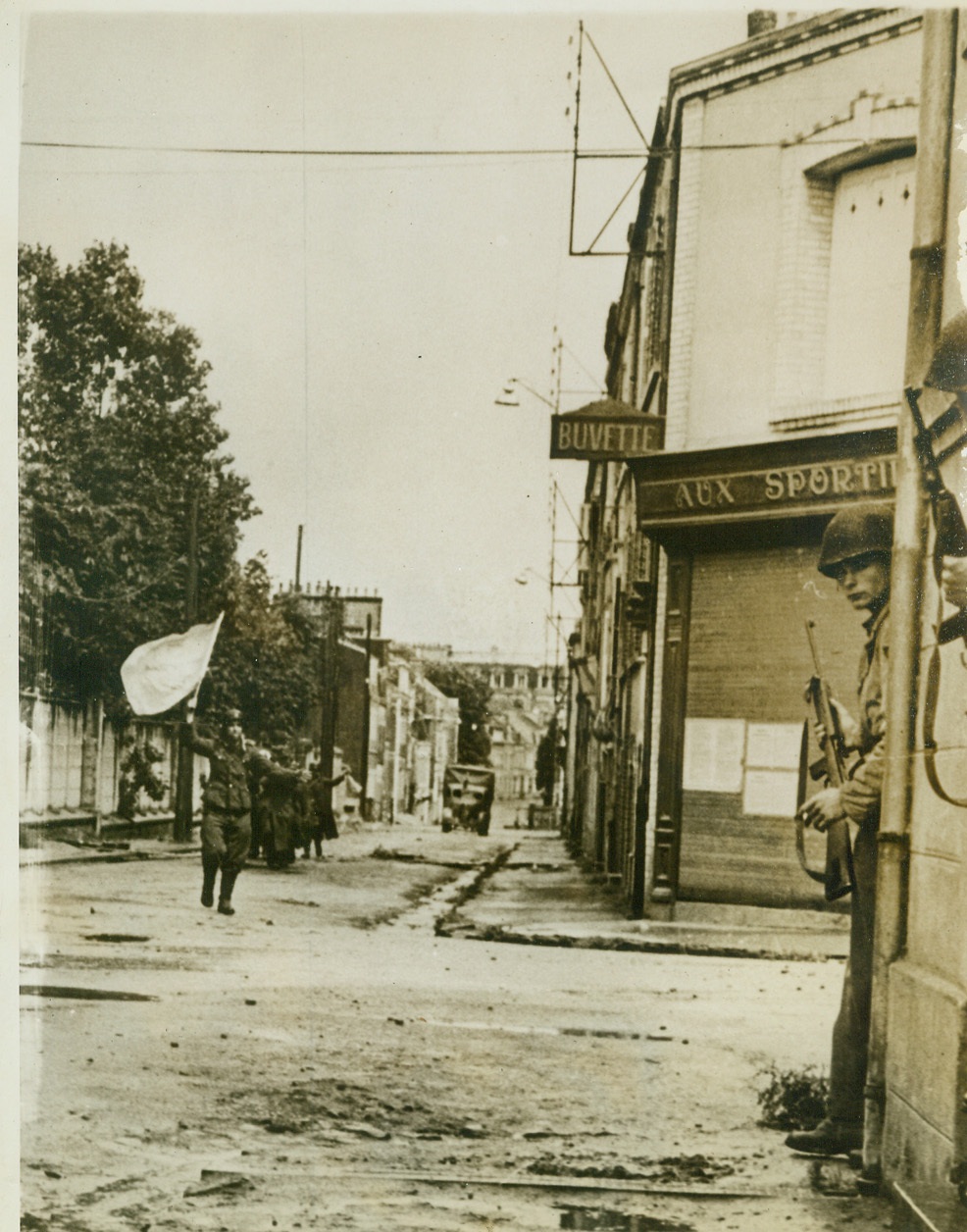
Nazis Show Their Colors, 7/1/1944. France—Defenders of a pillbox guarding a street in Cherbourg, German soldiers surrender, waving a white flag, after being knocked out of their position by Allied tank fire. Soldiers in doorway of building at right keep guns on the ready on the look out for any escape moves. Nazis carry their own wounded as they move dejectedly in defeat with their destination prison compounds. Credit: ACME;
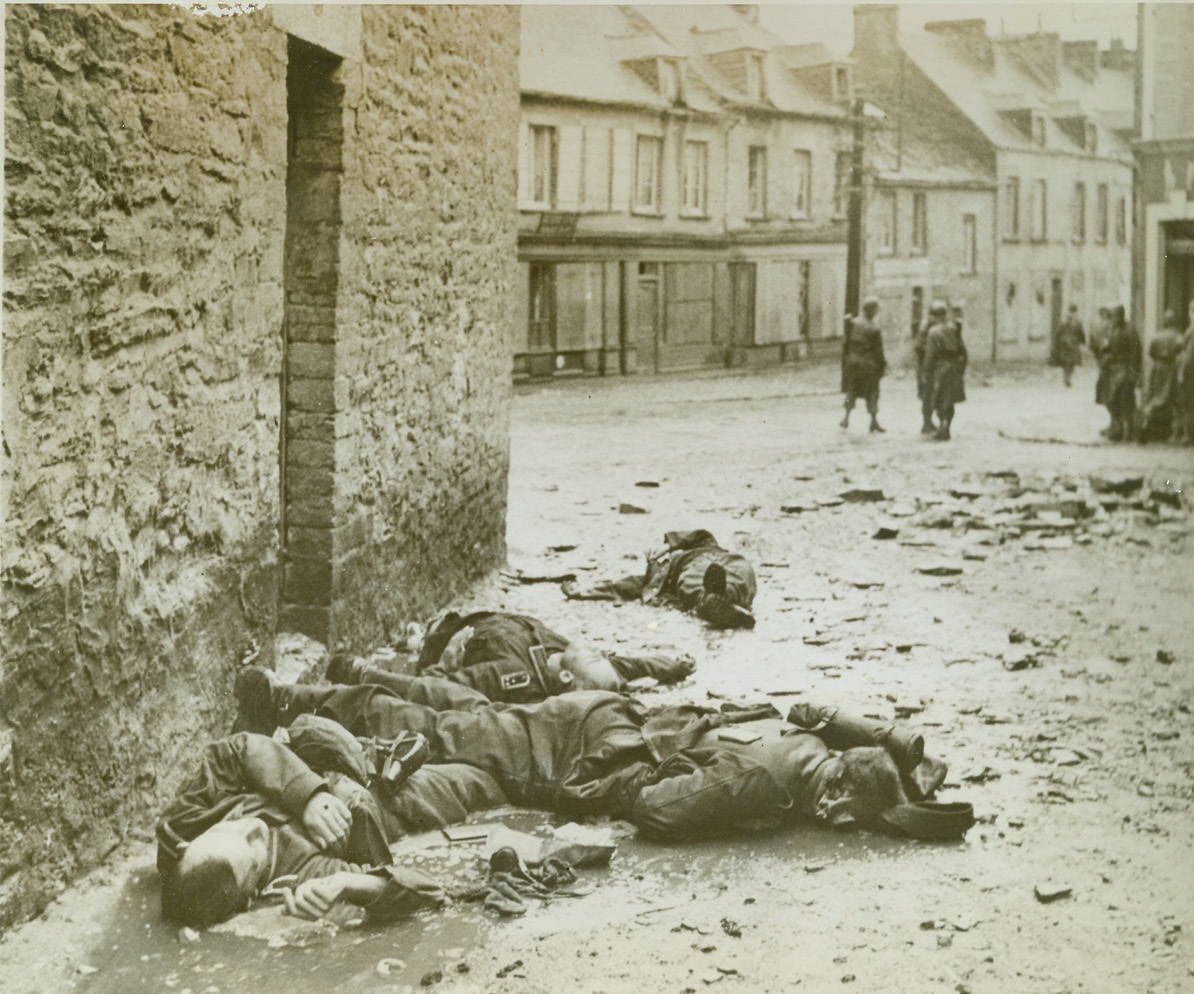
Cherbourg Defense Ends in Death, 7/1/1944. Cherbourg, France—Lying in a pool of muddy water, these Germans died as they tried to defend Cherbourg against the terrific onslaught of American forces. Their death was to no avail, for Cherbourg fell in inglorious surrender. Credit: ACME photo by Bert Brandt, war pool correspondent;
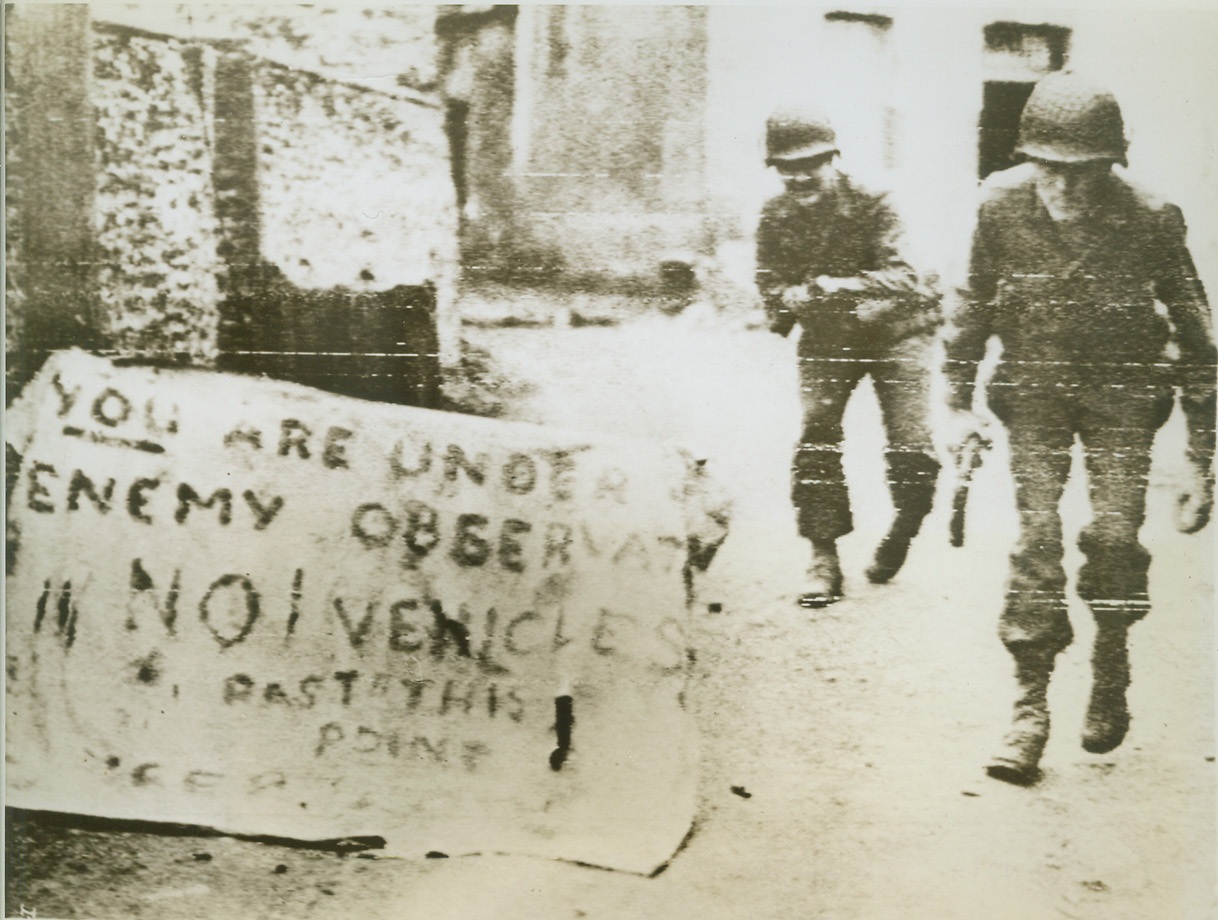
A Word To The Wise, 7/13/1944. France—Heeding the warning of this sign “Somewhere in Normandy” which reads, “You are under enemy observation—no vehicles past this point.” Two Yanks crouch low as they race past an exposed position. They are (left to right): Pfc. Russell J. Schoonmaker, of Shelton, Conn., and Pvt. James V. Pappas, Indianapolis, Ind. Credit: Army radiotelephoto from ACME;
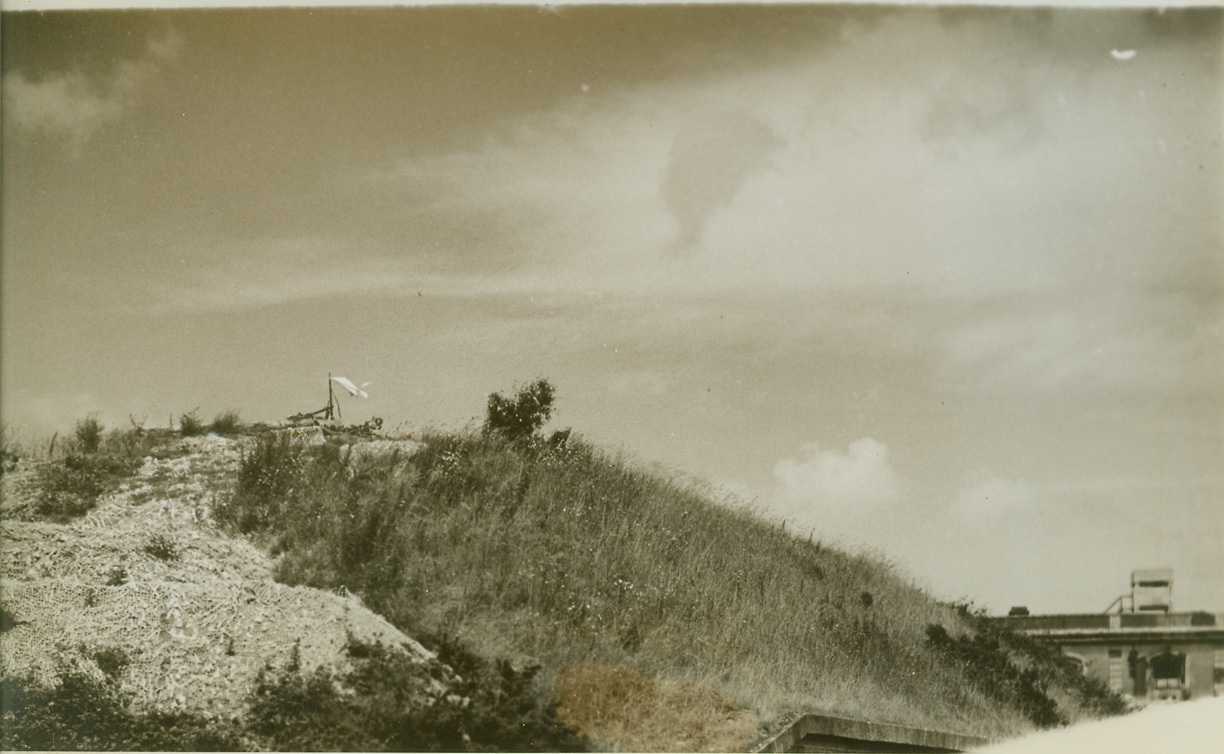
Nazis Surrender Last Cherbourg Fort, 7/8/1944. France—The white flag of surrender waves gracefully in the off-channel breeze as it goes up over a Nazi fortress in Cherbourg. This last pocket of enemy resistance went to the Allied troops only after putting up a terrific battle (passed by censor). Credit: ACME photo by Bert Brandt, war pool correspondent;
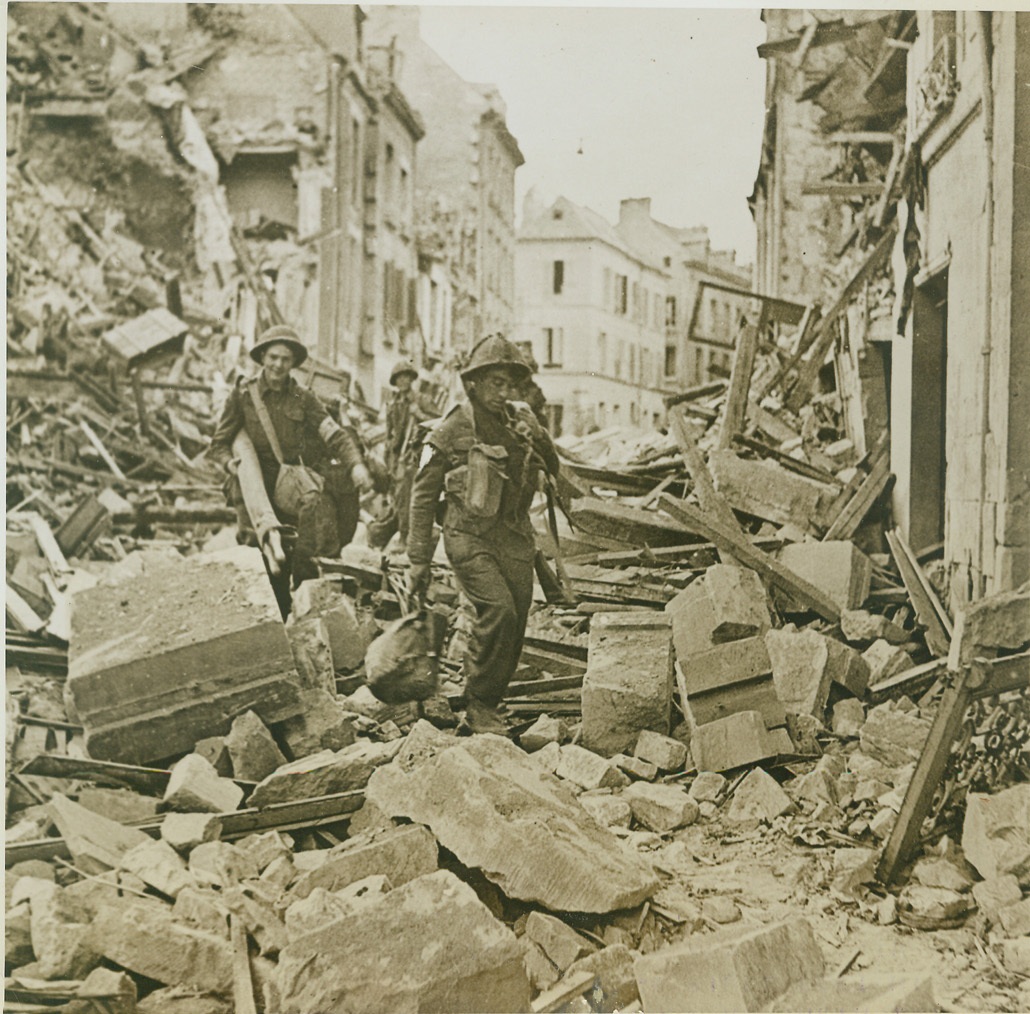
British troops make their way, 7/14/1944. Caen, France—British troops make their way precariously over the wreckage piled feet high in the streets of Caen as they advance into the town following the German retreat. They had to be constantly on the alert as the Nazis had left the streets heavily mined. Note the second Tommy carries a rolled stretcher. Credit: British official photo from ACME;
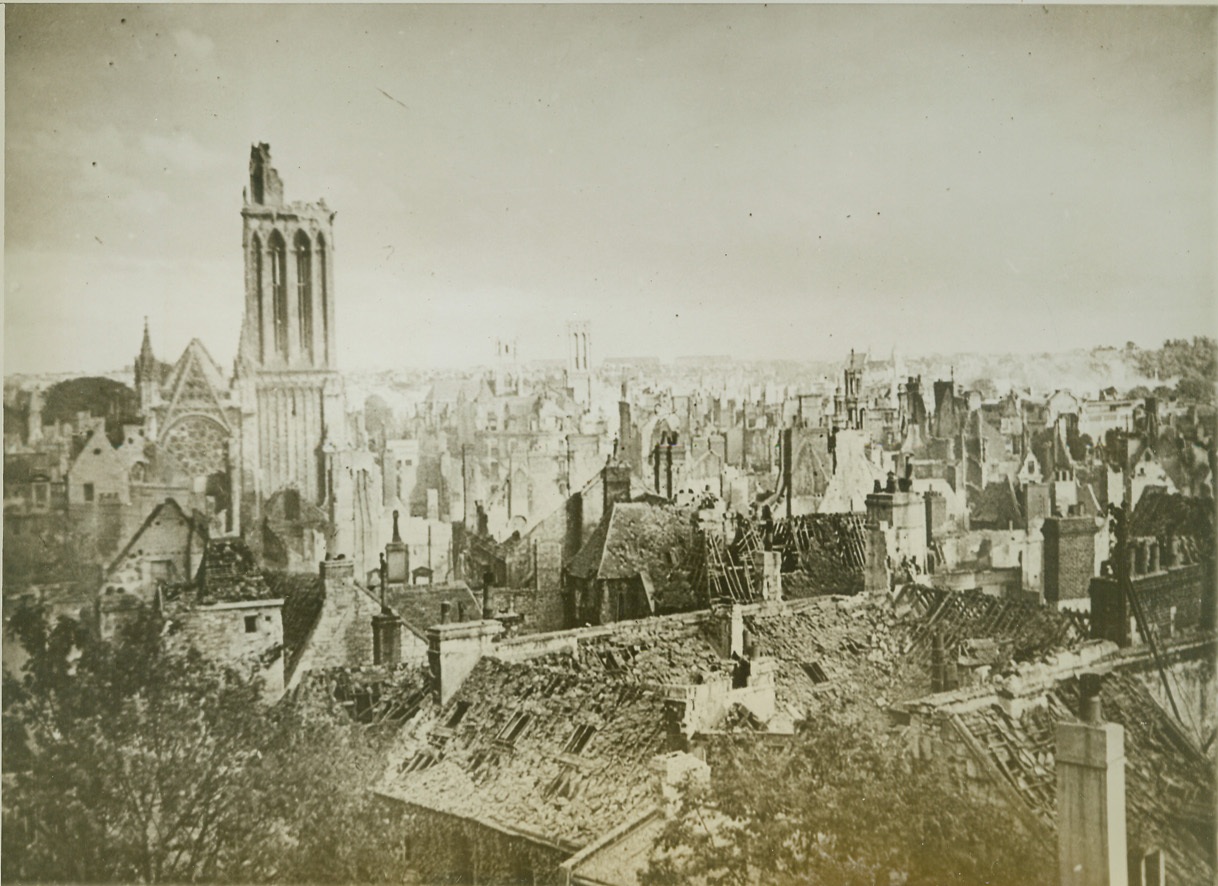
War Struck Here, 7/14/1944. Caen, France—As far as the eye can see, these buildings of Caen have been blasted by shells and bombs or burned as a result of Nazi vandalism. To the left the Cathedral tower, with the top blasted off, stretches bleakly to the sky. This was the sight which greeted British and Canadian troops, entering the city on July 9, on the heels of the retreating Germans. Credit: British official photo from ACME;
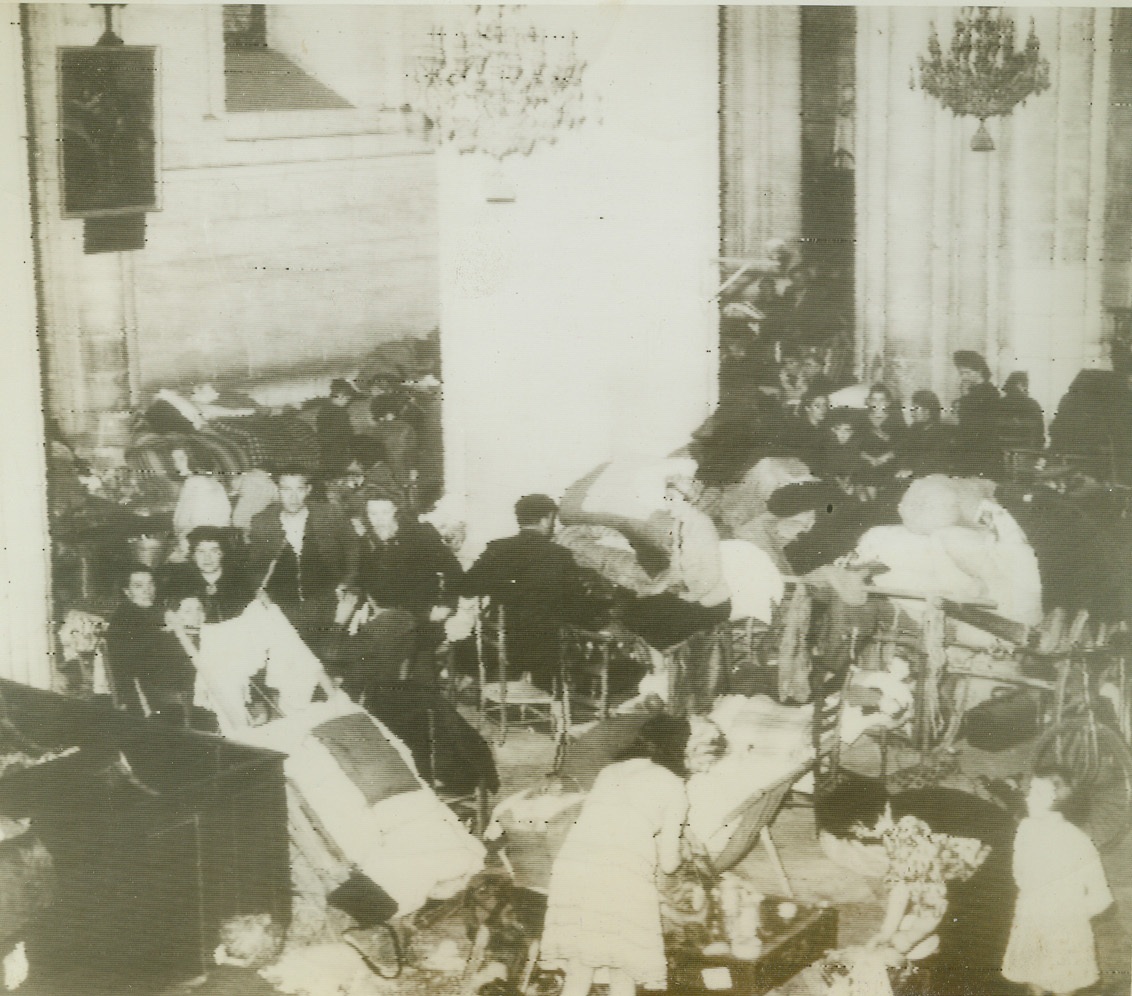
French Refugees Sheltered by Allies, 7/15/1944. Caen, France—Crowded into a cathedral when the British and Canadian forces captured Caen, hundreds of French refugees lived, ate, and slept within their hallowed confines. Now, with mopping-up operations of the city completed, the refugees are being slowly evacuated under Allies care, and those whose homes have been destroyed, will be given shelter elsewhere. Credit: British official radiotelephoto from ACME;
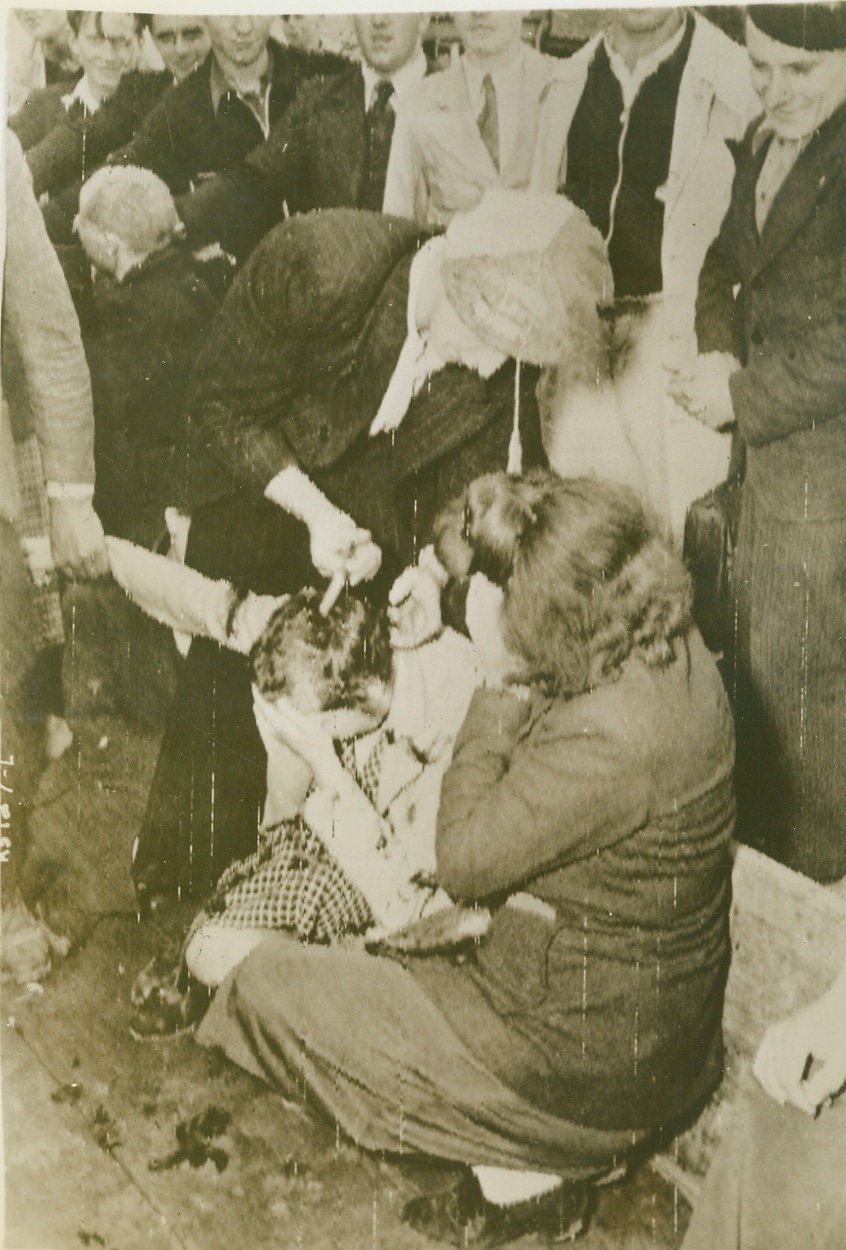
So That All May Know Her Shame, 7/16/1944. Cherbourg, France—Known to have collaborated with the Axis during German rule in Normandy, this Frenchwoman pays the price required of all female friends of the Boche. While loyal natives gather around, one patriot shears the hair from the girl’s head. With other collaborationists, she was later paraded around the streets of Cherbourg. Credit: Signal Corps radiotelephoto from ACME;
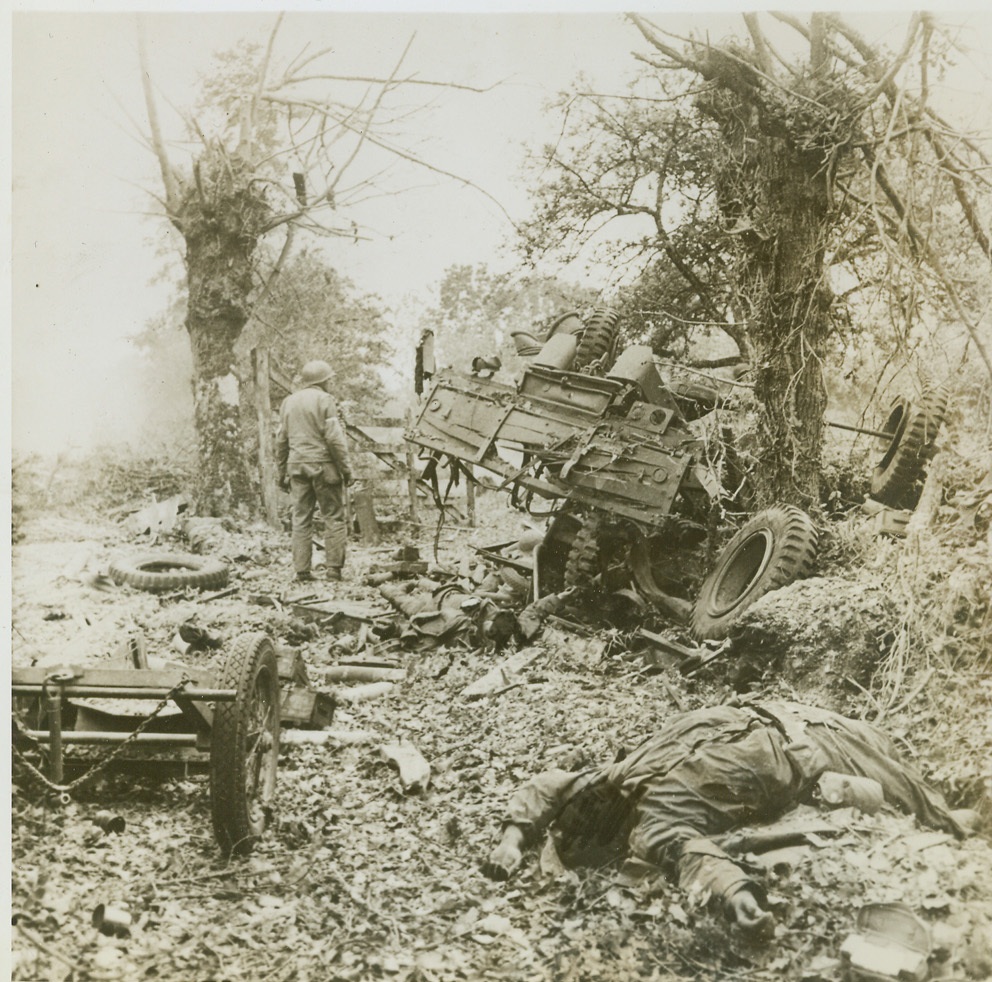
The Price of Victory, 7/13/1944. France—American soldiers lie face turned toward their Maker in death after being hit from mortar shells fired from a Nazi position nearby. Force of the shell’s fire is evidenced by the ruined and upturned Army vehicles in the rear. The price of victory in France is high and the cost is still rising. What better way to lower death tolls and shorten the war than by buying as many war bonds as possible. Credit: ACME;
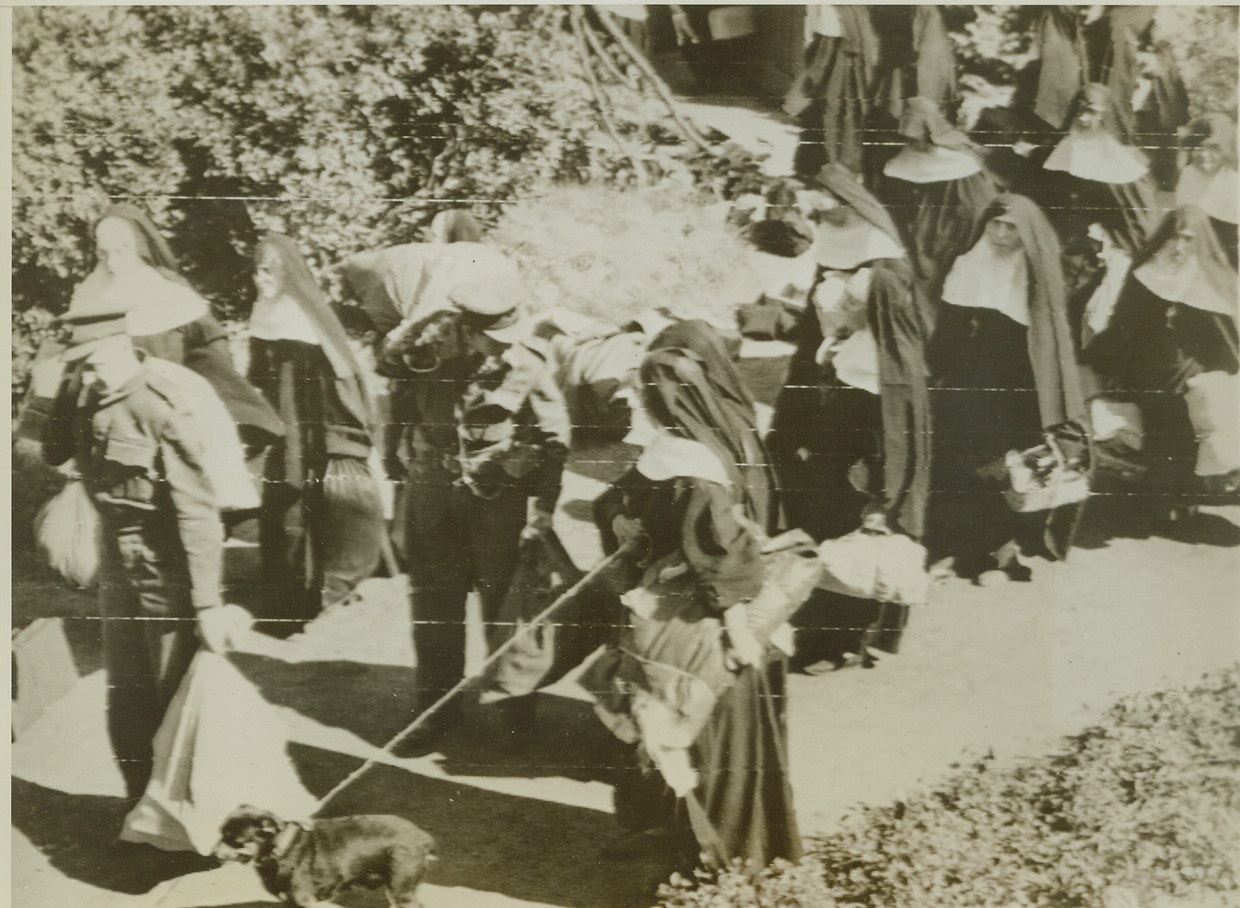
Transported to Safety, 7/16/1944. Bayeux, France—RAF officers carry the luggage of nuns who were transported to liberated Bayeux from the fighting fronts in Normandy. Nearly 100 Benedictine sisters were evacuated from Caen and surrounding areas where fighting was in progress. One of the sisters leads a little dachshund. Credit: British official photo via U.S. Signal Corps radiotelephoto from ACME;
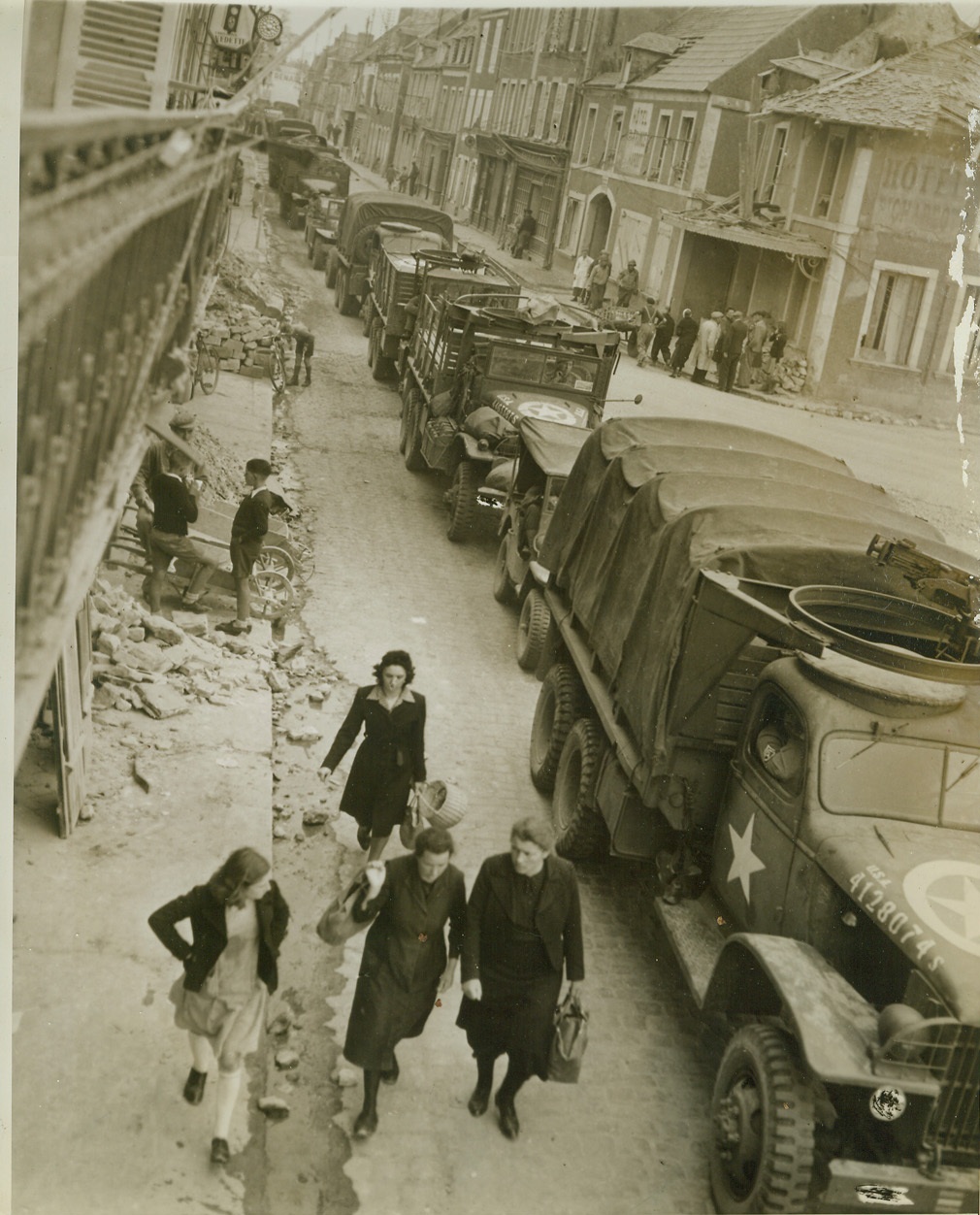
Common Sight, 7/16/1944. Isigny, France—No longer fascinated by the endless column of war supplies woving through their town, for the sight has become a common one by now, natives of Isigny go about their business ignoring the convoy passing beside them. The heavy trucks, on their way to the embattled St. Lo sector, drive slowly through the narrow streets lined with buildings that still bear the scars of war. Credit: ACME photo by Bert Brandt, for the War Picture Pool;
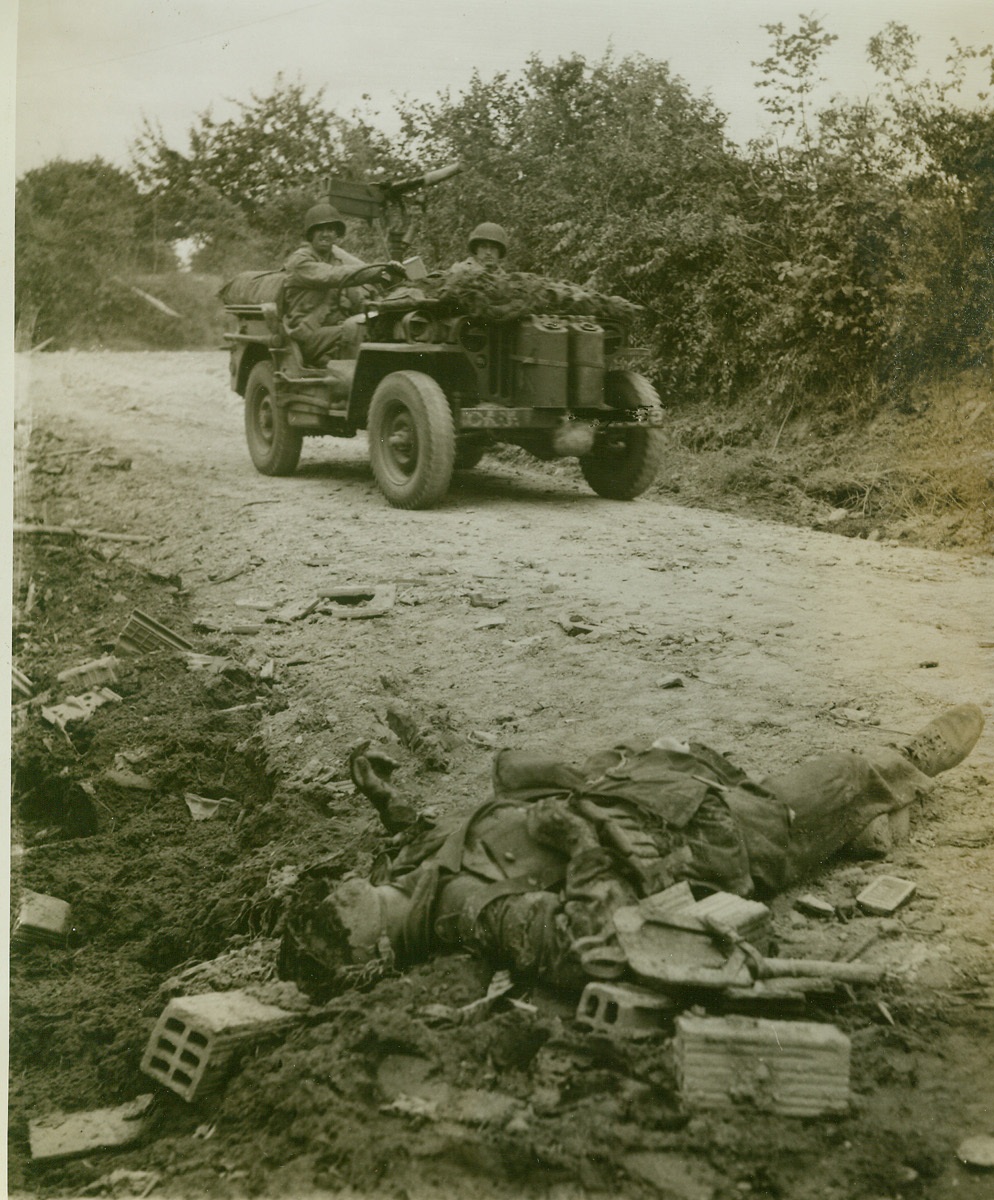
. . . And Sudden Death, 7/16/1944. Normandy—Death came swiftly and violently to this German tanker, who tried in vain to escape when his tank was trapped in the “Lane of Death” in the sector between St. Jean de Dye and St. Lo. His shattered remains lie at the side of a narrow road where 7 tanks, a 46-ton Tiger tank, a number of radio cars, and other German armor were knocked out of the fight. Credit: ACME photo by Bert Brandt, for the War Picture Pool;
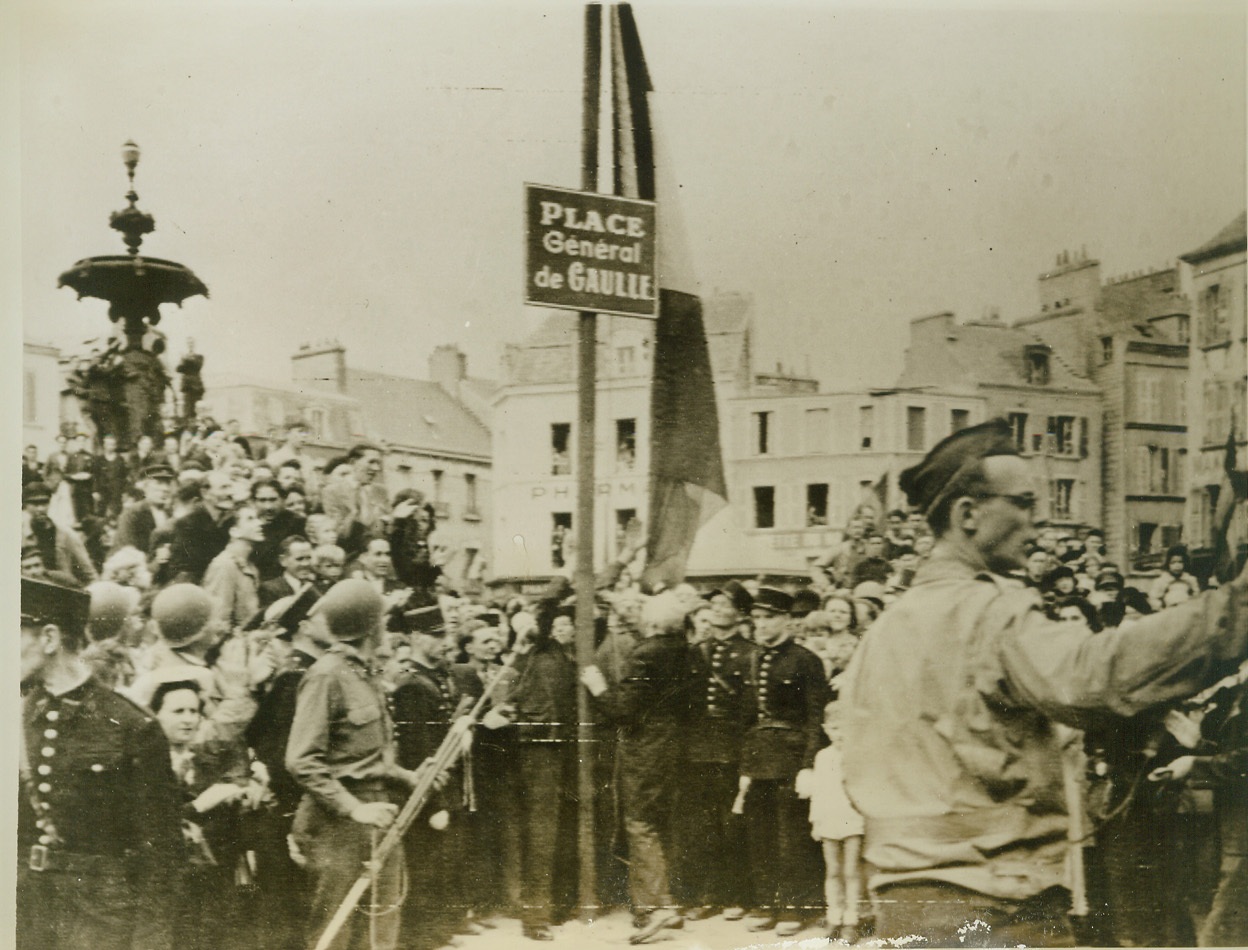
Cherbourg Honors De Gaulle, 7/16/1944. Cherbourg, France—Honoring the general who has carried the banner of French freedom high since the fall of his country in 1940, liberated Cherbourg has renamed its city square. During Bastille Day ceremonies marking the anniversary of French independence, the mayor of Cherbourg unveils the plaque naming the square “Place General de Gaulle.” Credit: Signal Corps radiotelephoto, ACME;
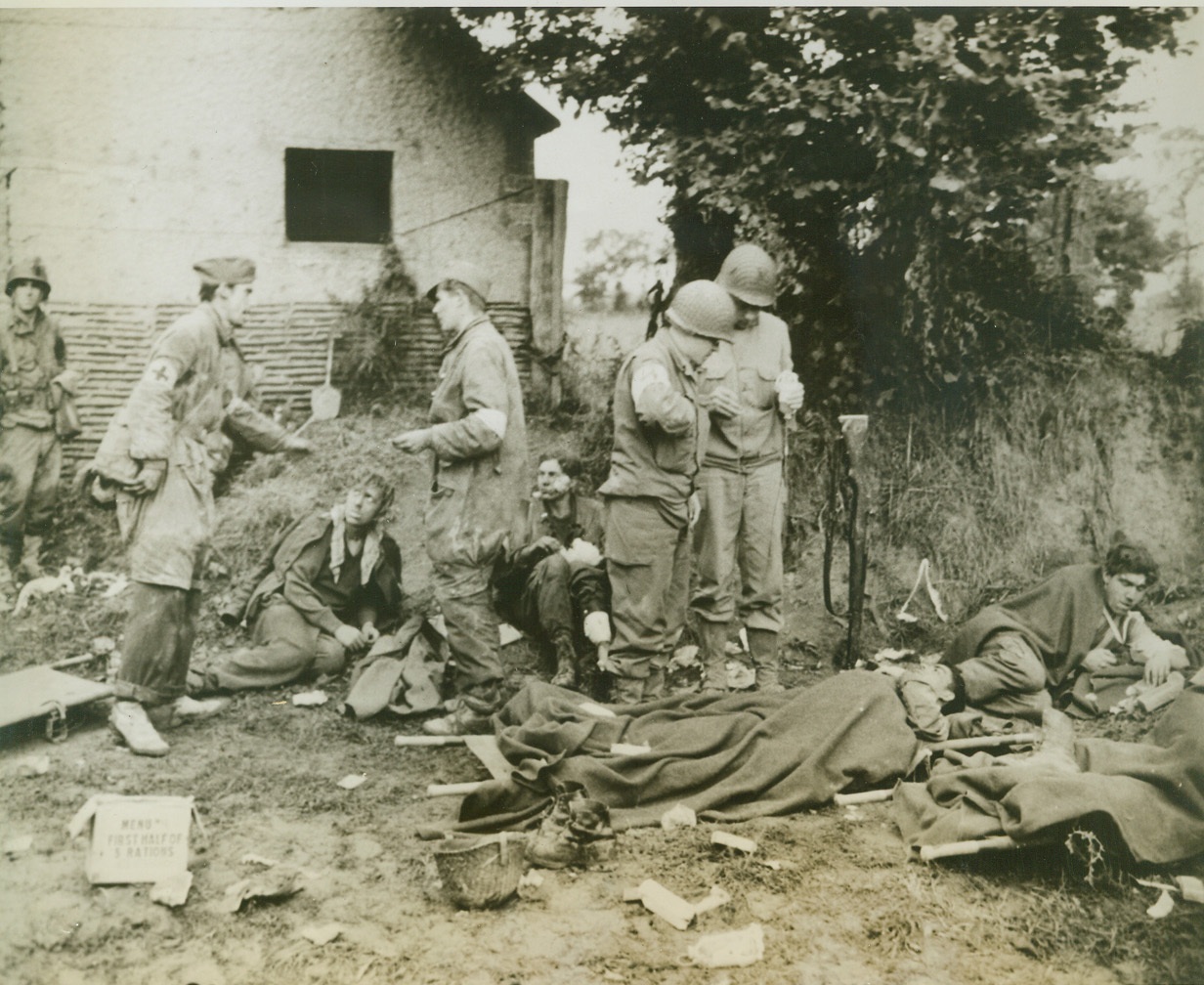
German Prisoners Get Medical Aid, 7/16/1944. St. Lo, France—While two American medical officers quietly go about their job of giving a blood transfusion to a wounded German prisoner (right), two not-so-calm German medical corpsmen discuss in boisterous tones the treatment to be given to a wounded comrade, while the poor fellow under discussion looks at them with unmasked fright. The scene is a temporary dressing station in the St. Lo sector. Credit: ACME; St. Lo, France—While two American medical officers quietly go about their job of giving a blood transfusion to a wounded German prisoner (right), two not-so-calm German medical corpsmen discuss in boisterous tones the treatment to be given to a wounded comrade, while the poor fellow under discussion looks at them with unmasked fright. The scene is a temporary dressing station in the St. Lo sector. Credit: ACME;
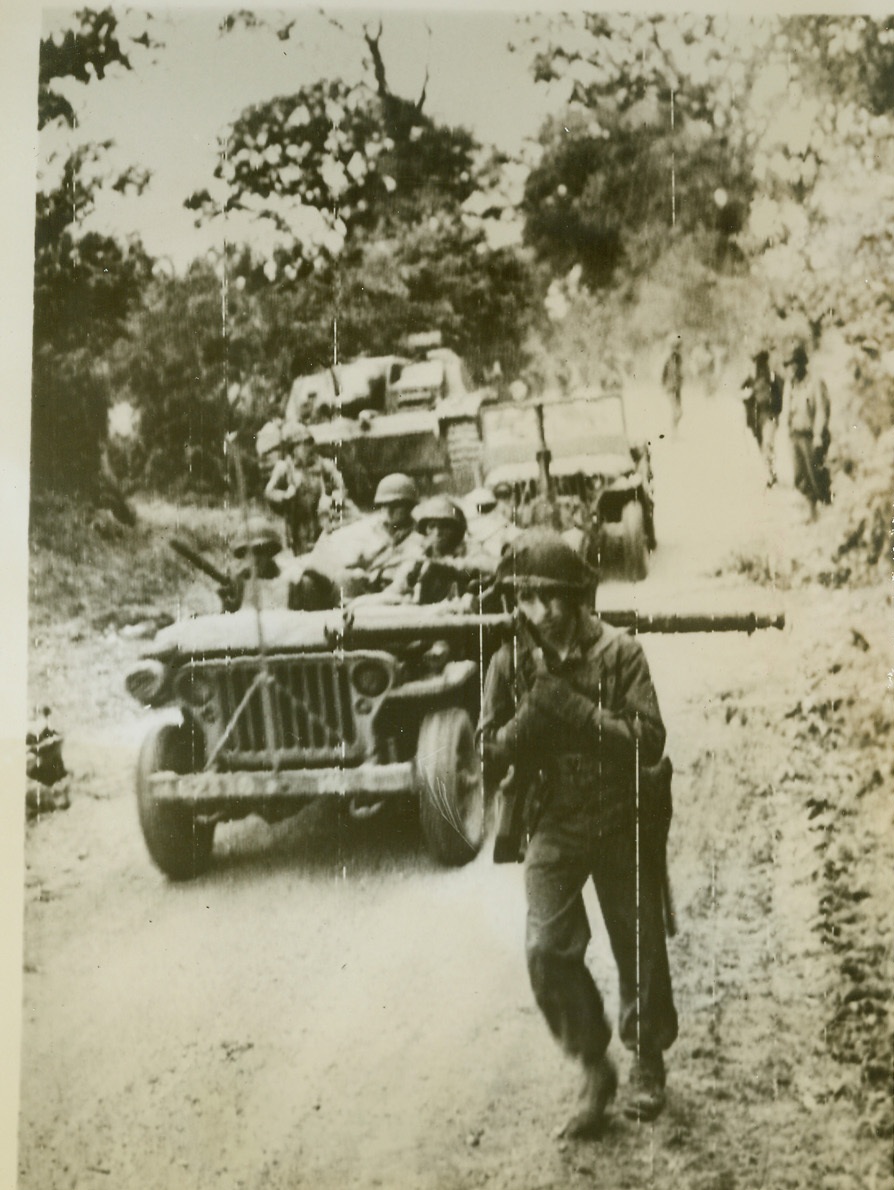
Yanks Advance At St. Lo, 7/17/1944. St. Lo, France—After silencing the German M-4 tank seen standing at the side of the road in background, an infantry unit moves ahead in the St. Lo sector of the Normandy battlefront. The soldier walking in foreground carries a bazooka gun across his shoulders. Credit: Signal Corps radiotelephoto from ACME;
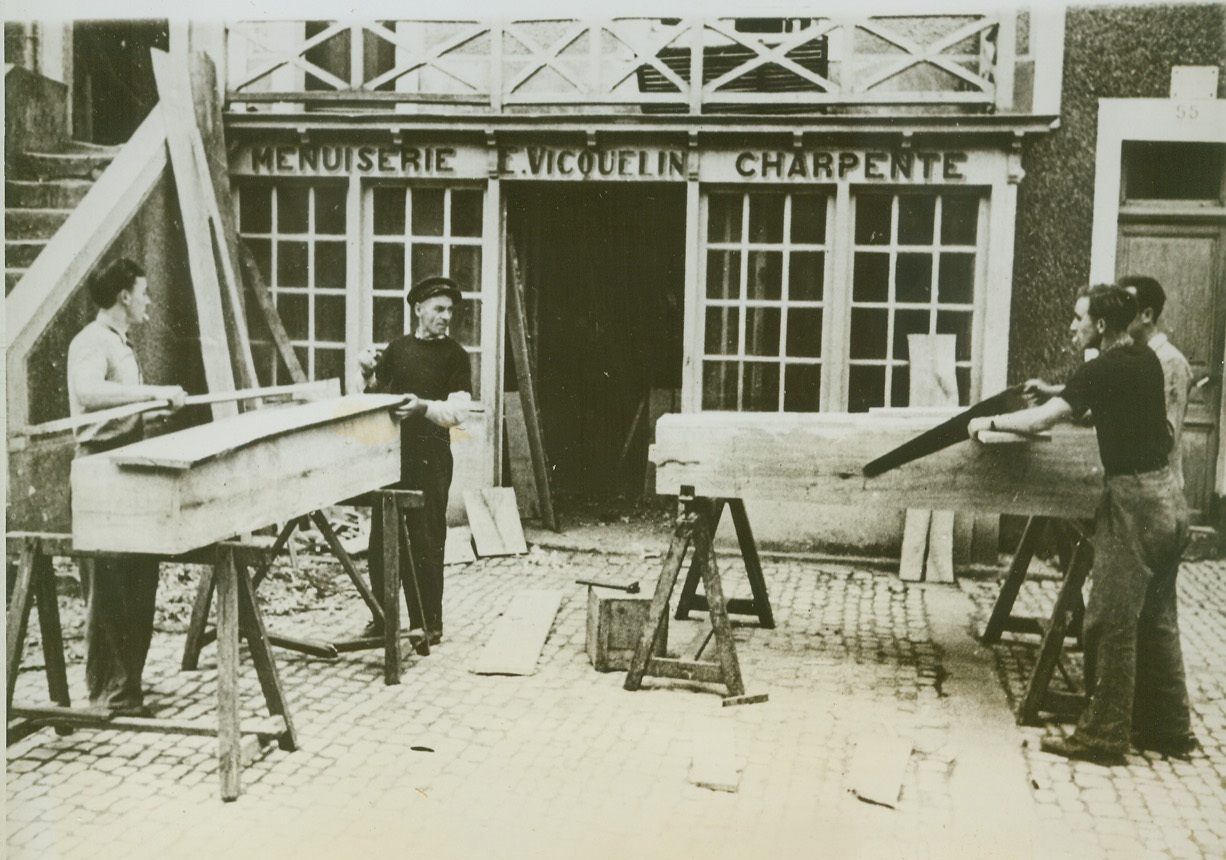
Coffins in Wholesale Lots, 7/4/1944. Grand Camp, France—Carpenters saw away at rude coffins for French civilians who were killed during the fierce fighting which followed the Allied invasion of France. So large was the number of civilian deaths that this woodmaker has enlisted the aid of three helpers to build the number of coffins needed. Credit: ACME;
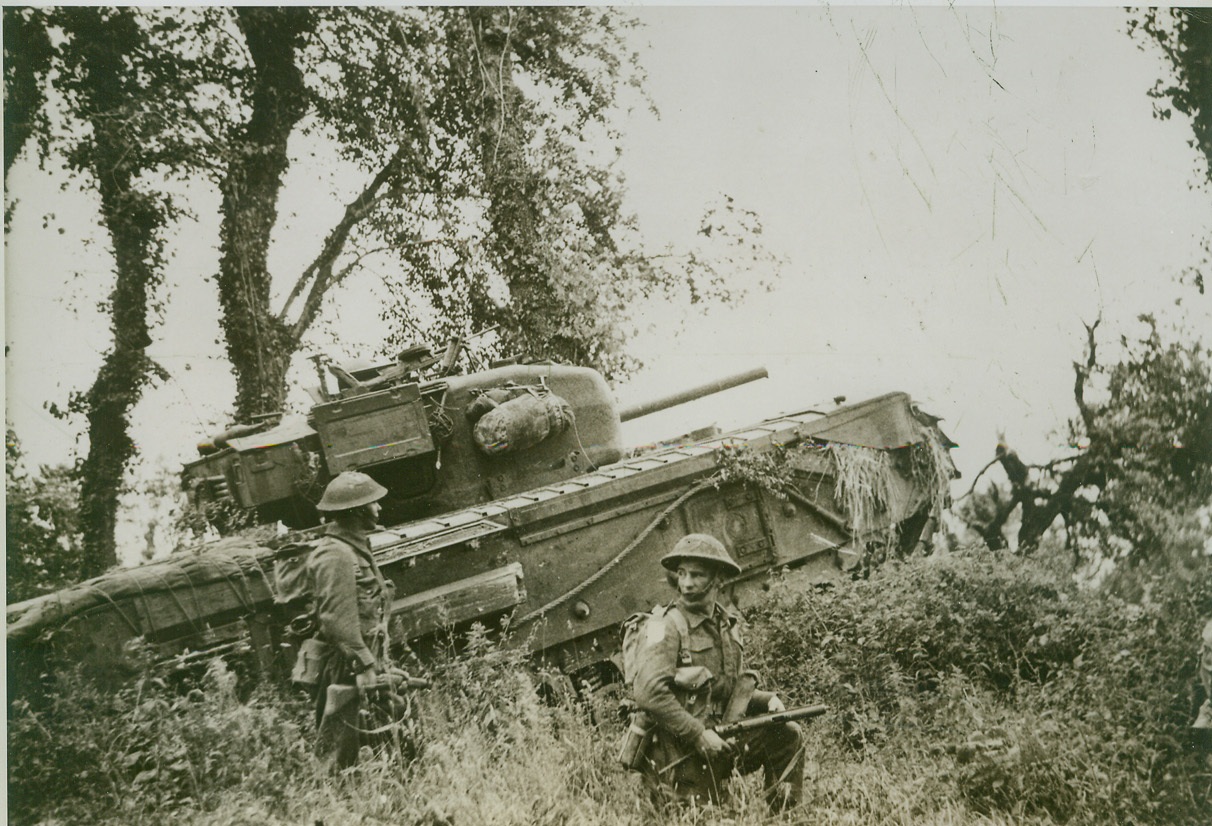
British Move Forward In Caen Sector, 7/4/1944. Caen, France—A lumbering Churchill tank crashes through a hedge at the side of a field, where British troops wait to follow under cover of the armored vehicle. Today (July 4) British and Canadian forces captured Carpiquet, only 3 miles west of Caen, and endangered German troops holding a semi-circular line north of the town. Credit: British official photo from ACME;
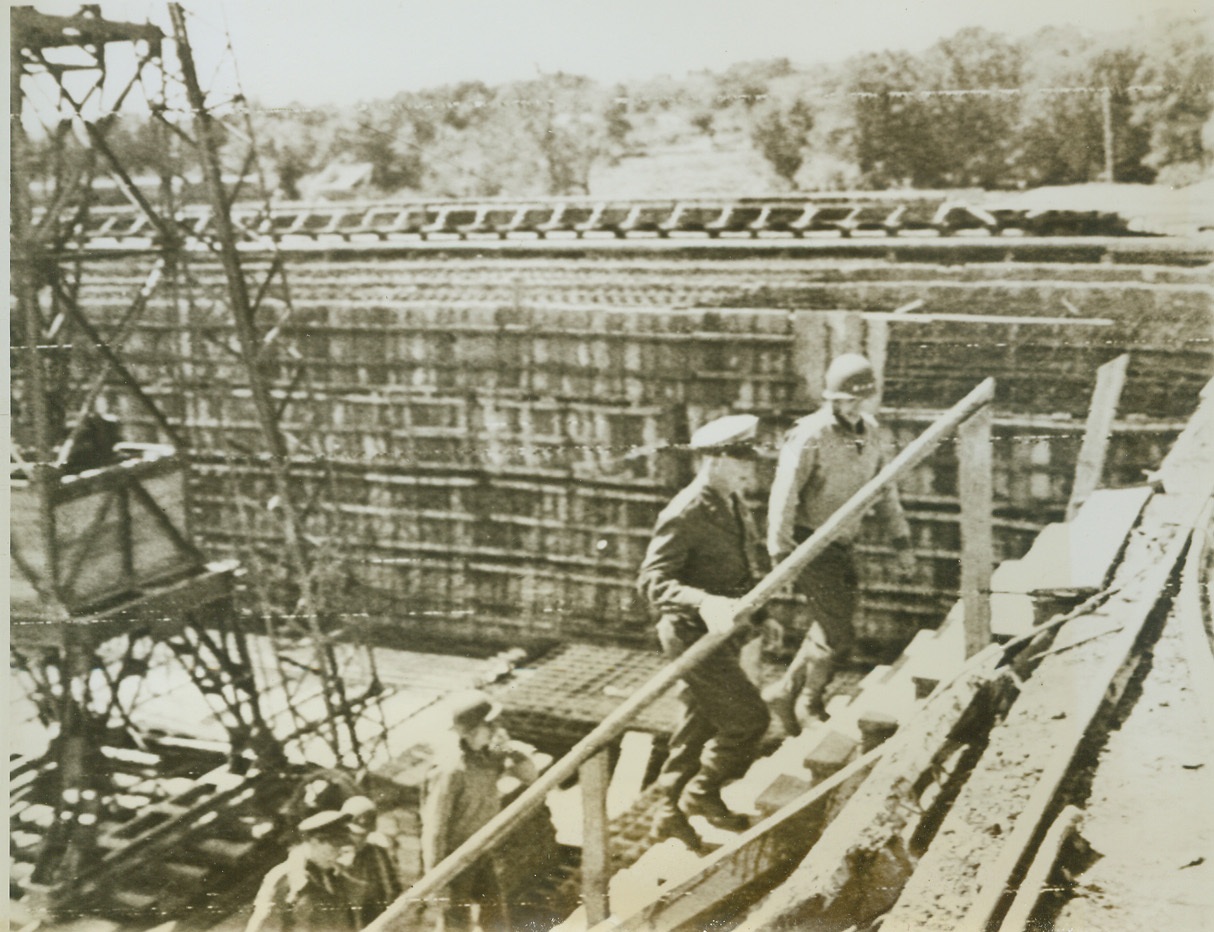
Four Star Independence Day Visitor, 7/6/1944. Normandy—Accompanied by Lt. General Omar N. Bradley, General Dwight D. Eisenhower (second from top of steps) climbs from the base of a rocket bomb launching platform captured by the Yanks somewhere in Normandy. “Ike” visited the launching site as part of his Independence Day tour of the Normandy front. Credit: Signal Corps radiotelephoto from ACME;
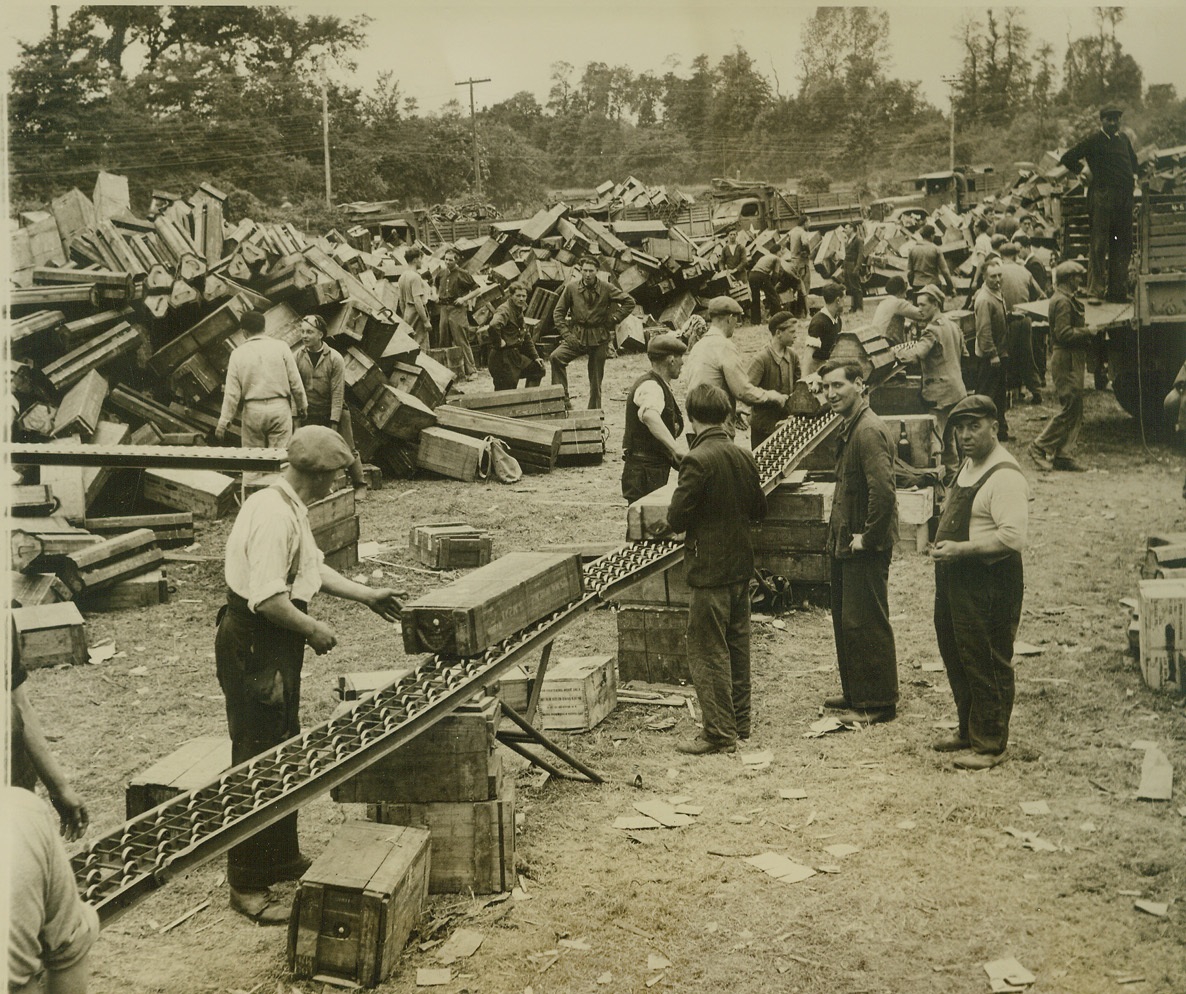
Frenchmen Aid Allied Armies, 7/6/1944. France—French civilians are now finding work with the Allied forces in Normandy. Here a group of workers help sort ammunition at one of the huge dumps built at a bridgehead. A roller stack speeds up the heavy work. Credit: ACME photo by Bert Brandt, War Pool Correspondent;
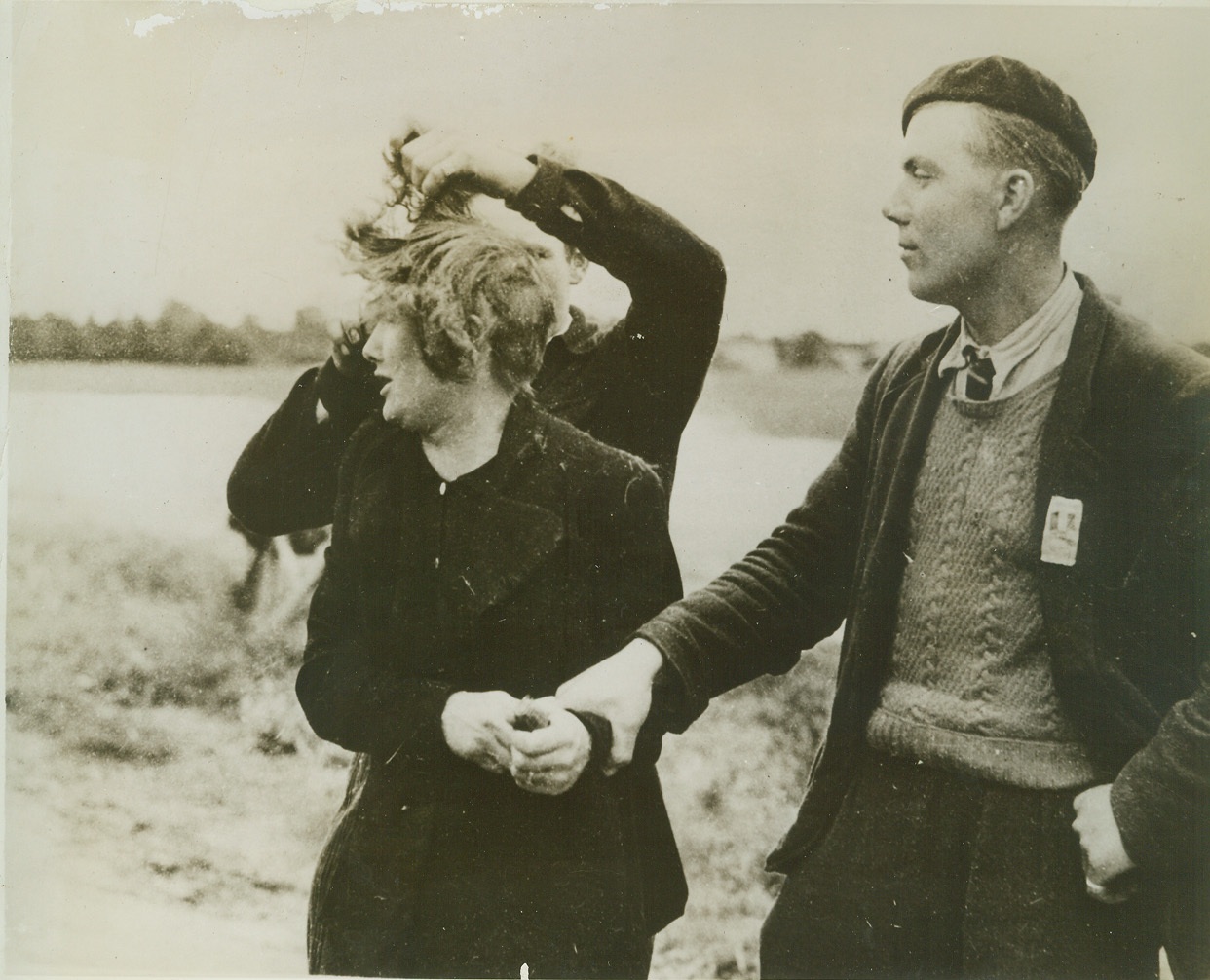
Punishment To Fit The Crime, 7/10/1944. France—There’ll be many a close-clipped female head in France before that country’s patriots have finished their job of punishing woman collaborationists for their traitorous conduct. A free haircut—as choppy and uneven as it can be—is the gift of loyal Frenchmen to women who betrayed their country. This unhappy girl, Grande Guillotte by name, wails and protests in vain as patriots go to work on her “crowning glory.” Once pleasing to the Aryan eye, Grande will wait many a moon before she’s the object of an admiring masculine glance again. Credit: ACME;
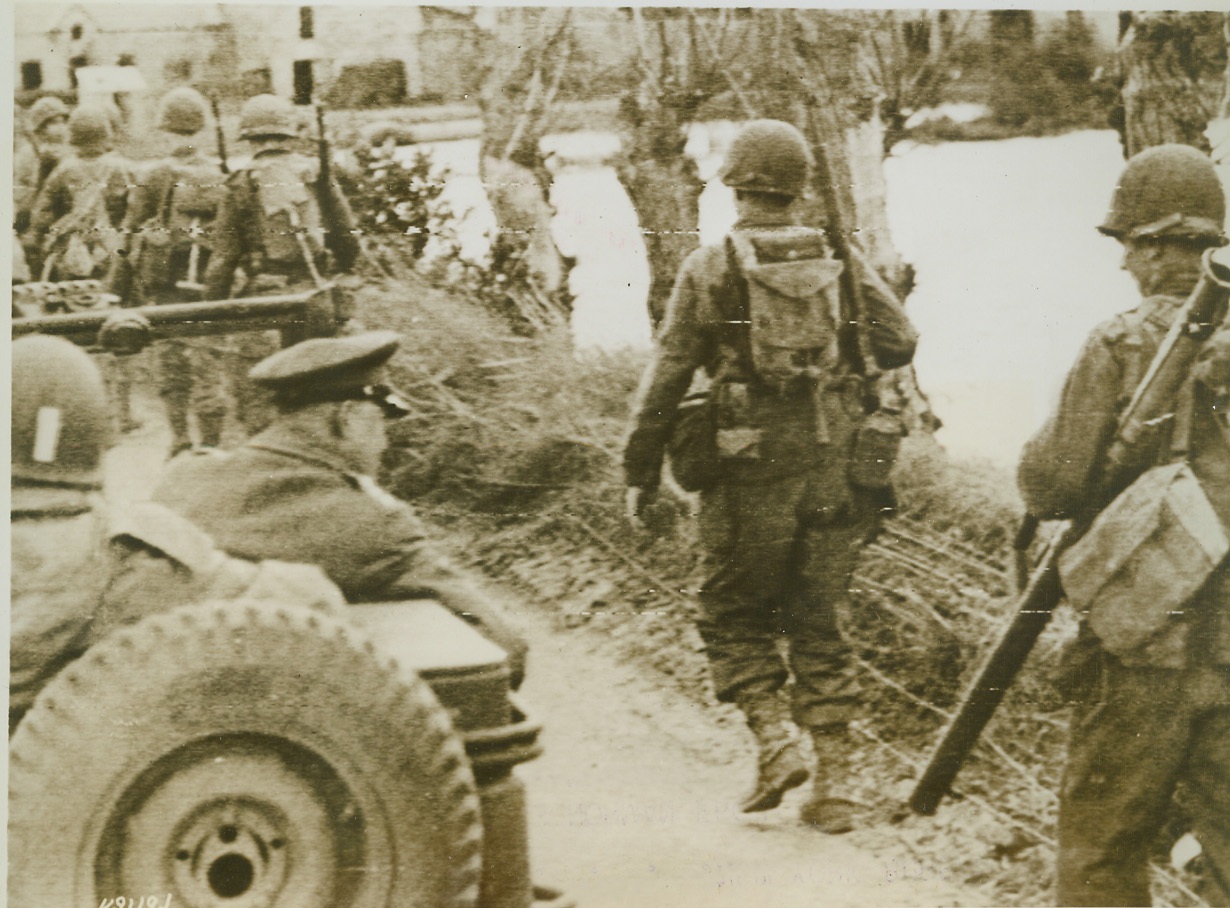
"Ike" Inspects Norman Front, 7/7/1944. France—Riding in the rear of a Jeep, Gen. Dwight D. Eisenhower inspects frontline troops on the march somewhere in France. The supreme commander of Allied expeditionary forces also visited newly won airfield in France and congratulated pilots for the job they were doing in support of ground troops. Credit: U.S. Army radiotelephoto from ACME;
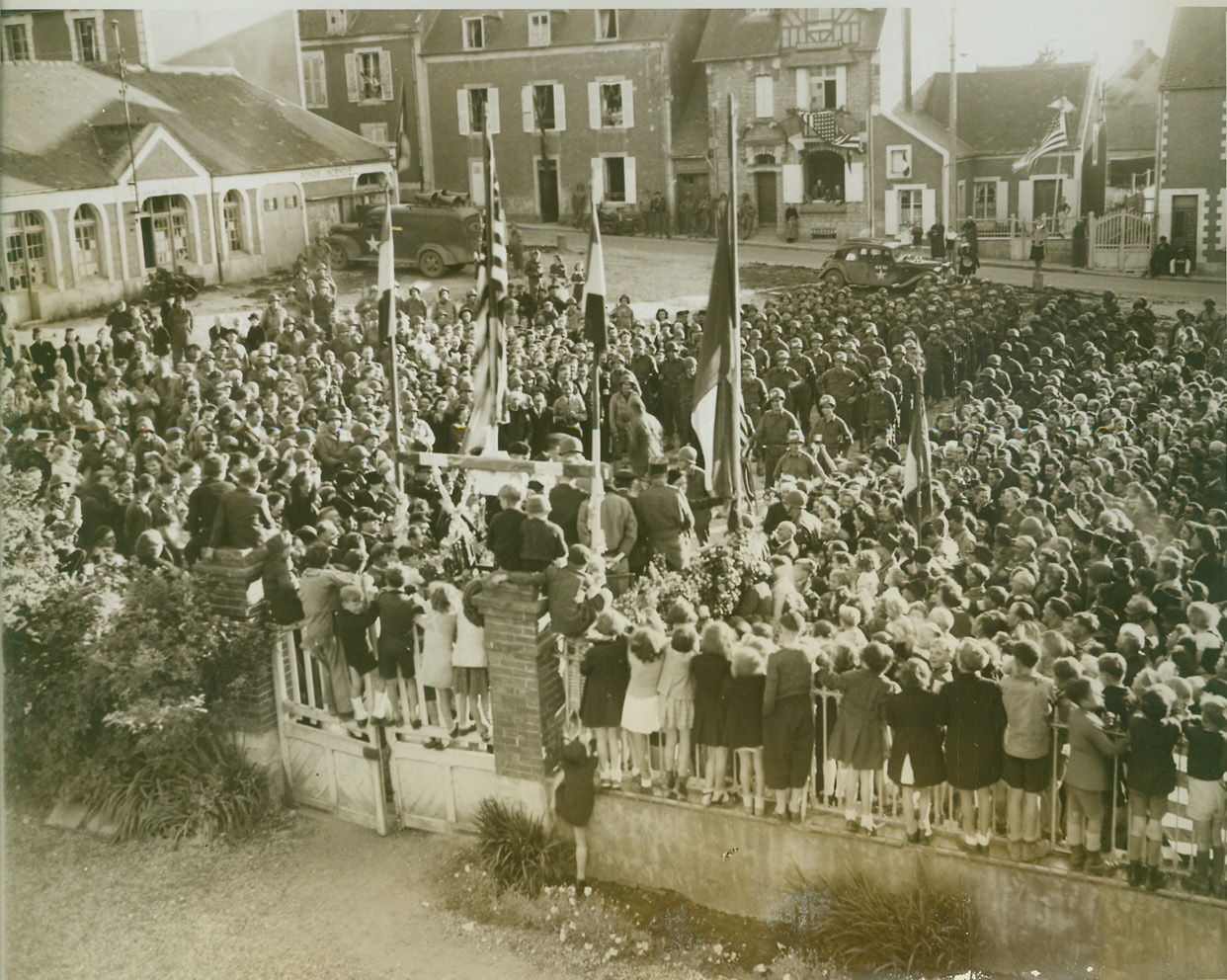
And Little Children Line The Rail, 7/9/1944. France—A huge crowd of 1600 residents of Grandcamp, Little Normandy town, gathered in the main square to help Yank troops of occupation celebrate Independence Day. It was a day of independence for the French inhabitants also. Suffering under the heel of the ruthless Nazis for four years, Grandcamp is grateful to the Americans who liberated them. Town was the first freed by the Yanks. Note the little children lined on the rail anxious to see the celebration. Credit: ACME photo by Bert Brandt, War Pool Correspondent;
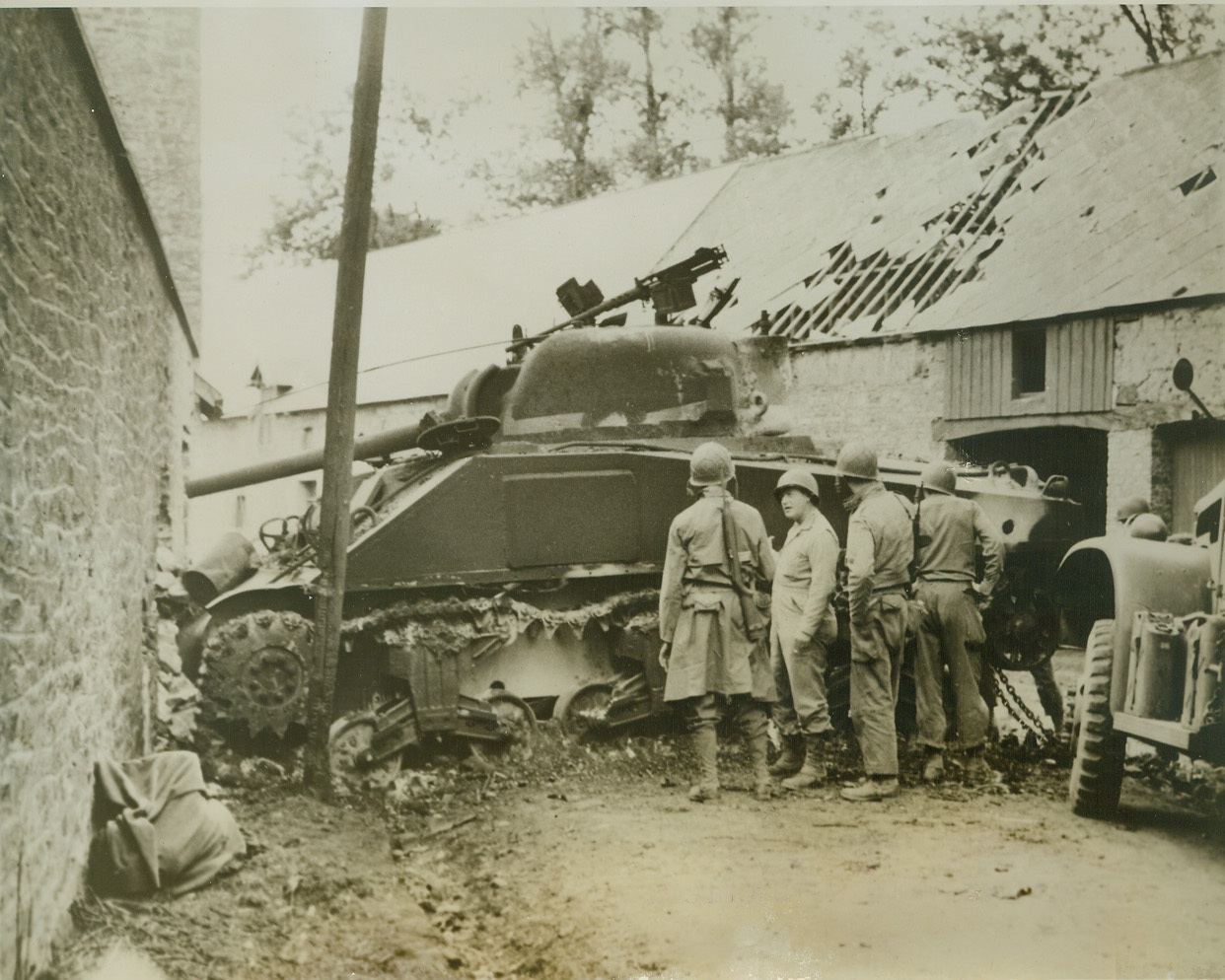
Allies Finally Get Foothold on La Haye, 7/9/1944. La Haye Du Puits, France—American soldiers look over one of their medium tanks, blocking a passage in La Haye Du Puits after it had been knocked out by German guns. The American forces, after being in and out of La Haye for five days, finally held it yesterday (July 8) against fierce German resistance. Although our forces have officially captured the city, German snipers continue to rain bullets into the streets. Credit: ACME;
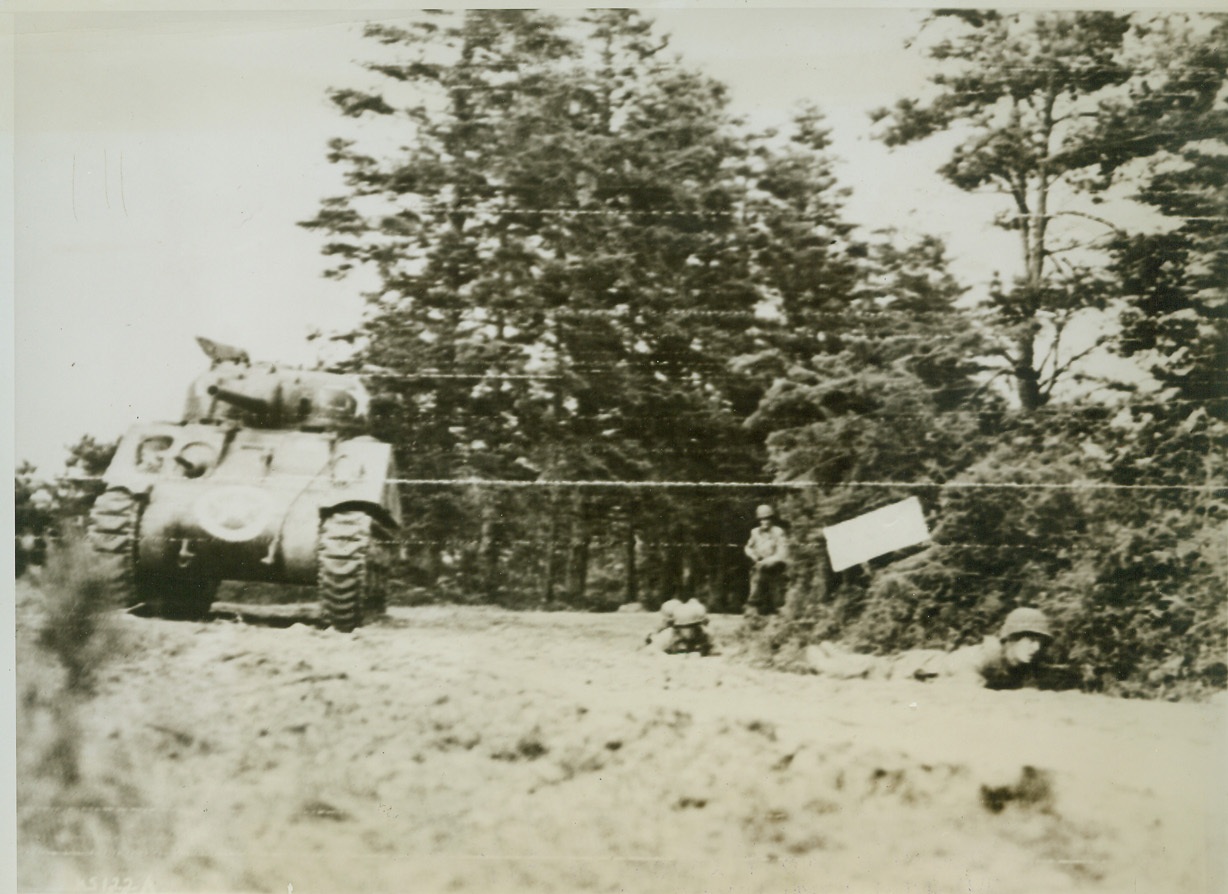
Allies Advance Under Nazi Gunfire, 7/10/1944. France—Crawling slowly along a hedge, two Allied infantrymen advance under Nazi gunfire near St. Jores, France. Tank at left rolls forward to engage the enemy in battle. Photographer inches ahead of advancing troops to make this dramatic picture. Credit: Signal Corps radiotelephoto from ACME;
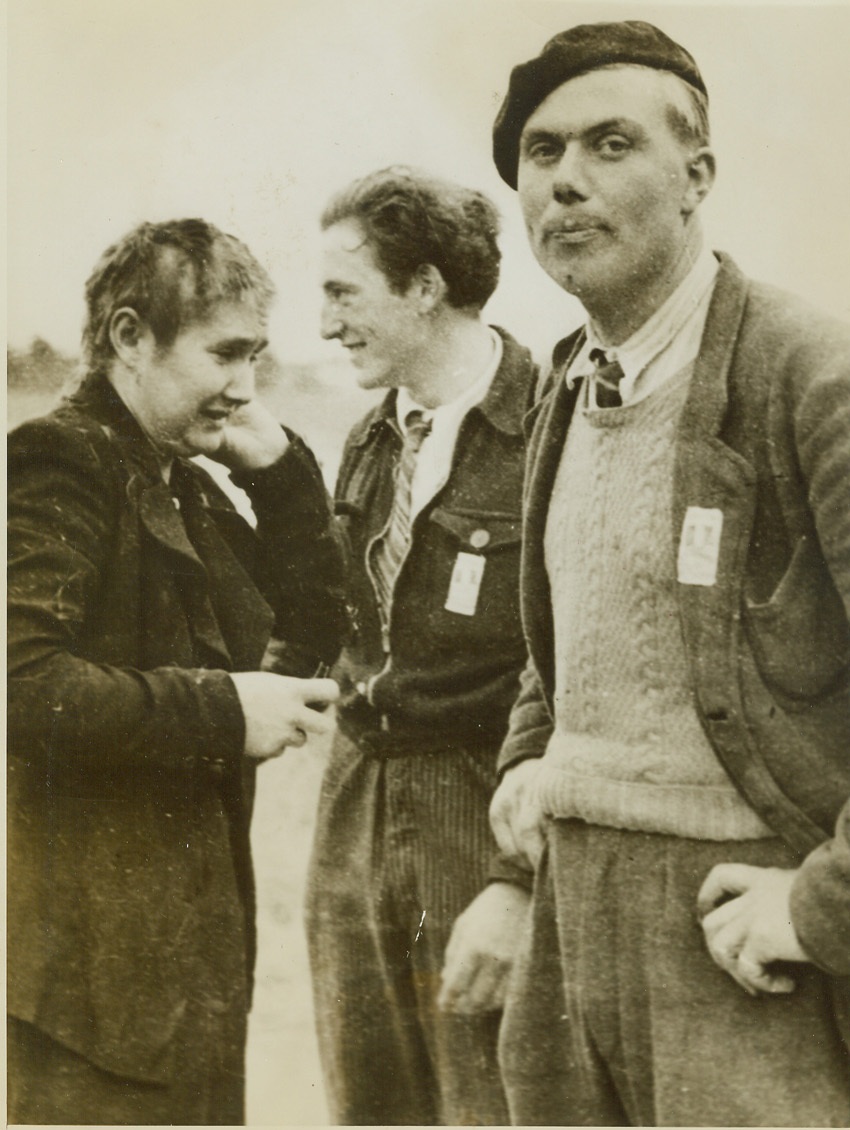
Punishment to Fit the Crime, 7/10/1944. France—Tearfully patting the rough, uneven ends of her shorn locks, Grande Guilotte has learned that collaboration with the Nazis doesn’t pay. Fitting the punishment to the crime, French patriots gave the disloyal girl a free hair cut in the streets of her home town after it had been liberated by the Allies. The same job was done on every other female collaborationist in the area, rendering the women unattractive to men—Nazi or otherwise—for a long time to come. Credit: ACME;
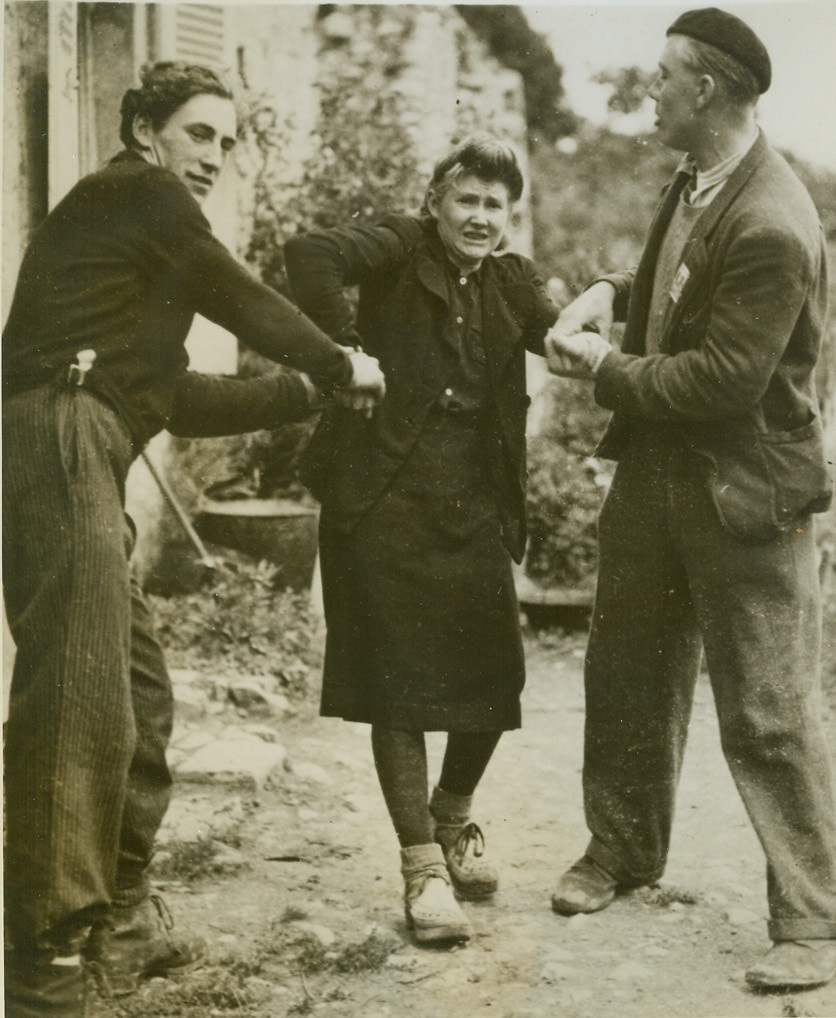
Punishment to Fit The Crime, 7/10/1944. France—Now that Allied forces have come, at last, and freed sections of enslaved France, French patriots are weeding out the quislings in their midst. Meting out punishment to fit the crime, they have set a particularly appropriate price for women collaborationists to pay. Going from house to house, the patriots seize female traitors, drag them to the street and put the scissors to their hair. Blonde Grande Guilotte, 23-year old French girl, was one of those shorn of her “crowning glory.” She is shown as patriots nabbed her. Credit: ACME;
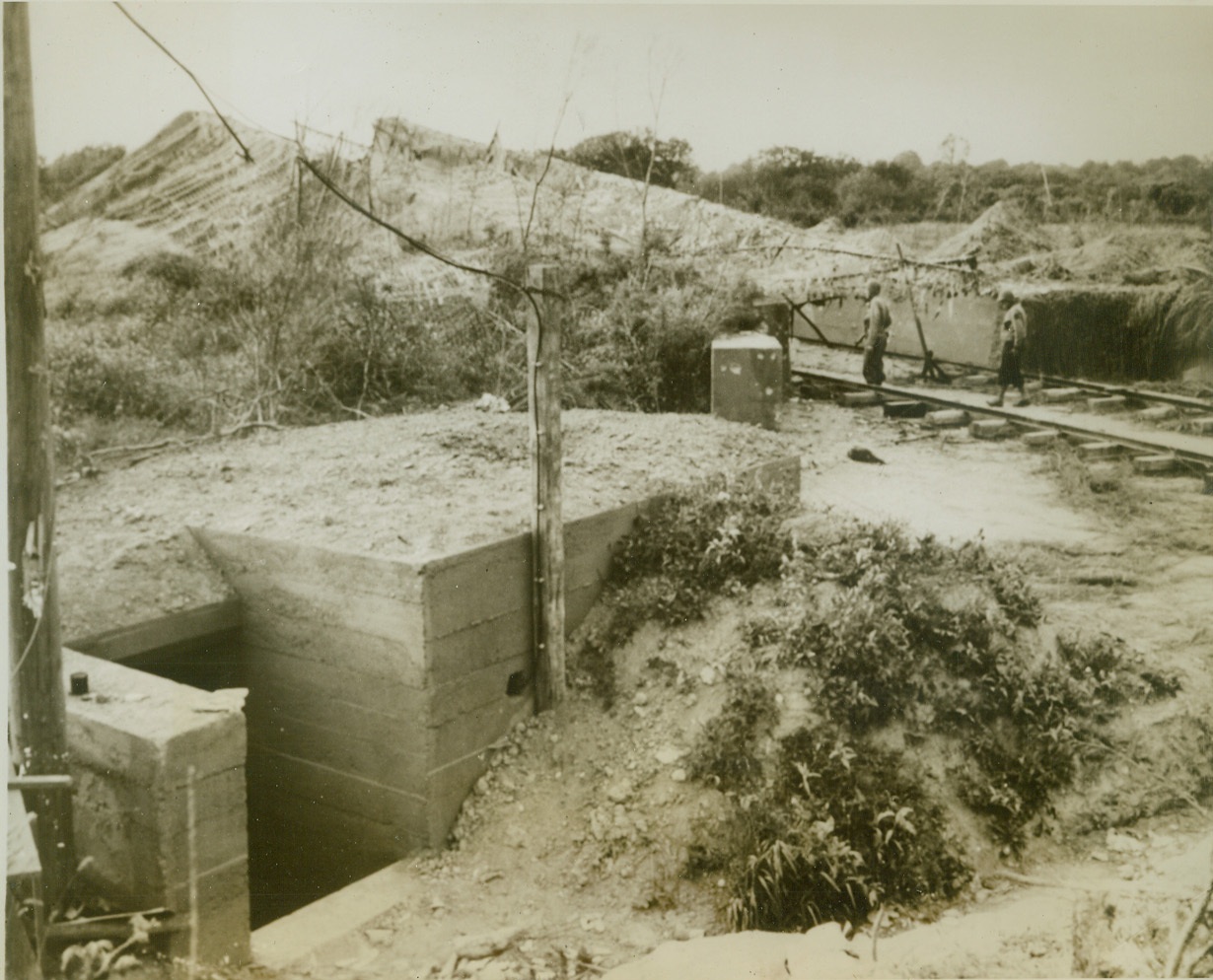
Yanks Take Launching Site, 7/2/1944. Delassy, France—A pair of American soldiers examine one of the robot bomb launching sites captured by our forces in France. This launching platform, not far from the town of Delassy, is reinforced with concrete and camouflaged. Credit: ACME;





 Trash & Recycling
Trash & Recycling
 Online Payments
Online Payments
 City Documents
City Documents
 Parks
Parks
 Traffic Court
Traffic Court
 CITY PARKS
CITY PARKS
 Outdoor Recreation
Outdoor Recreation
 Volunteer
Volunteer
 Home
Home TRANSLATE
TRANSLATE
